2016 Honda Pilot: What's It Like to Live With?
Pack up the kids. We've got a year with the new 2016 Honda Pilot.
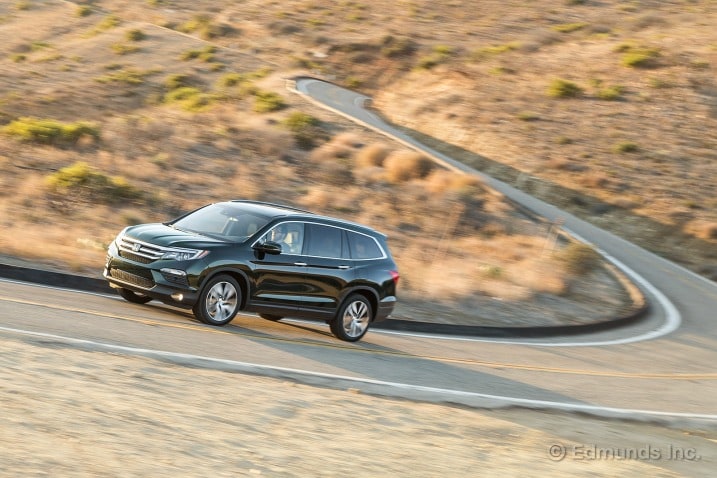
What do you want to know about?
- Introduction
- Brief First Impressions and Something That Goes "Bing!"
- No Need for Fancy Gauges
- Learning to Like the Push-Button Shifter
- How Does It Handle Five Passengers and 1,000 Miles?
- Not Impressed By the Automatic Wipers
- Dreaming of Good Fuel Economy
- Why You See a Photo of My Jeep
- Rear Seat Comparison
- Performance-Tested Tank
- Might be Too Nice
- Heated Steering Wheel Does Not Work
- Love the Capless Fuel Filler
- Computer Help While You Drive
- Designated Holiday Hauler
- Fuel Economy Update for December — Early Disappointment
- 1,767-Mile Road Trip Recap
- Fear and Boating in Las Vegas
- Does it Cost a Pot of Gold?
- Touchscreen Interface Isn't So Great
- More Gears Isn't Necessarily Better
- Family Day Trip and Seven-Passenger Tested
- Rear Entertainment System Instead of Tablets
- Volume Control, Briefly Possessed
- Due for 7,500-Mile Service
- Doesn't Like My Phone
- Creaky Lumbar
- A1 Service Completed, with Repair Parts on the Way
- Fuel Economy Update for January — Road Trips Boost the Average
- New Windshield Added to Repair List
- EX 6-Speed Transmission Vs. Elite 9-Speed
- Half-Completed Repairs and More Bad News
- Repairs Complete, Back to Operational
- The EX-L Navi Is the One to Get
- Fits a 4x8 Sheet of Plywood and Coffee Table — Sort Of
- 10,000 Miles in No Time
- Getting the Infotainment System Updated
- City Driving During February and March Reduces Fuel Economy
- Rain-Sensing Wipers
- Room for Six Plus Luggage for a Vegas Weekend
- Plenty of Room for Cargo
- Fuel Economy Update for March - More Miles, Same MPG
- Best Armrest Ever
- Asking for Maintenance
- Quick, But Not Always
- Second Scheduled Service, aka B16
- Fuel Economy Ups and Downs
- Supersized Console Bin
- Packing for an Oregon Vacation - and Bringing a Bicycle
- Thoughts on the Road to Oregon
- Impressive Fuel Economy on Oregon Road Trip
- Numerous Forward Collision Warning False Alarms
- July Fuel Economy Update - Padding the Stats
- Headed in the Right Direction
- Handles Weight Well
- Will the Luggage Fit?
- August Fuel Economy Update
- The Minivan Problem
- Road Trips Get it to 20,000 Miles
- Monthly Update for October 2016
- A1 Service Update
- Monthly Update for November 2016
- Wrap-Up
Introduction
What Did We Get?
After some recent stumbles, Honda is starting to hit its stride once again. The new 2016 Honda Pilot is a good example why. Unlike the previous Pilot that was slow, bulky-looking and had a cabin that looked cheap, the redesigned model has plenty of power, a crisp and modern exterior design and a spacious cabin that is well trimmed throughout.
It felt like a huge step up the first time we drove it, and subsequent test-drives only reinforced the idea that this sizable crossover was now a top-tier, three-row family vehicle. We wanted to see if that perception would hold up over the long haul, so we decided to add the new Pilot to our long-term fleet.
What Options Does It Have?
Like all Honda models, the Pilot doesn't offer stand-alone options like most other vehicles in its class. Instead, Honda offers the Pilot in various trim levels that come standard with certain features.
In the case of the Pilot, there are five basic trim levels: LX, EX, EX-L, Touring and Elite. All offer a choice of front-wheel drive or all-wheel drive except the all-wheel-drive-only Elite. Every Pilot is powered by a 3.5-liter V6. The LX, EX and EX-L models use a six-speed automatic transmission, while the Touring and Elite models come standard with a nine-speed automatic.
The base LX starts at $30,895. It has all the basics and there are no upgrades available. On the EX, which starts at $33,330, there's a standard level of features and then a trim level upgrade that adds Honda Sensing, a package of safety equipment that includes automatic emergency braking and lane departure warning, among other things.
From there you can upgrade to the leather-lined EX-L ($36,805) that offers three upgrades: the Honda Sensing system, a rear entertainment system or navigation. For even more features there's the Touring model ($41,920) or the fully loaded Elite version ($47,320), which is the only model that offers second-row captain's chairs. All other trims get a second-row bench that increases total seating capacity to eight.
Honda loaned us a Pilot Elite for a year so we could test every last feature available.
Why We Got It
This is one of the most competitive segments in the industry right now and for good reason. Three-row crossovers are the vehicles of choice when you need to carry more than a couple of kids on a regular basis and you can't stomach the thought of a minivan. That's a big chunk of the market, which is why nearly every mainstream carmaker has a three-row crossover either in its lineup or in the works.
Honda's latest entry is as important to its success as the upcoming Civic. It's been offering the Pilot since 2003, but it hasn't been as dominant in its class as some of Honda's other models. The Civic and Accord are synonymous with top-quality sedans, but the Pilot has yet to make its mark.
We have tested some of its main competitors like the Ford Explorer, Hyundai Santa Fe and Toyota Highlander, all of which impressed us with their capabilities and comfort. Now it's time to see if Honda has raised the bar. Over the next 12 months we'll subject the Pilot to thousands of miles of real-world testing to see if it accommodates families, vacations and daily commutes as well as or better than its rivals.
Follow along on the long-term road test page for daily updates on our 2016 Honda Pilot and the rest of our fleet.
Brief First Impressions and Something That Goes "Bing!"
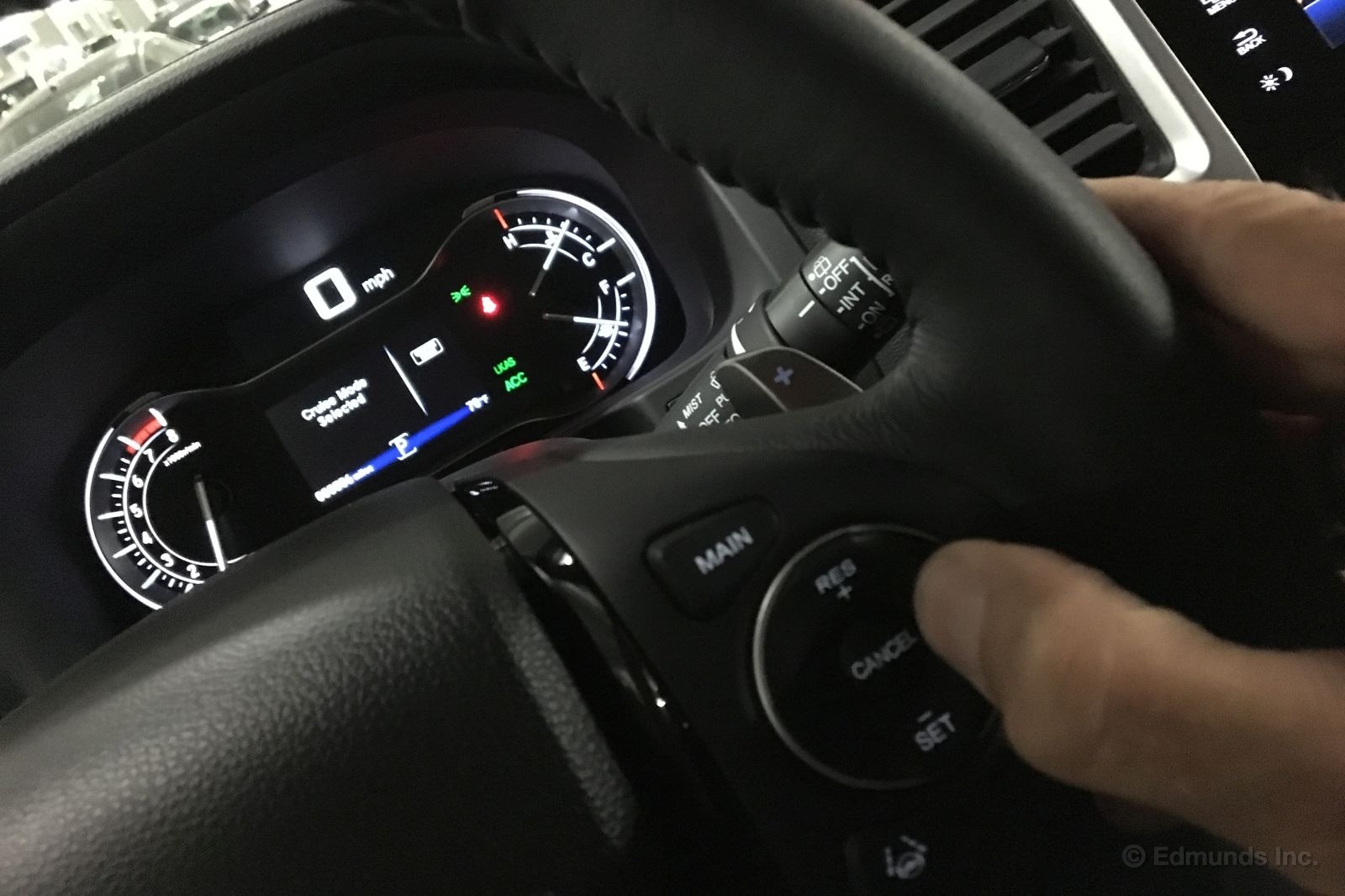
Our 2016 Honda Pilot had arrived just a few days ago. The needle was barely down from the "F" mark on its second tank of fuel as I emerged into the sunlight from our underground parking garage. I wasn't going anywhere special, though. This first drive would be a simple overnight commute.
On the drive home the accommodations proved to be, well, accommodating, and the Pilot generally rolled down the road with composure. Its V6 powertrain seemed to generate a decent amount of power, and I never noticed the odd 1-2 shift that Ed thought he might have felt once or twice the night before. When I got home, my daughter commented how much she liked the rear seat and the amount of space.
It was a brief first impression, and numerous details will get filled in over the miles and months ahead. Still, everyone agreed this would be a good candidate for our upcoming Oregon holiday trip.
Dibs.
But it wasn't all rosy.
I had trouble with the USB-to-iPod connection as well as the audio system mode selector switch on the steering wheel, both of which didn't seem to work as expected. The manual's described procedure for switching off adaptive cruise in order to revert to regular cruise didn't work for me work for me either...until I tried it while stopped with the transmission in Park.
In the fullness of time, that stuff may or may not prove to be operator error. I'm filing them all under "Too Soon to Tell."
But then there was the thing that annoyingly went "bing!" like an airline seatbelt warning.
I couldn't tell what was triggering the seemingly-random chime that issued from the front stereo speakers after dimming the audio program. It happened on city streets, arterial roads and freeways alike, about once every 90 seconds or so.
I quickly eliminated the lane keeping and blind spot monitoring systems. Nothing untoward was evident as I scanned the cabin, but the search was like trying to determine which of my four home smoke detectors was issuing a low battery warning, but with a soothing tone.
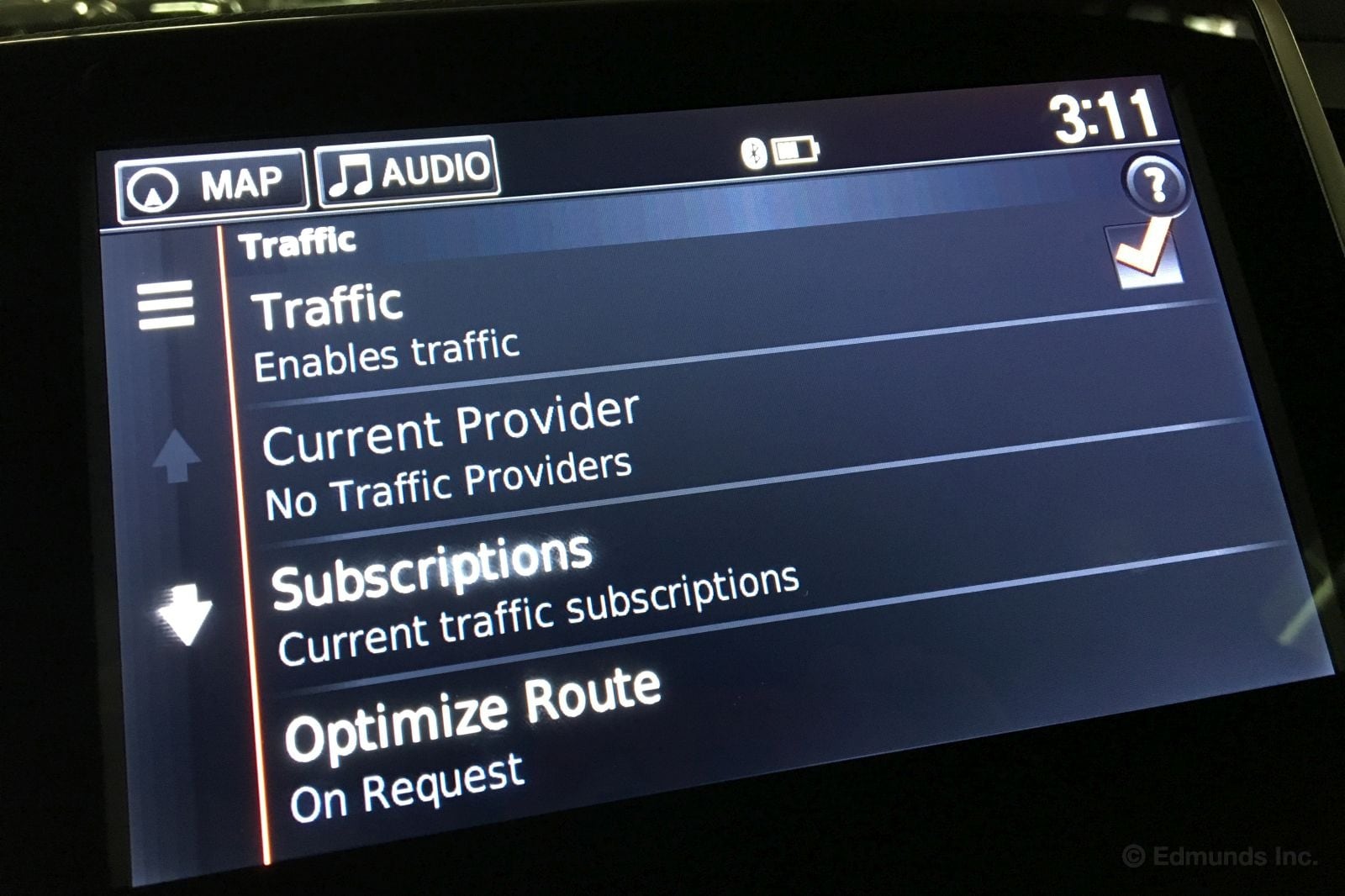
My wife surfed the web and found the question (and answer) quickly in a Pilot forum. It was the traffic system issuing traffic alerts.
Odd. I didn't have the map displayed and navigation routing was not active. But I switched away from the audio screen and changed over to map view and saw that it was true. Each unwanted "bing!" corresponded to the appearance of traffic alert messages on the map along the lines of "two-minute delay ahead."
Strange. The car had no way of knowing my ultimate destination or immediate plans. How could it compute a delay time if it didn't know where I was going? The fact that the map screen wasn't even displayed should have been the car's second clue I wasn't interested.
I dug a couple of levels into the setup screen and found a place to turn off traffic information, which put an end to it. But I'll have to turn it back on when I am interested in traffic warnings and navigation for real. We may be in for a lot of back-and-forth toggling if there's not another setting hiding in the manual that I haven't yet discovered.
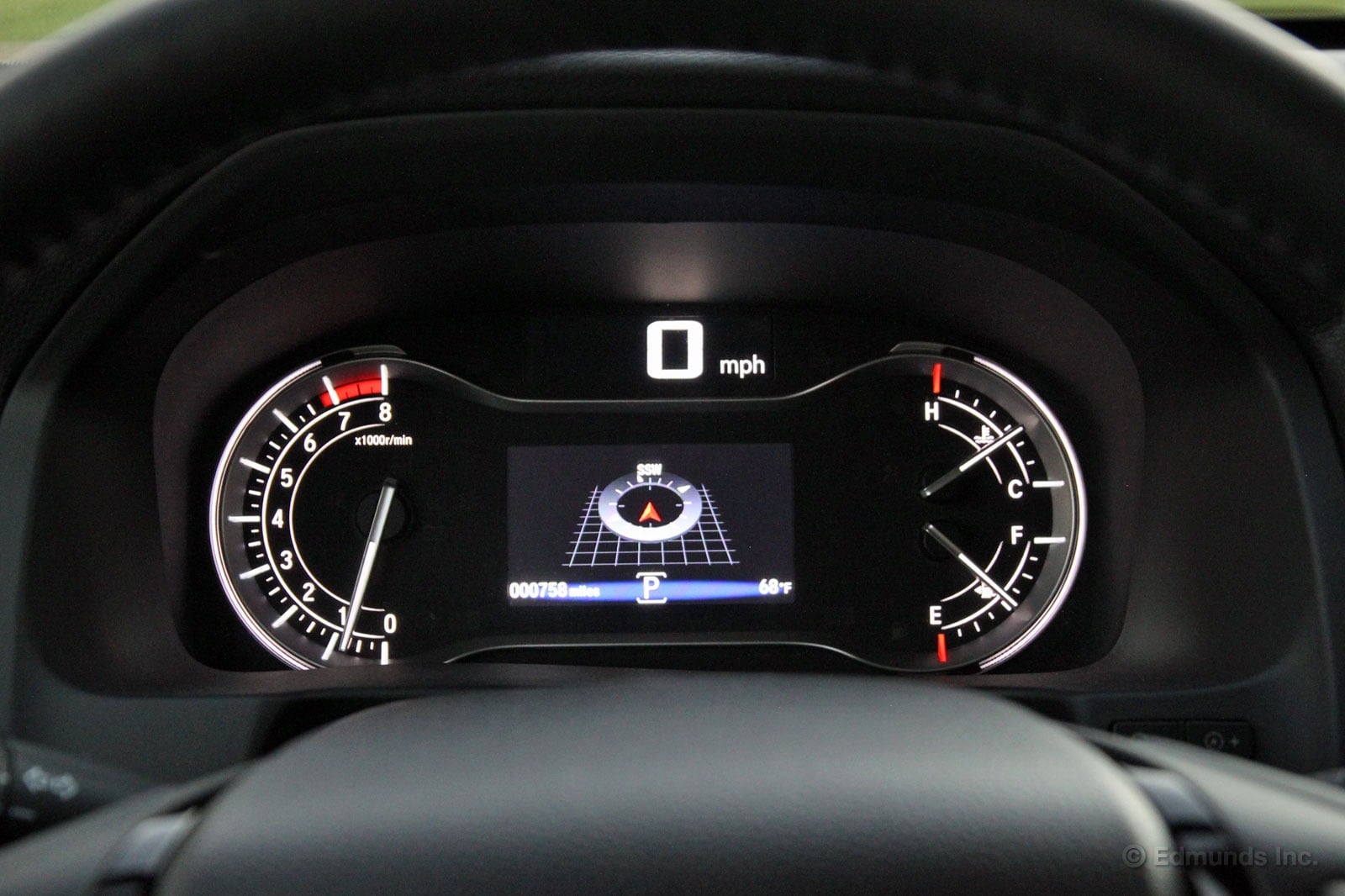
Yes, this is the first thing I felt the need to comment on when it comes to our new 2016 Honda Pilot. I understand that designers have a hard time just leaving well enough alone, but these gauges aren't my favorite alternative to the standard two dial design.
At first glance it looks like the digital information display in the middle is the main source of information here. Everything else is pushed to the edges as if it's all secondary information.
Maybe that's true to an extent, but the space taken up by the info screen in the middle isn't used for anything more important. It's adjustable, with multiple screens for everything from tire pressures to trip meters, but none of the information is any more relevant than the gas gauge or engine temperature.
Call me old-fashioned, but I like it when even the most sophisticated new vehicles have basic analog gauges front and center. Leave the other stuff off to the sides.
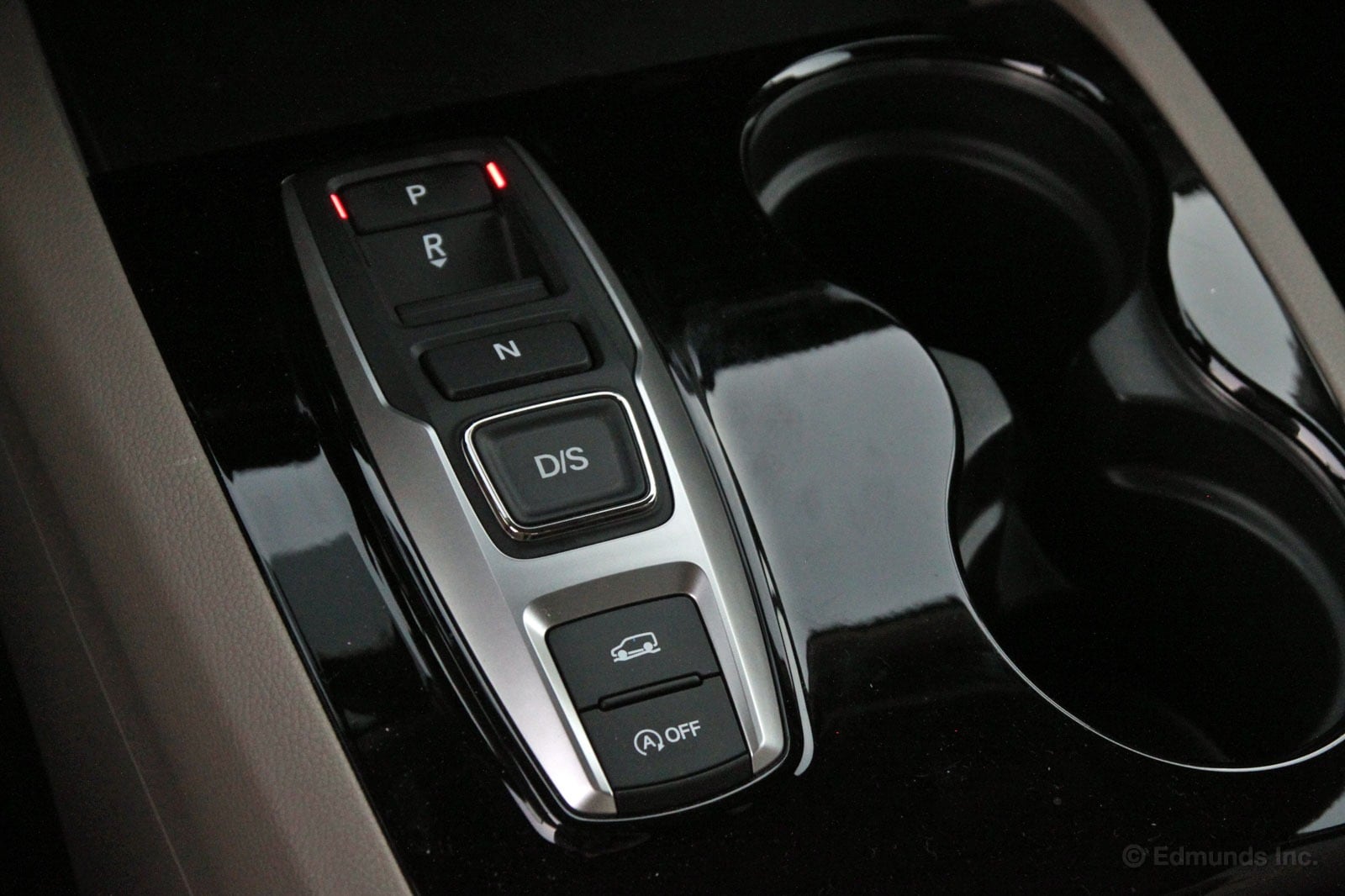
This transmission shifter may look familiar. I wrote about a related setup in our long-term Acura TLX earlier this year. I liked it in that car and I think it works well in our new 2016 Honda Pilot, too.
It's not the exact same setup as the Acura. Our Pilot has fewer buttons and no electronic parking brake. What it does have are the things that make this setup easy to use without looking, namely a large, central button for selecting "drive" and a rocker switch that you pull back for reverse.
After driving the Pilot in various situations that included parallel parking and three-point turns, I still find the setup easy to use. Don't fear the buttons, they work just fine.
How Does It Handle Five Passengers and 1,000 Miles?
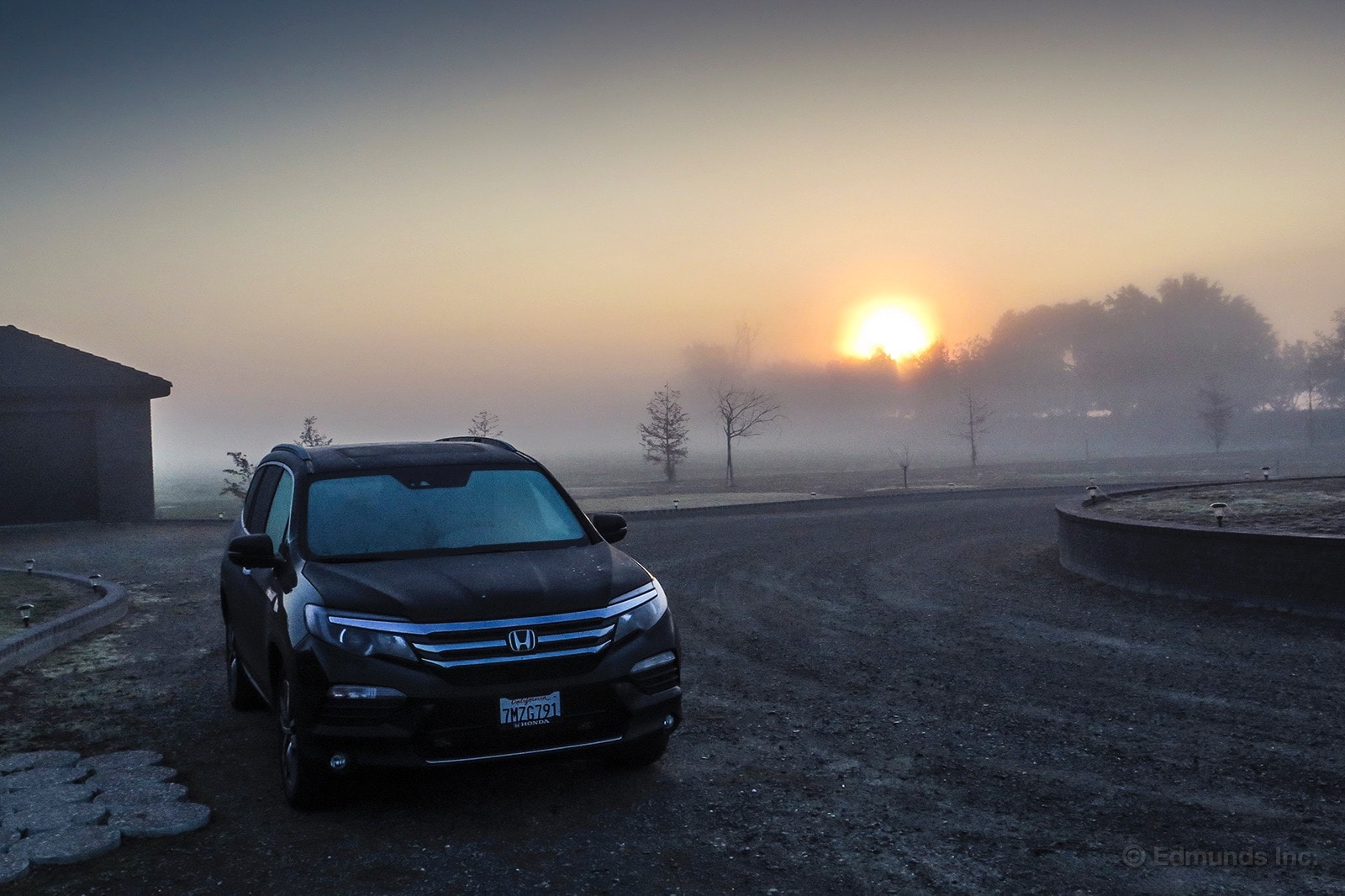
I wasted no time asking Edmunds car-czar Mike Schmidt for the keys to our newest long-term vehicle, the 2016 Honda Pilot. Before it had been in our garage for a week, I requested the six-passenger crossover for a 1,000-mile road trip. Once Mike forked over the keys, I packed my running gear, picked up four of my friends and headed north towards Sacramento.
Designed as a mini-vacation of sorts, the road trip would take us from Los Angeles to the state capitol, Sacramento. The five of us signed up for a 10K run called Beat the Blerch so we brought lots of running gear, extra shoes and plenty of snacks. All that plus normal road-trip luggage meant we had to pack very strategically.
The Pilot's cargo bay has a false floor, which provides a few inches of additional depth when removed, but the front-to-back dimensions behind the third-row seatbacks are still pretty shallow. The split-folding 60/40 seats made up the difference, allowing for the bigger bags to lay flat and giving the third-row passenger something to lean up against and sleep on. A sixth passenger would've been pushing it here and a seventh passenger with their bags would've been a practical impossibility.
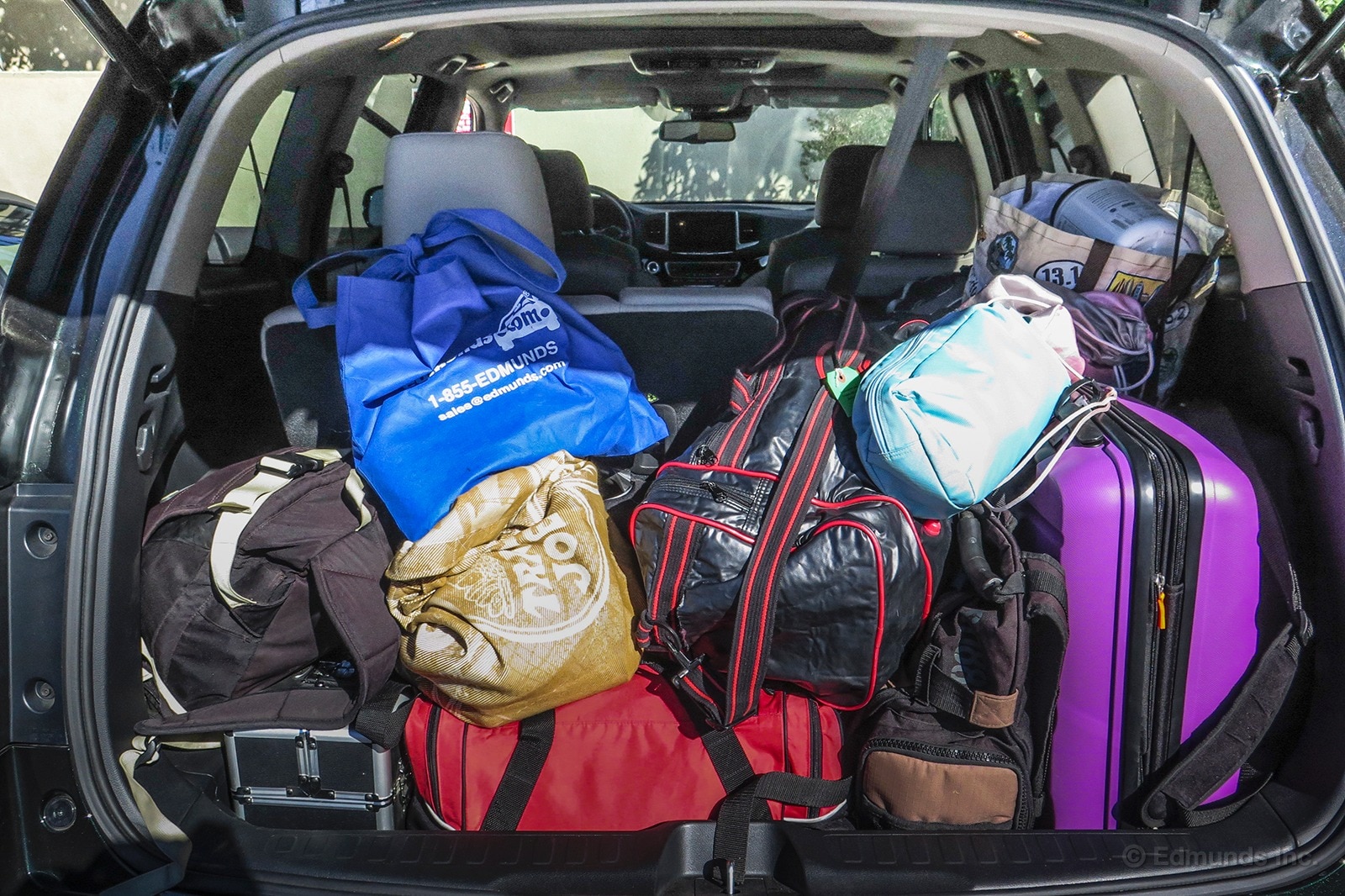
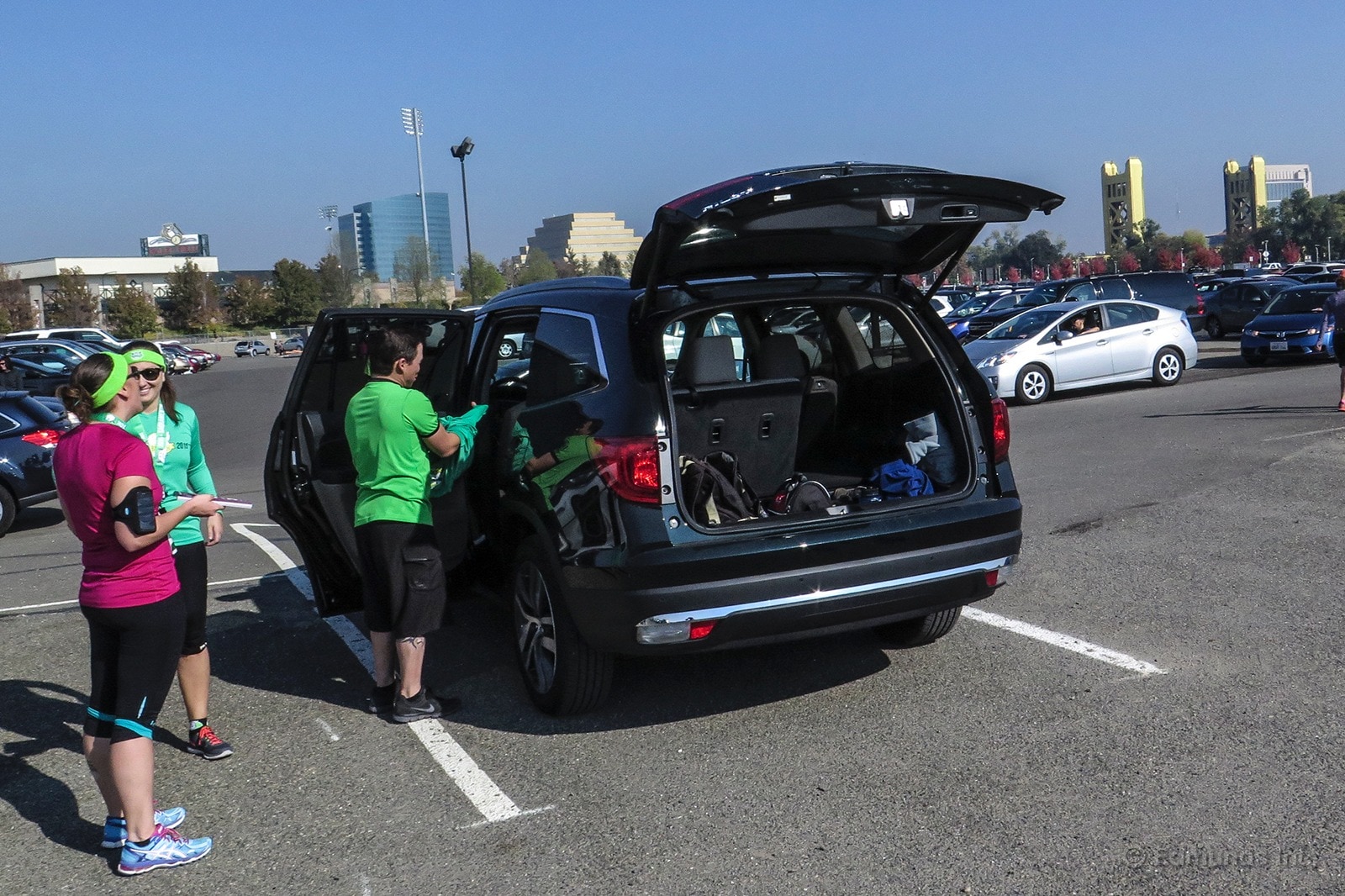
On our way up to Sacramento, there weren't many complaints but limited legroom in the third row was one noted shortcoming. There's plenty of headroom and space to spread out when you're the only person back there, but if you're an adult over 5-foot 4-inches and you're sitting upright, your knees will likely be pretty close to your chest.
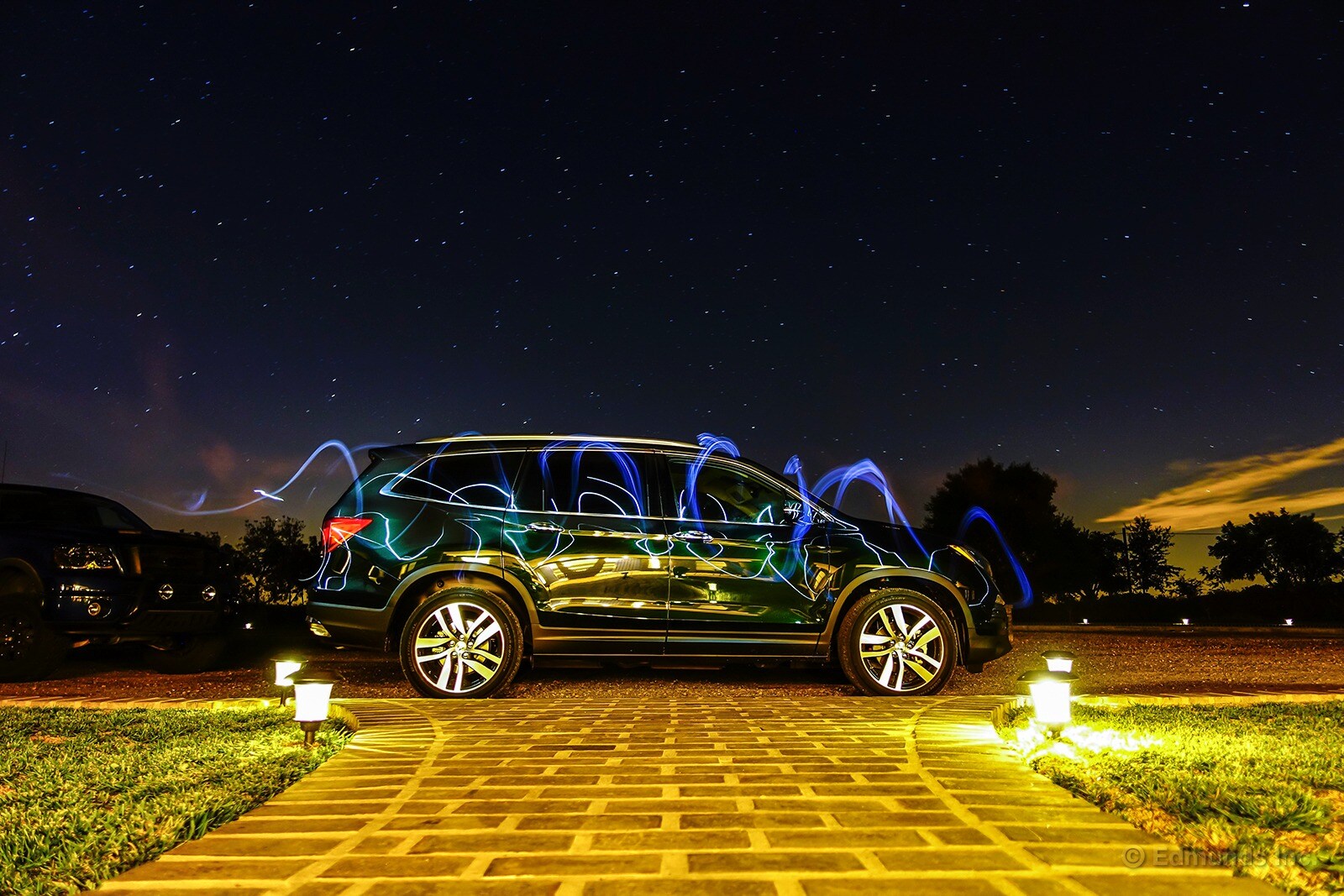
Awesome light-painting photo courtesy of my buddy, Matt Dunn.
There was heavy rain on the return trip and more than one instance of stop-and-go traffic, so I wasn't too surprised when the math revealed an average of 20.8 mpg on the trip and a best-fill of just 24.2 mpg. The Pilot's EPA estimate is 26 highway mpg with all-wheel drive and the nine-speed transmission, so we aren't too far off the rating, but it might take some work to get there.
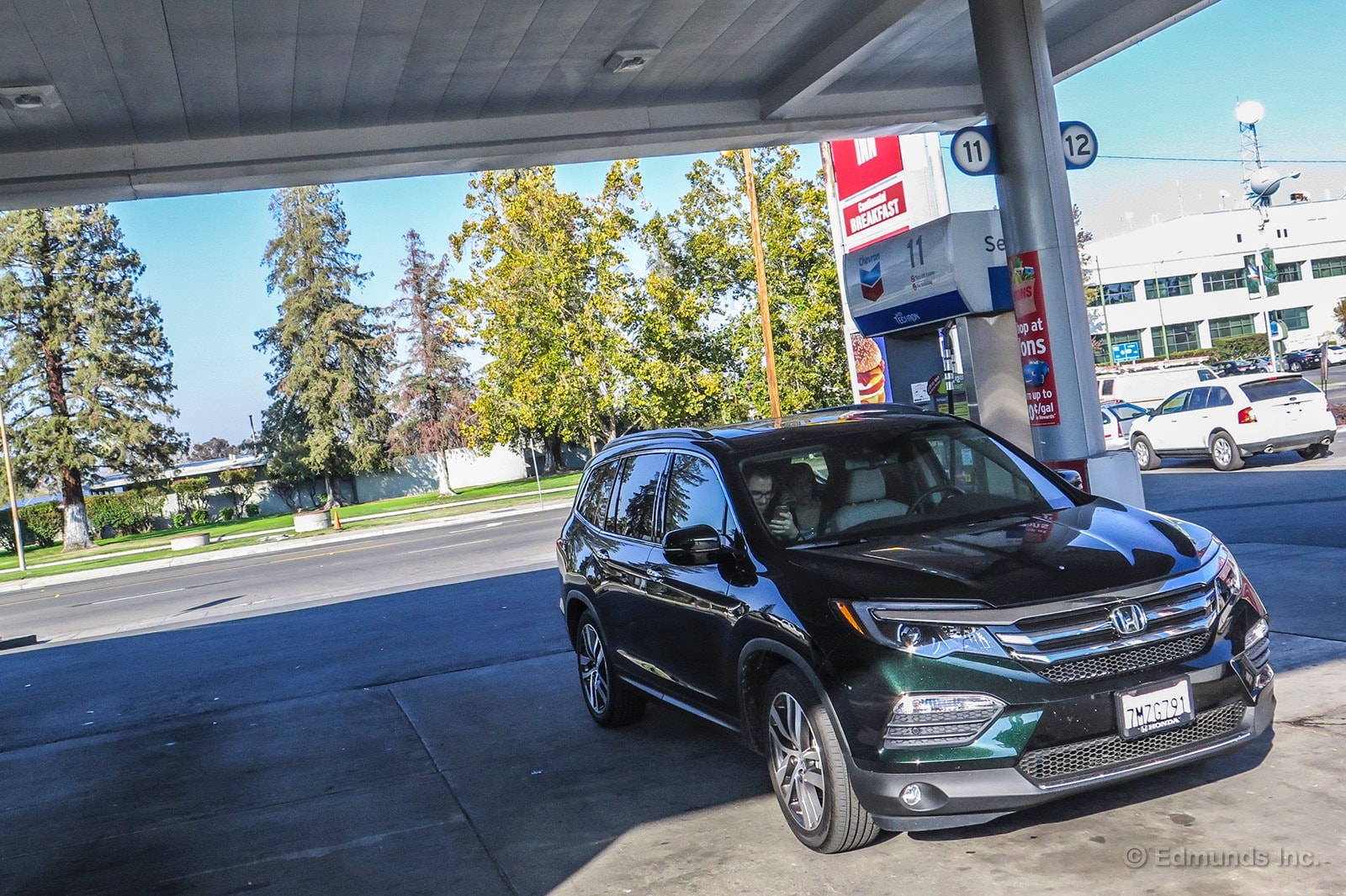
Aside from the lack of third-row space, the Pilot was a really comfortable ride. It smoothed out bumps, was quiet enough to accommodate sleeping passengers, and charged four USB-powered devices at once. And regardless of the early mpg results, I look forward to driving the Pilot again sometime soon.
So far, it's an easy car to drive with lots to love.
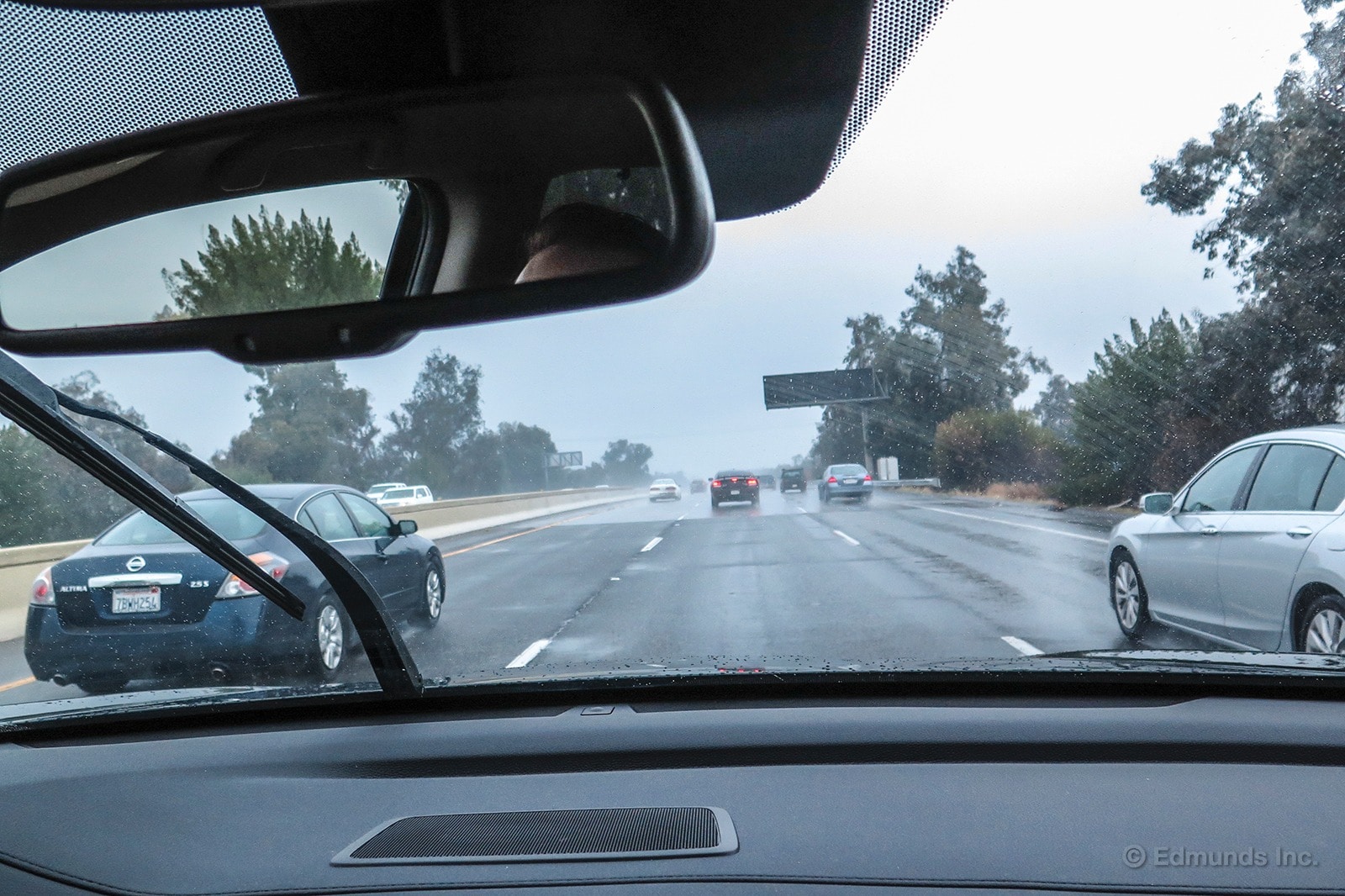
Admittedly, I'm not a huge fan of rain-sensing wipers in general. Aside from a few exceptions, I don't think the technology behind automatic wipers is perfected yet and it's distracting. Enter our newest long-termer, the 2016 Honda Pilot.
On a recent road trip in the Pilot, I drove through a weather system for several hours with every kind of rain there is. If the wiper system were perfect, it would've cleared the windshield of water at ideal intervals, never allowing for an excessive build-up of water while simultaneously staying off when there wasn't any rain present.
Instead, the Pilot's wipers were finicky. I found myself constantly adjusting the wiper stalk, increasing and decreasing the sensitivity nearly every mile. During the heavy rain, the wipers would increase in speed but not quite enough. During light drizzle (or when another car would throw some mist my way) they were a bit too sensitive, wiping too often.
The tech worked, sure, but the level of human-input was too high to call these wipers automatic. If I could, I'd leave this option off the list (it's included on our long-termer's Elite trim level) and just do the work myself.
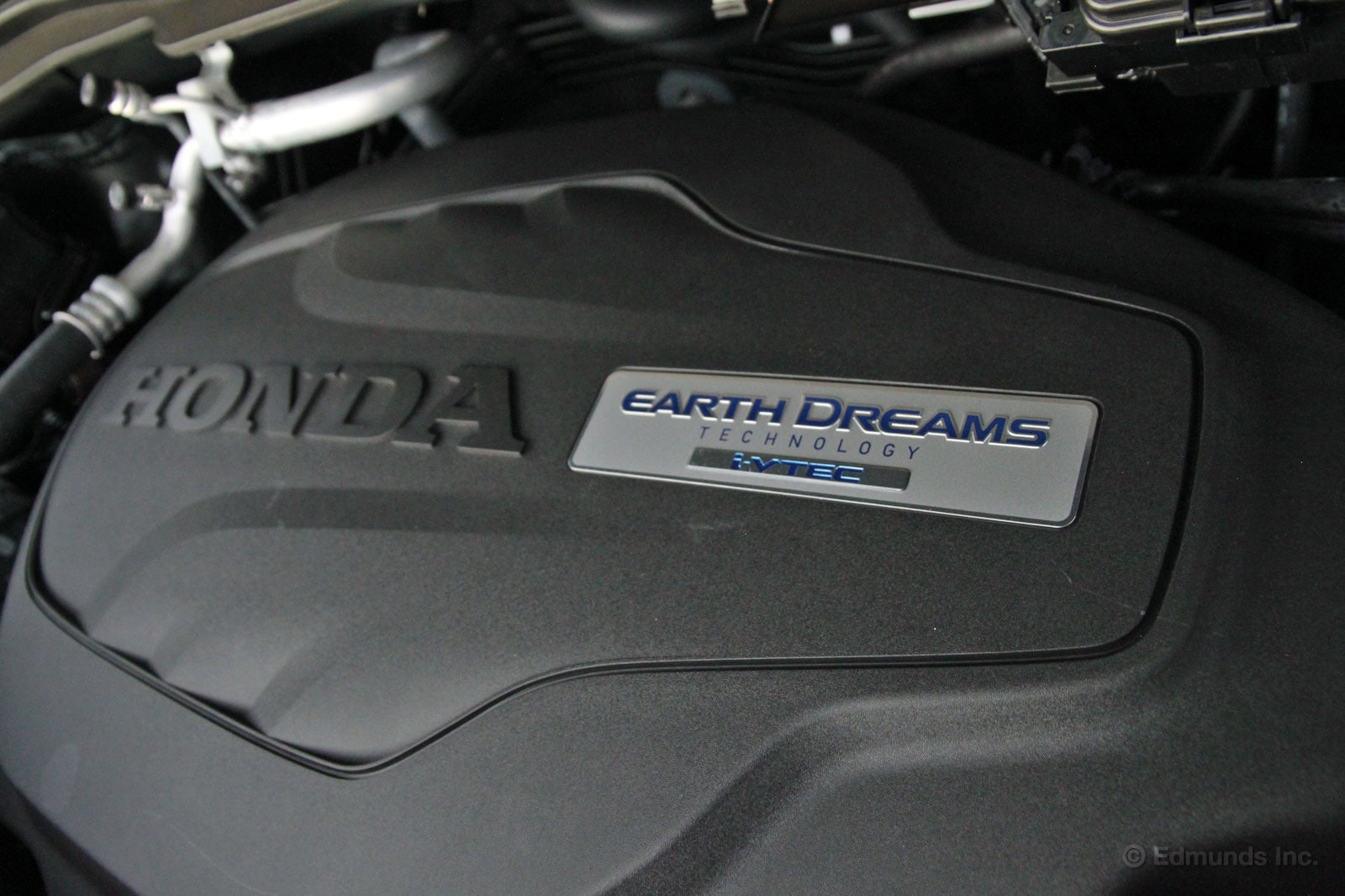
What does "Earth Dreams" mean when it comes to engines? When it involves our 2016 Honda Pilot, it roughly translates into improved mileage. At least that's the idea on its most basic level.
"Earth Dreams" is a catch-all phrase that covers all of Honda's latest fuel efficiency technology. Whether it's a hybrid drivetrain or a particular feature of a gas engine, if it makes things work more efficiently, it falls under the Earth Dreams banner.
In our Pilot, the Earth Dreams badge mainly refers to the Variable Cylinder Management (VCM) feature of the 3.5-liter V6, which shuts down half of the cylinders under certain conditions.
The fact that the engine is hooked to a nine-speed automatic transmission probably qualifies too, but since the nine-speed isn't standard it might not count. There are many smaller technologies baked into the design of the engine that further contribute to the Earth Dreams philosophy, but it would take more than a few blog posts to explain them all.
So far we don't have enough miles on our Pilot to judge the effectiveness of the Earth Dreams technology. Honda says the Pilot is the most fuel-efficient vehicle in its class with its EPA rating of 22 mpg for our particular model. As soon as we get some serious miles on the clock, we'll see how close it comes to delivering on its promise.
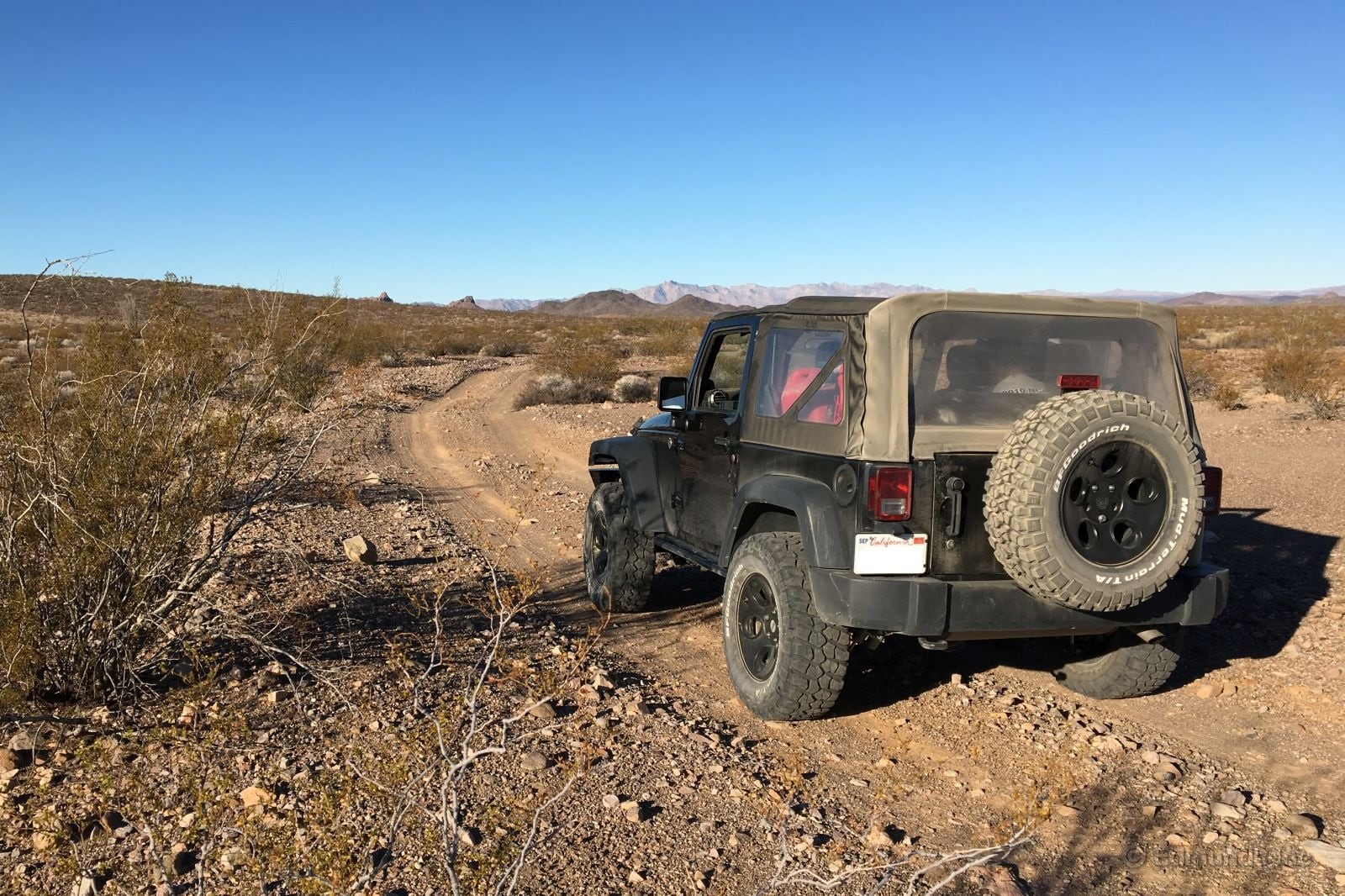
My friends and I were going on a backroad tour of the Mojave Desert, and I figured the 2016 Honda Pilot might be a suitable stand-in for our 2015 Jeep Renegade Trailhawk, which wound up on the disabled list after being rear-ended. After all, our 2012 Honda CR-V had proven to be nicely capable during a similar trip in Nevada awhile back.
But the trip leader wasn't so sure. The roads he'd picked see less maintenance than those Nevada tracks, and the area was generally less predictable. He pointed out that a series of late summer storms had washed out a section of Interstate 40 not 20 miles away.
He was already nervous about the 2012 Toyota Highlander that Terry was bringing and the 2012 Honda Pilot that Rodger would be driving. He assumed I'd be bringing my 2012 Jeep Wrangler, and didn't much like the idea of losing access to a second vehicle with a winch.
So I looked up the relevant clearance specs of our 2016 Honda Pilot. What I found sealed the deal.
I took my Wrangler instead. Better to be part of the solution than the problem.
2012 Honda Pilot (Rodger's)
Approach angle: 24.4 degrees
Departure angle: 22.1 degrees
Ground clearance: 8.0 inches
2016 Honda Pilot (ours)
Approach angle: 18.0 degrees
Departure angle: 19.7 degrees
Ground clearance: 7.3 degrees
The same trend emerges if you compare Terry's last-generation Highlander with a new one. Both new-model approach angles are much worse in what can only be an attempt to increase fuel economy with deeper front spoilers to improve aerodynamics.
Sure enough, Rodger's 2012 Pilot hit bottom up front and dragged its tail through what turned out to be numerous small wash crossings that hadn't seen grader attention in months. Along the way he lost a decorative chrome exhaust tip and had to be yanked out of some sand. He even had to trot out some zip-ties to reattach a plastic underbody trim piece that had come adrift after the front chin spoiler did a snow-plow impersonation on gravel.
He loved every minute of it, but he had well and truly found the off-road limit of his Pilot. Terry's Highlander fared slightly better because he'd replaced his worn OE tires with slightly knobbier ones. And his aftermarket trailer hitch grounded out instead of his rear bumper.
It was clear I made the right choice. Our 2016 Honda Pilot has much lower clearance limits than Rodger's. I would have torn it up or gotten truly stuck, possibly both.
Meanwhile, the Wrangler yawned its way through the entire weekend, as did the 4-Runner and FJ Cruiser. They're built for the unexpected; crossovers aren't. And the situation will only get more acute with successive full redesigns as increasing fuel economy pressures exert their influence on the overall design. It would seem that clearance angles are the first attributes for sacrifice.
I am curious about bringing the Jeep Renegade Trailhawk out here once it's back in service. That's a crossover that should have nothing to fear out here.
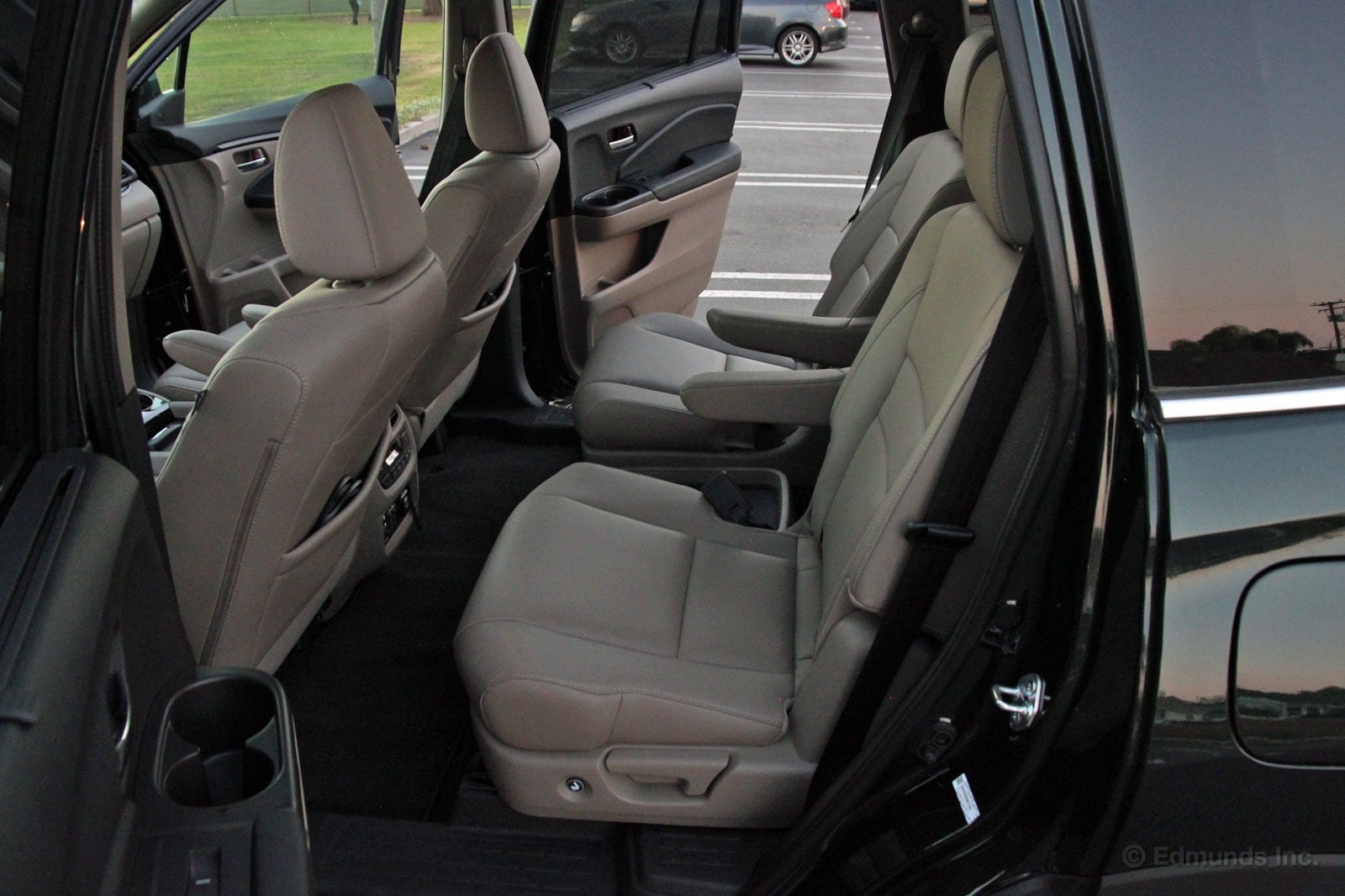
From this angle, the rear seats in our 2016 Honda Pilot don't look particularly spacious. Measure them against the competition, however, and they match up quite well. Here are the numbers against some popular rivals:
In terms of legroom, the Pilot sits midpack. It offers exactly the same amount of legroom as the Toyota Highlander and an extra two inches compared to the Chevrolet Traverse. Want more? The Ford Explorer tops the Pilot by an inch in this area.
When it comes to headroom, it's pretty much a wash. All of the competitors mentioned here are within an inch of each other so you probably wouldn't notice a difference.
Shoulder room is an often-overlooked parameter when it comes to interior passenger space. Here the Pilot does well, topping both the Highlander and the Explorer by an inch and the Chevy by two inches. Then again, since we're dealing with captain's chairs it really doesn't come into play. With the bench seat in back, the extra shoulder room would certainly come into play.
The seat themselves are above average in terms of shape, adjustability and materials. Always nice to have a fold-down armrest, too. As midsize crossovers go, the second row in the Pilot is definitely near the top of its class.
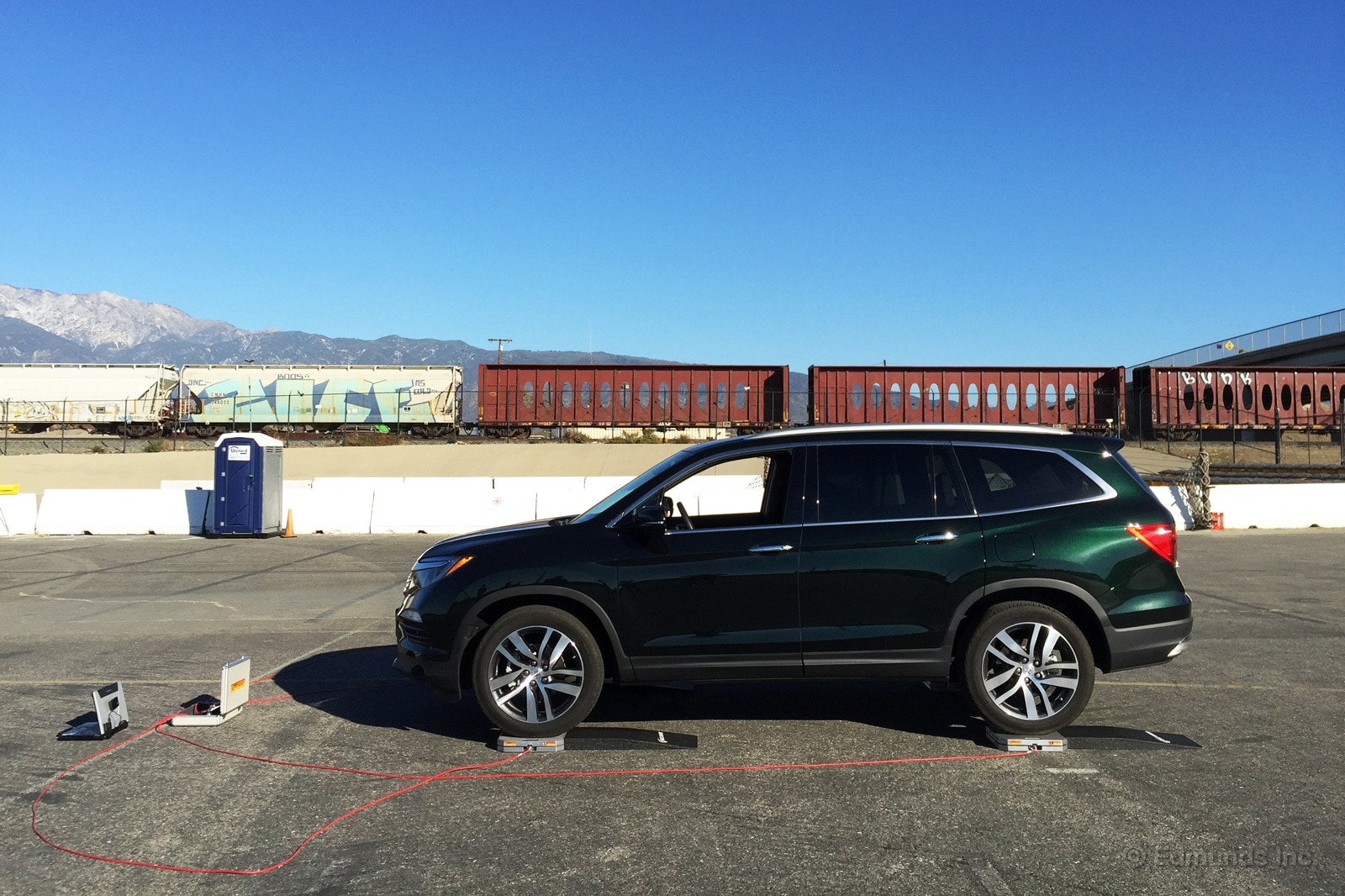
The 2016 Honda Pilot only needs to accelerate and brake well enough to safely carry people and cargo on the street. It's probably safe to say that most Pilot owners aren't concerned with quarter-mile trap speeds or lateral loads on the skidpad.
The Pilot wasn't designed with track performance in mind, yet it remains one of the most competent vehicles in its class when pushed. Read ahead to see the numbers.
Vehicle: 2016 Honda Pilot Elite AWD
Odometer: 2,434
Date: 11/24/2015
Driver: Jonathan Elfalan
Price: $47,300
Specifications:
Drive Type: All-wheel drive
Transmission Type: Nine-speed automatic
Engine Type: Naturally-aspirated V6
Displacement (cc/cu-in): 3,471/212
Redline (rpm): 6,750
Horsepower (hp @ rpm): 280 @ 6,000
Torque (lb-ft @ rpm): 262 @ 4700
Brake Type (front): One-piece ventilated discs with two-piston sliding calipers
Brake Type (rear): One-piece discs with single-piston sliding calipers
Suspension Type (front): MacPherson strut front suspension
Suspension Type (rear): Multi-link
Tire Size (front): 245/50R20 102H
Tire Size (rear): 245/50R20 102H
Tire Brand: Continental
Tire Model: CrossContact LX Sport
Tire Type: Regular all-season
As tested Curb Weight (lb): 4,301
Test Results
Acceleration:
0-30 (sec): 2.5 (w/ TC on 2.6)
0-45 (sec): 4.5 (w/ TC on 4.3)
0-60 (sec): 6.6 (w/TC on 6.7)
0-60 with 1-ft Rollout (sec): 6.3 (w/TC on 6.3)
0-75 (sec): 9.8 (w/TC on 9.9)
1/4-Mile (sec @ mph): 14.8 @ 92.9 (w/TC on 14.8 @ 92.6)
Braking:
30-0 (ft): 31
60-0 (ft): 123
Handling:
Slalom (mph): 60.7 ( 59.1 w/TC on)
Skid Pad Lateral acceleration (g): 0.79 (0.77 w/ESC on)
RPM @ 70: 1,800
Comments
Acceleration: The Pilot doesn't like power braking. In fact it only delays it on the launch. The quickest run was achieved in Sport mode, going from brake to throttle with right foot as quickly as possible. With all-wheel drive, there's no wheel spin leaving the line either, which accounts for the speed advantage over the front-drive Pilot we tested.
The engine revs smoothly, and feels best from the mid-rpm range to high-end. It tends to make its best power just before 5,000 and upward, where torque peaks. The transmission shifts quickly and crisply, keeping in lock-step with the eagerness of the engine. Nice powertrain.
Braking: Brake pedal travel is fairly long and with a fair amount of squish. There's a good level of anti-dive engineered into the suspension geometry, so the Pilot's front end doesn't dive much even under hard emergency braking. The ABS activation is audible and quite a bit of suspension noise makes it into the cabin. But it tracks straight and stable, with only a little lateral wiggle experienced on some of the runs.
Braking distances were nice and consistent with only a couple feet of variance after five runs, and with no discernable odor from over-baked brake linings. The 123-foot braking distance is about average for the class (124 feet)
Handling
Slalom: The Pilot understeers and rolls quite a bit but is most noticeably lazy and slow to respond through the slalom. Lack of steering feel and effort build-up make for a numb front end best-suited for comfort cruising, not performance driving. The trick to quickly navigating the slalom was to drive below the stability control's threshold. The system is very invasive past a point, so the less steering movement and lateral inertia you generate, the better.
Skidpad: Traction control on/off doesn't affect the level of understeer sustained around the skid pad. Once the Pilot takes a set in the corner, it keeps a pretty consistent and predictable line despite not carrying a ton of speed. The steering manages to deliver a relatively precise feel for an SUV despite the large all-season SUV tires, but transmits very little feedback from the road. All-wheel drive helped the skid pad number a bit with traction turned off, but was identical to the FWD car with it on.
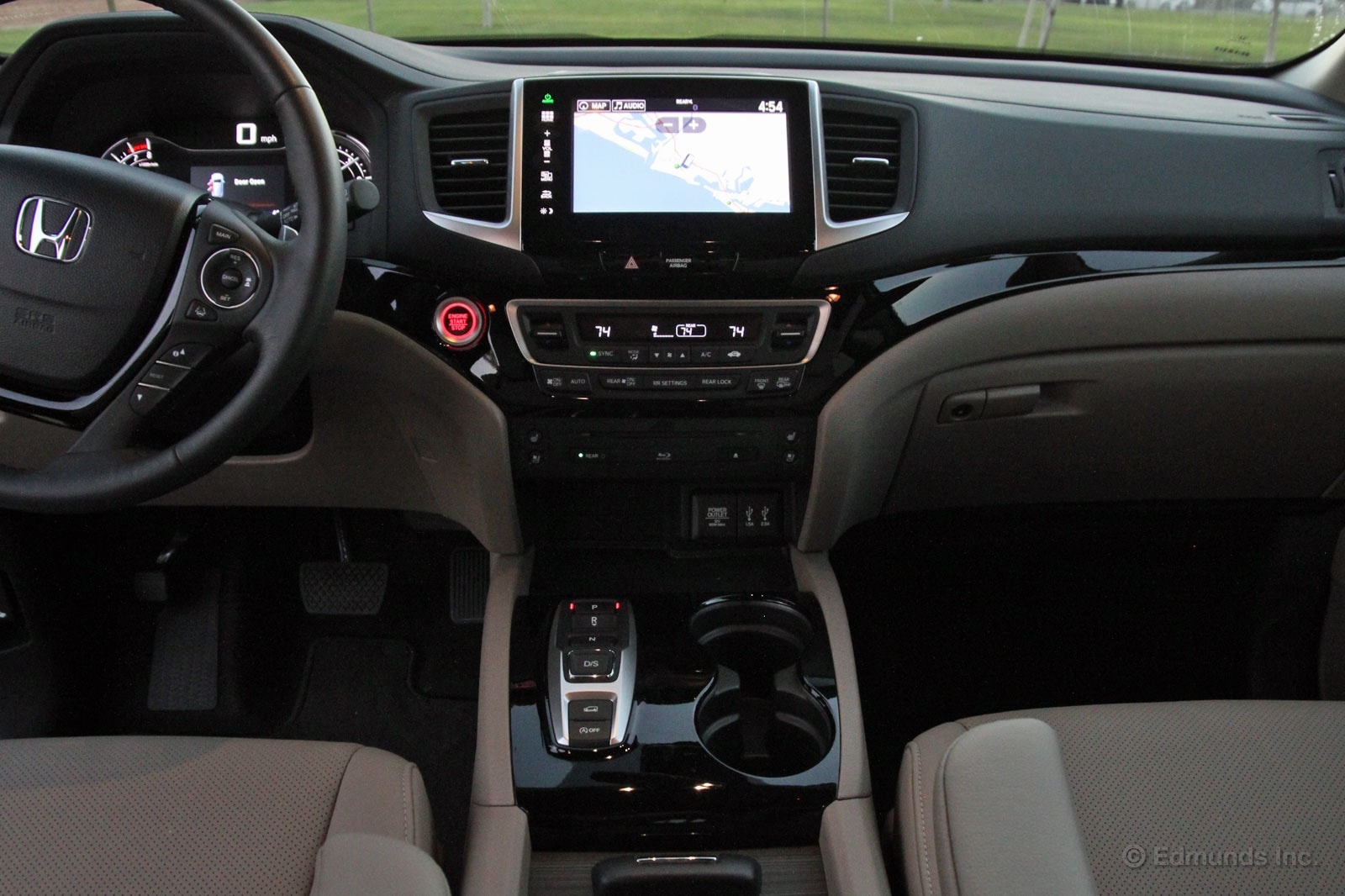
There's something almost too nice about our 2016 Honda Pilot. It's probably a result of the high-line "Elite" trim and all that comes with it, but if I was buying one of these for my family I might step it down a notch. Here's why.
When I drove the Toyota Highlander we had for a year, it always seem built for function over all else. Sure it was the top-of-the-line Limited model, but everything looked like it was there to be functional first.
The big shelf that stretched across the dashboard was a perfect example. It was a little abrupt from a design standpoint, but when it came to daily driver duty, that shelf swallowed lots of stuff. And although the materials were nice, they didn't make the Highlander look like a luxury car.
Looking like a luxury car is rarely a bad thing, but in this car I would rather just live with the lack of wood and not feel bad about spilling some coffee now and again.
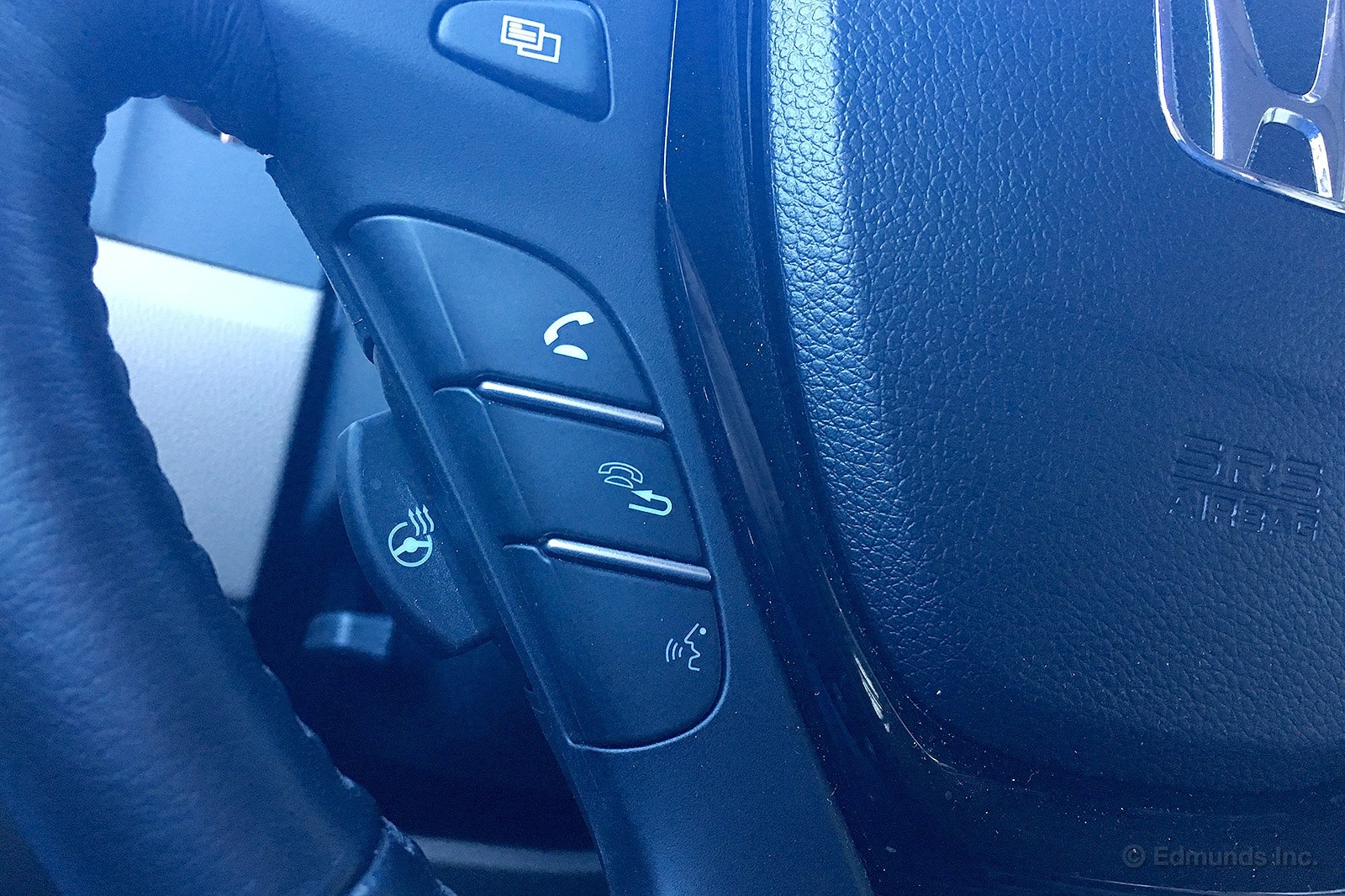
We've been banging around in our long-term 2016 Honda Pilot for a little more than a month now and we have our first mechanical issue. I wouldn't call it serious, but it's certainly annoying on a brand new vehicle that's been driven 3,000 miles.
This morning the Pilot's heated steering wheel was a no-show.
Now, I'm not sure if we took delivery of the vehicle with this malfunction and I'm just the first to notice, or if it worked before and now it does not. Either way, it's busted. Push the button on the lower left of the steering and nothing happens. No lights indicating that it's operating and no warmth within the Honda's leather-wrapped rim.
And now the decision all car owners face when something goes awry. Should we get it fixed now, or live with it for a while and have it addressed when the Pilot goes in for its first scheduled maintenance?
What would you do?
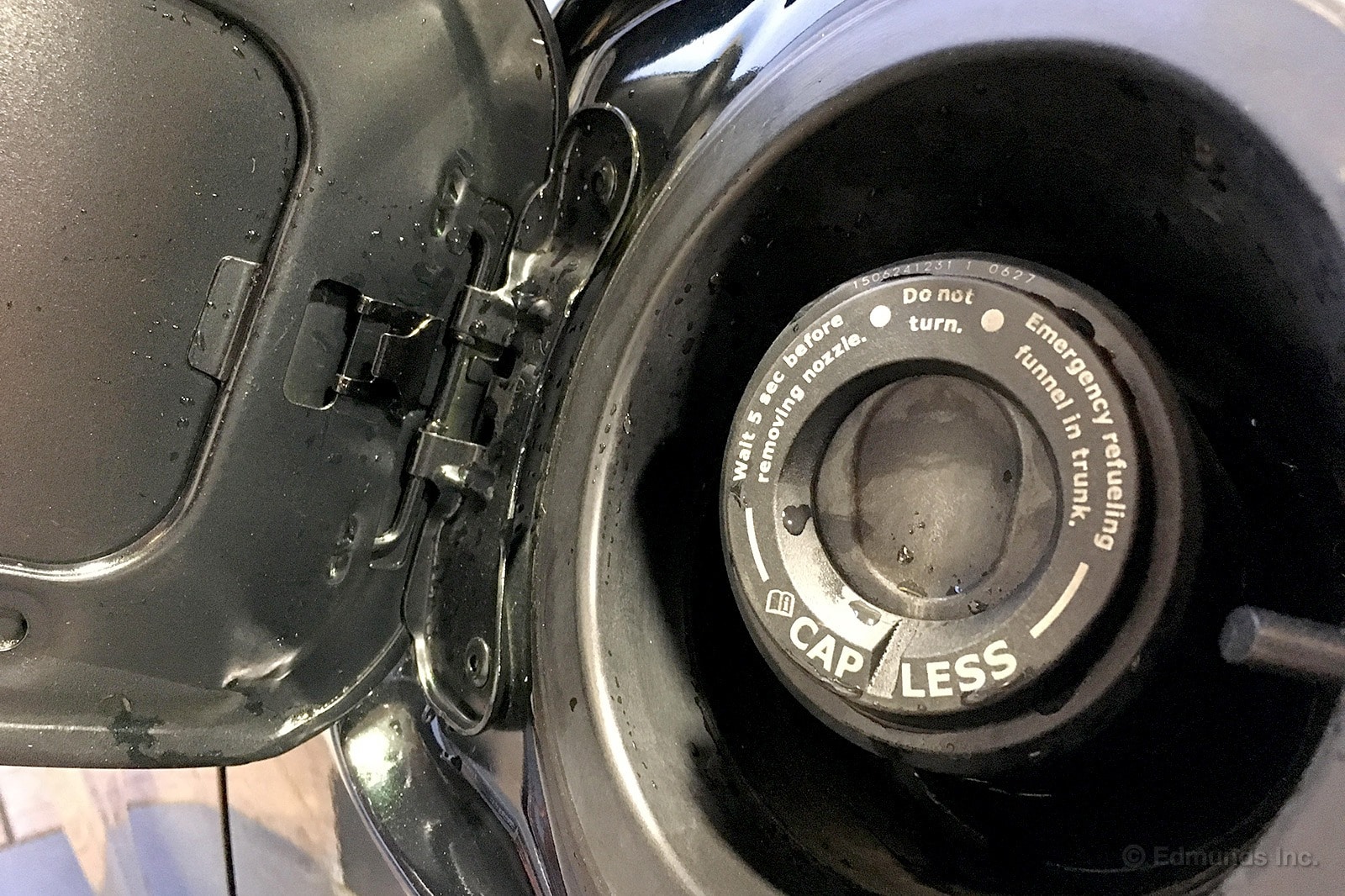
The car biz is a copycat biz, which is one of the reasons so many cars kinda look alike, drive alike and offer the same or similar features and technology. If something's a hit with the public, you can bet your Bluetooth it'll be on the competition soon.
I was reminded of this while filling the gas tank of our long-term 2016 Honda Pilot.
Ford pioneered the Easy Fuel Capless Fuel Filler back in 2008 (on the 2009 Explorer), and we've lived with a few Fords with it since, including our long-term 2009 Ford Flex, 2010 Ford Mustang GT, 2011 Ford Explorer and 2013 Focus ST. Our orange long-term 2015 Ford Mustang GT is the latest.
Basically there's no cap to unscrew or hang while fueling. Just insert the gas pump nozzle and start gassing up.
Seven years ago, I thought this was gratuitous engineering at its worst, an answer to a non-question. Now I love it. It's one of those things you don't know you want but once you have it, there's no going back.
And I must not be alone, because other car companies have started using the technology including Chrysler, Cadillac and now Honda on the new Pilot.
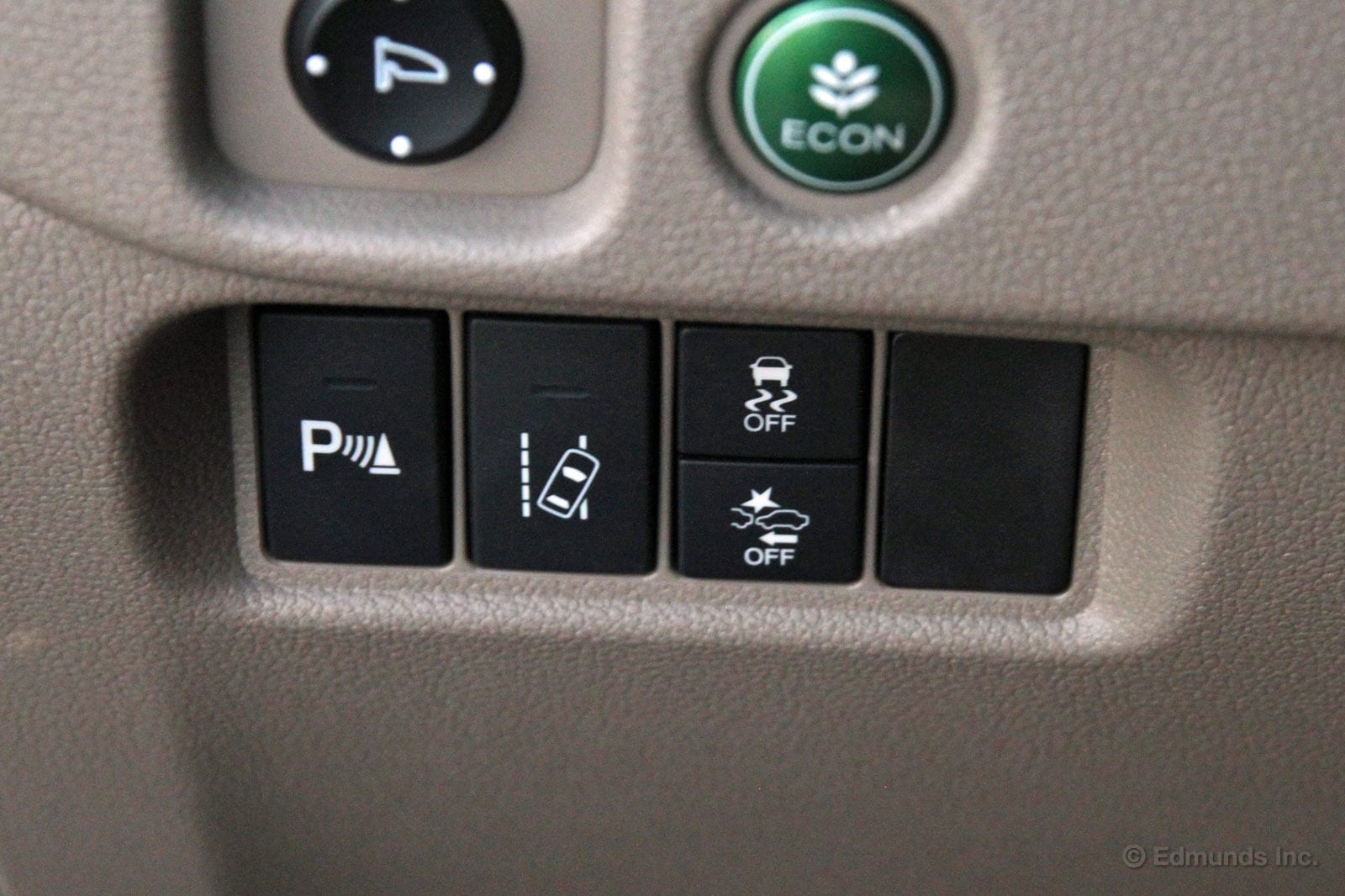
This array of buttons is a good reminder of just how many active safety systems are watching the road when you're behind the wheel of the 2016 Honda Pilot. It almost looks like overkill, but these days this is considered perfectly normal.
For those that aren't familiar, here's what these buttons control. Starting on the left, you have your typical backup warning system, then a lane departure warning system, electronic stability control and finally a collision mitigation system.
Most modern cars and SUVs have parking sensors. They're useful, unobtrusive and rarely do you need to shut the system off. Lane departure warning systems are relatively new. They can be useful, but I rarely find them necessary. Glad to see you can turn this one off.
Stability control is now mandatory for all vehicles. Only reason to turn it off in a vehicle like this might be if you're stuck and you think it might prevent you from putting enough power down to get out. Finally, the crash avoidance system is one of the newest features and one that can be annoying if not programmed properly. We've noticed several Hondas that seemed far too eager to warn of an impending collision in otherwise benign situations. Thankfully, this system's sensitivity can be adjusted, although you have to go through some menus to find it.
It's quite a bit of technology and I'm glad it's all there to help out. Then again, it's nice to see these buttons give you some measure of control as well. I'm not looking forward to the day when stuff like this is watching whether you like it or not.

It's time for the Edmunds family's annual holiday trip to Oregon to spend Christmas with my parents. This year I locked in on one particular long-term vehicle as soon as it was admitted to the fleet: the 2016 Honda Pilot.
Why? It has a goodly amount of hauling capacity for the luggage and presents the four of us will haul up there and its third-row seat will make it possible for my parents to climb aboard once we settle in and make the inevitable trip into town. Both of these were shortcomings of the 2012 Honda CR-V we took up there a couple of years ago, which needed a rooftop cargo box to accommodate our stuff and had no third-row passenger capability. Here's hoping the Pilot is more or less a supersized CR-V.
What's more, our particular Piot has the optional all-wheel drive system. This year's El Nino weather cycle has so far proven very active up along the southern Oregon coast. Heavy rain has fallen for weeks at Mom and Dad's place and snow is in the forecast. There have been numerous mudslides. There's no telling what sort of detours we may be forced to take.
Fuel Economy Update for December — Early Disappointment
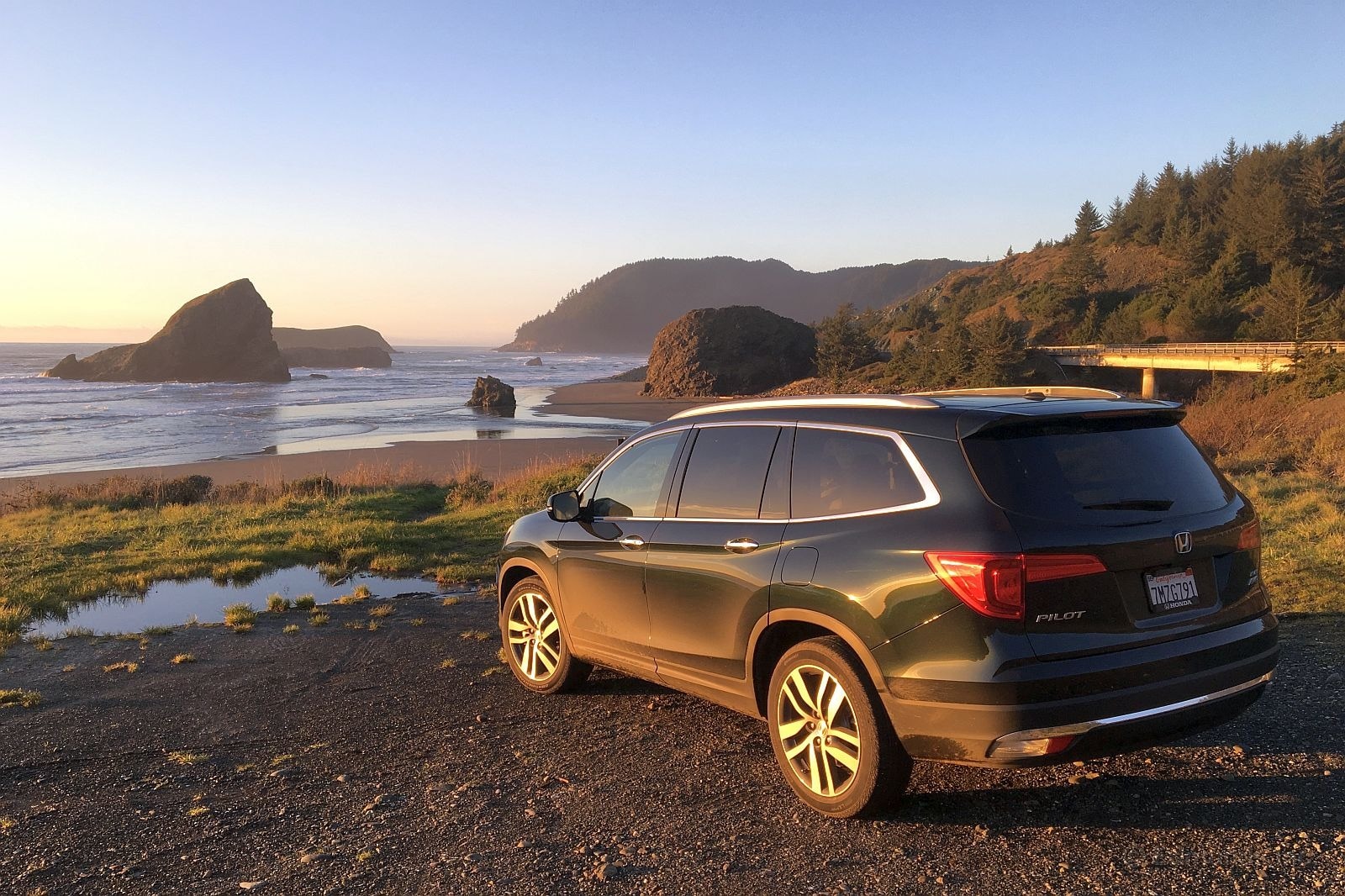
We were hanging out with my parents on the Oregon coast during that quiet week between Christmas and New Year's Day and our 2016 Honda Pilot wasn't going much of anywhere. I added the Pilot's last fill-up of 2015 while still on the California side of the border so I could pump it myself.
Oregon is one of two states where you can't pump your own fuel, and I've always been turned off by how the so-called "professionals" routinely top-up a tank mercilessly with several clicks in order to round the total to an even dollar — even when they know I'm paying with a credit card.
It screws up my MPG record-keeping and I have no doubt this kind of thing cost Dad several hundred dollars a few weeks ago when his 2007 Tacoma's evaporative emissions canister finally gave up the ghost after years of such abuse.
But I digress.
Our half-finished trip has added 778 miles of pure road trip fuel economy to the Pilot's total. Drum roll, please.
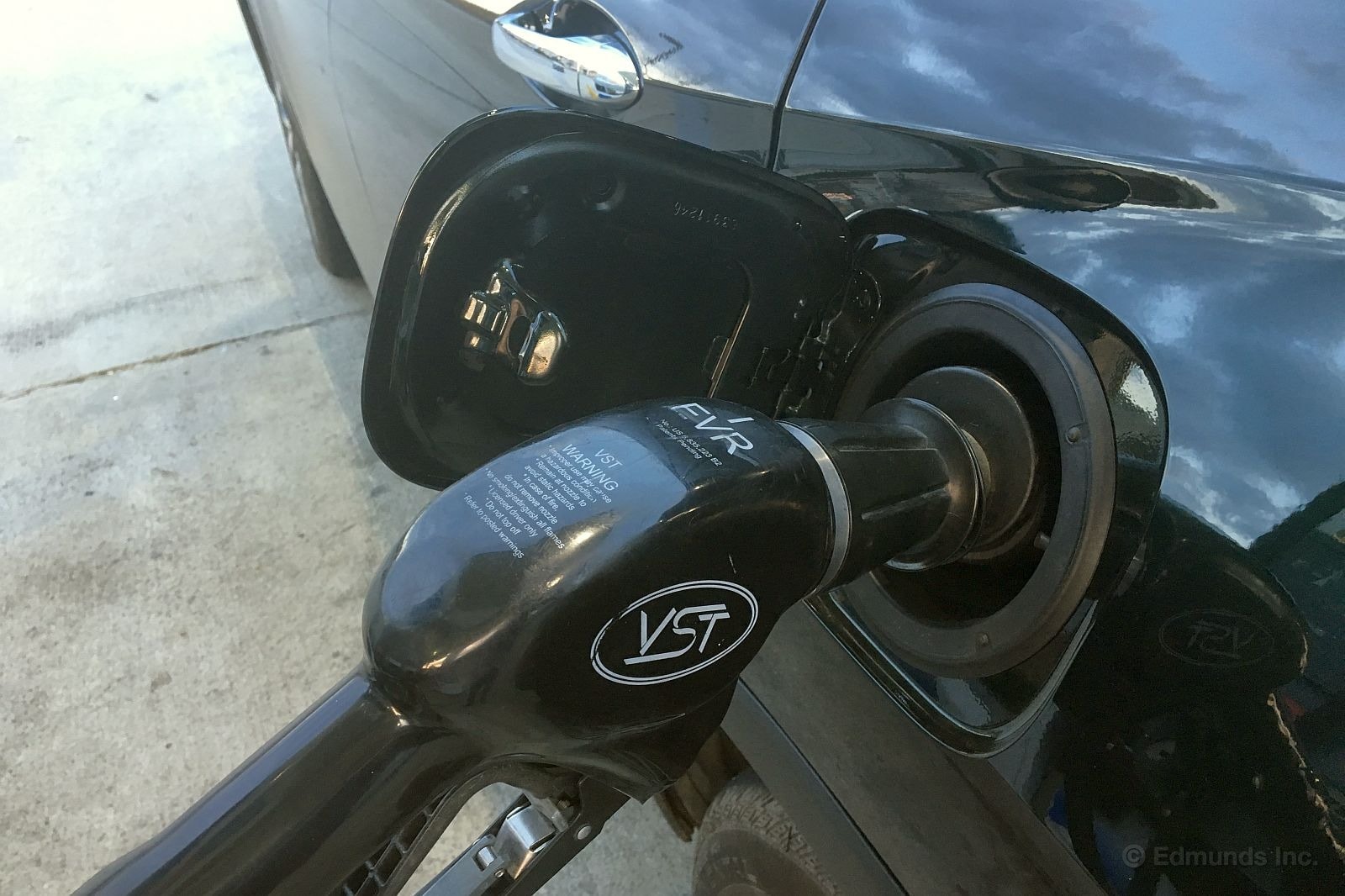
Our trio of northbound highway tanks ranged between 20.9 and 22.1 mpg, with an overall average of 21.3 mpg. Not good. Our all-wheel-drive Pilot with its nine-speed automatic transmission is EPA-rated at 26 highway mpg. We didn't even manage to equal its EPA combined rating of 22 mpg.
Including other routine December driving miles added before our road trip, our new Pilot's lifetime average sits at a piddling 18.9 mpg.
It is early days for this engine, but I'm pointing a tentative finger at the nine-speed transmission. No one likes how it behaves and I'm coming to believe that such overly-cogged gearboxes only serve the interests of the automaker on the fuel economy test dyno.
Yes there were four of us, and yes we had luggage and presents aboard. But come on. We missed the rated mpg by a mile in reasonably good conditions.
Worst Fill MPG: 13.1
Best Fill MPG: 24.2
Average Lifetime MPG: 18.9 (5.3 gallons per 100 miles)
EPA MPG Rating: 22 Combined (19 City/26 Highway)
Best Range: 364.8 miles
Current Odometer: 4,378 miles
At least I know one thing: January's fuel economy update will include still more road trip miles from our return trip.

The holidays are over and we're back home in southern California. All told, our round-trip to Oregon added 1,767 miles to our 2016 Honda Pilot. I'd like to say we enjoyed each and every one of them immensely, but at least two of us were cranky with head colds at any given time.
That's not the car's fault, of course. Mostly, it did its job admirably. But there are a couple of things we took issue with. Here's a rundown of the highlights and lowlights we encountered along the way.

The Good
Seat heaters: excellent tri-level heaters that warmed up quickly. "The best ever," according to my wife. Of course the companion steering wheel heater was inoperative, as Scott noted earlier. I vote to take it in for service now while the weather is still cold enough to make a difference.
Door pockets: Quietly clever multi-level design with the bottle holder high and forward in an easily-reached spot. I had my wallet and sunglass case on the second tier the whole time and other stuff lower down. Even the door-pull finger pockets are big enough to hold some loose change.
Cargo storage: When exposed, the shallow well behind the third-row was a handy way to confine grocery bags from straying too far, and this worked equally well with the third seat stowed or not. With its lid in place, the well became an underfloor storage spot that swallowed and protected our smaller presents so they wouldn't get crushed when we piled our luggage and larger items on top. As for the main cargo hold, well, it's huge.
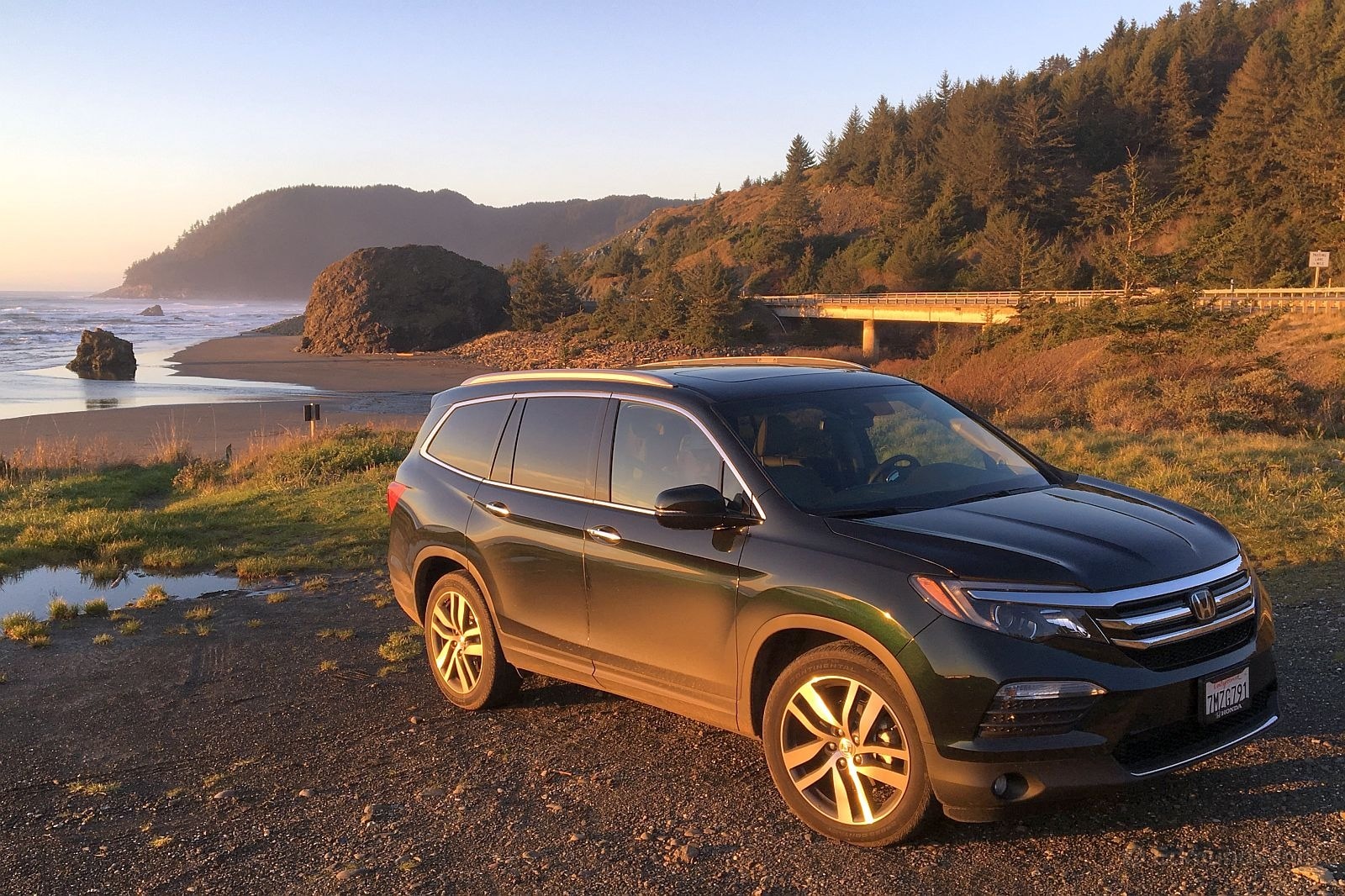
The Bad
Cruise control: I discovered an easy way to switch between adaptive cruise and regular cruise, which was a good thing because the adaptive system irked me no end with its overactive response to nearby cars. I can only tolerate it with little or no traffic, at which point I might as well use normal cruise control. But the normal system is annoying in the sluggish way it responds to "set" commands and its near complete inability to maintain my desired speed on upgrades or downgrades.
Nine-speed transmission: Much has been said about the various vehicles that have been negatively impacted by the application of ZF's nine-speed automatic. It doesn't seem like any car company can elegantly calibrate the confounded thing. And it feels like nine gears is simply too many. It has to downshift three or four gears when I need to pull out to pass, which results in a big lag while it sorts itself out. And the pushbutton shifter that comes with it is frustratingly laggy, too.
I'm willing to bet the six-speed and mechanical shifter combination that comes with the Pilot LX and EX would be far more satisfying to drive, or at the very least less frustrating. And I also suspect the nine-speed's one-mpg window-sticker advantage may well evaporate in real-world use.
Touchscreen audio: Where can I start? It's slow and the touch-sensitive volume control is a nightmare. This thing desperately needs physical volume and tune knobs. But the worst is the ridiculously tiny size of the "source" and "map" touch-sensitive regions (I wish I could call them buttons, but they're not) that are used to swap between modes. They're an inch wide, but only like a quarter-inch tall, which makes them easy to miss when the car is rolling, on account of the normal random vertical body movement a car has going down the road.
This is especially true in northern California and southern Oregon, where the roads are subtly wavy and uneven due to constant land movement. This is what happens when things are designed on a monitor and bench-tested indoors. A vehicle integration staffer driving a physical prototype on real roads should not have missed this.
As for fuel economy, the return trip was only slightly better than the trip north. Tanks of 20.8, 22.1 and 22.7 mpg resulted in a southbound average of an even 22 mpg, which brought the entire trip average up slightly to 21.7 mpg. But this is disappointingly weak when you compare it to the relevant rated fuel economy number: 26 mpg highway.
On the bright side, I did manage to set a new "best range" mark of 385.8 miles along the way.
But there's little rest for the weary. Now that I'm home I have the weekend to unpack and rest up before I have to climb aboard again and pilot the Pilot to Las Vegas for an event associated with the Consumer Electronics Show. But this time I'll be alone with just one small bag. And no matter how many others fly past, I plan to fix my speed at 70 mph on the freeway and use some secondary desert roads posted at 65 mph.

One thing is certain: you will see some weird stuff if you spend enough time in the desert, even if you're not Hunter S. Thompson.
Exhibit A: The S.S. Stell, a fiberglass ski boat I found slung beneath the superstructure of a high-tension transmission tower.
I have no idea.
I ran across the mighty S.S. Stell while driving to the Consumer Electronics Show in Las Vegas in our 2016 Honda Pilot SUV. I had pulled off the road onto an adjacent dry lakebed for a quick photograph, and there it was. The Stell wasn't anywhere near the well-traveled freeway, though. It was near a lonely two-lane road that I had detoured onto to help keep my speed down.
That's because this trip was an MPG run, of sorts.
Carrying just me and a single bag, my quick solo trip to Vegas was an opportunity to see if the Pilot could redeem itself after turning is a disappointing road-trip fuel economy performance over the holiday break.
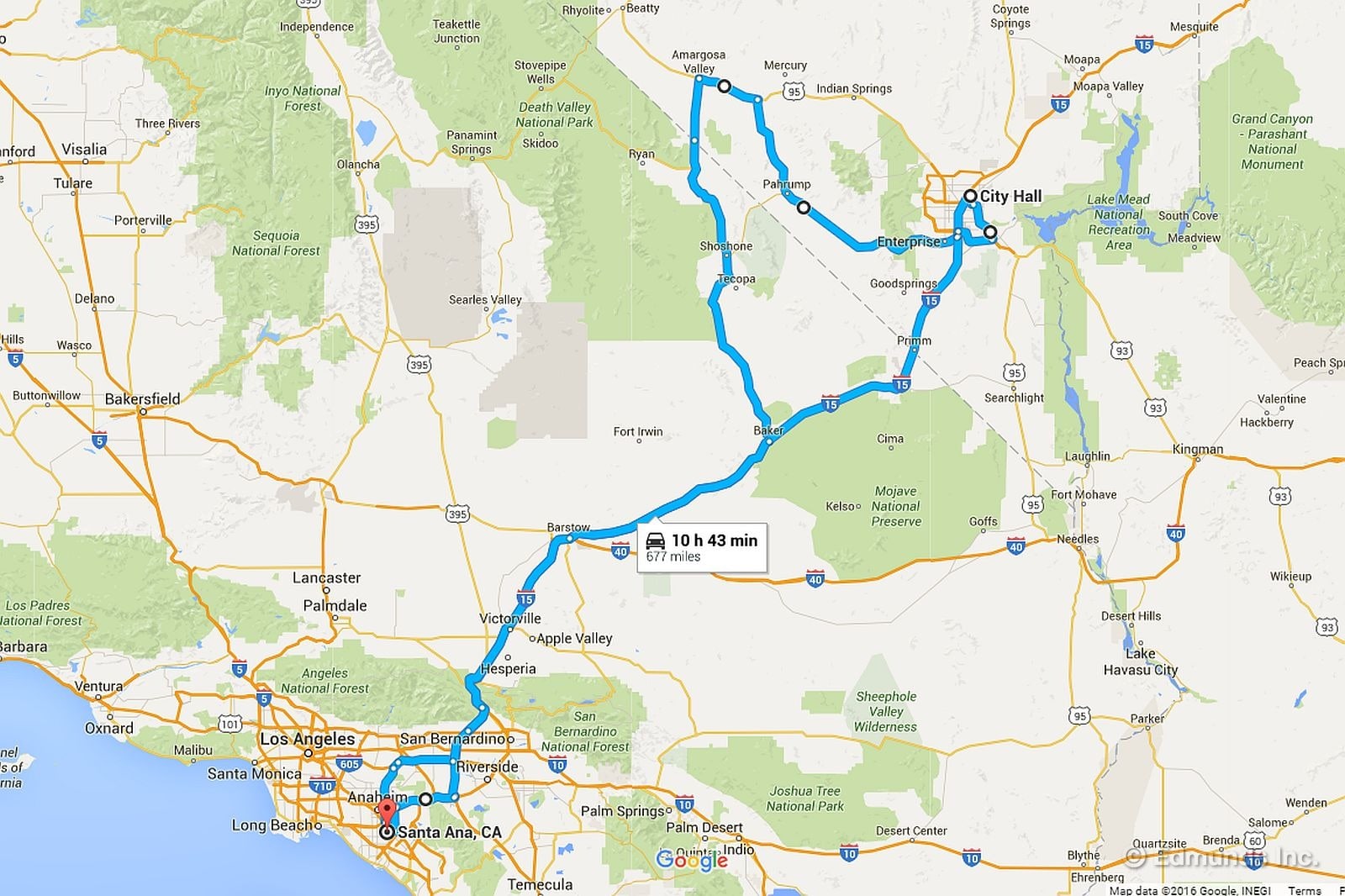
Interstate 15 is posted at 65 mph in town and 70 mph in the desert, and I was sticking to those limits religiously. But the prevailing flow of Vegas-bound traffic had other ideas and made this uncomfortable. So I detoured onto a series of two-lane roads posted at 55 to 65 mph, a pace I could maintain easily with no one bearing down on me. Besides, there was more to see out the windows.
This long inbound detour made it possible for the Pilot to achieve a new best range of 400.6 miles by the time I arrived in town and filled up. The resulting 15.862-gallon top-up worked out to an inbound fuel economy of 25.3 mpg.

Midweek outbound traffic was very light, so I stuck to the interstate on the way home. This time I could run a steady 70 mph without turning myself into a rolling bottleneck. Rain fell during the final 100 miles and the resulting spray trimmed the prevailing speed to less than 55 mph as I summited the Cajon Pass and dropped into a drying L.A. basin.
This more direct leg was 321 miles and I pumped in 12.449 gallons of regular unleaded when I got home to record a new best tank of 25.8 mpg and an overall trip average of 25.5 mpg. While under by a thin margin, these two figures do round up to the Pilot's 26-mpg EPA highway fuel economy rating. But I drove alone and ran at or below 70 mph to pull it off.
Meanwhile, the mystery of the S.S. Stell remains unsolved. Oh, wait. It's the desert. It all makes perfect sense in a gonzo, Vegas kind of way.
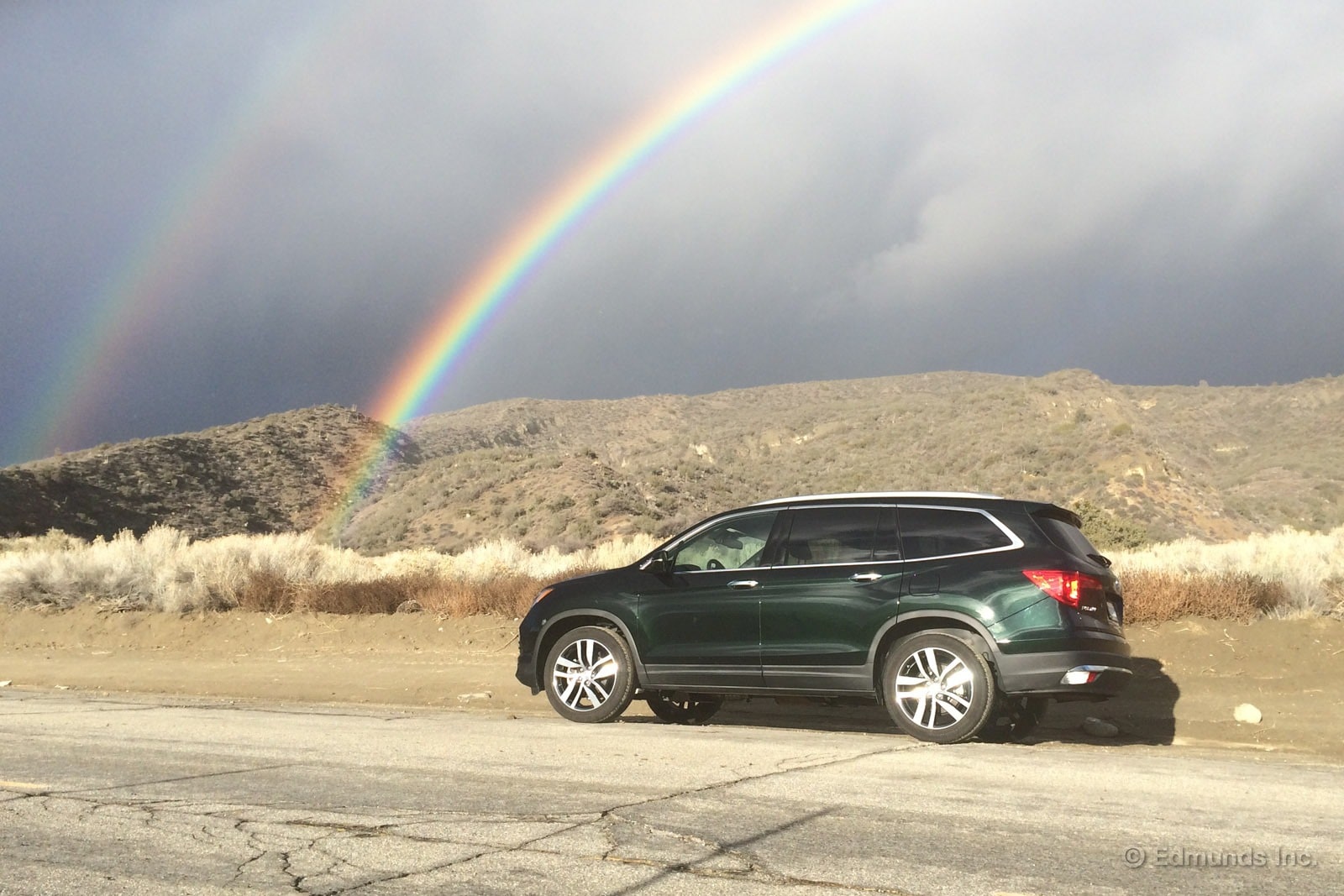
On a recent weekend, my wife's friend was visiting our house. She noticed the long-term 2016 Honda Pilot parked in the driveway and asked a few questions that concluded with, "How much does it cost?"
Ummm...
I actually didn't know our test vehicle's exact price at the time, but told her that it was likely around $45,000 (actual price: $47,320.) I was expecting her to say something along the lines of "Geez, that's pretty expensive," but instead she replied, "Oh, well that's reasonable."
I was a bit surprised at first, but then I remembered what she drives: a 2014 Mercedes-Benz ML350.
It's interesting to me how perception influences one's view on whether something is thought of as expensive. A few weeks ago, my colleague Ed Hellwig wrote an update noting how our decked-out Pilot might be a little too nice for his tastes. Yet as I learned later, my wife's friend's interest in the Pilot actually stemmed from her desire for a less expensive car than her ML-Class. In her case, even a top-of-the-line Pilot Elite would be noticeably less expensive.
You can get a more objective viewpoint by comparing vehicles within a particular class. And yet the reality is that the mid-$40,000s is pretty much what you can expect to pay for a loaded-up three-row crossover these days.
We (the Edmunds crew) like testing well-equipped vehicles (such as our Pilot Elite) as it gives us the opportunity to report on all of the available features. But I'm curious — if you were buying a large three-row crossover SUV like a Pilot, what do you think your budget would be?
Would you be fine getting a top model or is there a sweet-spot?
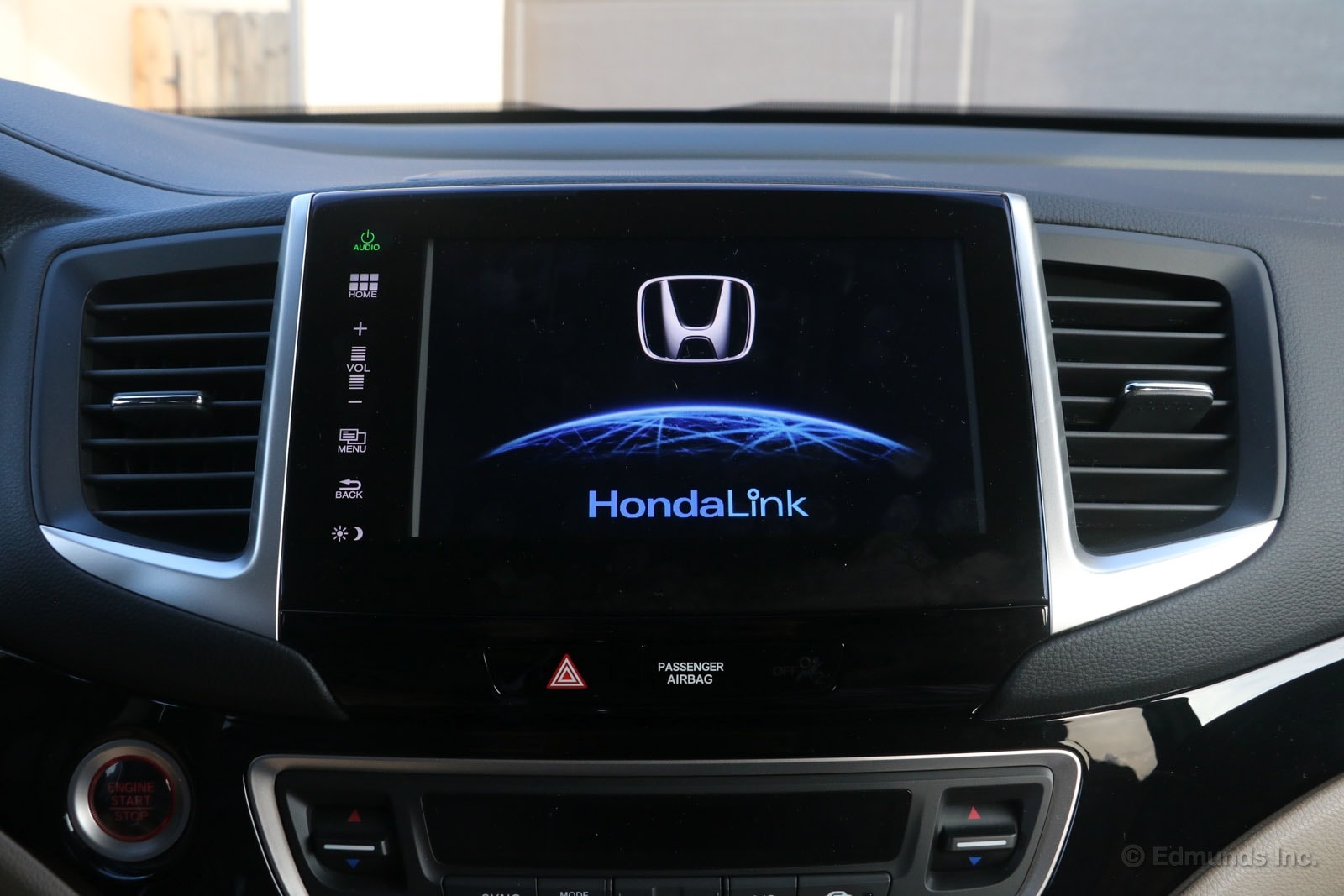
Dan Edmunds touched on this in his recent Road Trip Recap update but it's worth expanding further: the touchscreen interface in our 2016 Honda Pilot has some design issues.
Dan specifically mentioned Honda's choice of virtual buttons instead of buttons or knobs. As you can tell from the photo, there isn't a volume knob. It's just a touch-sensitive controller.
Does it look neat? Yes. Does it work well? No.
It's just too distracting trying to tap or slide your finger to adjust the volume while on the move, especially if you want to make a quick and big change. There's no tuning knob, either.

Then there are small virtual buttons for "source" and "map" (top right of the touchscreen) that Dan mentioned. These appear when you've got the audio display up. I agree with Dan that they are just too small to consistently touch correctly.
I've noticed a couple other problems as well. The first one is a slow response time. Sometimes the Pilot's touchscreen responds quickly to my touch. Other times there's a delay (about a second or so) before anything happens. When this happens, I'm left to wonder: did I touch the button right? Do I have to push it again?
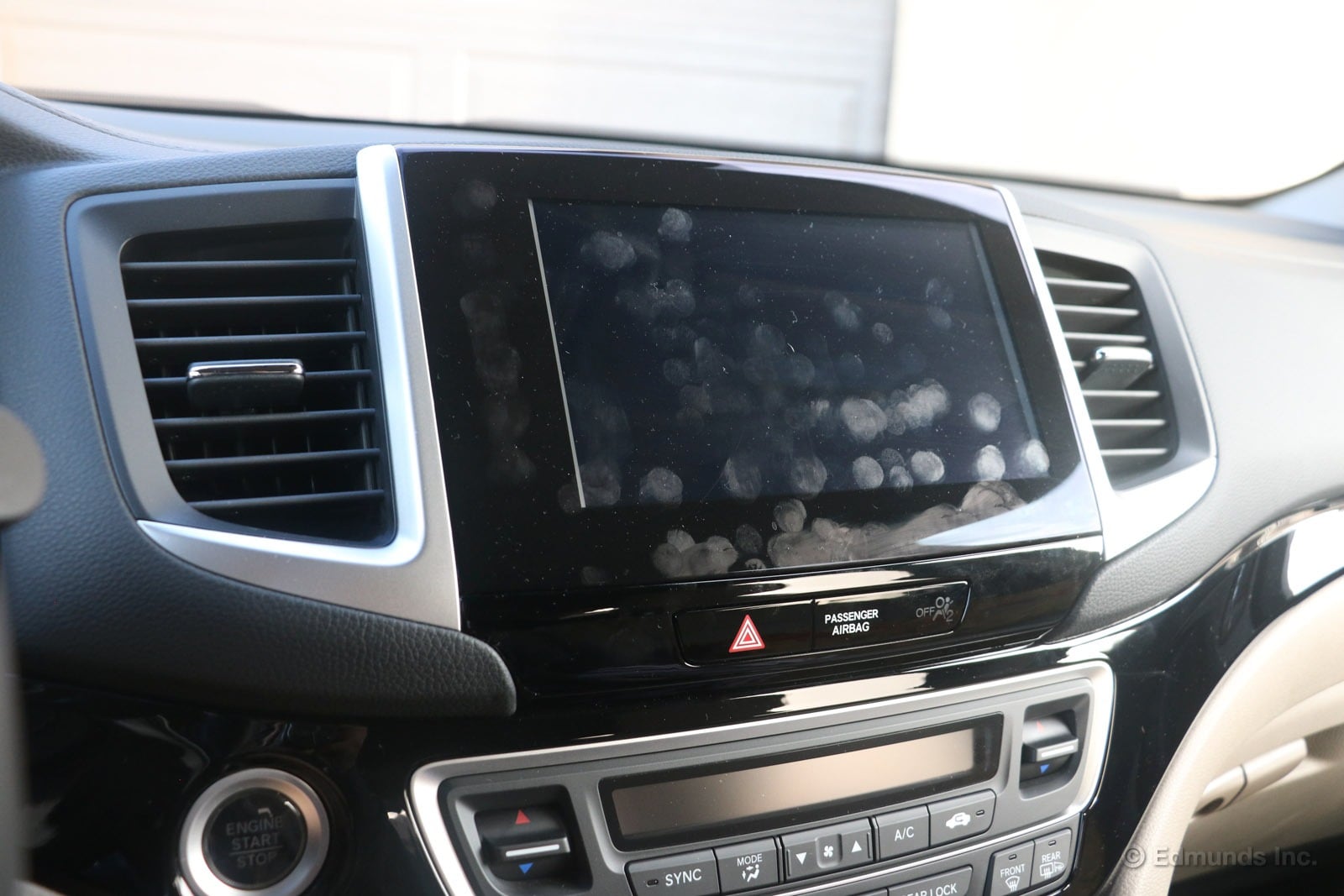
The second issue is just aesthetical. The glossy black trim surrounding the touchscreen looks classy and matches trim used elsewhere in the cabin. But it's very prone to showing fingerprints.
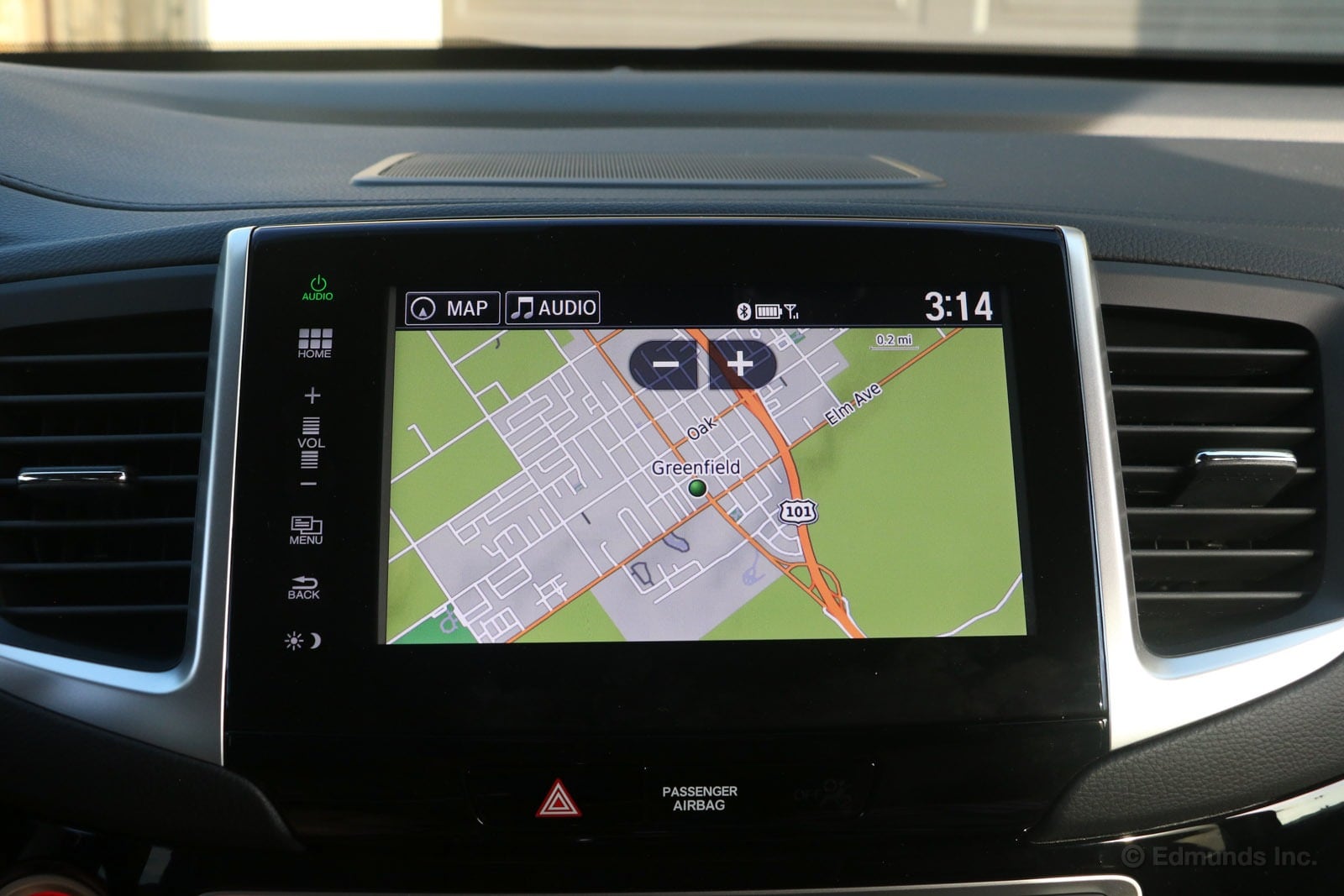
I will note it's not all bad for the Pilot. The 8-inch display's map graphics look sharp. And while the music interface suffers from some small virtual button problems of its own, it's easy to operate because it feels similar to a smartphone.
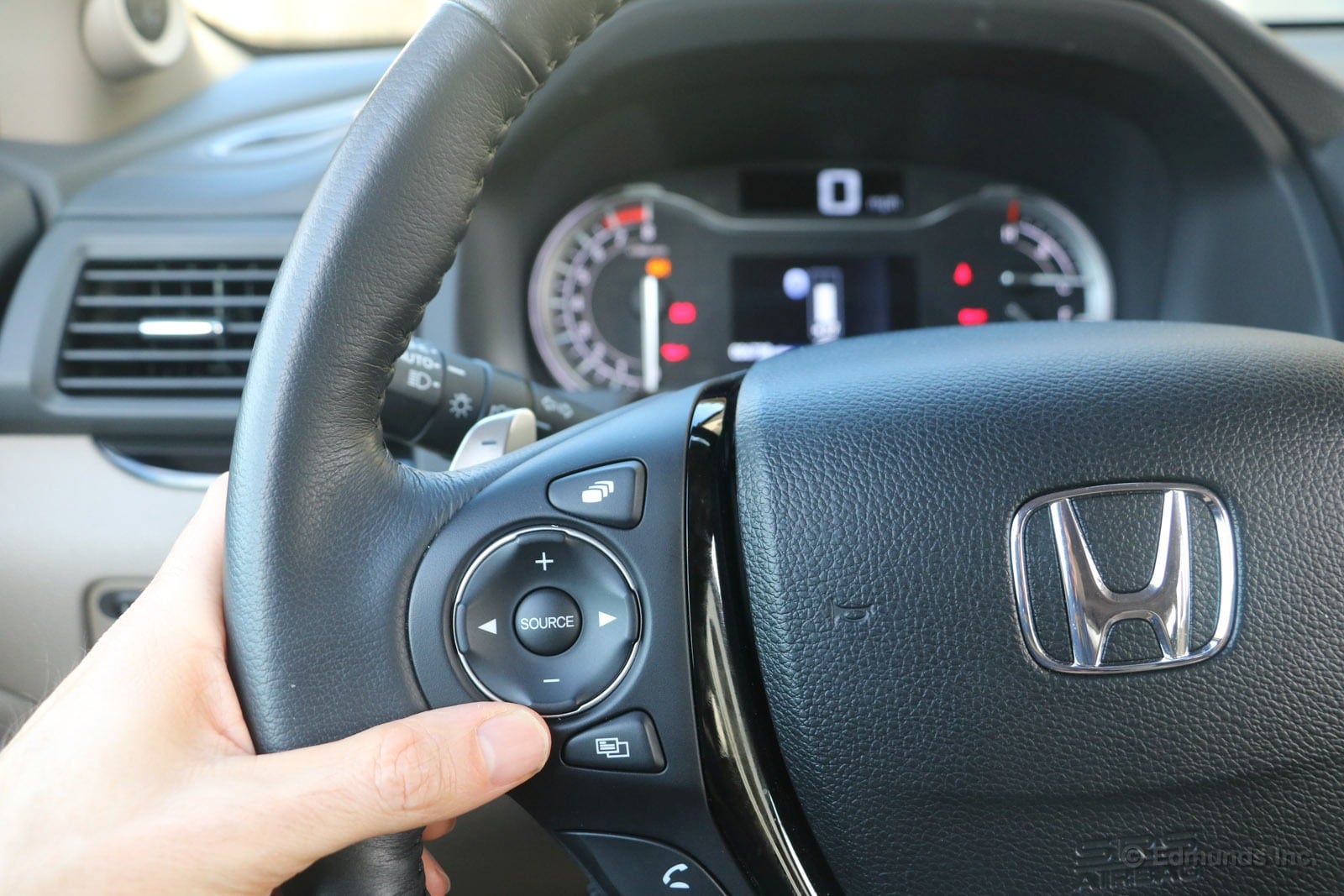
The 2016 Honda Pilot also has some buttons on its steering wheel that can be used instead of the touchscreen in certain instances. The audio "source" button brings up selections in the gauge cluster display that you can choose using the left-right buttons (thereby being a redundant option instead of the touchscreen's virtual button).
There's also an upper button that cycles through navigation/phone/music and a lower button that can be used to pick shuffle and repeat options for music. You also have full voice command functionality, including audio control.
Overall though, this touchscreen interface is often irksome to use and I've noticed it's a common complaint in our 2016 Pilot consumer reviews.
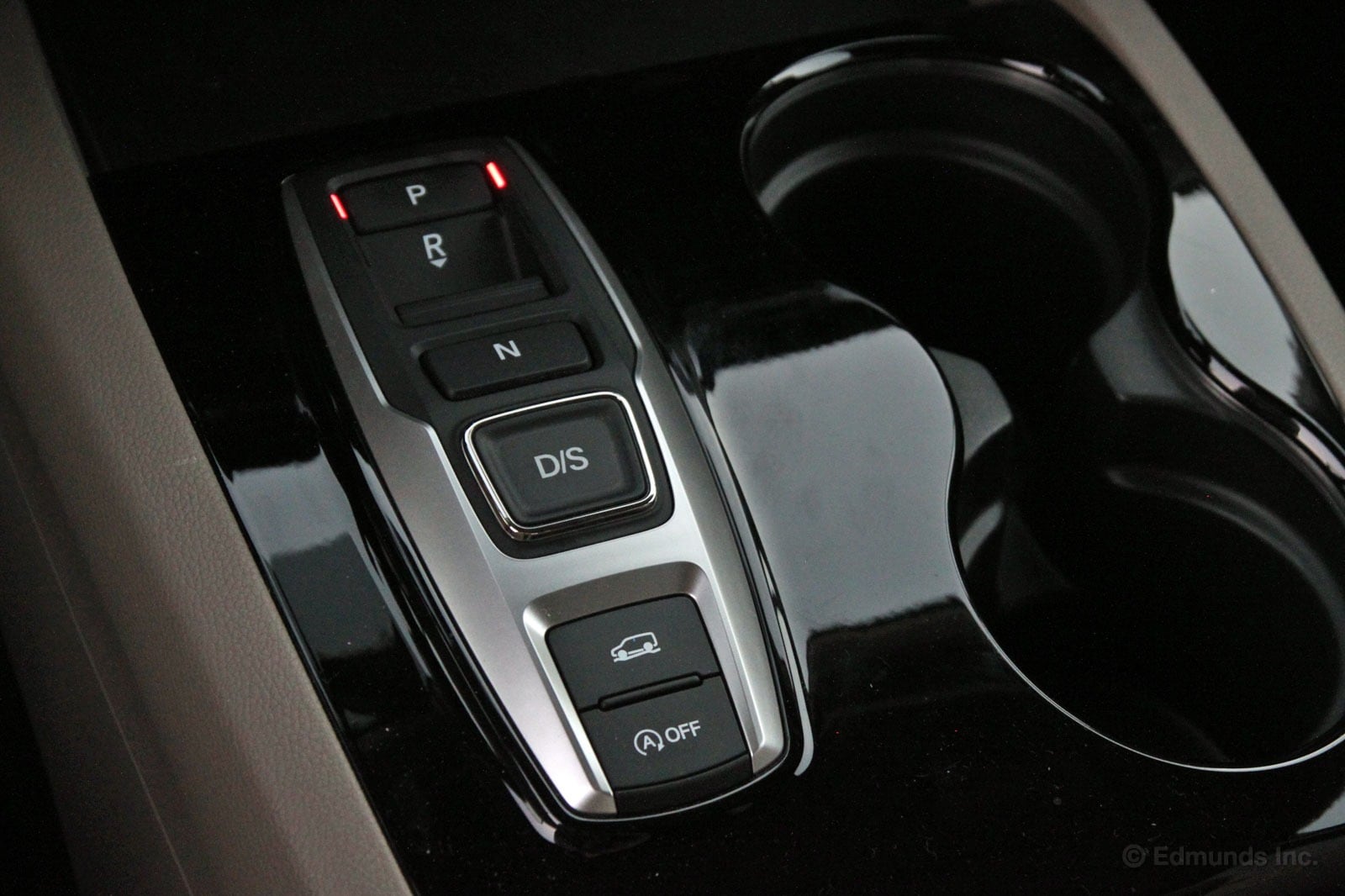
When you opt for either the Touring or the Elite trim level of the 2016 Honda Pilot, you get a nine-speed automatic in place of the standard six-speed transmission. Sounds like a nice upgrade.
We're not so sure.
With so many gears to choose from, the transmission has a tougher job of picking the right one. It's also designed to deliver improved mileage, so it's fighting the urge to get the engine in its sweet spot with the mandate to keep engine speeds low.
The result is a gearbox that quickly heads for ninth gear as soon as possible when you press the gas lightly. Press harder, however, and suddenly the transmission starts to decide whether it should drop to seventh, or sixth, or fifth and so on.
Needless to say, it takes longer than it should. Occasionally it also holds lower gears longer than it should, making you wonder if you unknowingly engaged "sport" mode (which, by the way, doesn't feel any better).
As Dan proved on his trip to Vegas, the nine-speed transmission is able to deliver solid mileage when given the chance, but in day-to-day driving, I would rather have the six-speed automatic and live with the mileage hit.
Family Day Trip and Seven-Passenger Tested
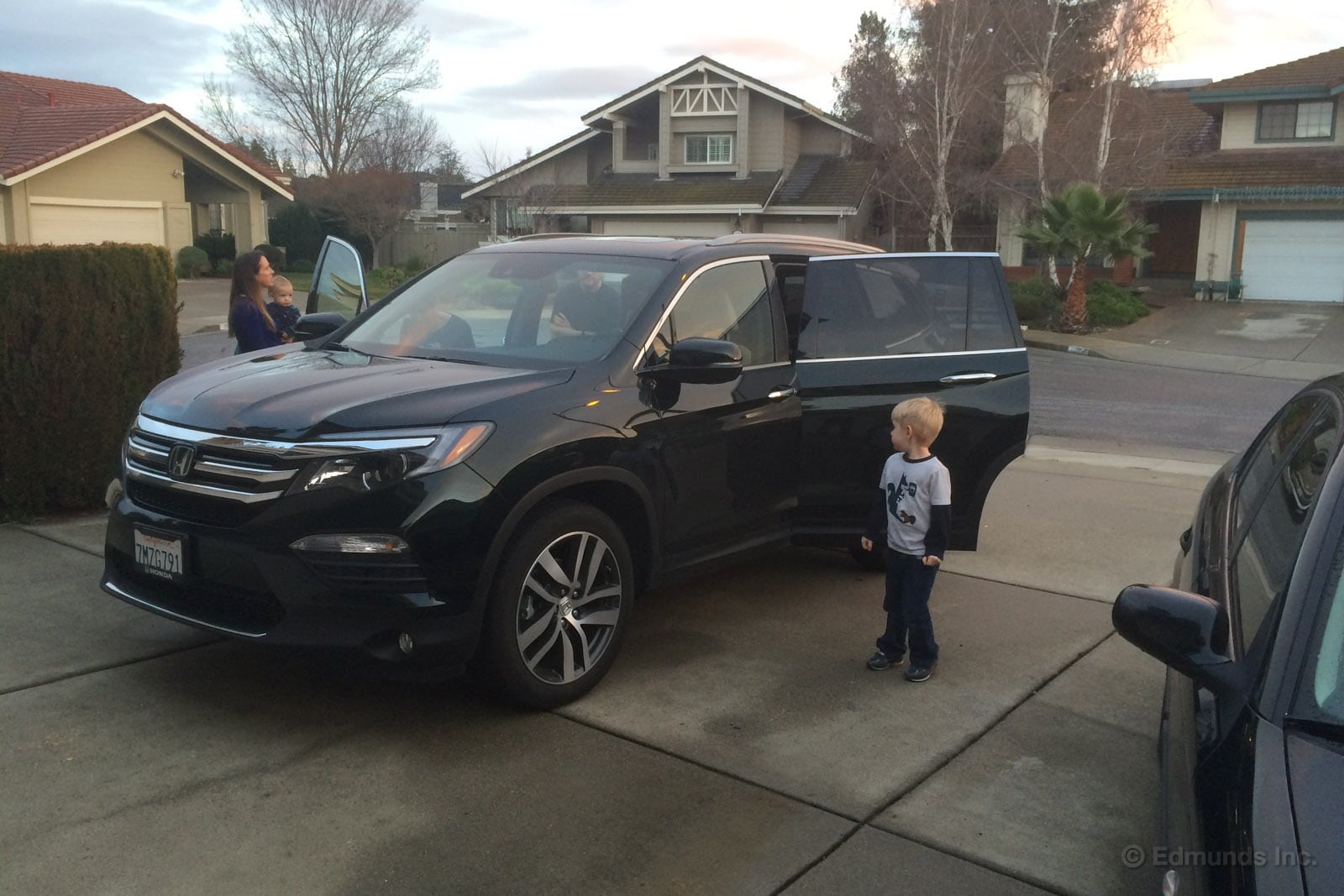
We have two very capable three-row family haulers in our long-term fleet right now: the 2015 Kia Sedona minivan and our 2016 Honda Pilot. Dan Edmunds recently drove the Pilot up to Oregon and came away with some mixed opinions. This past weekend, I took the Pilot for my own family road trip.
It was just a 300-mile day trip to visit friends but it still proved useful for getting more commentary on the Pilot's strengths and weaknesses.
Along with my wife and two small children, my mom also came along. Originally I thought I'd be able to report on using all three rows of seating but then my wife wasn't able to go at the last minute. So my mom sat up front and I put my kids in the second-row captain chairs.
The Pilot is an agreeable long-distance companion. It's respectably quiet and comfortable on the highway, and the V6 gets it up to speed when you give it the spurs. The Pilot isn't luxury-car quiet, but it's quiet enough. The only thing I didn't really care for was the Pilot's big body motions when driving over larger bumps on the highway. Granted, the Pilot is a big crossover SUV, but I wouldn't mind just a bit more body stability.
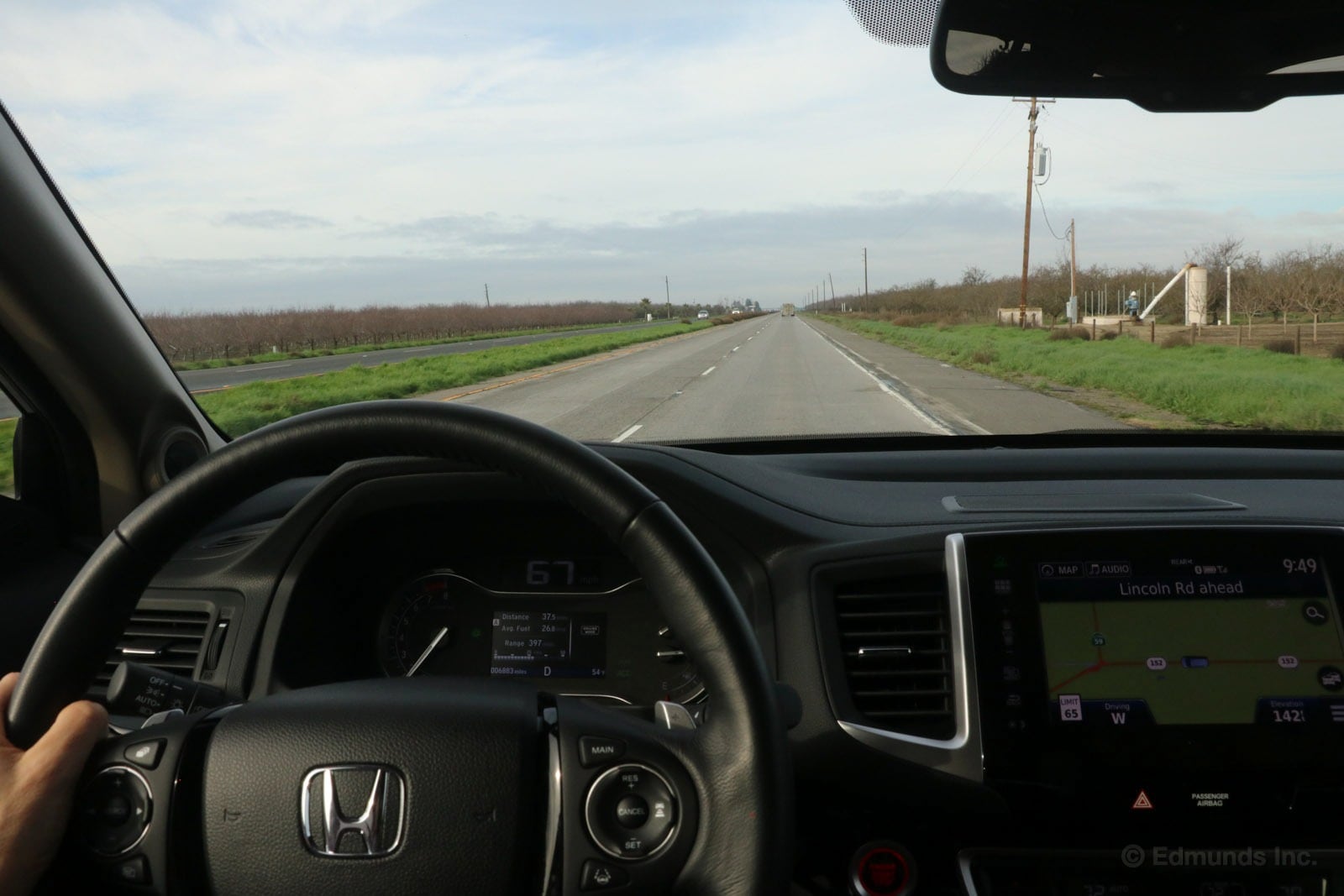
My kids (ages four and eight) watched a movie both ways (more on the rear entertainment system in another update) and seemed quite content. The dual captain-chair layout with the center console worked out well for providing enough personal and storage space for each kid. As for the driver seat, it's adequate for comfort. I was getting a little fidgety near the end of each 2.5-hour one-way drive. While our long-term Nissan Murano isn't a direct competitor to the Pilot, I do prefer its front seats for long-distance comfort.
I ended up utilizing the Pilot's third-row seat after all. My friend and I decided to take our kids to a museum (the San Jose Tech Museum) so we put our two eight-year-olds in the third row, a four-year-old in the third row (with a booster seat), another four-year-old in one captain's chair, my friend in the other captain's chair, and then my mom up front. Being able to take along extra friends is certainly one of the big advantages of owning a three-row crossover.
That said, I wasn't thrilled with putting three kids in the third row. The kids didn't complain, but it's a tight fit going three across and it was tricky to get the pull-down seatbelt for the center position (it pulls down from the roof, then latches/anchors at two points below to create the lap belt) at an angle that didn't ride up high on the middle child's neck.
This is just a general statement rather than specific commentary on the Pilot. Know the law and guidelines for child safety seats, and if you're thinking about buying a three-row crossover or minivan, make sure to test out the seating positions in the ways you think you'll use them.
As for fuel economy, the Pilot's in-car fuel economy meter showed 26.1 mpg after 294.7 miles of driving. I was initially excited that I got EPA highway (something Dan struggled to do on his trip), but after I pumped in 12.572 gallons, actual fuel economy turned out to be 23.4 mpg. Considering my trip mixed city driving, some hilly terrain, and passengers, 23.4 mpg - from a big crossover SUV, no less - seems decent enough to me.
Rear Entertainment System Instead of Tablets

Considering the widespread use of smartphones and tablet computers, buying a vehicle with a rear entertainment system (RES) probably isn't as big of a draw as it once was. But automakers still offer them and, in the case of our 2016 Honda Pilot Elite, you can often end up with one as standard equipment on top trim levels.
While I have a couple of old iPads for my two young children to use on road trips, I left them at home for my recent day trip in the Pilot and brought along Star Wars to test out our Pilot's entertainment system.
The system's main components include a 9-inch overhead pull-down screen, a remote control, an interface panel and two wireless headphones.
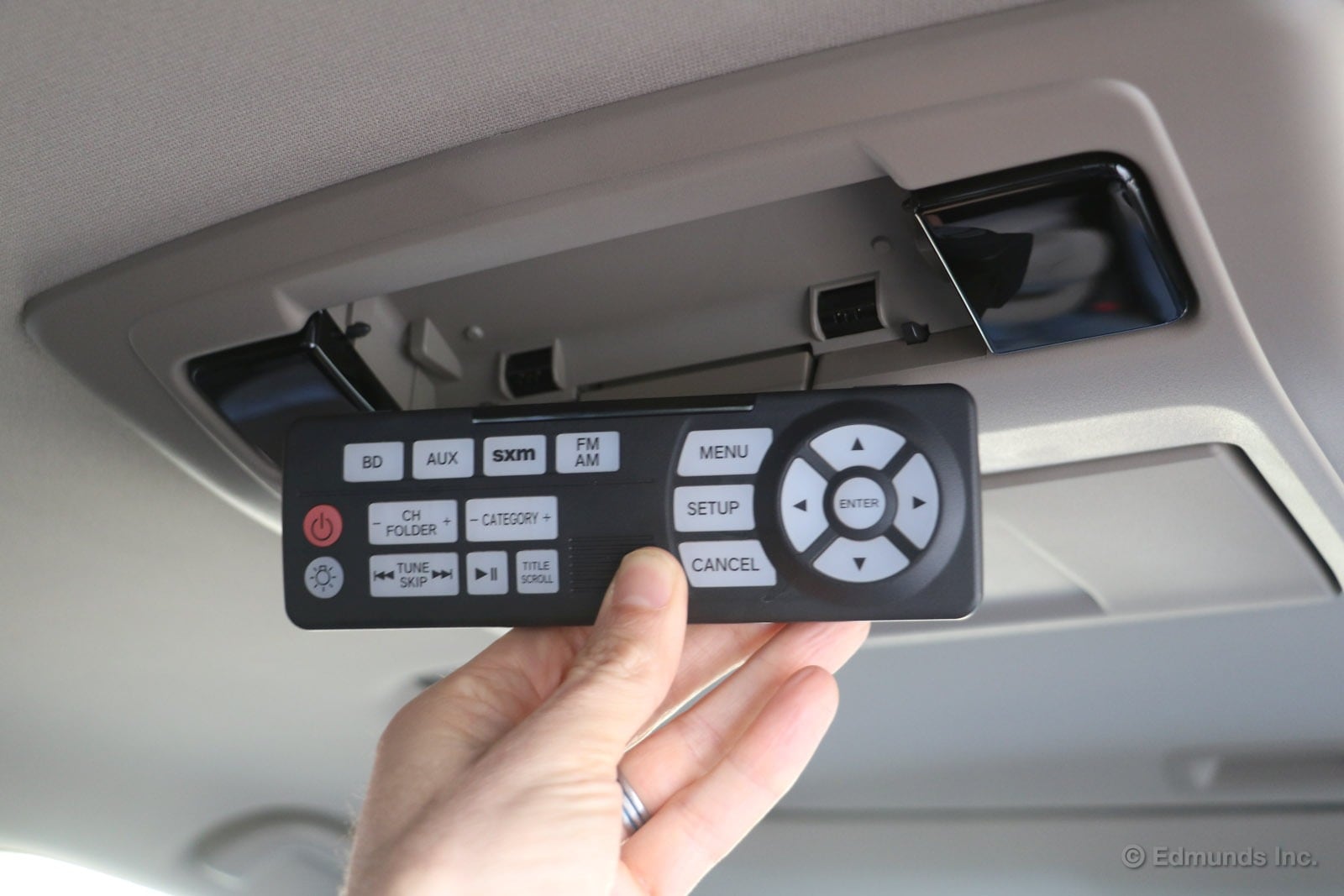
The remote control can be kept in the screen housing. You can use the remote to select various audio sources for the rear seating (the rear audio source can be different than the one for front passengers) or control disc playback.
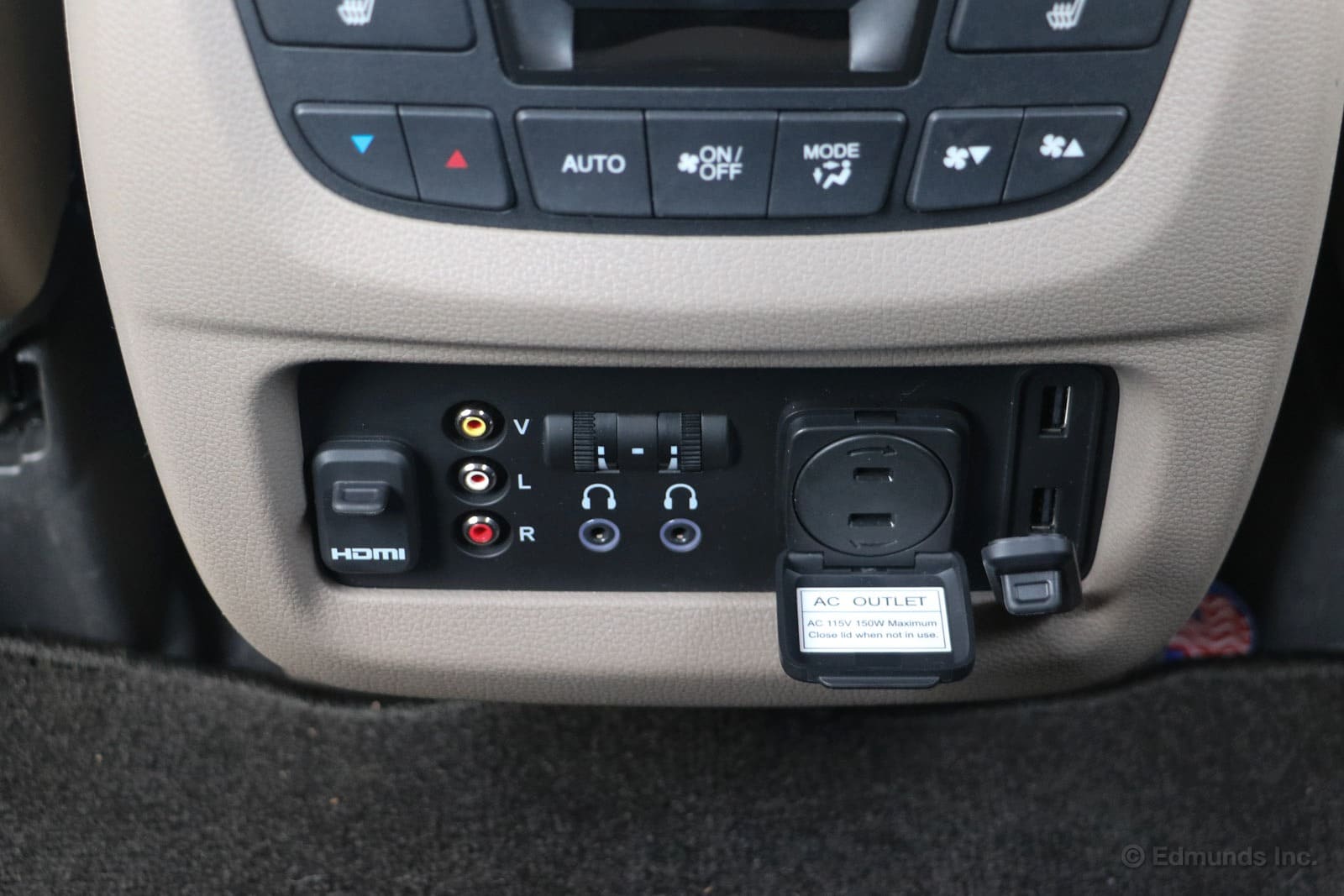
Here's what you get with the lower panel behind the front seat console: an HDMI input, RCA-style input jacks, a 120-volt household plug port, two USB chargers (2.5 amp) and two wired headphone outputs.
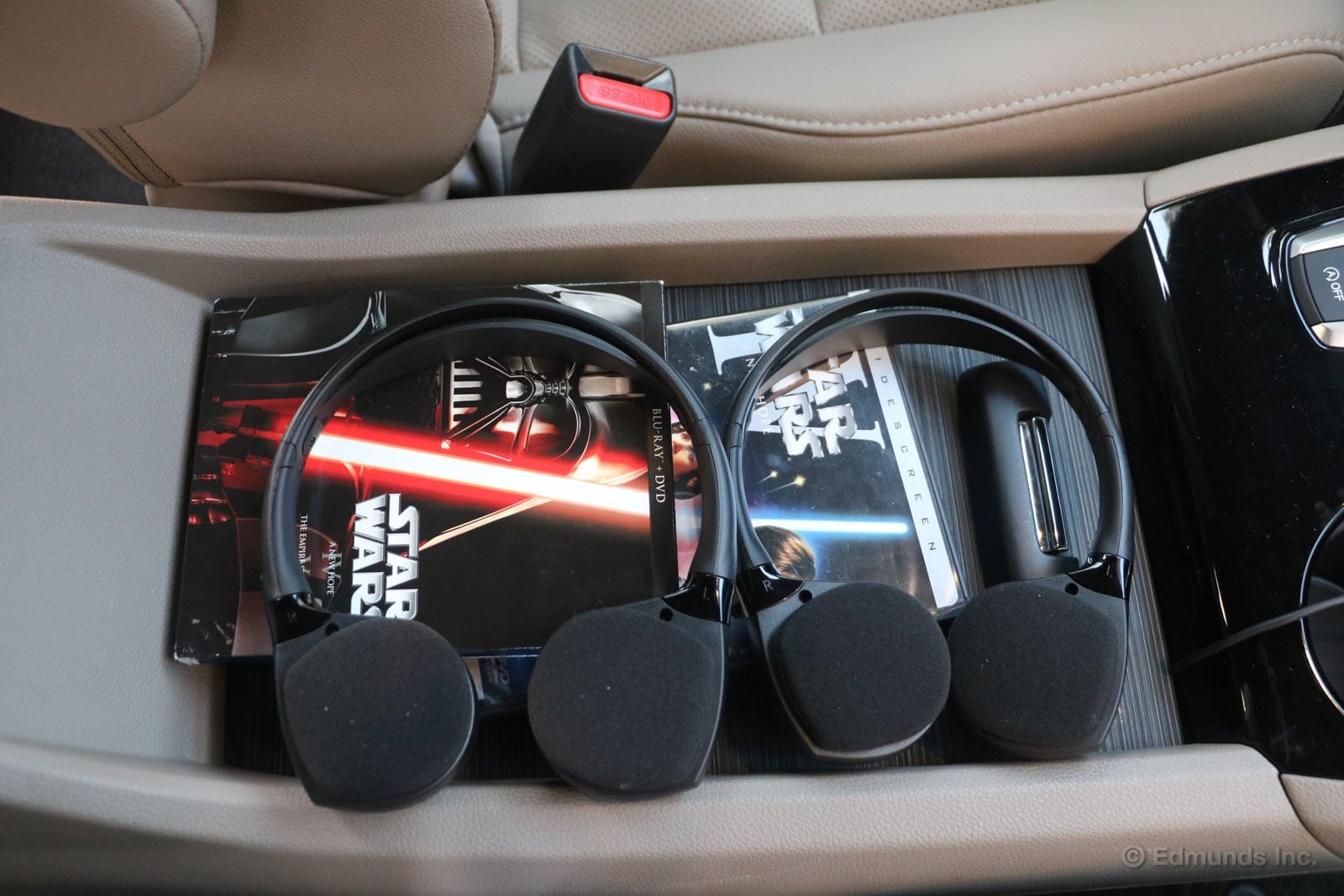
The wireless headphones are small enough to comfortably fit small children. They have adjustable volume and auto power-off. Sound quality is mediocre, but the way I see it either (a) your kids won't care; or (b) you can bring along your own premium wired headphones if it's important enough to you.
As for disc playback, the Pilot Touring and Elite have Blu-ray functionality. If you get the rear entertainment system on the Pilot EX-L, it's just a regular DVD player and no Blu-ray.
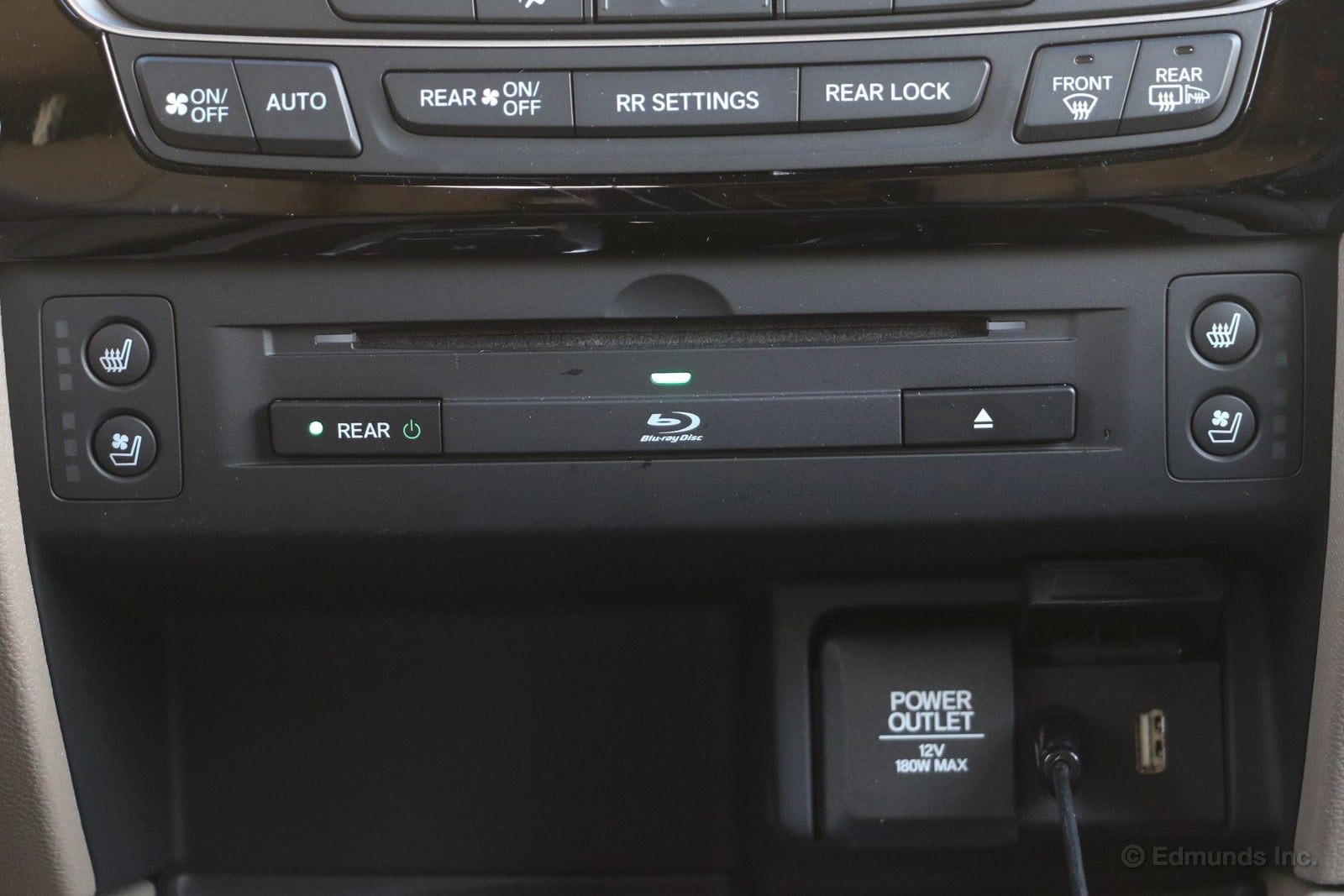
Overall, the entertainment system worked well with the Star Wars discs I brought along. I was initially confused when I first loaded a disc; nothing happened on the rear screen. But once I figured out that I had to turn on the RES first by pushing the "Rear" button next to the disc player, it all went smoothly.
I played both a DVD and a Blu-ray disc of Star Wars just to see if I could notice a visual improvement with Blu-ray. Honestly, I didn't notice much, if anything. It likely has something to do with the size and resolution of the screen (Honda lists the screen as "VGA" resolution). But if nothing else, having Blu-ray capability expands your opportunities for playback.
Perhaps the most interesting aspect for me was the force-fed, communist-style nature of the experience. Instead of handing each kid an iPad and not really knowing what they were going to do with it back there, I just said, "You're watching Star Wars." There was something satisfying about that.
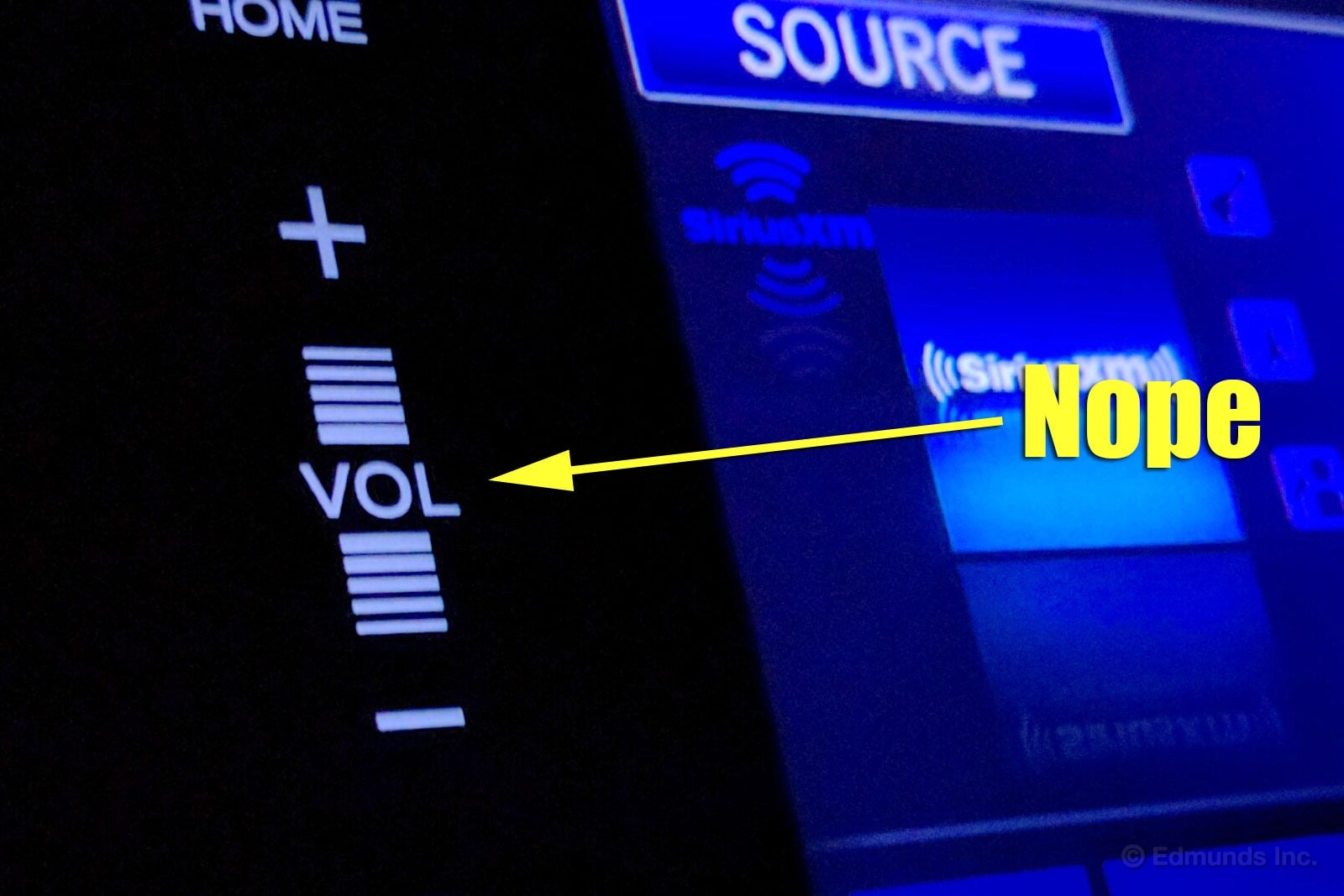
Presenting another post from the "Give Me a Volume Dial" folder (1, 2).
An interesting thing happened when I tried turning the volume down in our 2016 Honda Pilot one evening while parking: It kept getting louder.
Getting into my parking spot isn't the easiest thing. It's tight and oddly positioned, often necessitating a multi-point turn and faith in mirrors and proximity sensors. The garage is underground too, so I always lose satellite radio reception.
While parking, I put the Pilot in reverse and started swiping the touch-sensitive volume bar to turn down the volume. Somehow, the combination of the backup camera activating, the loss of satellite radio, and my volume input caused the audio level to increase.
And it didn't stop, even when I took my finger off. I hit the power button and cursed the thing under my breath.
Maybe I have some weird juju that makes audio systems freak out (this isn't the first time), but a volume dial would never have this problem. The volume would go down because that's the direction you're turning it. There's no confusion.
I still don't know what caused this problem, and I haven't been able to reproduce it. Still, it only makes we want real volume control more. Not only does the absence of the dial make the experience more difficult, the thing Honda's replaced it with doesn't even work right.
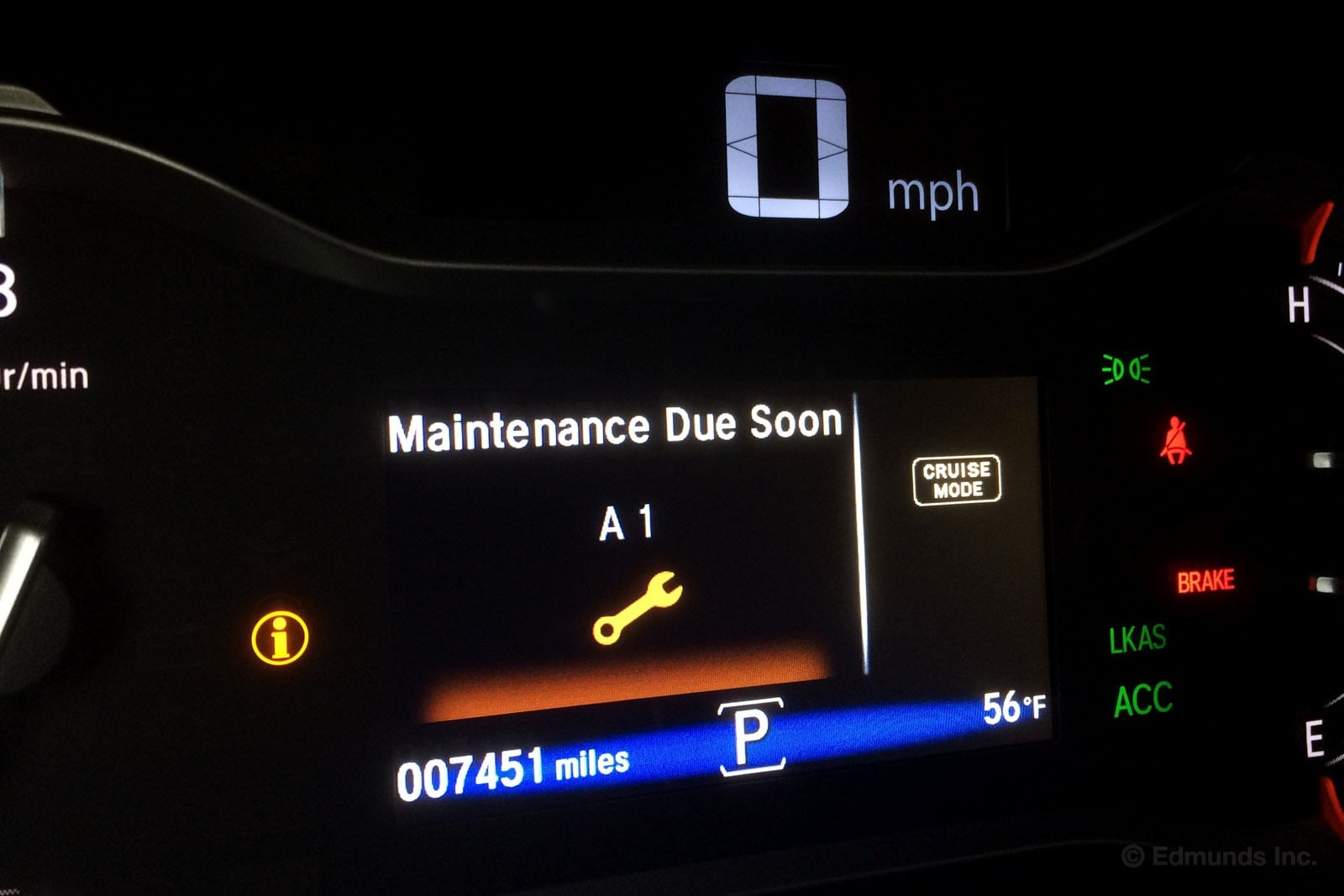
The driver information display on our 2016 Honda Pilot is now kindly notifying us that maintenance is due soon. Grab your beer and pretzels, it's Honda/Acura service bingo time with an "A1" indicator.
The A1 note means we're due for an oil change (no filter change) and a tire rotation. But since we're going to the dealer, we also plan to have them check on the inoperable heated steering wheel. Stay tuned.
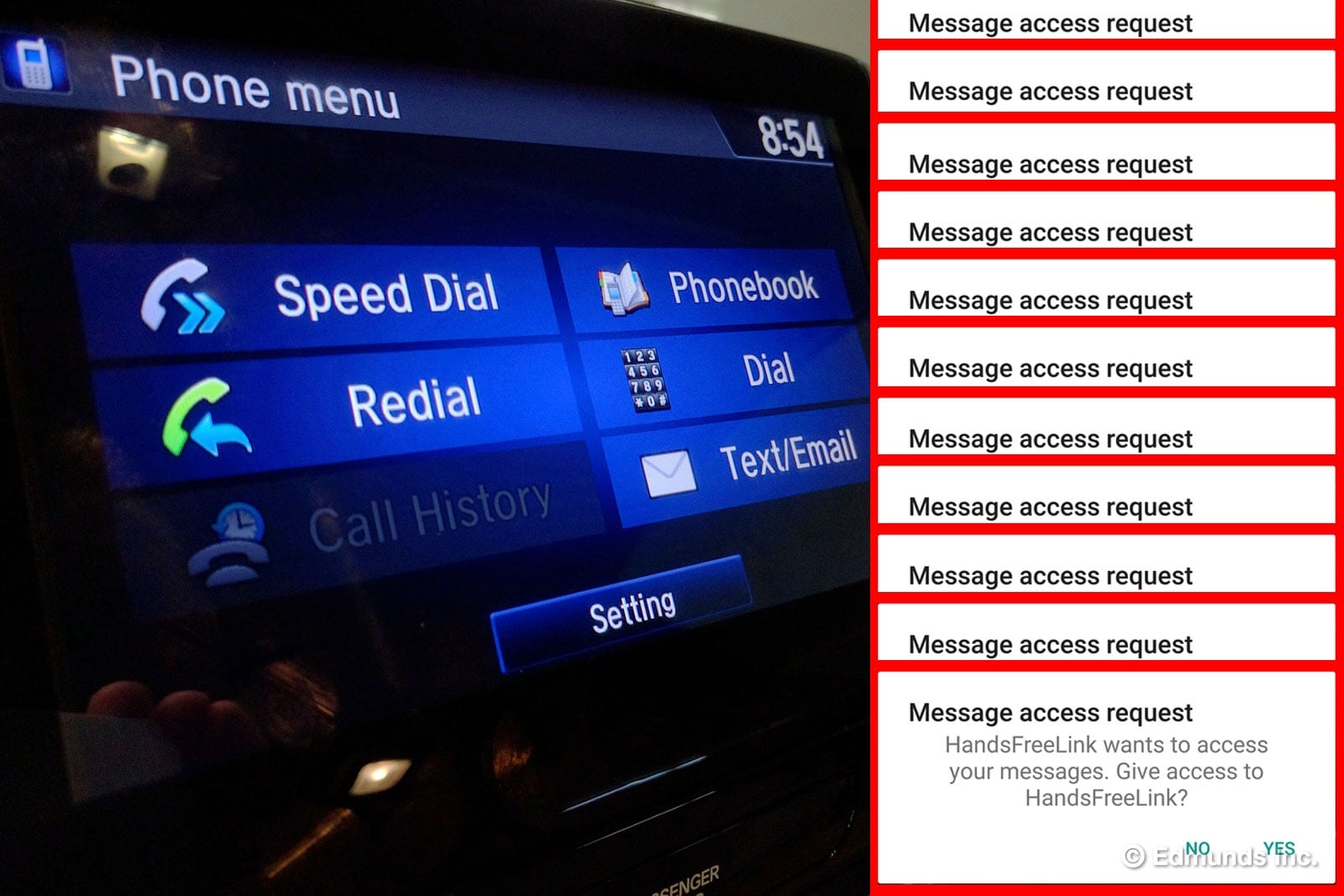
Our 2016 Honda Pilot and my Nexus 6p don't get along.
One of the things I like about Android devices is that you can limit the Bluetooth interaction between the phone and whatever it connects to. When you pair, the phone prompts you to grant access to specific functions. I'm happy to hand over phone controls, but I don't want to transfer my phonebook or text messages to cars we're reviewing because who knows where they might end up. This is a problem specific to what we do, but it illustrates a flaw within the Pilot's system.
When I refuse full access to most cars, nothing happens. When I did it in the Pilot, the SUV continued to send the request. Every 30 seconds or so, my phone would ping with a notification. To make matters worse, Bluetooth audio wouldn't play through the stereo. The Pilot was content to let the phone's speakers handle podcast duties. I could still control the playback through Honda's infotainment system, pausing or changing tracks, but no audio would come through the Pilot's speakers.
I was ready to call the dealer, but then these problems stopped. Maybe the Honda and my phone realized they'd have to communicate and got over their differences.
And then I found another problem.
Android devices handle voice commands really well. I don't press a button, I just say "Ok, Google." That phrase prompts the phone for a voice input. I use this hands-free approach all the time: Setting a timer when cooking, converting a measurement, replying to a text, estimating time to destination, and so on. I also use it to make calls. So imagine my surprise when that didn't work.
While driving, two hands on the wheel and eyes on the road, I say, "Ok, Google. Call mom." The phone receives the request and makes the call, but the audio from that call doesn't play over Bluetooth. The Pilot thinks I'm initiating the call through my phone, so it plays the audio there.
The correct process is to use Honda's frustrating touchscreen infotainment system to make the call. I can only hope that this gets solved when the Pilot supports Android Auto and Apple CarPlay, like the Accord and Civic.
My phone has a better solution. The Pilot should use it.
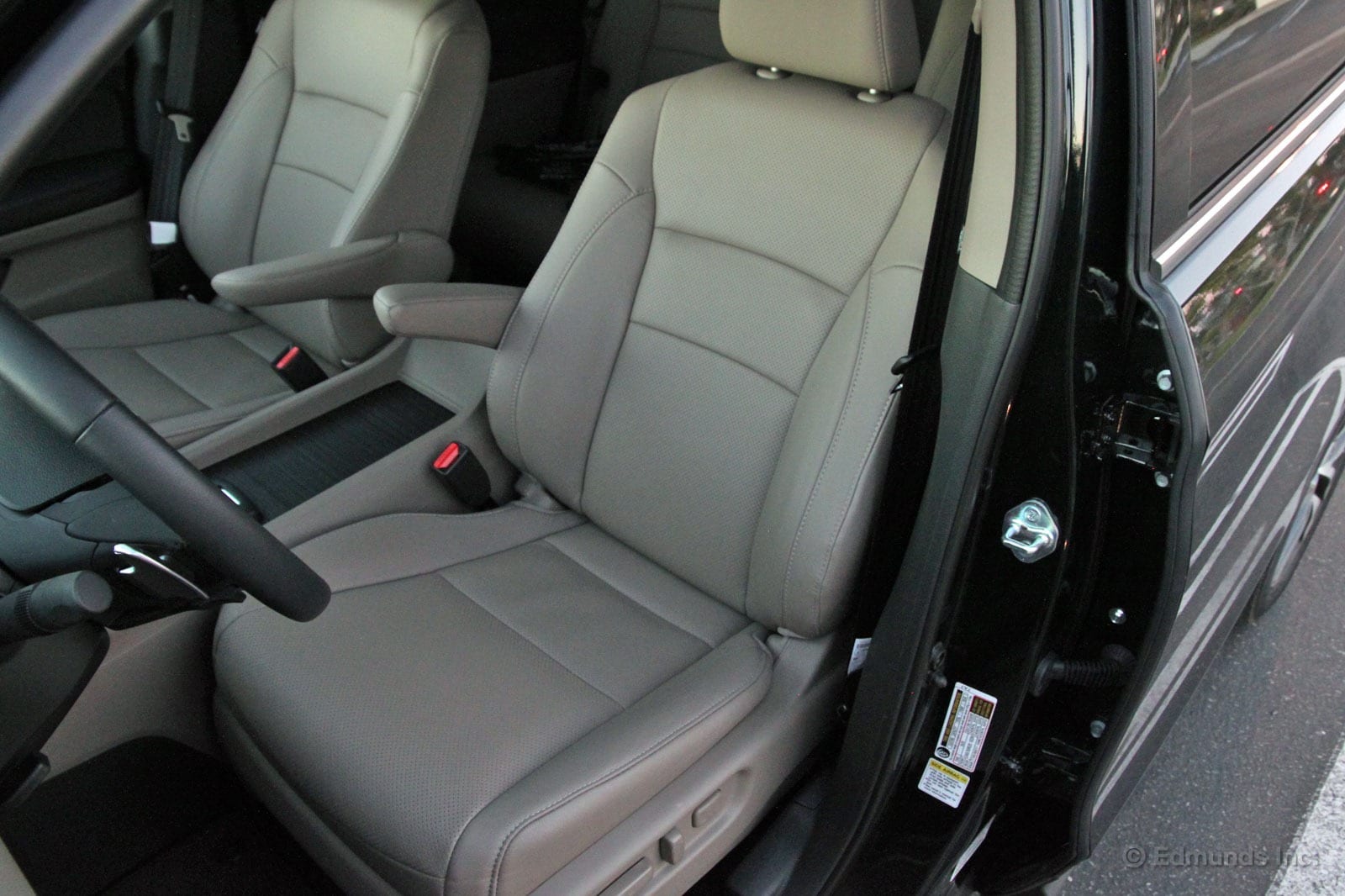
No, I'm not talking about a new folk rock band coming to a summer music festival near you. The creaky lumbar in question here would be the one found in our 2016 Honda Pilot.
There are many fans of adjustable lumbar support on our staff. I'm not one of them. Sometimes it makes a seat feel more comfortable, other times just feels awkward. In most cars, I just leave it alone.
Another editor, who clearly loves a good shove in the lower back, had it extended to its most intrusive and the result was an awful creak every time I pushed against it. And I don't mean a tiny squeak from deep in the bowels of the seat back. I mean a ridiculously obvious creak that makes it sound like you're sitting in a rusty rocking chair.
Hopefully this takes nothing more than a shot of WD-40 to cure. We'll see. In the meantime, I dialed out all the extra lumbar support and the noise is gone.
A1 Service Completed, with Repair Parts on the Way
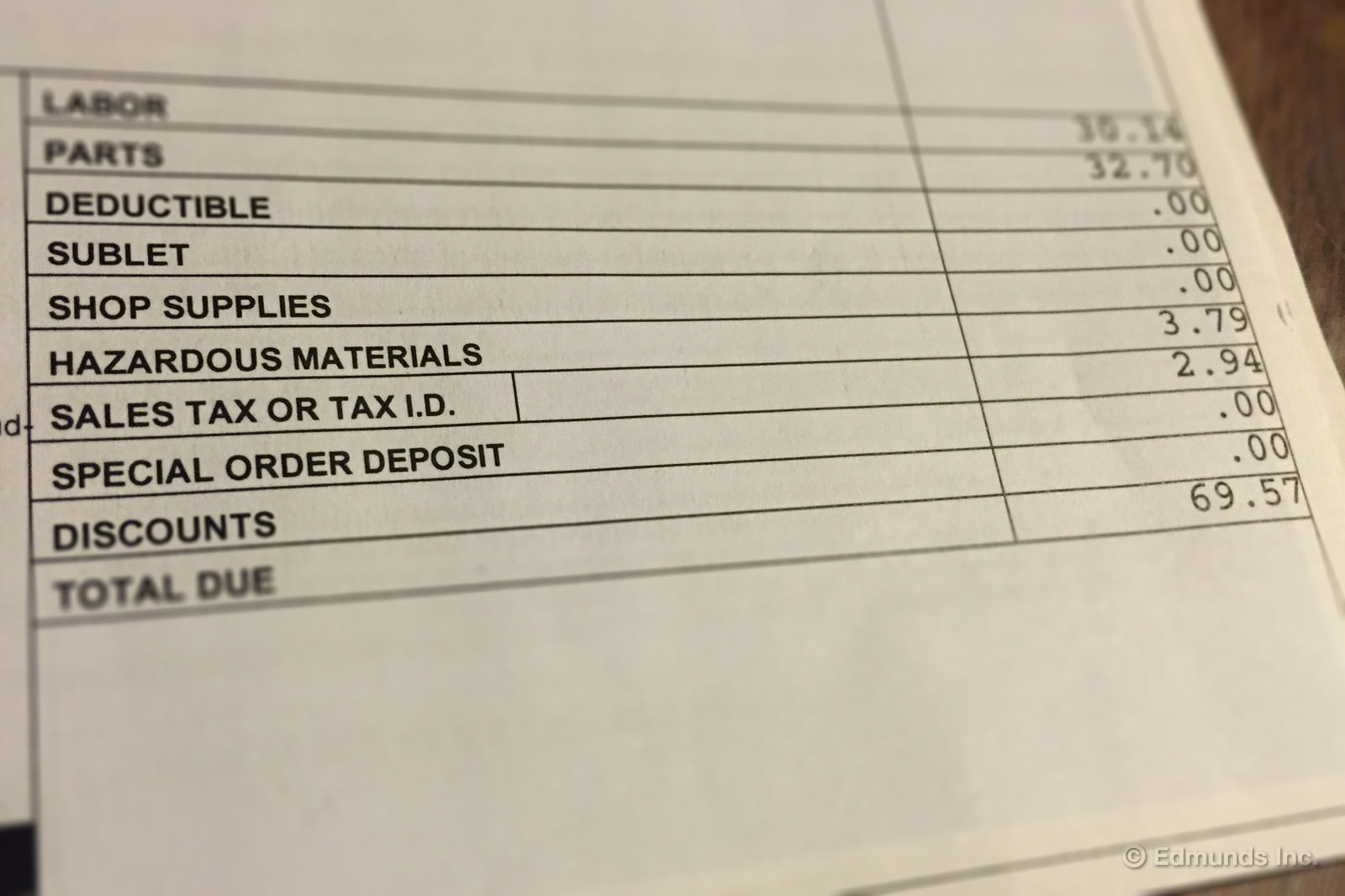
The 2016 Honda Pilot had been in our fleet just three months when it displayed its "Maintenance Due Soon" warning near the 7,500-mile mark. The A1 service is a simple one, just an oil change and tire rotation. I didn't think the service would take very long, so I offered to take it to my local Honda dealer.
Before handing the key over, car commandant Mike Schmidt warned that my waiting time would be extended because of the Pilot's malfunctioning steering wheel heater. No problem, I said, then jumped into my emerald chariot. After driving for about five minutes, I realized my wait time would likely be even longer.
I heard a funky whirring noise while on the freeway and rolled the driver window down to make sure it wasn't another vehicle. Sure enough, it was a nearby commercial truck that made the commotion. As I rolled my window up, I heard a distinctive cracking sound. I lowered my window and heard nothing, but the sound resurfaced when I rolled it back up. I repeated the procedure another half-dozen times with the same result. Item two on the repair order.
I also noticed the radio intermittently quieting itself and returning to full volume a few seconds later. This happens in many cars when a destination is plugged into the navigation system but the system's voice commands are muted. It's a subtle way to let you know that you are about to divert from your straight-ahead path without actually telling you what to do.
But there was no destination stored in the nav system. I made sure the driver alert systems, like lane departure warning, were turned off. Some audio systems alter the volume depending on vehicle speed, but this problem happened regularly during my hour-long commute regardless of velocity.
I pulled into Community Honda in Whittier at 3:00 p.m. on Monday afternoon without an appointment. I was greeted promptly and informed my service advisor about the unusual problems. The estimate for the A1 service was $67.55, while the other problems would be diagnosed and repaired under Honda's warranty. The Pilot was promised back the next day.
I got a call at 1:00 p.m. on Tuesday with an update on the Pilot's progress. The oil change and tire rotation were completed. Unfortunately, the technicians were unable to replicate the audio problem. The assembly that controlled the steering wheel heater would have to be replaced, as would the regulator for the driver window. The dealer didn't have the assembly or regulator in stock. The parts were ordered and would arrive in five days.
In the meantime, I will dig through the Pilot's settings more thoroughly to see if I can solve the audio issue or at least consistently replicate it by the time I return to the dealer. Dan Edmunds has suggested I start with the navigation system's real-time traffic alerts.
Five quarts of 0W20 oil @ $5 each: $25
Oil filter: $7.30
Drain washer: $0.40
Oil change: $12.54
Oil disposal: $3.79
Tire rotation: $17.60
Tax: $2.94
Total: $69.57
Fuel Economy Update for January — Road Trips Boost the Average
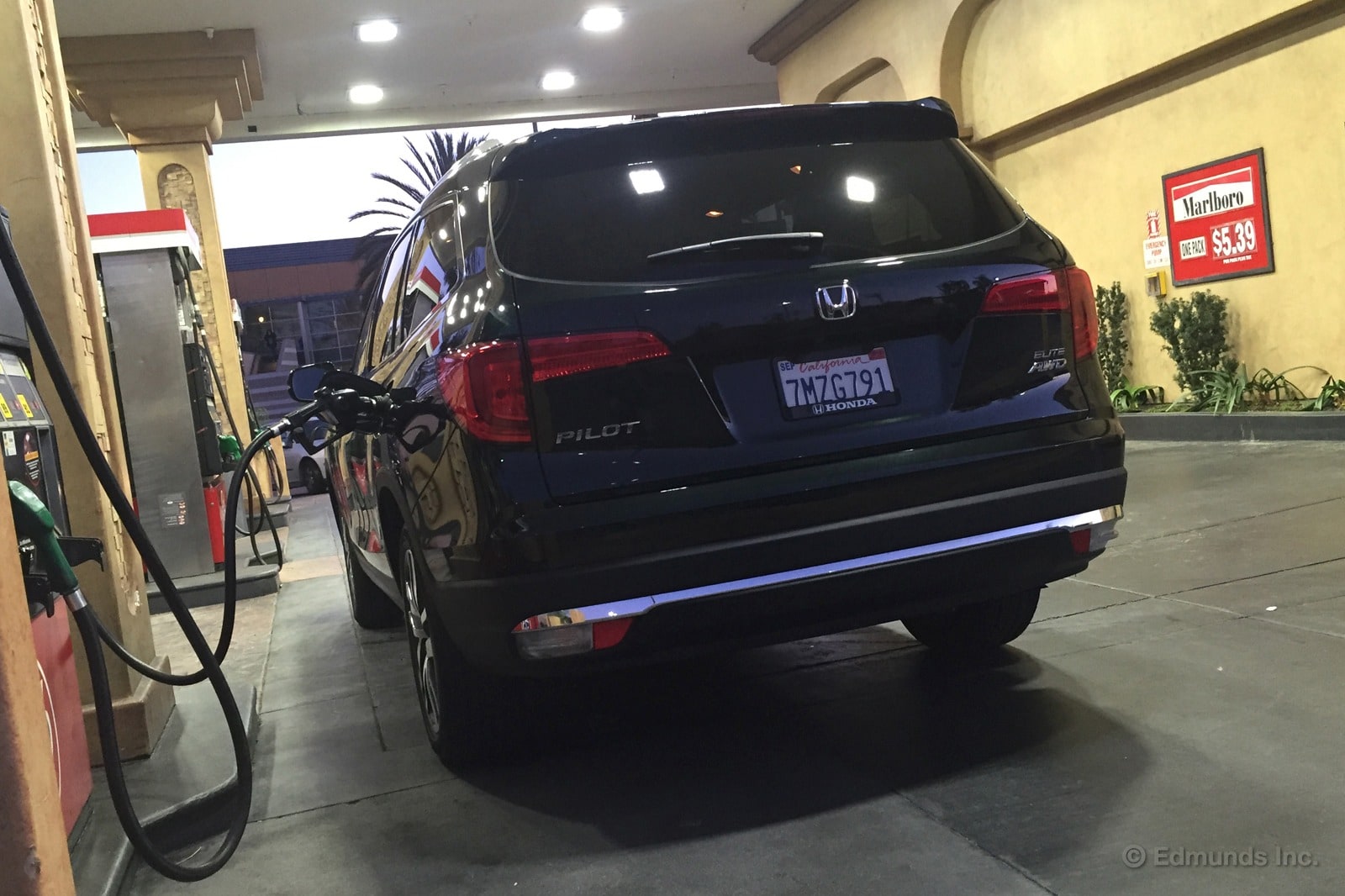
Dan wasn't kidding when he wrote that the 2016 Honda Pilot would see plenty of road trip miles in January. The Pilot started the month with Dan coming home from Oregon. He laid low for a couple of days, then traveled to and from Las Vegas for the Consumer Electronics Show.
Brent took the Pilot a few days later for a day trip of his own with his mother and two kiddos in tow. The long-distance trips helped the Pilot eke ever closer to its combined mpg rating.
Dan set out on his Vegas journey with the intention of setting records for the Pilot. He flew solo and religiously stuck to posted speed limits. He ran into traffic heading north on Interstate 15, so he ventured off the beaten path through deserted two-lane roads. Taking the long way round helped Dan set a best-range record, covering 400.6 miles on one tank of fuel. His return trip set a best-fill record at 25.8 mpg.
The Pilot covered 3,302 miles in January and fuel economy for the month stands at 22.6 mpg. Overall fuel economy increased from 18.9 mpg to 20.4 mpg, not far from the EPA combined rating of 22 mpg. Fuel consumption decreased from 5.3 to 4.9 gallons/100 miles.
Worst Fill MPG: 13.1 mpg
Best Fill MPG: 25.8 mpg
Average Lifetime MPG: 20.4 mpg (4.9 gallons/100 miles)
EPA MPG Rating: 22 Combined (19 City/26 Highway)
Best Range: 400.6 miles
Current Odometer: 8,050 miles
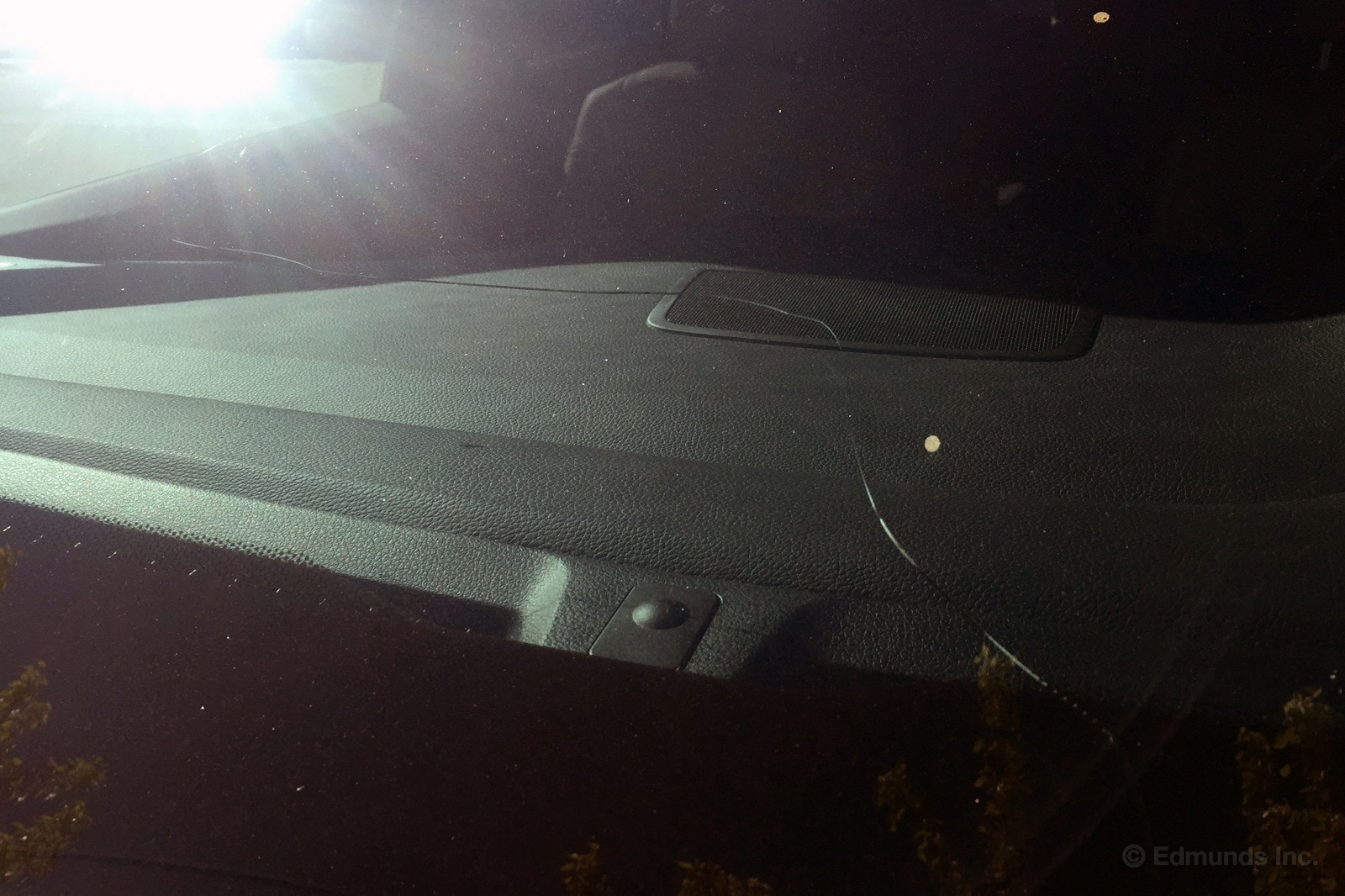
When we last left our 2016 Honda Pilot, the Green Machine had just finished its A1 service, with repair parts ordered for the busted steering wheel heater and noisy driver window. The dealer called on Tuesday saying that the parts had arrived. The Pilot was busy for the rest of the week, so I made the appointment for Friday. Everything was going smoothly.
And then it wasn't.
Reese drove our evaluation loop on Wednesday, then handed me the key and delivered some unfortunate news. While on the loop, a rock had flown up and cracked the windshield. He talked it over with Dan Edmunds and they concluded that a new windshield was needed. The Pilot was going to the dealer anyway, so I agreed to have it replaced while I was there.
I needed to have some sort of baseline price for the glass and Schmidt suggested I give Safelite a shot. We've used them in the past and their online configurator spits out an estimate with the car's VIN or a model description. Our fully-loaded Elite model has automatic wipers, a feature that requires us to buy the most expensive glass available for the Pilot.
The estimated cost for what Safelite calls "OEM-equivalent" glass was $638.95 before tax. If I wanted an OEM windshield, I could call Safelite directly and get a quote. Which is exactly what I did. The quotes were $738.95 and $1,038.95, although the person I talked to couldn't explain the difference between the two. He also said that these estimates assumed Safelite's warehouse had the windshield in stock, which it didn't. He took the Pilot VIN and assured that someone would call the next day with more information.
I called my service advisor to get a quote from the dealer. He told me that although he could get me the price for the glass itself, Community Honda outsourced the installation. The dealership used Gaines Glass, a small business located in nearby Chino Hills. I called and spoke to owner Kevin Gaines, who quoted me $750 for the windshield and labor, before tax. He would replace the glass at the dealership before it was serviced, then hand it off to Honda technicians for the other repairs. He also noted that he would use glass supplied by Honda.
Kevin's price was nearly identical to the least expensive Safelite option, plus he would install the glass right at the dealer. It was an easy decision to go with Kevin. Now all that's left is to drop off the Pilot on Friday and complete the repairs.
EX 6-Speed Transmission Vs. Elite 9-Speed

You've probably read our gripes about our 2016 Honda Pilot Elite's 9-speed transmission, which can be especially irksome when you need to summon a short burst of even moderate acceleration. To give you what you want, it might need to kick down two or three gears, but it may only dole out one gearchange in the hopes that you'll stop asking and let it get on with the business of saving fuel.
And then there's the push-button shifter that goes with it, which is just plain silly and annoying. There's little need to look at or even consciously think about a normal shift lever, but it's necessary to glance down to find and operate these buttons. And I'm not convinced it's a simple matter of getting used to it. After years in this business, I'm still glancing down at the keyboard to type these words.
The good news is there is an alternative: don't buy the Touring or the Elite. Get an LX, EX or EX-L, each of which comes with a 6-speed automatic and a standard shift lever.
We recently made a few calls and ended up with a Pilot EX to compare with our Elite.
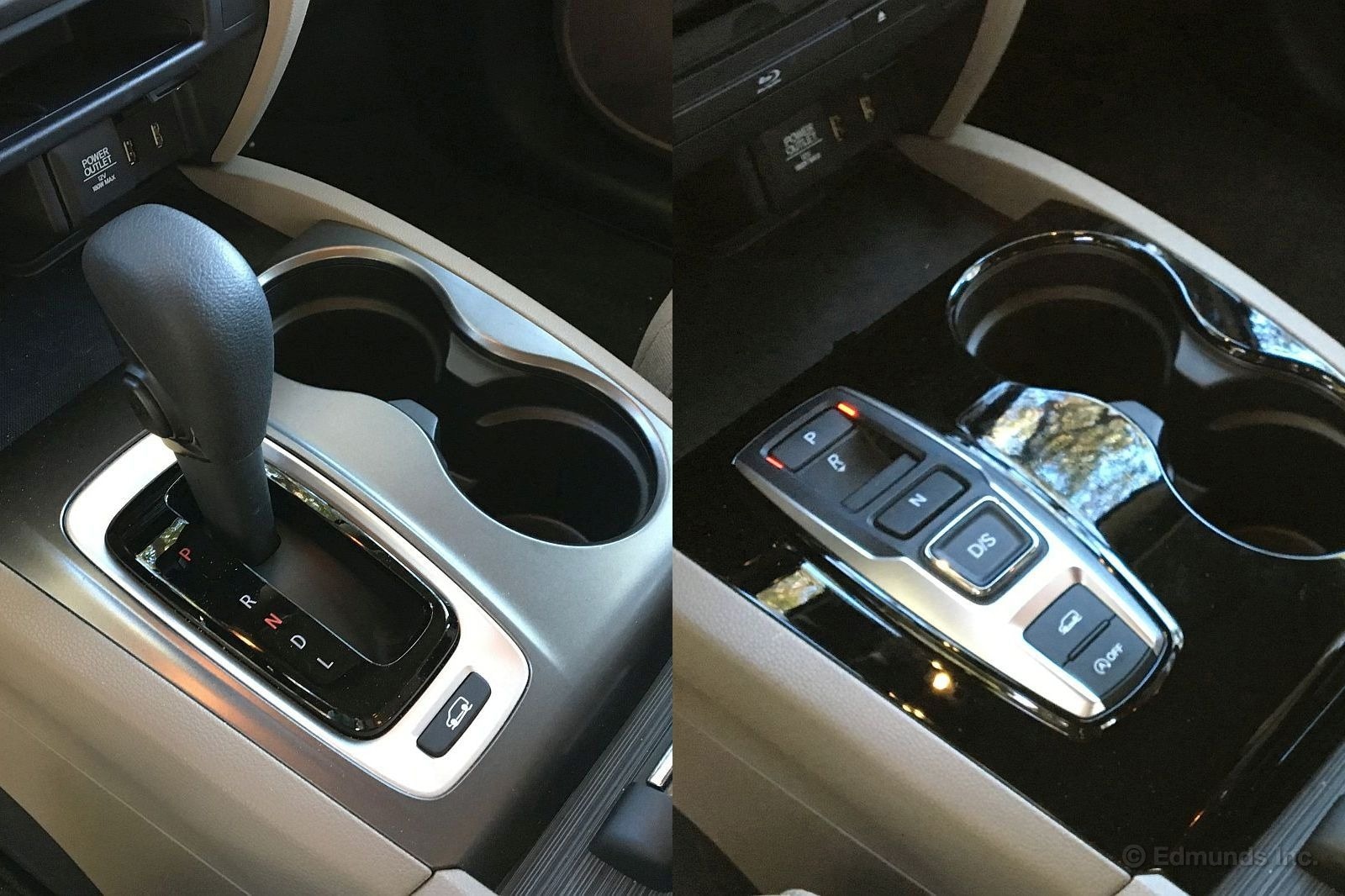
Both had all-wheel drive, which made possible a head-to-head fuel economy comparison. On paper, their respective EPA ratings suggested the difference would be small. A Pilot all-wheel-drive with 9-speed transmission is rated at 22 mpg combined (19 city/26 highway).
The AWD 6-speed is rated at 21 combined (18 city/26 highway). With highway mpg all knotted up, the 9-speed's scant 1-mpg overall advantage comes down to better city performance in the EPA lab tests that determine window-sticker fuel economy.
But would that carry over to the real world? Our 9-speed drivability complaints made us wonder. So we drove them around our two test loops, with Cameron and I swapping between them and making sure each one spent equal time in the lead to neutralize any driving style differences. Both climate control systems were set to 75 degrees in full Auto mode.
To keep things even, we switched off the Elite's auto start-stop system, a feature that comes standard with the 9-speed but not offered on the 6-speed. It's not used during the EPA testing and labelling procedure and many people dislike such systems and switch them off. I have plans to look into the "on versus off" difference in a separate test.
Our One Lap of Orange County loop is 102.4 miles of arterial city roads with more than 100 signals. The route steers clear of any freeways and the traffic is not near as bad as the hyper-congested west L.A. roads on which some of our staffers commute. We use it because it's more similar to what goes on in the rest of the country. Typically requiring less four hours to complete, our test results usually settle between EPA city and EPA combined.
Our other standard evaluation loop is known internally as The Loop. Its 116 miles consist of meandering rural two-lane roads through local hills, a couple sections of Pacific Coast Highway, steep upgrades and downgrades, some farm roads, and a stretch of suburban freeway. After about three hours, we usually see results that fall between EPA combined and EPA highway.
Here's how the two Pilots did:
OC Loop
6-speed: 20.8 mpg
9-speed: 21.6 mpg
The Loop (L.A. area)
6-speed: 25.3 mpg
9-speed: 24.8 mpg
Combined
6-speed: 23.0 mpg
9-speed: 23.2 mpg
The end result was pretty much a tie. The 9-speed demonstrated a slight advantage in the more city-heavy loop, as its EPA ratings suggested. But the 6-speed did better on the route with highways and hills. Why? Ninth gear is quite tall and our Elite simply couldn't pull it if there was much of a hill or headwind. Meanwhile, the 6-speed never had any trouble holding onto top gear, which works out to something akin to eighth-and-a-third gear in an Elite (if such a thing were possible, which it isn't) if you do all the underlying math.
Ignoring the equipment differences between the EX and the Elite, I'd take the 6-speed in a heartbeat. A week of using it confirmed how much I prefer the shifter. And the mpg numbers don't show the drivability benefit of the 6-speed, which never calls attention to itself as it goes about its business and always seems to be in the right gear.
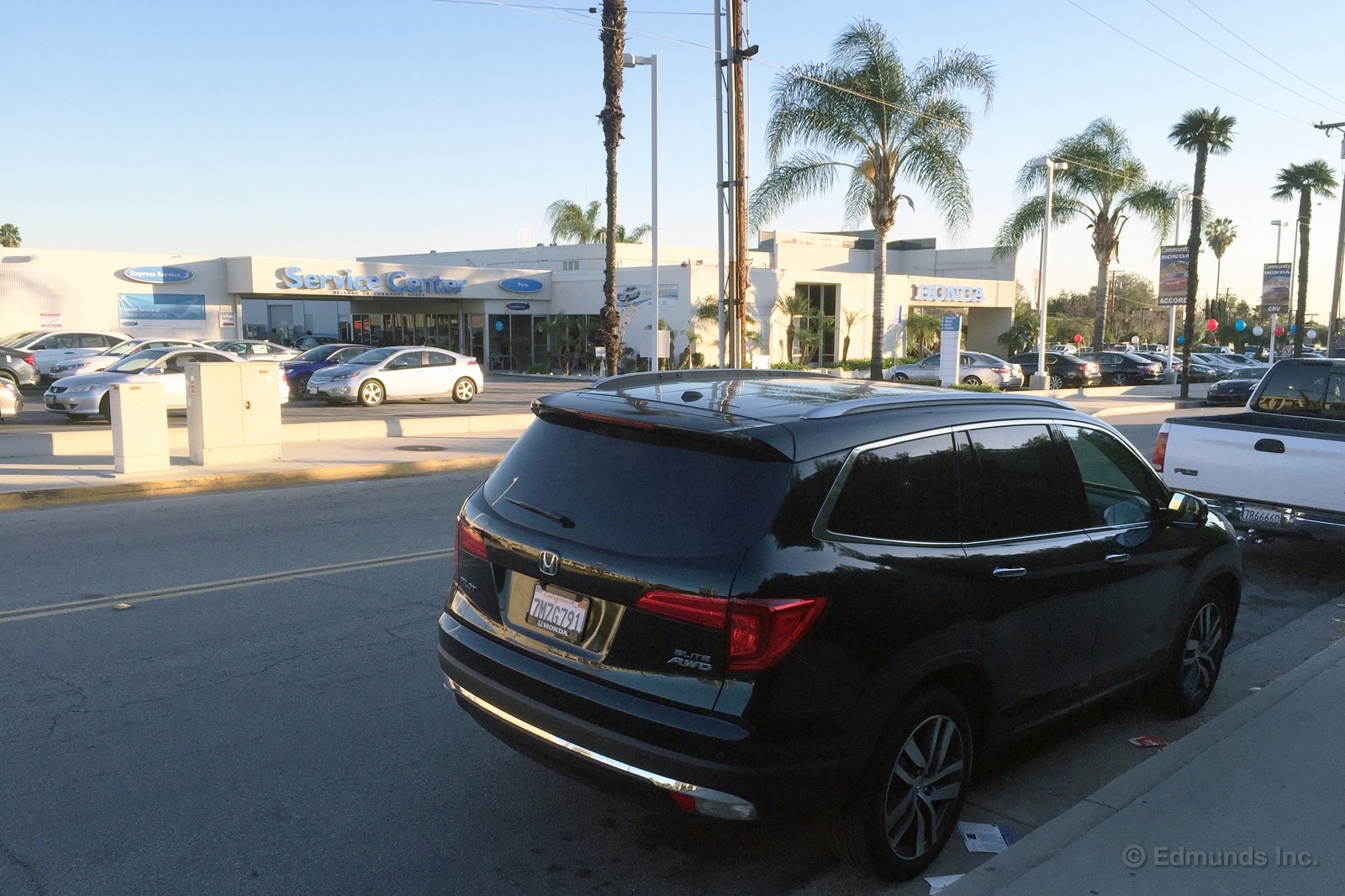
To recap our repair story so far, our 2016 Honda Pilot needed parts that would fix the broken steering wheel heater and snapping sound emanating from the driver window. We also added a windshield replacement after errant rocks cracked the glass.
Community Honda called us Tuesday to say that the parts had arrived. I informed windshield installer Kevin Gaines of Gaines Glass and told him to meet me at the dealer on Friday morning. He would remove the Pilot's cracked windshield, install the new OEM glass, and then hand it off to the dealer's techs for the other repairs.
I was sitting at a nearby coffee shop when Kevin called just past 8:00 a.m. "I just got to Honda and looked at the glass. There's a small chip in the lower corner. You'd probably never notice it, but it wouldn't be right for me to install it. I'll order another one for you and it'll be in on Monday."
I appreciated Kevin's honesty but was annoyed that the windshield had arrived damaged from the factory. Our advisor apologized again when I dropped the Pilot off to get the rest of the repairs completed. He estimated the car would be ready around 4:00 p.m., so I hitched a ride back home in the dealer's shuttle.
I called at 5:00 p.m. to check on the progress. The window regulator was replaced, which fixed the snapping sound. The steering wheel heater was another story. The button that activates it is attached to another set of buttons that accesses Bluetooth phone controls. This entire assembly was replaced, but the heater still didn't function. The next step was to call the service line and have a Honda technician troubleshoot a solution. This process would take some time, and the service department was only open for another hour.
I agreed to pick up the car so I could use it for the weekend then return on Tuesday to complete the repairs. I called Kevin and informed him of the plan. As long as the windshield survived its trip from the factory and the Honda technicians pulled through, Tuesday would be the day the Pilot was finally in pristine condition.
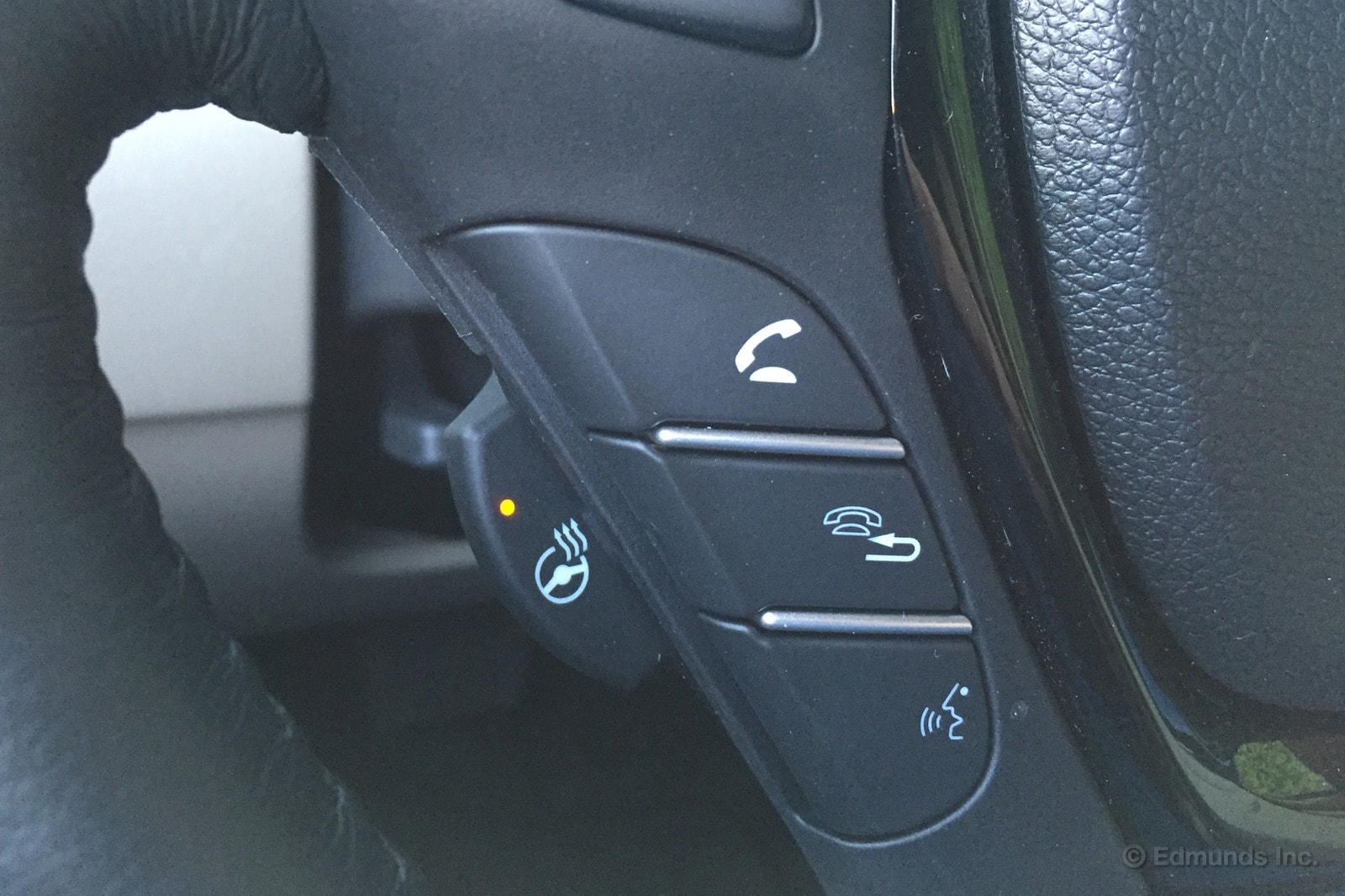
After a couple of weeks spent completing the A1 service, ordering parts (including a new windshield) and half-finished repairs, the 2016 Honda Pilot was ready for its last day at the dealer to fix the remaining problems.
I met windshield installer Kevin Gaines at Community Honda at 8:00 a.m. Thankfully, the glass arrived at the dealer intact. Since it would take less than an hour to install, I asked to shadow him and take pictures during the process. The dealership's service manager wouldn't let me in the service area, so Kevin parked the Pilot in a nearby alleyway and got to work.
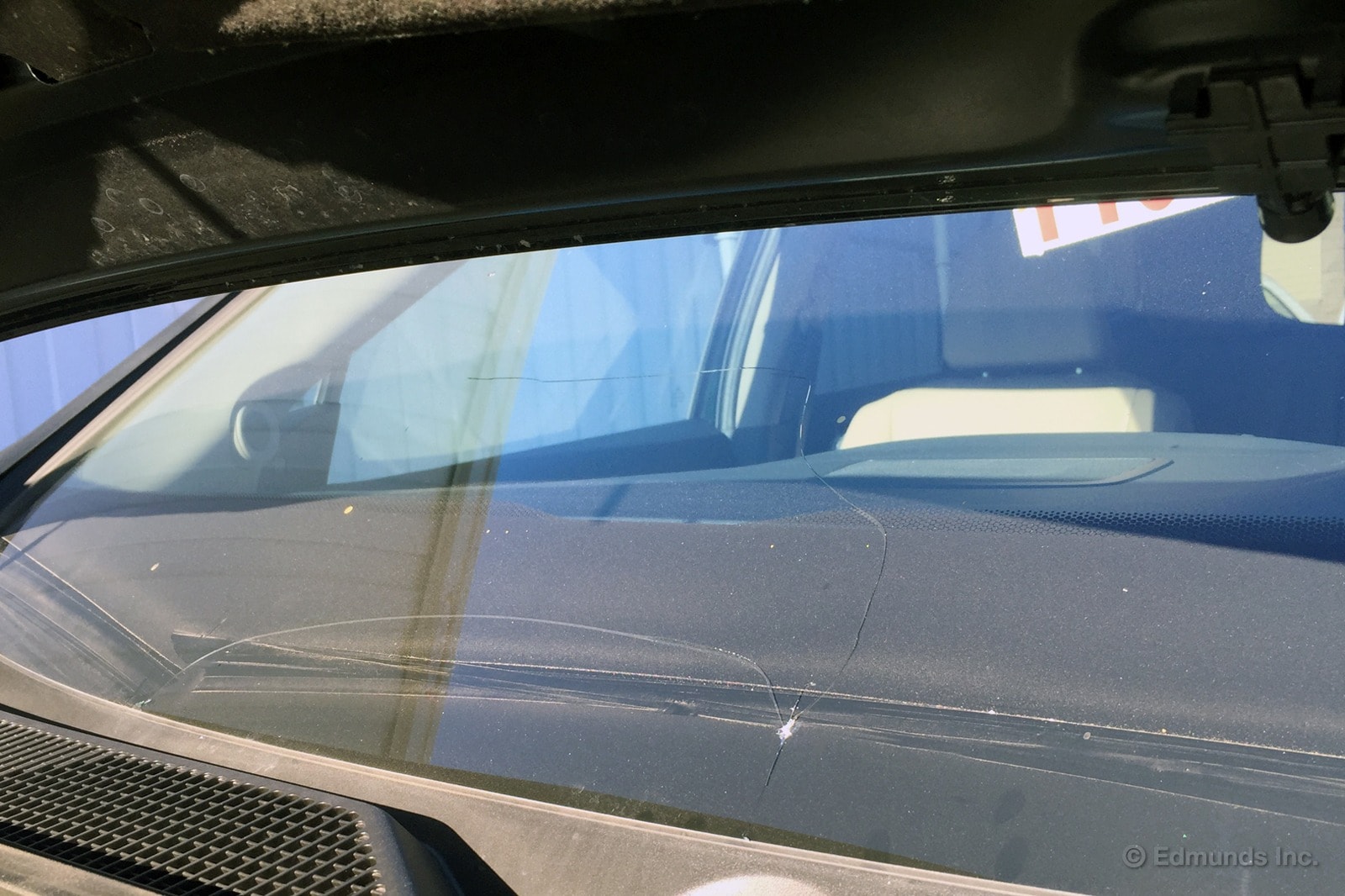
It took him about 15 minutes to prep the Pilot and detach the windshield. It was another 20 minutes to apply the new adhesive, set the glass, attach the sensor package to the top of the windshield and replace the wipers and underhood paneling. Then he drove it across the street and delivered it to the technicians so they could work on the steering wheel heater. I paid Kevin, squared everything with the service advisor, and had the shuttle driver drop me off at my house.
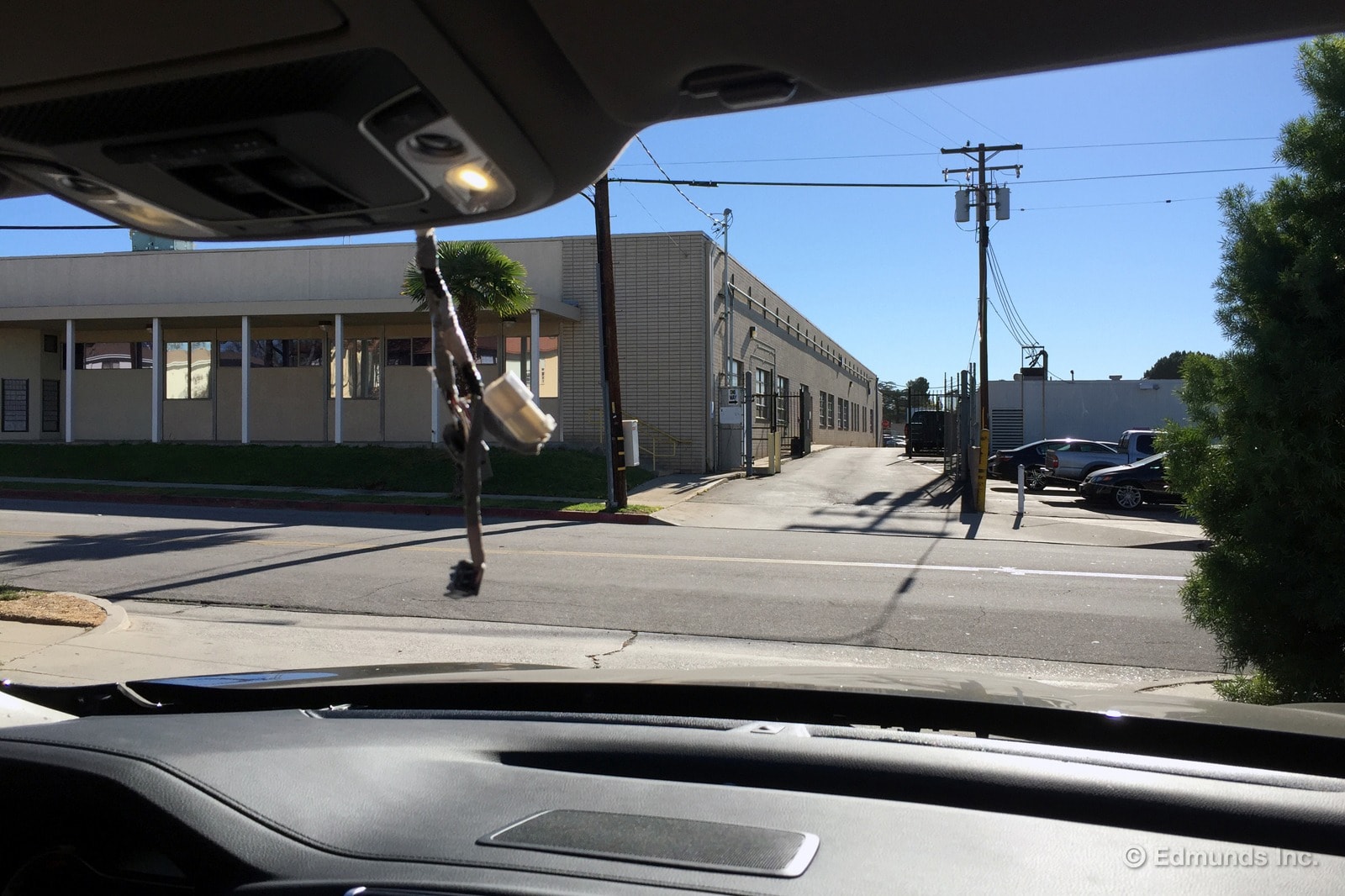

The advisor called at 4:30 p.m. to say that the Pilot was ready for pick up. The heater was fixed by tightening up a loose wiring connection and replacing the dedicated steering wheel heater fuse (#27). With that, the Pilot's repair saga was finally over. I went to the dealer, grabbed the Pilot and called it a day.
In one of the previous posts, I wrote that I started with Safelite for the windshield repair. Answer a few questions and the website gives a quote for "OEM-equivalent" glass. They will also give pricing over the phone for actual OEM glass, which is what Kevin installed, so I gave Safelite a call. There were pricing inconsistencies in their computer system and it took a couple days for them to respond with a solid price.
Here's what Safelite quoted for OEM glass and installation:
Glass: $745.83
Upper molding: $6.58
Other molding: $36.75
Disposal: $9.95
Labor: $150.00
Tax: $85.42
Total: $1,034.53
Here's a breakdown of what Kevin charged:
Glass: $650.00
Sealant: $15.00
Labor: $85.00
Tax: $59.85
Total: $809.85
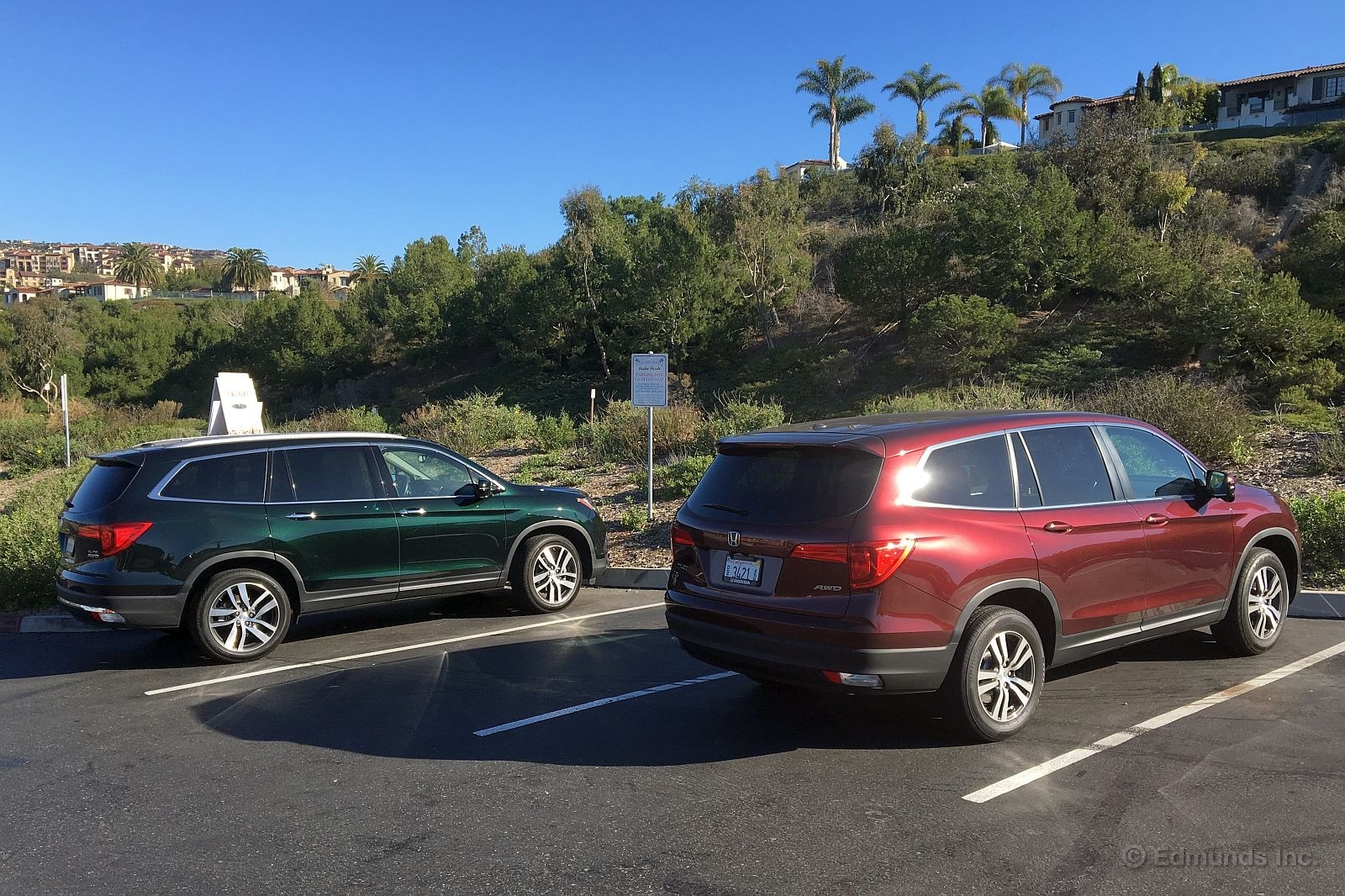
Our recent back-to-back test convinced me that if I was in the market for a 2016 Honda Pilot, I'd buy one with the six-speed transmission and the conventional lever-action shifter. But the EX we tested lacked some things I'd like, such as leather-trimmed seats, a leather-trimmed steering wheel and shifter, and heated front seats.
That very combination exists and it's called the EX-L. But it's more than just leather. It also differs from the EX in that it has a power hatch, a power tilt/slide moonroof, a four-way power-adjustable front passenger seat and "one-touch" second-row seat folding.
Including the compulsory destination charge, one of these goes for $36,955 in front-drive trim and $38,755 with all-wheel drive. Our Elite — which is only available with AWD — goes for $47,470.
The specific one I'd get is the EX-L Navi, which is Honda shorthand for "with navigation." This version costs $1,000 more than a regular EX-L, but even the pricier AWD version goes for less than $40,000. The front-drive version I'd probably choose would cost less than $38,000.
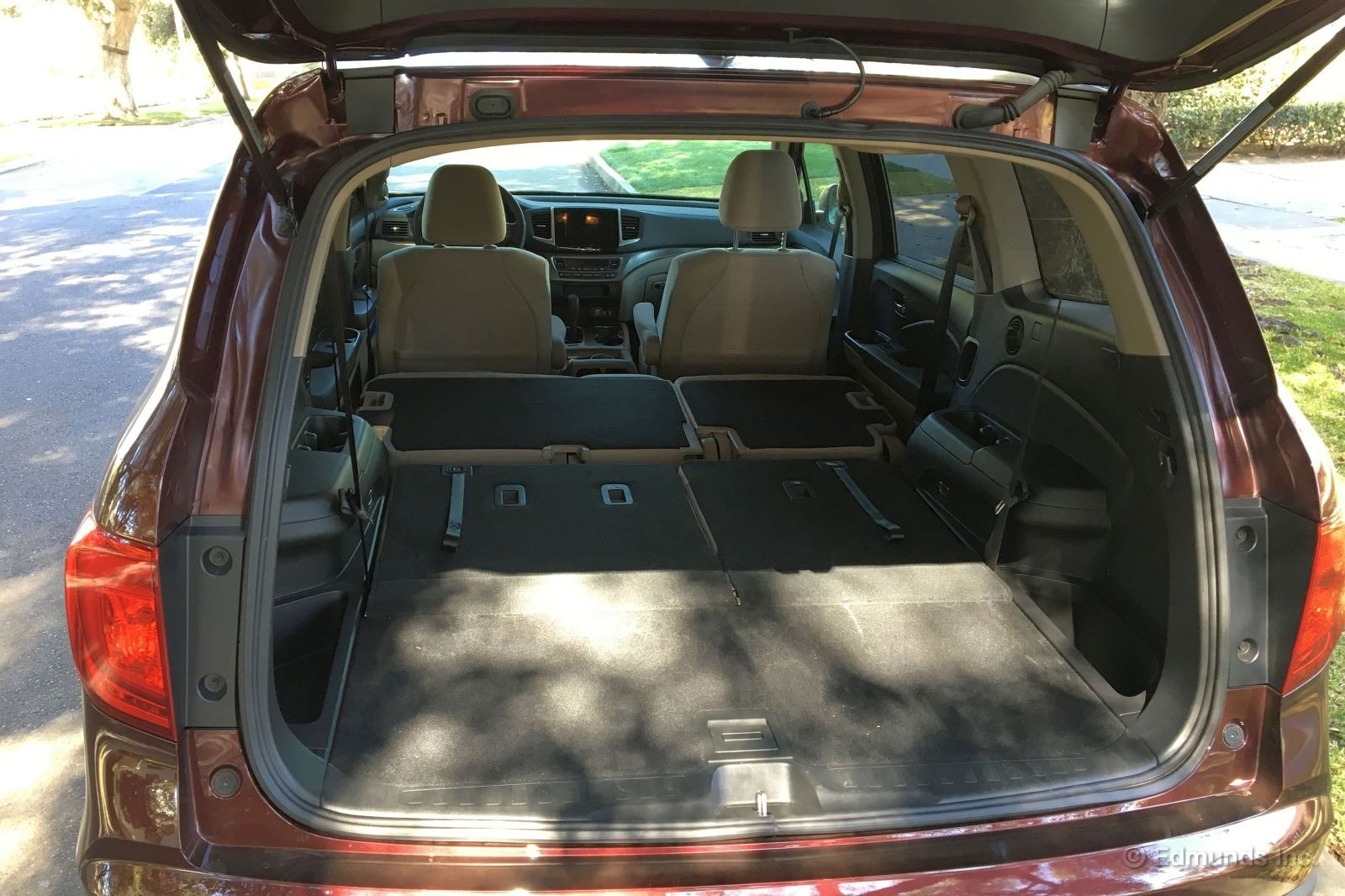
In addition to the 6-speed, the shifter and the leather, I prefer the EX-L because the backseat is still a 60/40 three-across affair. This Pilot seats one more person, and those with one child seat have a place to latch it in the middle. When up, the full-width seatback keeps your cargo from spilling forward, and when it's down the load floor doesn't have the big hole you get when you fold an Elite's middle seats.
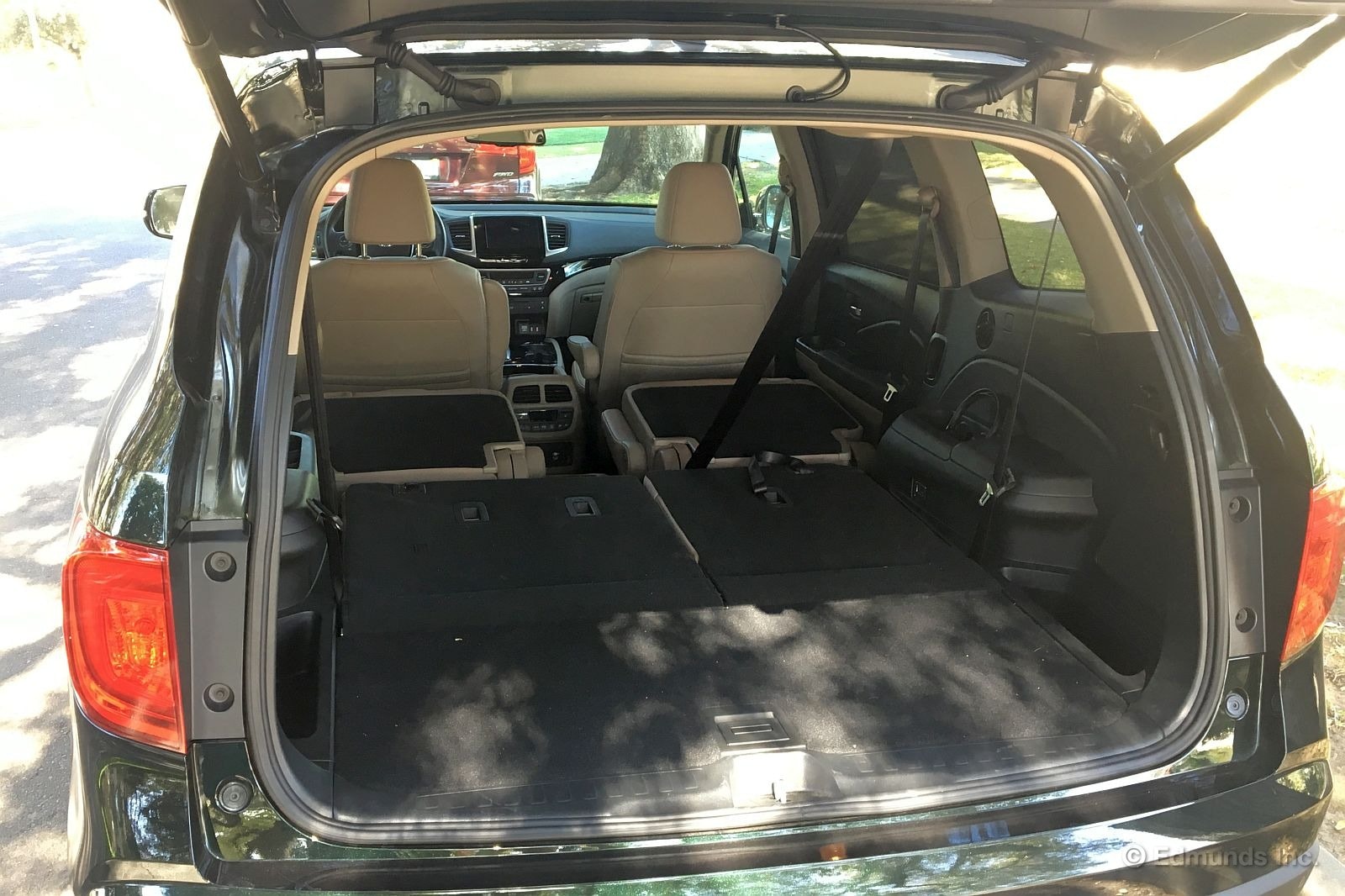
The seat configuration part is equally true of the Touring, which lives between the EX-L and the Elite. But that one is off my list because it has the nine-speed I'm trying to avoid. It also lacks another thing the EX-L has: 18-inch wheels and tires. Not only do the 18-inch tires ride smoother, they're also cheaper to replace than the 20-inch rolling stock found on the Touring and Elite.
As of today, Tireack.com sells replacement original equipment 2016 Honda Pilot 18-inch tires for $169.30, but they get $232.75 for the 20-inch O.E. rubber — some $63.45 more per tire and $253.80 more for a full set.

For the same price as my EX-L Navi, I could instead buy the EX-L w/Honda Sensing, a package that includes adaptive cruise control, forward collision warning with collision mitigation braking and lane departure warning with lane keeping assist and road departure mitigation. Or I could choose yet another variation, the EX-L w/Rear Seat Entertainment, which costs $1,600 more than a regular EX-L.
This is where things can get sticky. I can get an EX-L with Honda Sensing, or with navigation, or with the rear seat entertainment system, but at the EX-L level I can't get any two of them together, much less all three. If I want the lot of them, I have to step up to a Touring, which costs $5,115 more than an EX-L and forces me into the 20-inch tires, nine-speed and weird shifter I'm trying to steer away from. No deal.
For me, this problem is not a problem because I don't want all three anyway. Smartphones and iPads make the Rear Seat Entertainment version unnecessary, and Honda Sensing isn't tuned well enough to keep me from switching it off all too often. Make mine the EX-L Navi.
What am I missing out on by going the EX-L Navi route?
The Elite and the Touring have a 500-watt, 10-speaker audio system, rear-seat charge-only USB sockets, memory seats and mirrors, chrome door handles and longitudinal roof rails (though the load-carrying cross-rails are extra.) And while all Pilots have an acoustic windshield to help quell wind noise, these two also employ "quiet glass" in their front door windows.
The Elite is the only pathway to heated and cooled front seats. The rear captain's chairs I don't like anyway are nevertheless the only route to heated middle row seats. It's the only one with a heated steering wheel, LED auto on/off headlights, rain-sensing wipers and HD radio. And it doesn't just have a regular moonroof, it has an extra-large Jurrassic Park-style panoramic moonroof. And for some reason, it's the only version with blind-spot monitoring and rear cross-traffic alerts.
I'm not in love with any of it, except for HD radio, perhaps. KROQ-2 is always among my presets if a car has HD radio. But one radio station is no reason to spend thousands more. Besides, I can stream it.
But Mike Magrath isn't quite of the same mind. He isn't critical of the nine-speed like I am, and notes that its slightly better city mileage performance suits his commute.
Mostly though, he considers some of the EX-L's missing features to be dealbreakers.
Of the cooled front seats, he says, "It’s hot in L.A. and I go for more hikes than you'd expect in poorly-breathing shorts." He also wants the Elite's LED headlights because, "I find myself in very dark canyons all too often." The heated second-row captain's chairs appeal to him and he prefers the Elite's giant sunroof. "I’m a sucker for sunroofs," is how he puts it.
But he's no fan of the Elite's stiff price and Honda's pricing strategy that lacks a-la-carte options and forces him to buy the kitchen-sink model just to get the stuff he wants, even when it has features he isn't particularly interested in.
I get that, but I find the EX-L to have just enough of the equipment I want most. And I really like that I can get a Pilot that I could happily live with for less than $40,000.
Fits a 4x8 Sheet of Plywood and Coffee Table — Sort Of
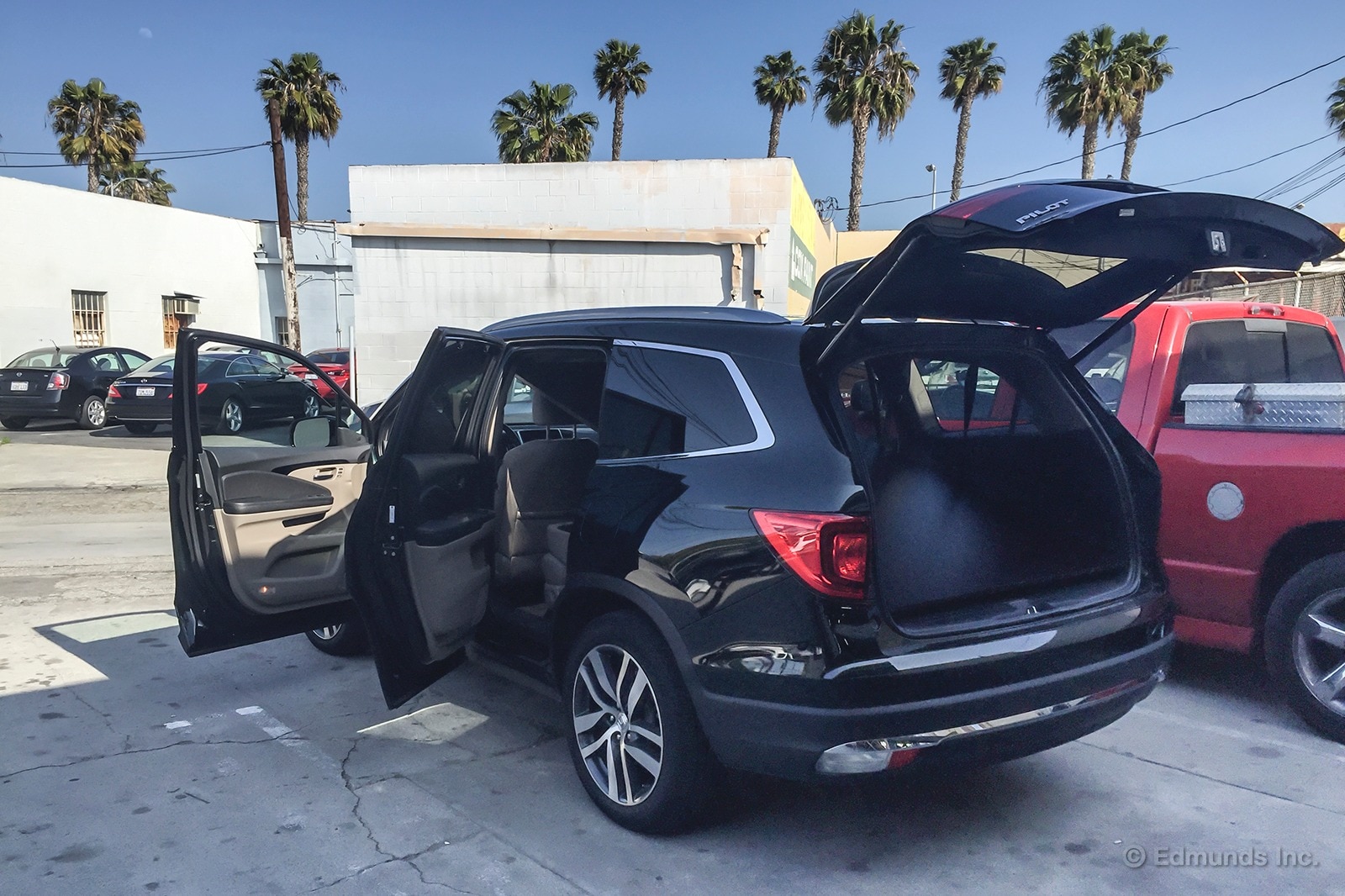
The last time I drove our long-term 2016 Honda Pilot, I took the three-row SUV on a 1,000-mile road trip and it did an admirable job carrying five people and all our gear. Last weekend when I signed out the Pilot for the second time, I had a very different task in mind.
My plan was to build a coffee table for my apartment and both of the Edmunds long-term pickup trucks were spoken for. So I went for the next best thing I could think of: a 16-foot-long crossover SUV. According to vehicle manager Mike Schmidt, the interior dimensions of the Pilot were perfect for this sort of task and I was happy to test his theory.
It turned out that the back of the Pilot was certainly wide enough for a 4-by-8 sheet of plywood, but from front to back, there was some overhang. I don't like tying down the hatch with a bungee chord, so we pushed the seats forward and perched the birch on top of the front headrests. Only then could we close the hatch. This wasn't ideal, but the trip was less than two miles and it was a much better option than strapping the wood to the roof (which has roof-rails but no tie-down points).

After a few days of cutting, gluing, nailing and staining, the table was ready to come home from the workshop. This required a few seats to be folded, but luckily the second row goes completely flat, so loading the table in wasn't a problem.
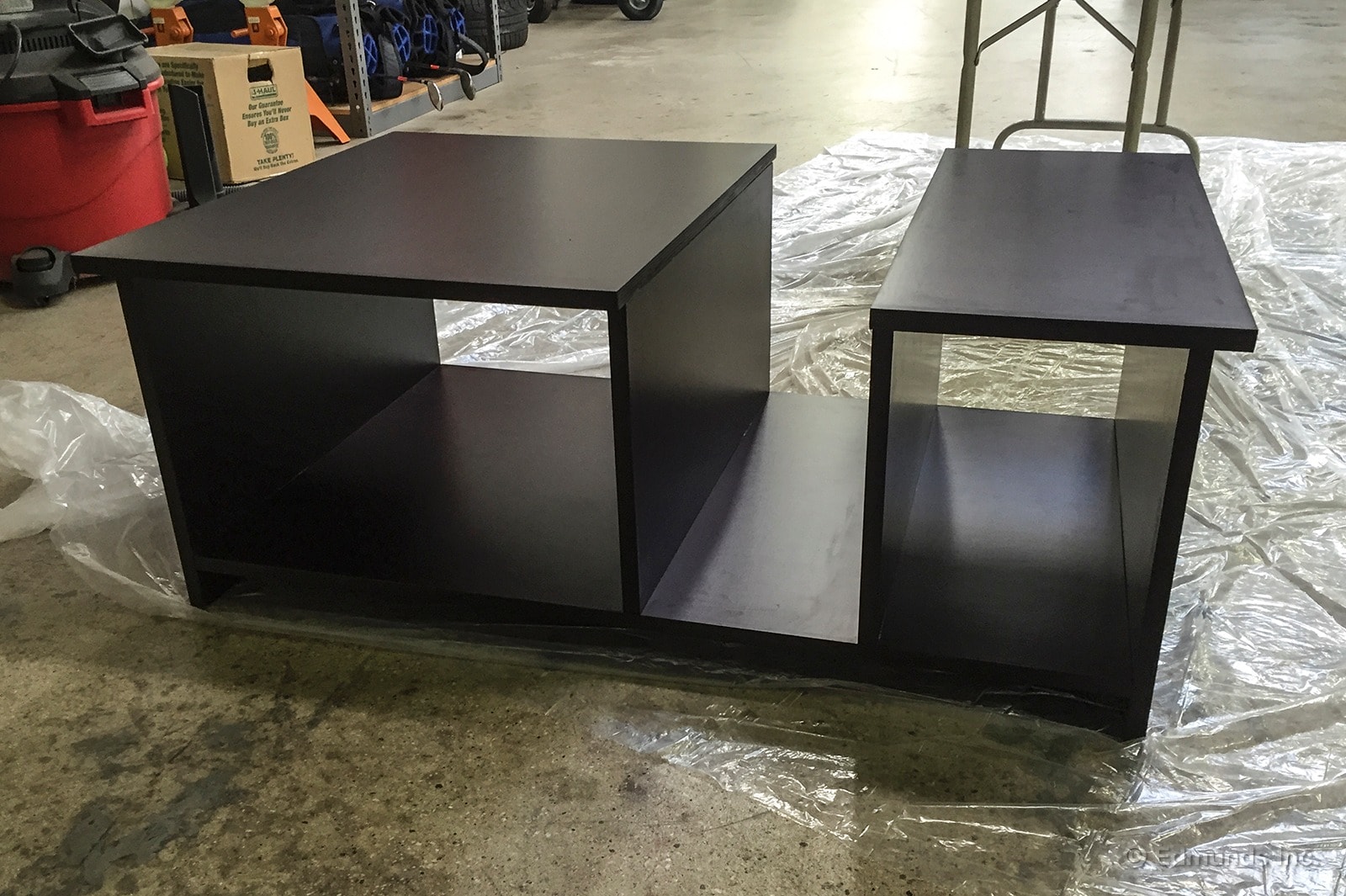
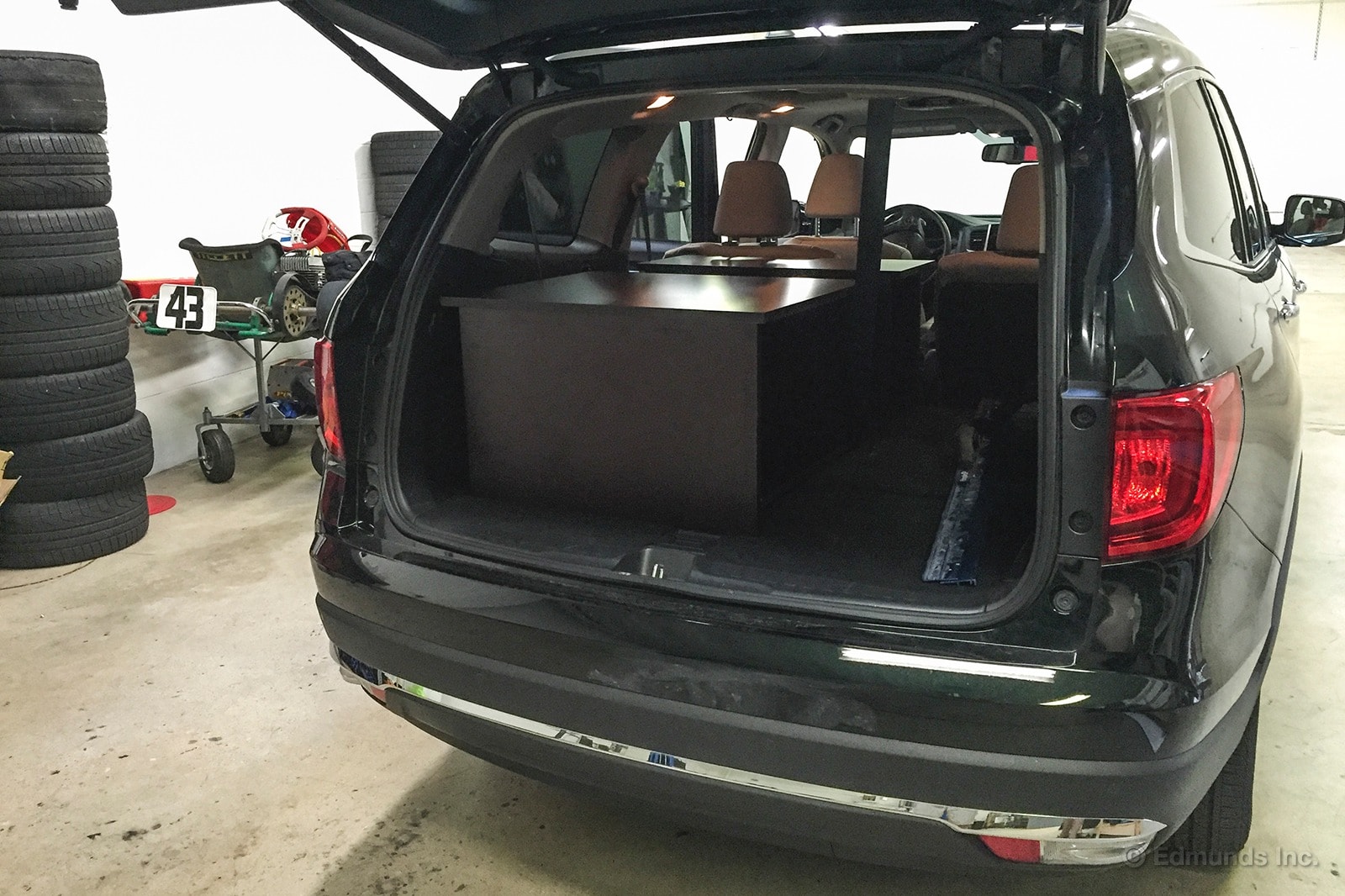
Basically, the Pilot showed off a bit of versatility and took the place of a pickup truck for the weekend, all while keeping our tools locked up in the cabin at night.
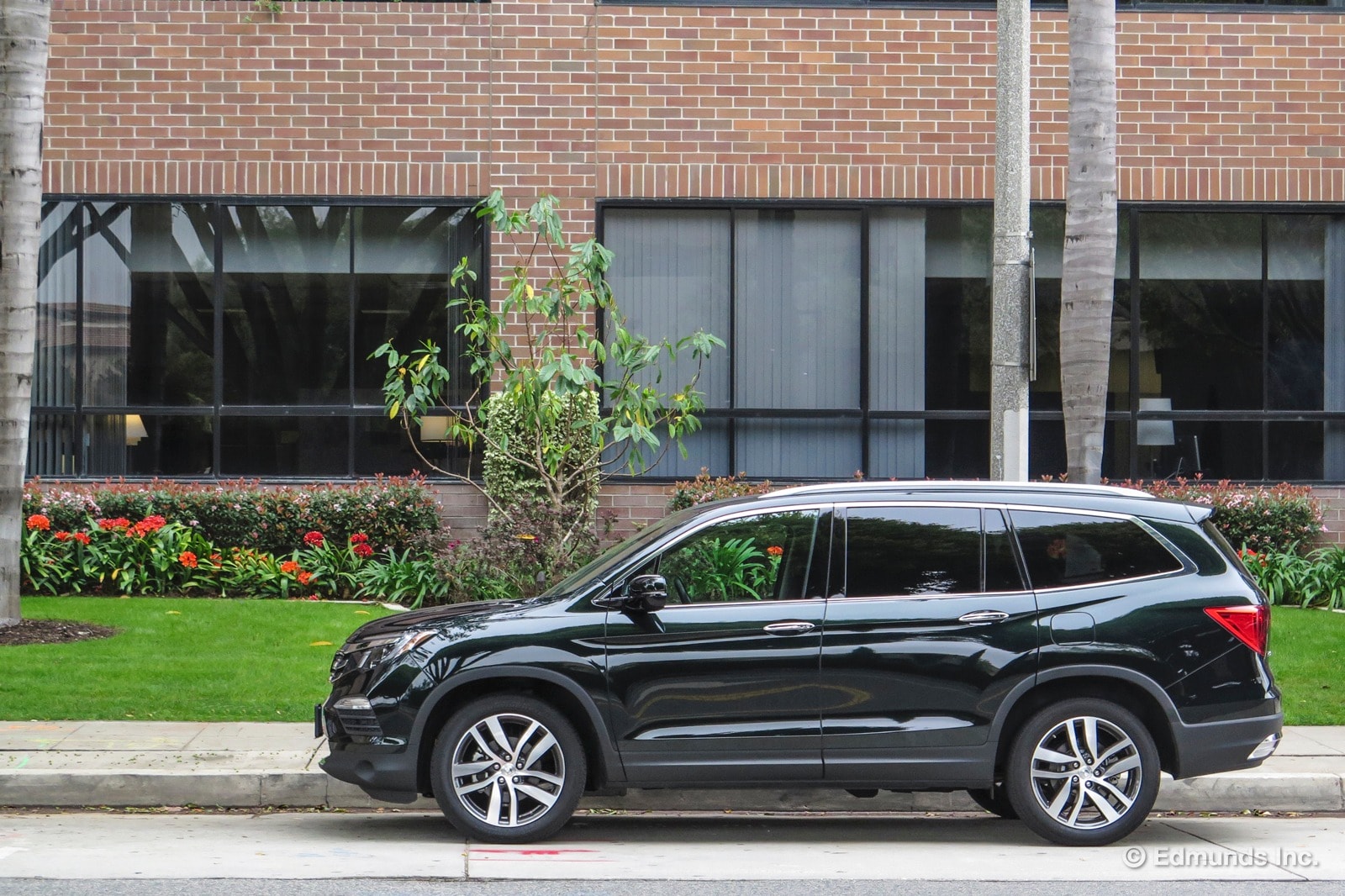
In less than five months, our long-term 2016 Honda Pilot has already hit the 10,000-mile mark, nearly a month ahead of schedule. Comfy, road-trip-friendly vehicles are popular around here so that's not a massive surprise, but even this big Honda has seen more than its fair share of action.
It went on an early 1,000-mile road trip with five passengers, a 1,767-mile road trip with four passengers, and it facilitated family day with seven passengers. We performance-tested the Pilot early in its tenure here, then at around 7,500 miles it needed the A1 service, a new windshield, and some troubleshooting to fix the heated steering wheel.
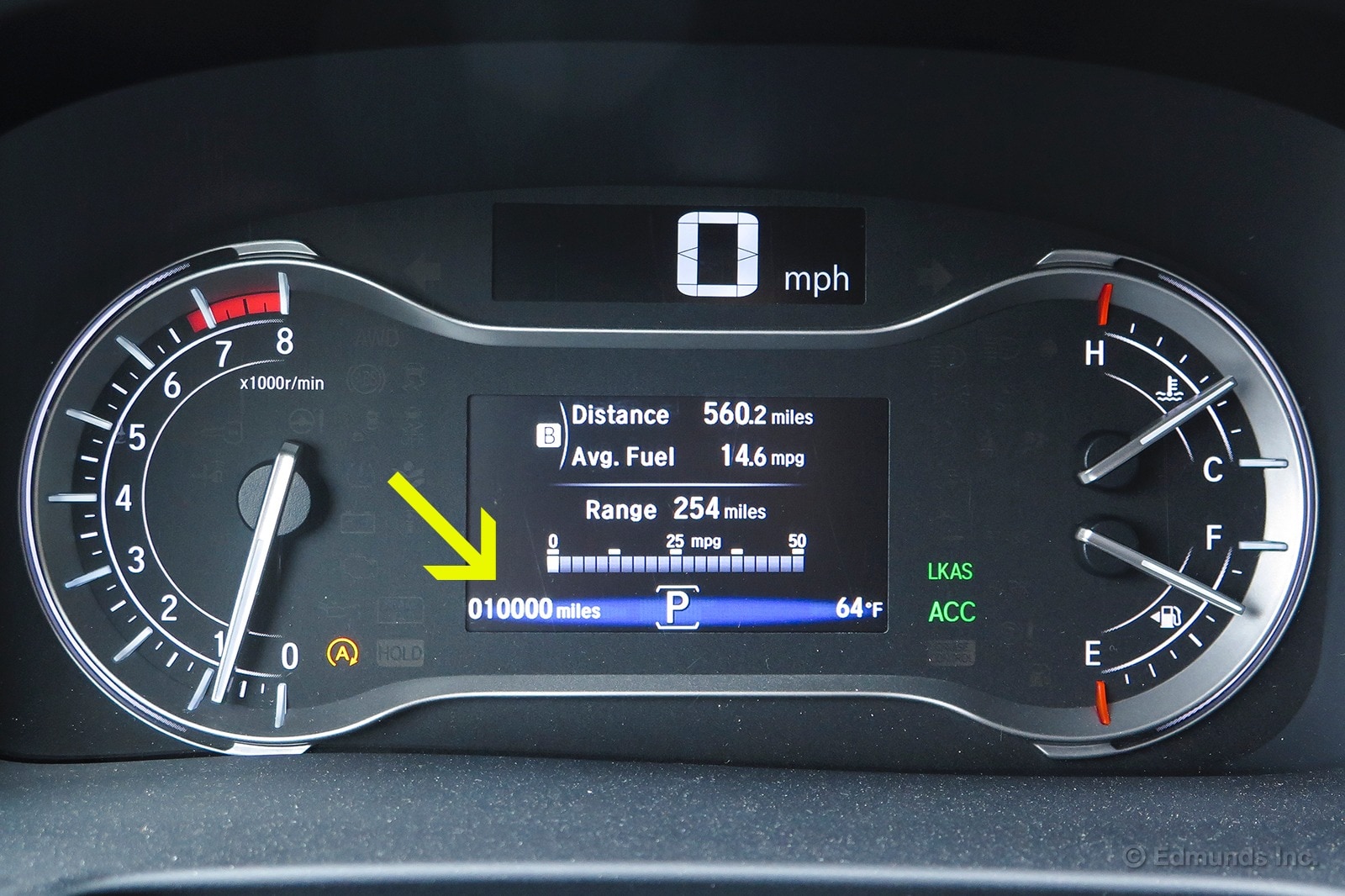
So there've been a few speed bumps along the way, but nothing to dissuade us from liking the Pilot quite a bit. Without a doubt, this car will leave us after a year of testing with a mileage surplus.
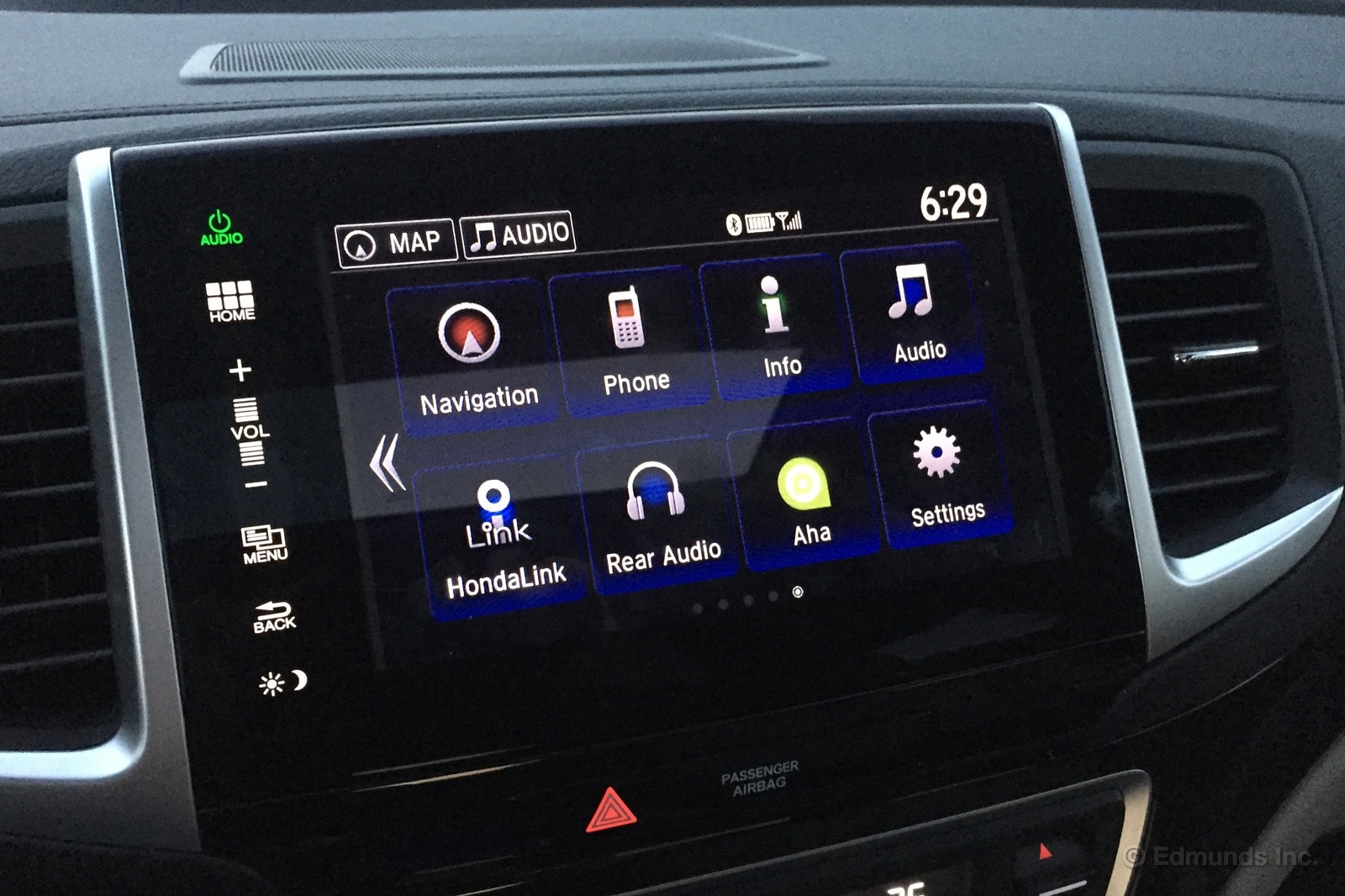
Two days before I was set to leave for Las Vegas in the 2016 Honda Pilot, Schmidt informed me he received a letter from Honda saying there was a technical service bulletin issued for the Pilot regarding the infotainment system. Schmidt said that if I had time to take it in, I could have the Pilot a day early and work from home. To save myself from a three-hour round-trip office commute, I took the offer.
Everything at Community Honda is done on a first-come, first-served basis. I showed up on a Thursday at 8 am, when the service center opened. I met my advisor, Will, who previously helped me through the steering wheel heater saga.
The new update, (TSB 15-072), fixes an issue with the navigation display screen. The Honda Service Bulletin notes that the display screen goes blank, rendering the entire system inoperable.
The repair process is simple: the dealer inserts a USB drive with the updated software into one of the Pilot's front ports and uploads a new version of its software. According to the TSB, the entire upload takes 20-25 minutes. Unfortunately, I was unable to verify how long it actually took to upload the fix. I was given an estimated time of 1.25 hours, so I sat in the waiting area and took out my laptop.
I got carried away with work, and approached Will's desk a little less than two hours into the process. He found a notice from a repair technician stating that the Pilot was ready to drive away, and said that he had no idea when the notice was dropped off.
I don't know how long I would have waited if I hadn't asked.
City Driving During February and March Reduces Fuel Economy
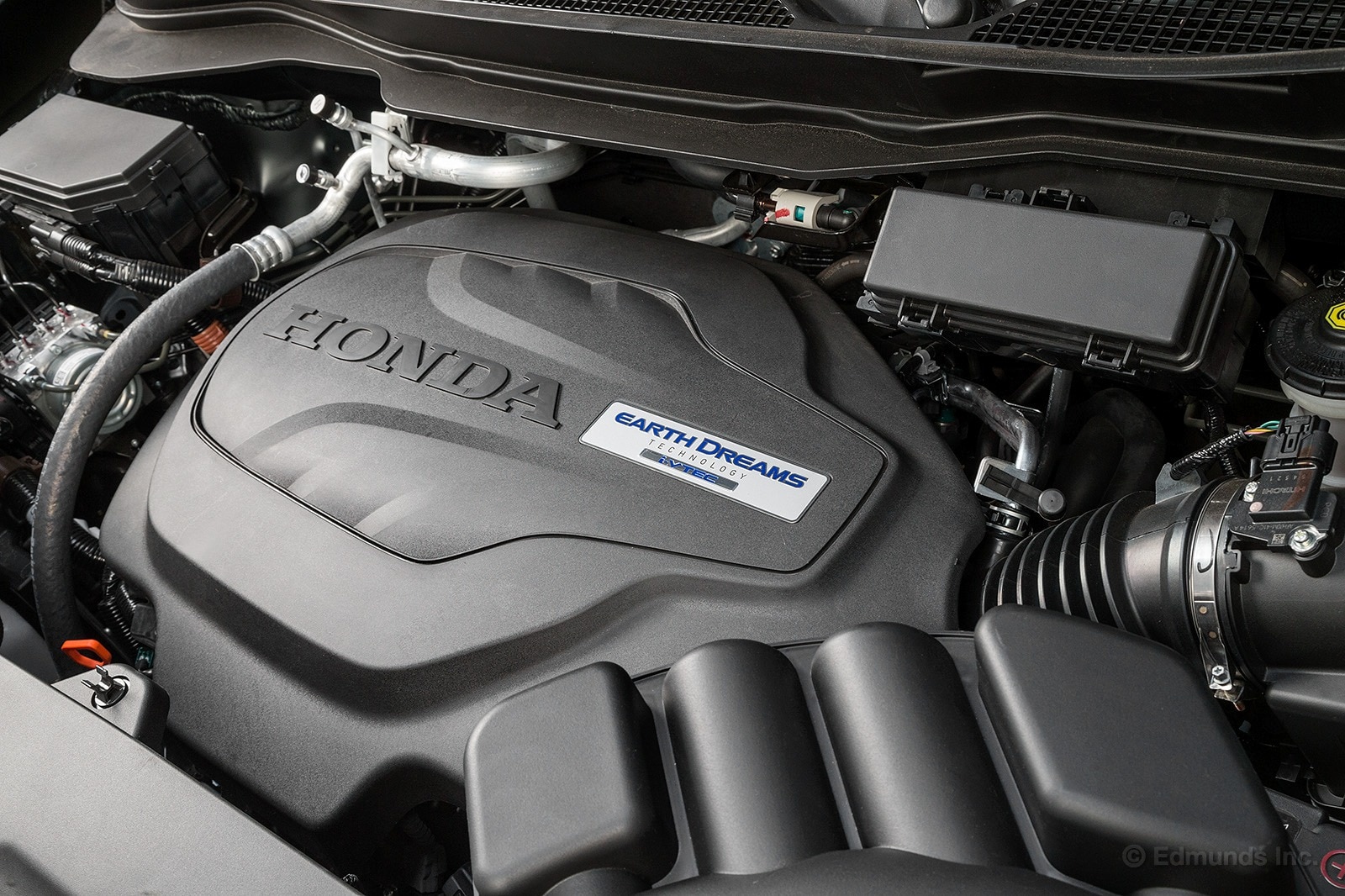
While our 2016 Honda Pilot saw a nice mix of city and highway driving in February, a month full of stop and go traffic in March dealt a blow to overall fuel economy. After it was all said and done, our overall average dropped from 20.4 mpg at the end of January to 19.7 mpg at the end of March.
We traveled 1,755 miles in February, with two of the eight fills related to Dan's comparison post between our Pilot Elite with its nine-speed transmission and a Pilot EX with the six-speed. Over two evaluations loops that totaled 217 miles, we found the fuel consumption of the Elite and EX were nearly the same in combined driving.
Additional Pilot Elite fills during the month brought February's average down to 20.0 mpg, reducing overall fuel economy slightly from 20.4 mpg to 20.3 mpg.
March was different. Our Pilot spent most of its time in the Los Angeles area, racking up just 761 miles in the process. City-heavy traffic is especially unkind to the Pilot's fuel consumption, which hit an all-time low (12.6 mpg) during one fill-up. The month's average ended up being 14.7 mpg, which reduced overall economy to 19.7 mpg. A road trip I took to Vegas at the beginning of April should see the needle swing back the other way.
Worst Fill MPG: 12.6 mpg
Best Fill MPG: 25.8 mpg
Average Lifetime MPG: 19.7 mpg (5.1 gallons/100 miles)
EPA MPG Rating: 22 Combined (19 City/26 Highway)
Best Range: 400.6 miles
Current Odometer: 10,201 miles
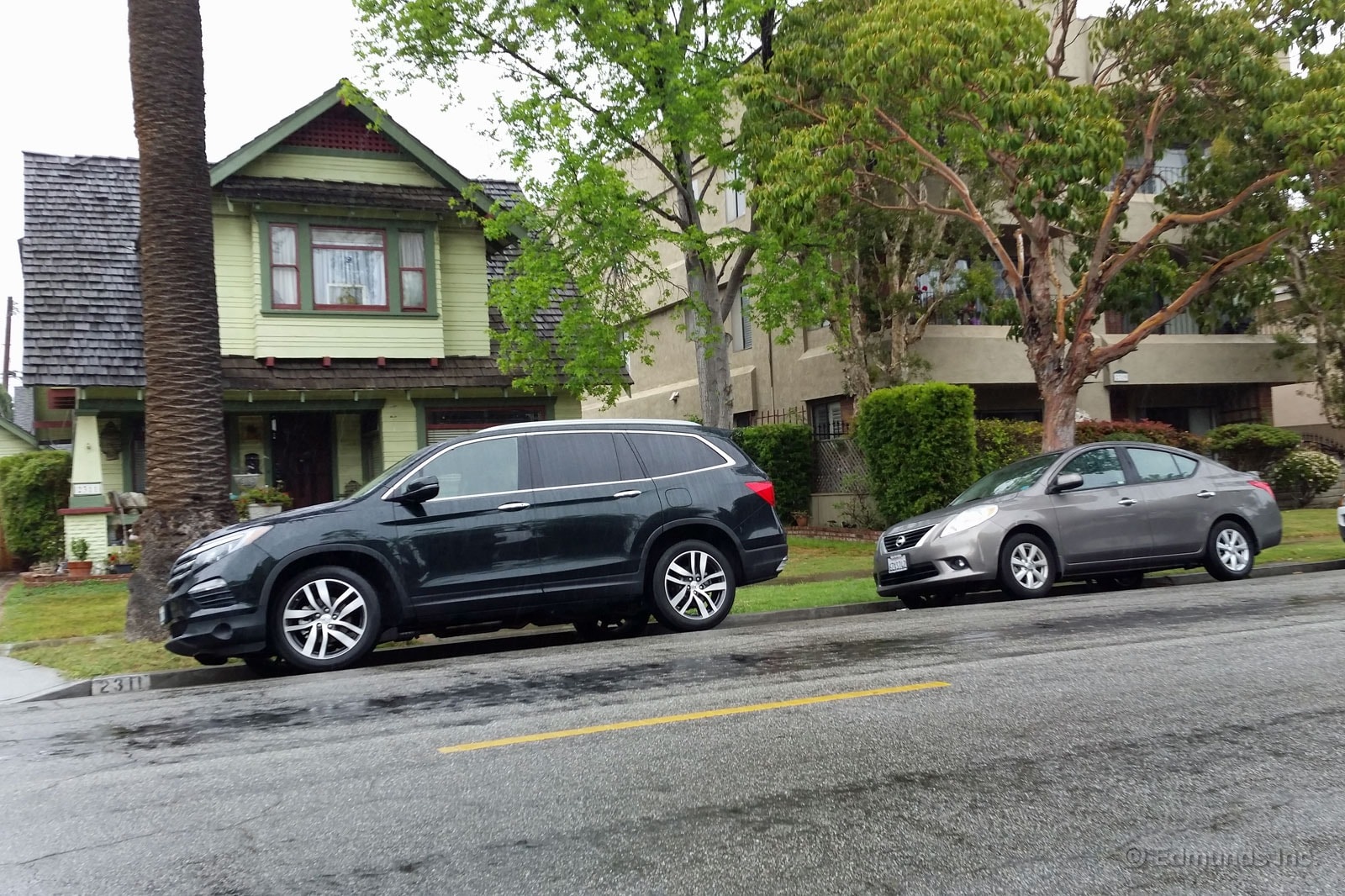
The 2016 Honda Pilot in Elite trim comes standard with variable intermittent rain-sensing wipers, a feature we don't often have the opportunity to test here in sunny Southern California. But last week a light April shower prompted me to wake our Honda's wipers from their slumber, freeing them to swing back and forth as needed during my morning drive across town.
As typical, the rain didn't last long and we were back to dry conditions by the afternoon. I didn't give the wipers a second thought until I pulled into an automatic car wash to spruce-up the Pilot's exterior. Swish, the wipers sprung back to life.
I moved the control firmly back to the "Off" position. Not likely to be seeing rain here again anytime soon.

I've been to Las Vegas a few times over the past couple years, but vehicle logistics have prevented my party of six adults from taking the trip in one car. I tried previously with our departed 2014 Toyota Highlander, but the third row didn't have enough legroom for two adults. I tried again when we added the 2015 Kia Sedona to the fleet, but it was involved in a collision shortly beforehand. This time, I again requested the Sedona but it was signed out by another editor for the same weekend.
Then Mike Schmidt threw a Hail Mary in the form of our 2016 Honda Pilot. I was doubtful, as the comparable Highlander didn't fit two of my passengers. But I took the Pilot home one night, filled the car with my crew and found that there was sufficient legroom and headroom for the people in the back. Due to tight packaging, the third row in a crossover is typically only suitable for kids or small adults. My third-row passengers were a few inches on either side of 6 feet, and both fit well enough for a trip to Vegas. I told Schmidt the Pilot would be okay. But my group would have to pack light for it to work.
In crossovers of this size, the cargo space behind the third row is limited. The Pilot is no exception, with the distance between the seatback and hatch at just 16.5 inches. Unlike some other crossovers, the Pilot has a false cargo floor that expands the height a few inches when removed. This would prove invaluable for our trip, as we could fit luggage behind the third row without compromising visibility out the rear window.
I told my group to fit everything into malleable duffel bags rather than rigid suitcases. My instructions were technically followed, but the bags were filled to the brim, which made them difficult to mold. My group just doesn't pack light. We had four luggage bags, my laptop bag, a suitcase that I shared with my girlfriend and a few carry-ons with food and beverages. All that, and I had a clear view out the back.
Like many of its rivals, the Pilot was reasonably quiet and exhibited a comfortable highway ride. I used the adaptive cruise control throughout the trip except when I needed to pass or when traffic slowed in construction areas along I-15. Although far from perfect, I like the system more than in the Acura TLX. There were several times when a car cut in front of me to pass a slower vehicle in their lane. Rather than slam on the brakes like I expected, the Pilot beeped like crazy and flashed the "Brake" light in the instrument panel. The brakes were applied after a few seconds, but I appreciated that the system didn't immediately physically overreact like it does on the TLX.
While neither of my third-row passengers complained about the room in the back, I know they would have been more comfortable in the Sedona. There's certainly more cargo room in the minivan and the second-row captain's chairs offer more adjustments. The Sedona is also slightly better while executing passing maneuvers, as its transmission finds the appropriate gear more quickly than the Pilot. Despite the Sedona's numerous advantages, the Pilot is an acceptable substitute for a quick sprint to Vegas. A destination further away (say, to Zion) with this many people would necessitate the larger car.
Overall fuel economy for the 527-mile round-trip was 22.3 mpg.
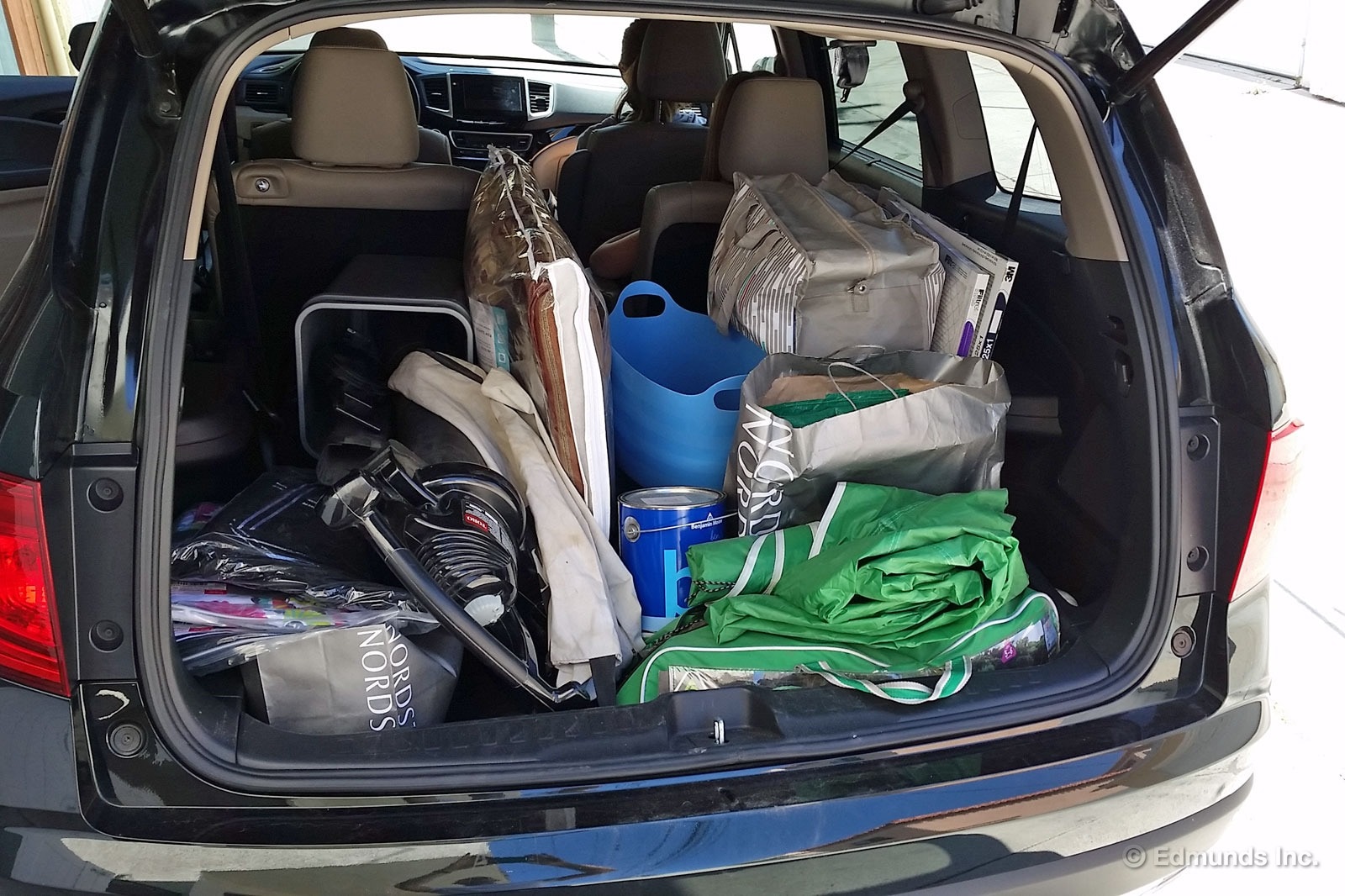
Three-row crossovers like our 2016 Honda Pilot sometimes get an undeserved reputation for not having much cargo room. That's because they have those pesky third-row seats in the way. Fold them down and there's plenty of room for a run to the Goodwill.
At least that what I was thinking when I loaded up our Pilot over the weekend. Between the lowered floor well at the back and wide open space created by the folded third-row seats, I didn't even have to squeeze stuff in.
Obviously, when driving carpool or otherwise utilizing the third row, the cargo area is significantly compromised. But how often do you have a full house on board? Probably not that often. The rest of the time, the Pilot, and other three-row SUVs like it, have plenty of room for passengers and cargo.
Fuel Economy Update for March - More Miles, Same MPG
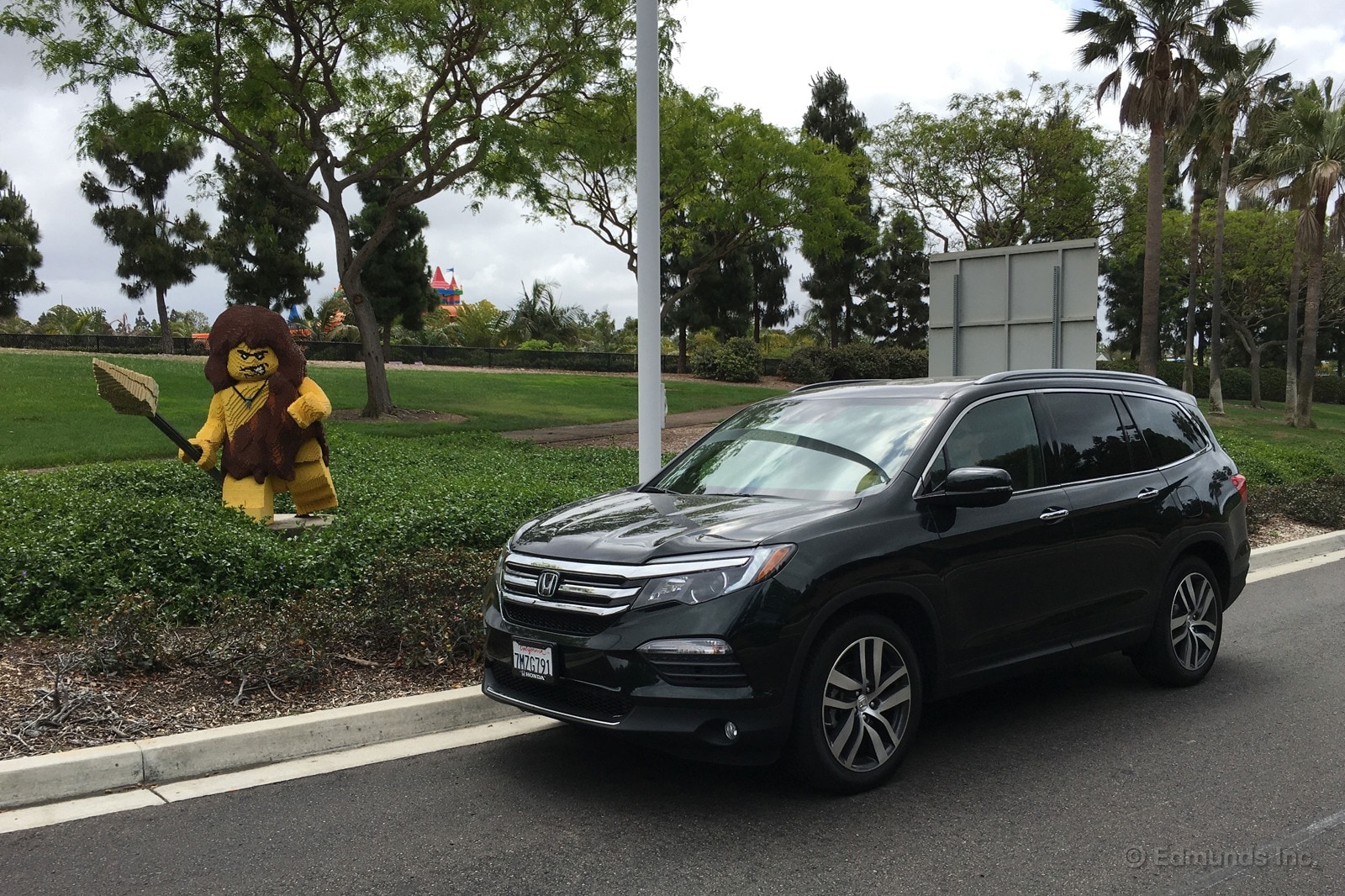
A fuel economy trend is emerging now that we are 12,000 miles into our test of the 2016 Honda Pilot. And the trend is status quo. We added just over 1,700 miles to the Pilot in April but it wasn't good enough to change any of our lifetime figures.
I even tried to sneak in a freeway-heavy 400 miles and side trip to Legoland in the final days of the month, but to no avail. Nothing budged.
Take the jump to see how the Honda is performing...
Worst Fill MPG: 12.6 mpg
Best Fill MPG: 25.8 mpg
Average Lifetime MPG: 19.7 mpg (5.1 gallons/100 miles)
EPA MPG Rating: 22 Combined (19 City/26 Highway)
Best Range: 400.6 miles
Current Odometer: 11,925 miles
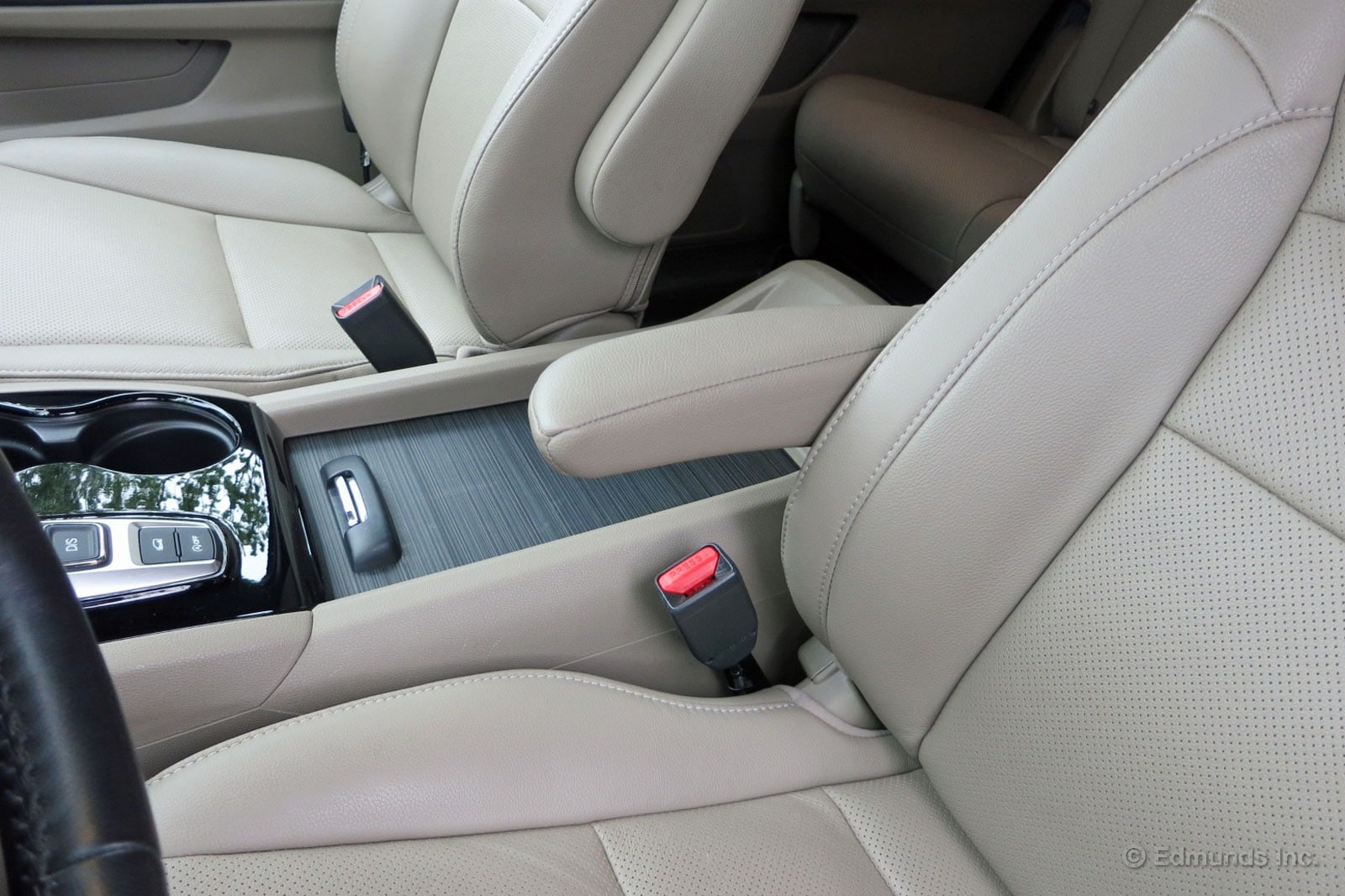
One unique feature on our 2016 Honda Pilot is this ridiculously simple yet effective adjustable armrest. Every time I use it, I wonder why more SUVs and crossover don't use a similar design.
Most driver seats just offer up the center console as the best place to rest your right arm. It works fine for the most part, although much of it depends on your individual seat position. If you like your seat as high as possible, that center console might seem uncomfortably far down. If you like the seat on the floor, that console is probably too high.
With this setup, the armrest not only moves with the seat, you can adjust the angle just by ratcheting it into place. Once you get used to it, other seats feel like they're missing something without it.
Honda has been using this setup for years. I remember first finding it in the Odyssey minivan many years ago and I loved it then. Glad to see that it has made the cut in the latest Honda family vehicle.
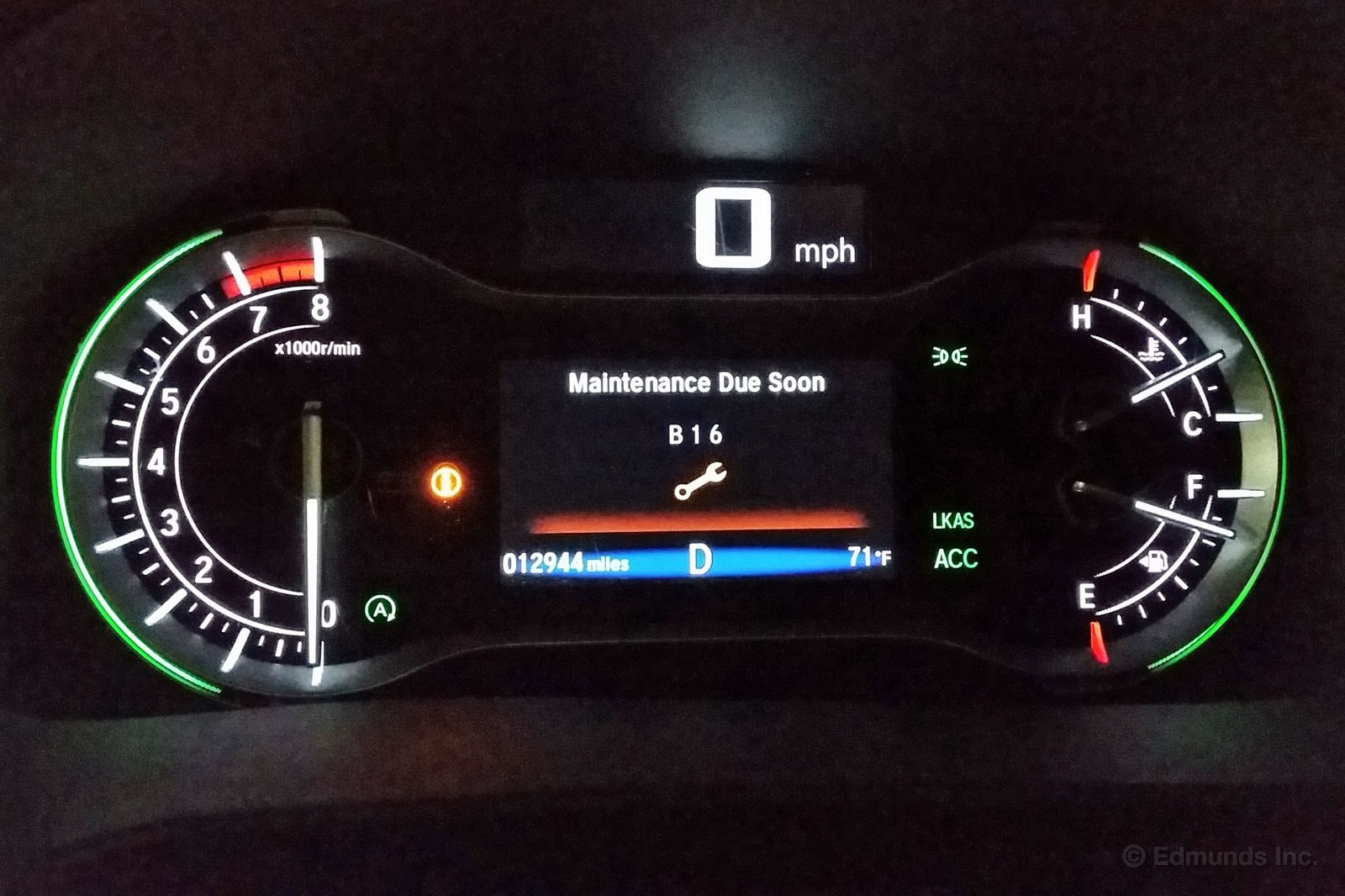
Our 2016 Honda Pilot is asking for some new fluids. Some new oil and a filter, to be exact. That's what the "B16" maintenance code flashing above means. It's a follow up to the "A1" code we saw around 7,500 miles. At this point we're nearing 13,000 miles so it seems about time for a refresh.
That same code also asks for a tire rotation and a fluid swap for the rear differential. Nothing out of the ordinary there, although I'm sure the rear diff fluid is probably just fine. As long as the dealer isn't charging too much for the whole package we'll probably have everything on the list done.
Having an oil life monitor is a real plus. Instead of merely having the oil changed at various predetermined intervals, it's actually checking the condition of the oil to determine when it needs to be changed. In this case, we went around 5,000 miles before getting the maintenance light. If we had been adhering to the old "every 3,000 miles" rule, we would be nearing our fourth oil change instead of our second.
We'll let you know the final cost after all the code has been cleared and the bill has been paid.
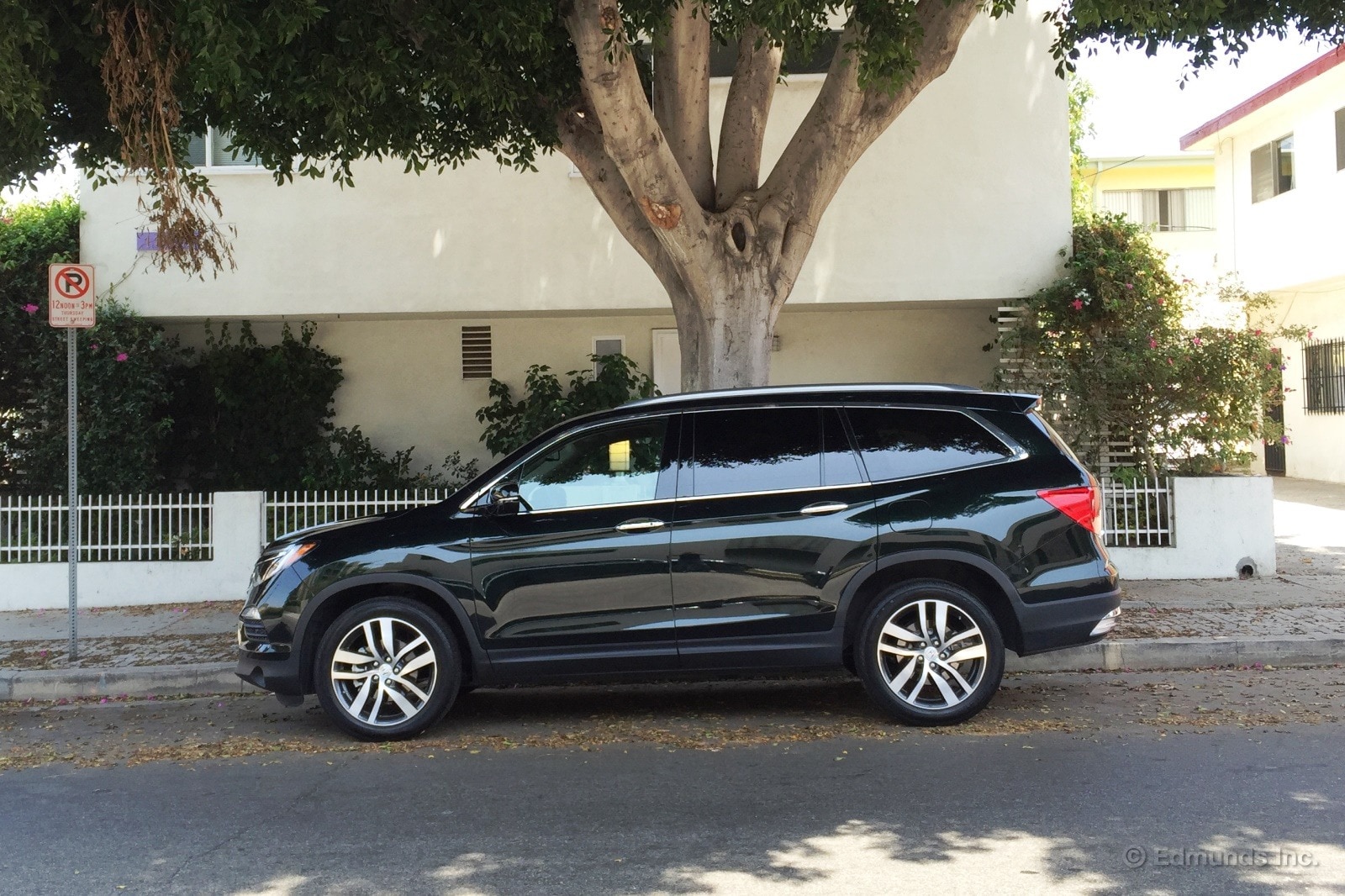
A reasonable person cannot consider our long-term 2016 Honda Pilot to be slow. In our testing it had a sub-7-second 0-60 time and traversed the quarter-mile in fewer than 15 seconds. This is plenty rapid for a three-row SUV.
And yet...
In day-to-day driving the Pilot feels more ponderous than I've come to expect of the brand. This is a byproduct of the Pilot's size, mass, somewhat numb-feeling steering, and, yes, its powertrain.
"But wait," you protest. "Didn't you just finish saying that the Pilot is rapid? And blathered on about reasonable people, which you clearly are not?" Hear me out. The Pilot's around-town demeanor has little to do with its full-throttle urge. Sure, whack the throttle to the floor and it will ultimately do good stopwatch-y things. But in the innumerable part-throttle excursions when in city driving or when in any kind of traffic, the Pilot is somewhat dull-witted in its responses.
Probably the biggest contributor to the Pilot's blunt-seeming character is down to its ZF-sourced nine-speed transmission, which I've previously derided. Don't get me started again on this gearbox, which I hope soon becomes an automotive mulligan.
Beyond its bumbling transmission, the Pilot's throttle action is too heavily damped. So much so that it noticeably affects throttle response. Give it a big throttle input and a bunch of nothing happens while the throttle and transmission confer amongst themselves. Maybe this is intentional, so as not to upset the softly sprung chassis. Beats me. All I know is this is not the alert, sharp Honda I've come to know.
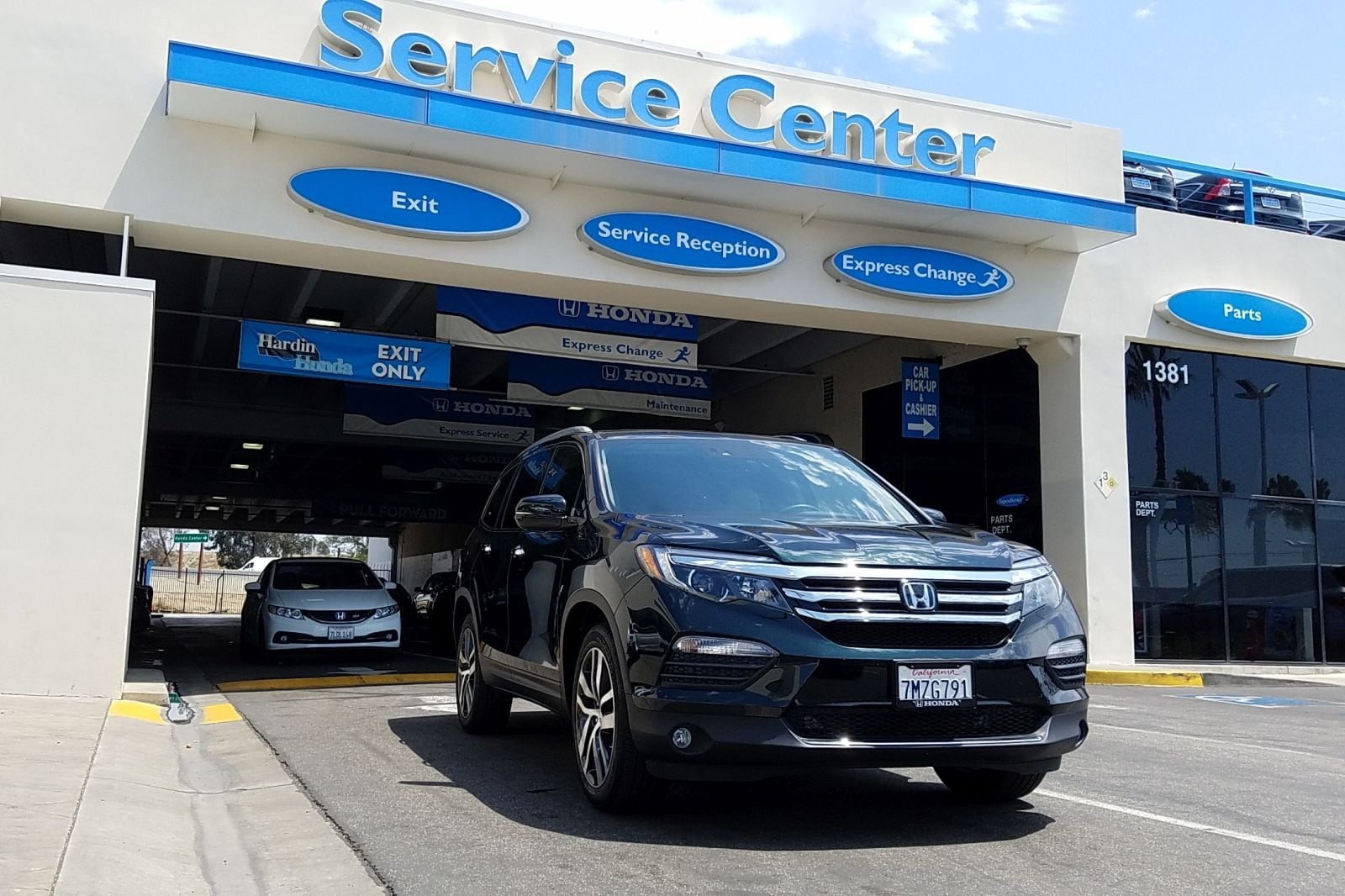
This always seems to happen to me. I get all set to take Vehicle A on my twice-annual road trip north to Oregon, only to discover it needs an oil change before I leave town. Such is the case with our 2016 Honda Pilot, which very recently started displaying a Maintenance Due Soon message along with the code for service that is due: B16.
The Pilot's oil-change interval is 7,500 miles, so this will be its second one. I wasn't quite sure of the exact mileage of the previous oil change, but the fact that there's a warning at all indicates the oil's remaining life has sunk to 10 percent or less, which is 750 miles.
My upcoming road trip will amount to more than 2,000 miles, so I had to handle it beforehand. I drove over to my local dealer, Hardin Honda, and got into the service line at 9:33 a.m.
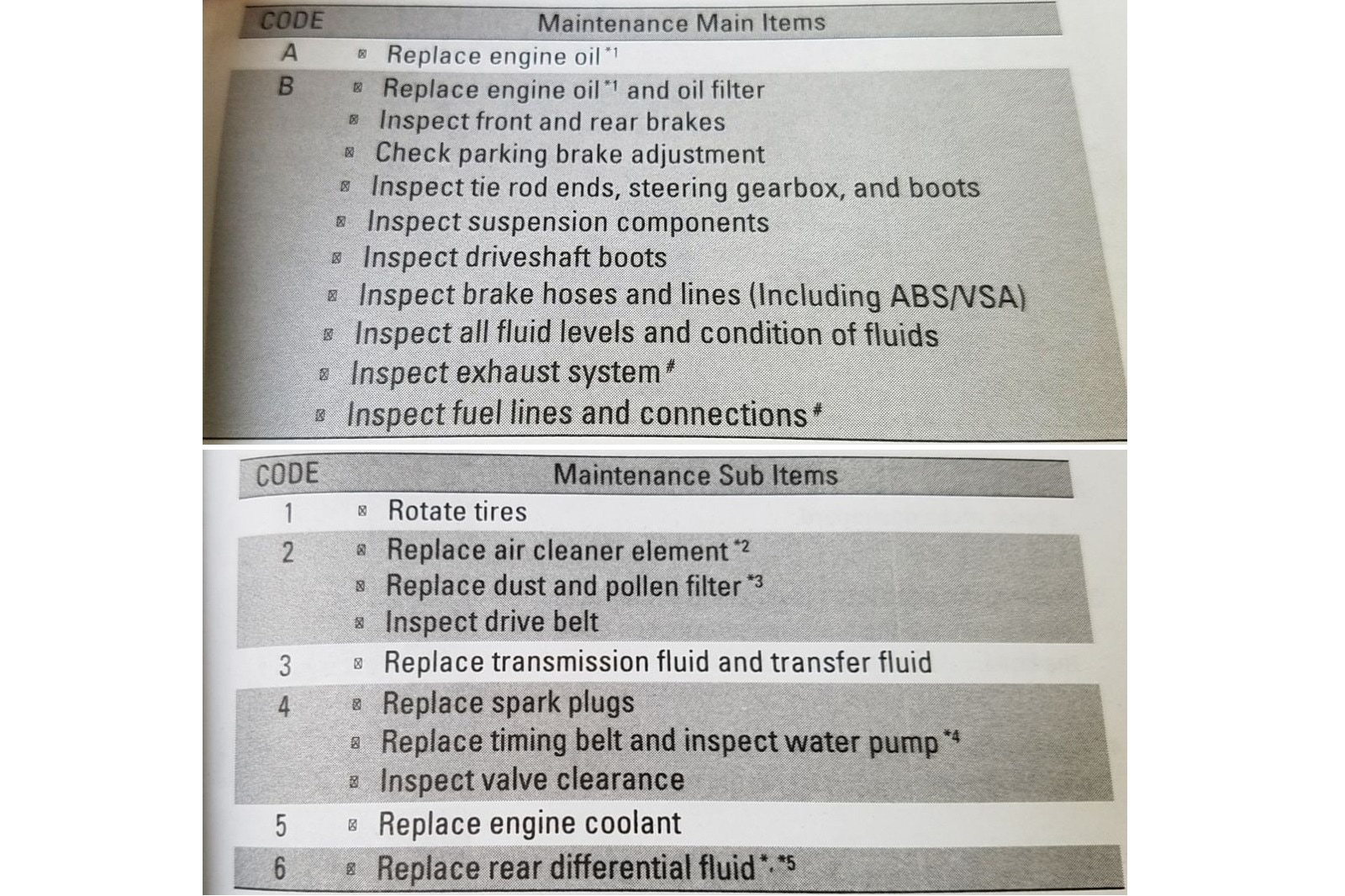
Honda's 7,500-mile oil change intervals alternate from A to B to A to B, where A represents a simple oil change and B stands for an oil and filter change accompanied by additional inspections. Personally, I would never change the oil without changing the filter, too, as the A service implies. I find that odd.
The 1 code indicates a tire rotation, which also happens every 7,500 miles. At minimum, each service will alternate between A1 and B1 until it's time to deal with systems that have longer service intervals.
Those items are represented by codes 2 through 6, the meanings of which are described on page 142 of the manual. I find this system much easier to use that the typical messy and hard-to-read charts that are more common. Here the service schedule is burned into the Pilot's memory and comes out as a series of codes as the need to deal with them approaches.
The appearance of B16 told us it was time to add on number 6, a rear differential fluid change that comes due every 15,000 miles. This is something only AWD Pilots will ever require. If ours was a front-drive Pilot this service code would have stopped at B1.
I, for one, would never skip this rear differential oil change. This is a torque vectoring AWD system that uses wet clutch plates to bias torque left to right and front to rear according to a wide range of factors, and it all happens within the rear differential. The diff oil in question is the specially brewed fluid in which it all operates, and it needs to be swapped out on a regular basis.
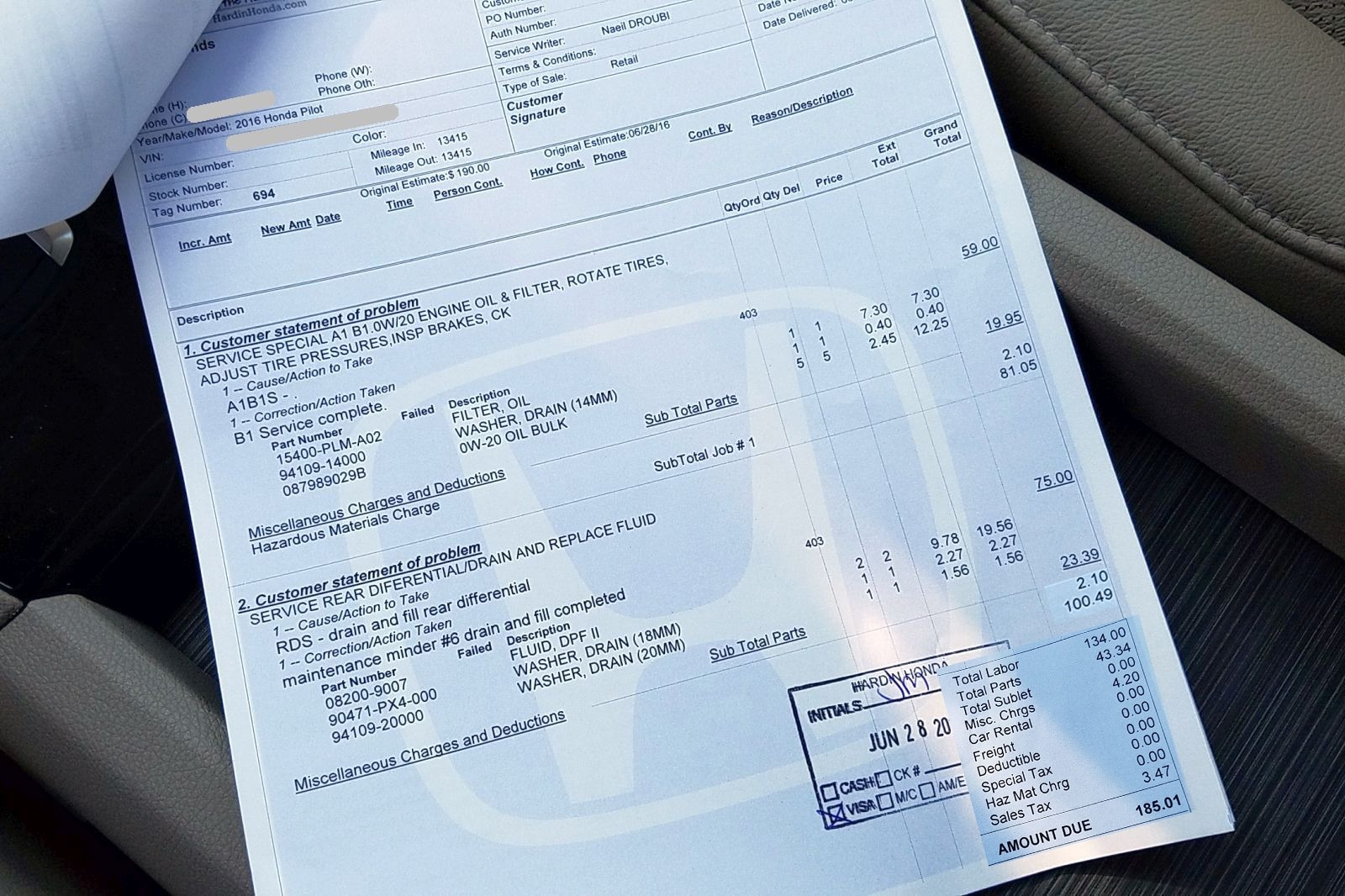
For their part, the Hardin Honda staff was courteous and friendly, there was plenty of coffee, the waiting room was spotless and it was a large enough space that I could sit quietly out of earshot of the morning-show nonsense on the TV and get some work done.
The Pilot was ready in less than the estimated two hours, and as we walked toward the cashier my advisor told me that the inspection items looked shipshape, the tires were wearing evenly and the brakes had plenty of meat left on them. The total bill was $185.01, of which $3.47 was sales tax.
That breaks down to $81.05 for the "B1" oil change, tire rotation and inspections, of which 59.00 was labor, $19.95 was parts (oil, filter, new drain plug washer) and $2.10 was an oil disposal fee. Another $100.49 went for the rear differential fluid change, of which $75.00 was labor, $23.39 was parts and $2.10 was another fluid disposal fee.
So the Pilot's maintenance is up to date for another 7,500 miles. I can head north to Oregon later this week knowing that I won't have any dashboard reminders or service items to deal with along the way.

The Fourth of July weekend is upon us, and I'm taking the opportunity to drive our 2016 Honda Pilot up to Oregon once again to see my sister-in-law in Bend and my parents on the southern coast near Gold Beach. But this is a June fuel economy update. What does a July road trip have do with anything?
Well, I left town on the afternoon of June 30th and got 344.3 miles up the road. It's what we in the industry call a "head start."
The tank of gas that got us all the way north to a hotel in Turlock, California, belongs to the June update, which is frankly the only bright spot in an otherwise inefficient month spent close to town.
How bright? I just closed out June with a new best-tank mark of 26.4 mpg, and that was the first time any of us has surpassed the Pilot's 26-mpg EPA highway rating. And it stands in stark contrast to the 12.9-mpg tank that kicked off the month four weeks ago. The polar opposite of a road trip, that tank was a result of lots of running around in town with visiting family by a staffer that lives in a particularly gridlocked part of West L.A.
I frankly don't know how he managed it, and it's no fluke because it follows on the heels of the 12.3-mpg tank that ended May. As good as my tank was, it was not enough to counteract these and other weak city tanks (14.8, 15.4) and prevent the overall average from dropping. June began at 19.5 mpg and it ended at 19.3 mpg.
But my road trip is barely underway. I have nearly 1,800 additional miles to go. I should be able to offset all of early June's city-dominated mileage by the time I get home.
Worst Fill MPG: 12.3
Best Fill MPG: 26.4 (new!)
Average Lifetime MPG: 19.3 (5.2 gallons per 100 miles)
EPA MPG Rating: 22 Combined (19 City / 26 Highway)
Best Range: 400.6 miles
Current Odometer: 13,874 miles
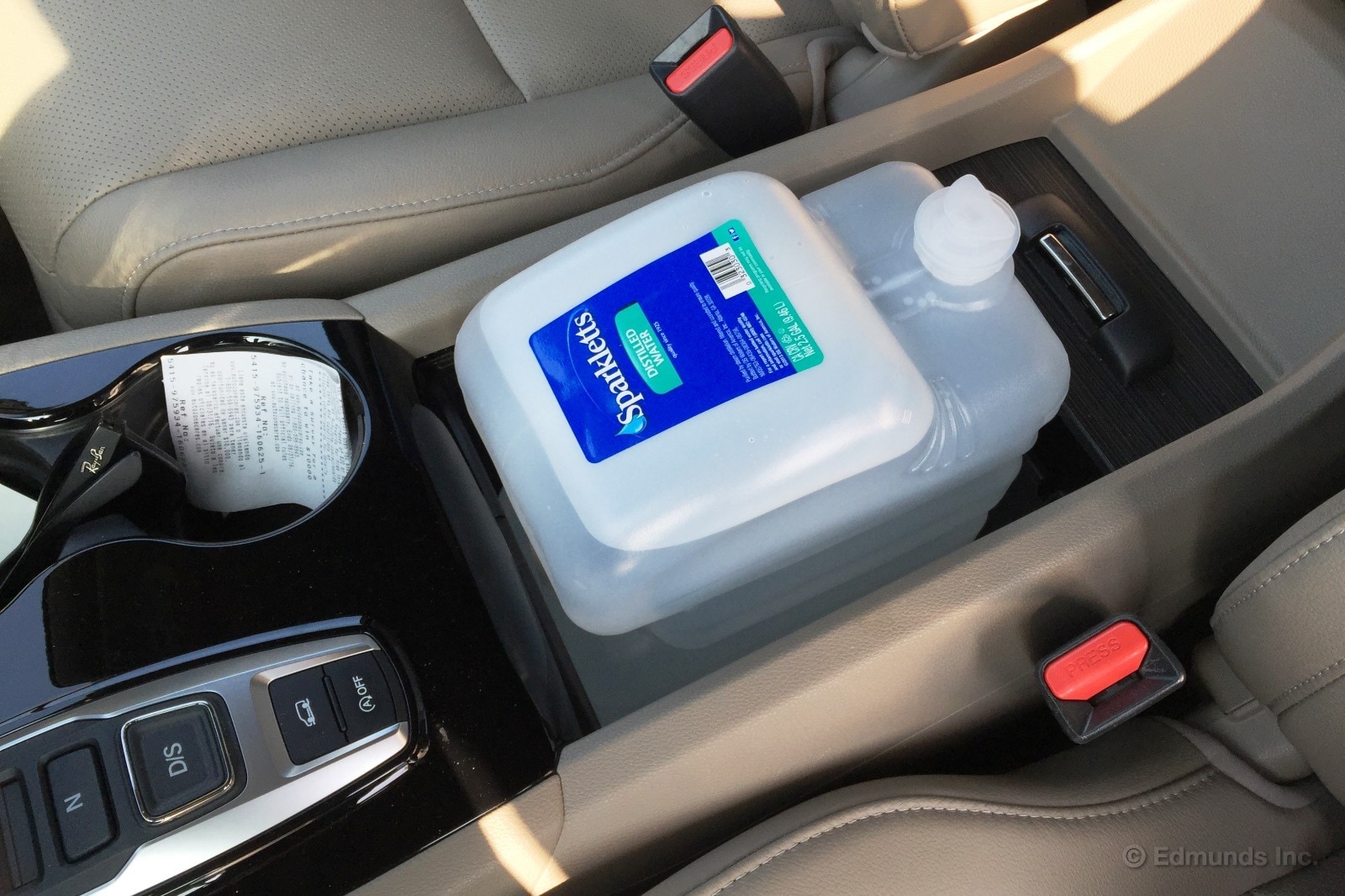
Holy schnikes, our long-term 2016 Honda Pilot has a colossal center console cargo bin.
What you see above is an entire 2.5-gallon water dispenser neatly slotted into said bin. It simply dropped right in there.
Since the photo speaks for itself, nothing more needs to be said.
Packing for an Oregon Vacation - and Bringing a Bicycle
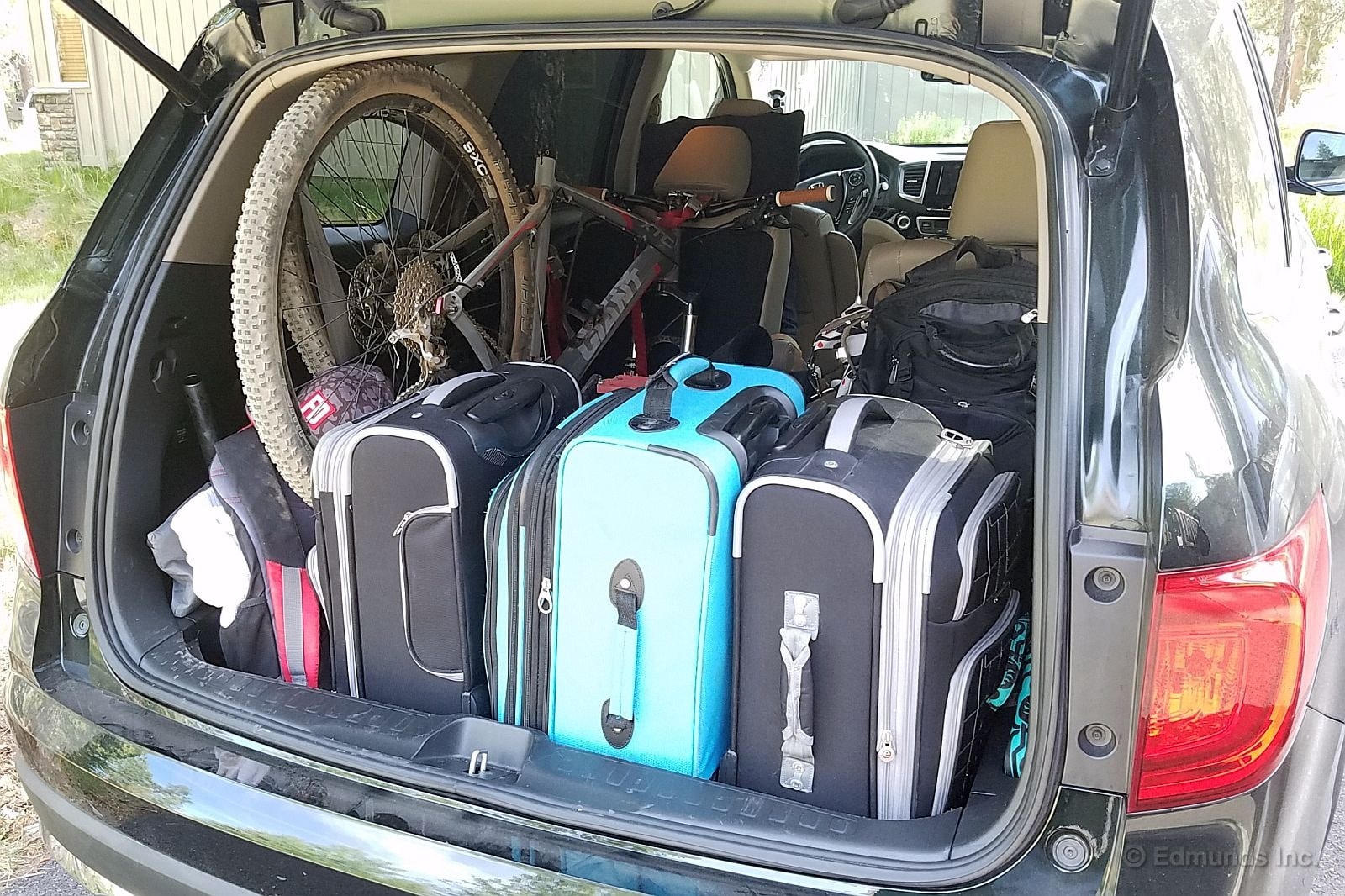
My family ventures north to the Oregon coast to see my parents twice a year. But this trip deviated from the norm in a couple of ways. Only three of us made the journey because one of my daughters had to stay back and work. And we added a side trip to Bend, Oregon, to spend a few days with my wife's sister.
Bend is pretty spectacular when it comes to mountain biking, so I really wanted to bring my bike along. But our 2016 Honda Pilot lacks a trailer hitch for my bike rack. It would have to go inside with us. I liked the idea for the security aspect, but didn't think my XL-sized Giant 29er would play nice with our baggage.
I was wrong. Because there were only three of us, I was able to find a way to fit it in standing up. It was a close-run thing, but in the end there was plenty of leftover space for our luggage.
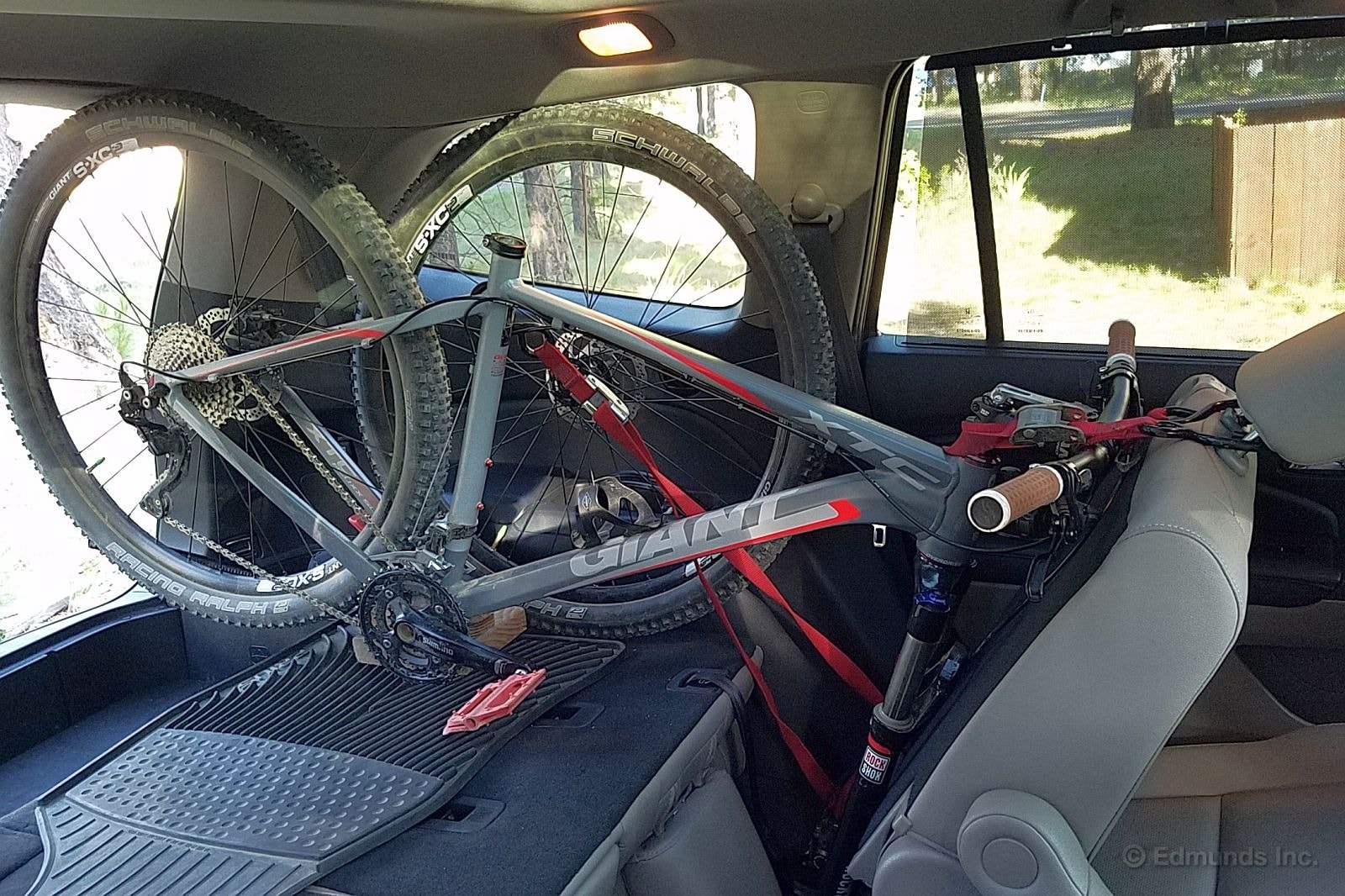
I quickly discovered that fully folding the unoccupied middle row seat was the wrong approach because it forced the bike onto its side. The key was to partially fold the middle seat and slide it fully forward to create a broad gap for the forks to poke down into.
From there it was a simple matter of tweaking the seatback angle so I could tie the handlebars in place via the headrest pins. I ran a second loose strap from the frame to the outboard LATCH child seat anchor point so the bike wouldn't fall toward my daughter in corners.
Worming the bike into that position wasn't straightforward because of roof clearance. The bike had to go in sideways before I could stand it up, and I first had to remove the bike seat.
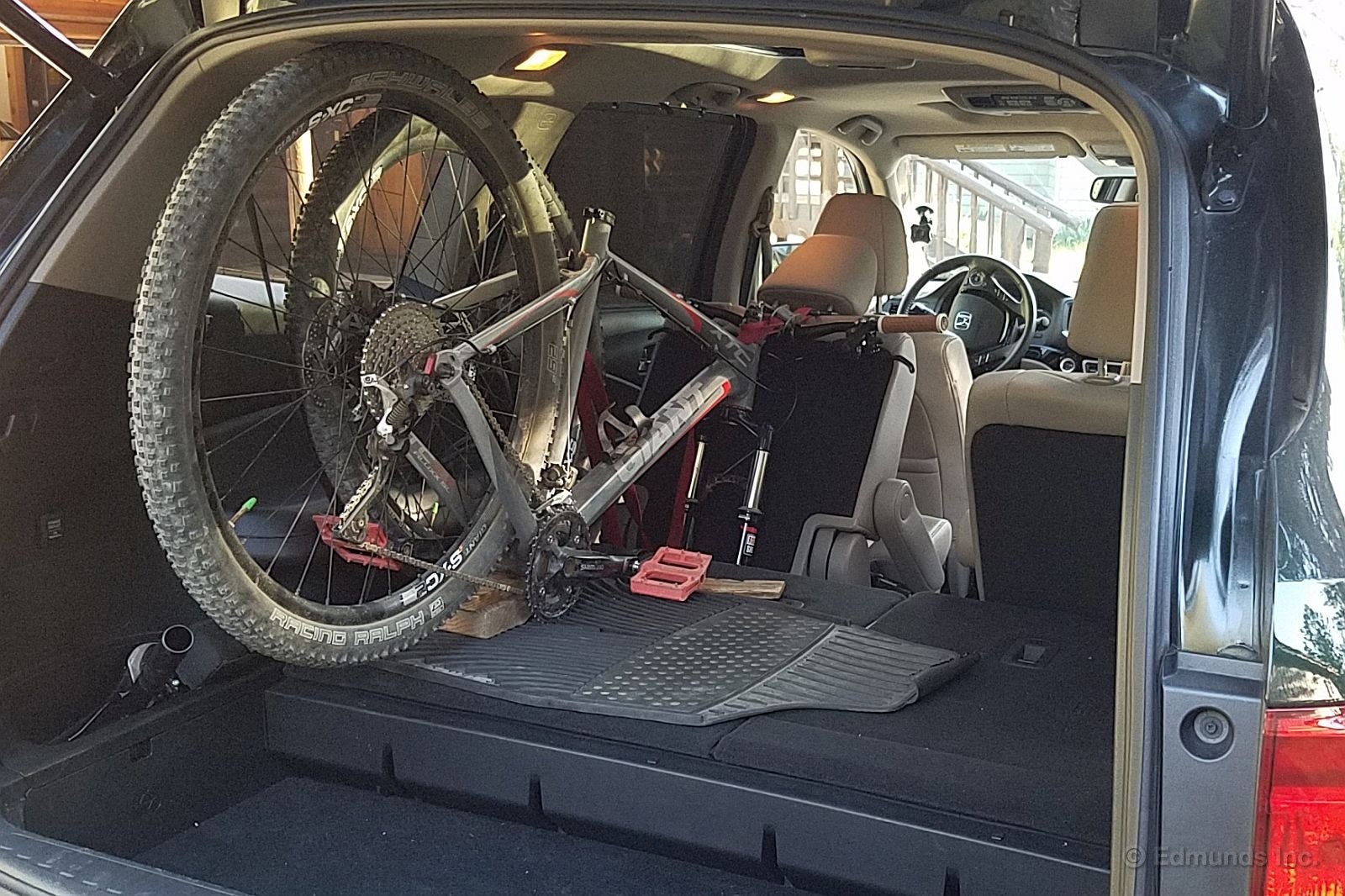
But I didn't like the look of the chainring digging into the carpet, so I slid an old rubber floor mat underneath and took the pressure off the gear by sliding a stack of wood scraps under the bottom bracket of the frame. I could only do so much of that before the rear tire bit into the roof, but the contact point was a durable plastic trim piece, not the fuzzy and easily-stained headliner.
The result was more luggage space than the three of us could possibly use. The bike was totally safe during dinner stops and overnight hotel stays, and it had zero impact on aerodynamic drag and fuel economy while underway.
And if there had been just two of us then I could have duplicated this on the other side for a second bike and had more than enough luggage room for two people down the middle.

The route from my Santa Ana home to Bend, Oregon is ridiculously uncomplicated. Drive 1.3 miles east to the Interstate 5 onramp and proceed 642 miles north to Weed, California. Exit onto Highway 97 and drive 208 miles north to Bend.
I made one modification. Highway 99 is a smoother-flowing parallel deviation through California's great Central Valley that adds but three miles. But that doesn't change the fact that this trip is a long, straight constant-speed cruise. I bet I never turned our 2016 Honda Pilot's steering wheel more than fifteen degrees off center except for those times I dipped off the freeway for food, gasoline or shuteye.
It was pretty much an exercise in lack of exercise, is what I'm saying. We mostly just sat there, listened to First Wave on Sirius/XM and watched California stream past. Trips like this are opportunities for passive evaluation. If you don't notice something, it's probably fine. Things that catch your attention are either exceptionally good or annoyingly bad.
Here's what caught mine.
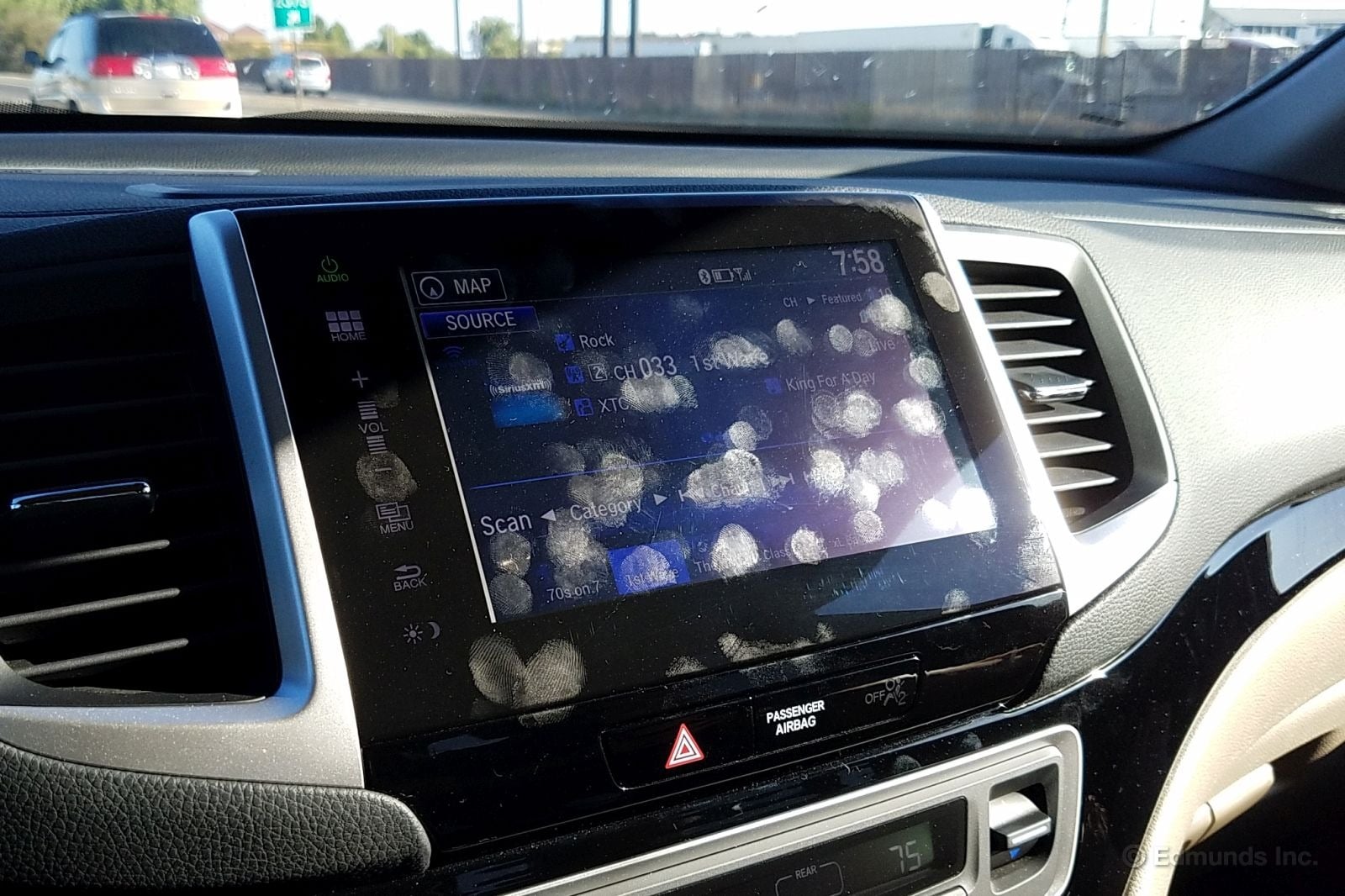
Touchscreen
The lack of volume and tuning knobs is just as irksome as ever, and it is still way too easy to mis-hit the virtual "map" and "source" buttons as the vehicle gently rocks while on the move. And just look at those nasty fingerprints!
I haven't seen the breakdown of the items that led to Honda's surprisingly poor 2016 J.D. Power IQS brand ranking, but I wouldn't be surprised if touchscreen radio complaints played a part.
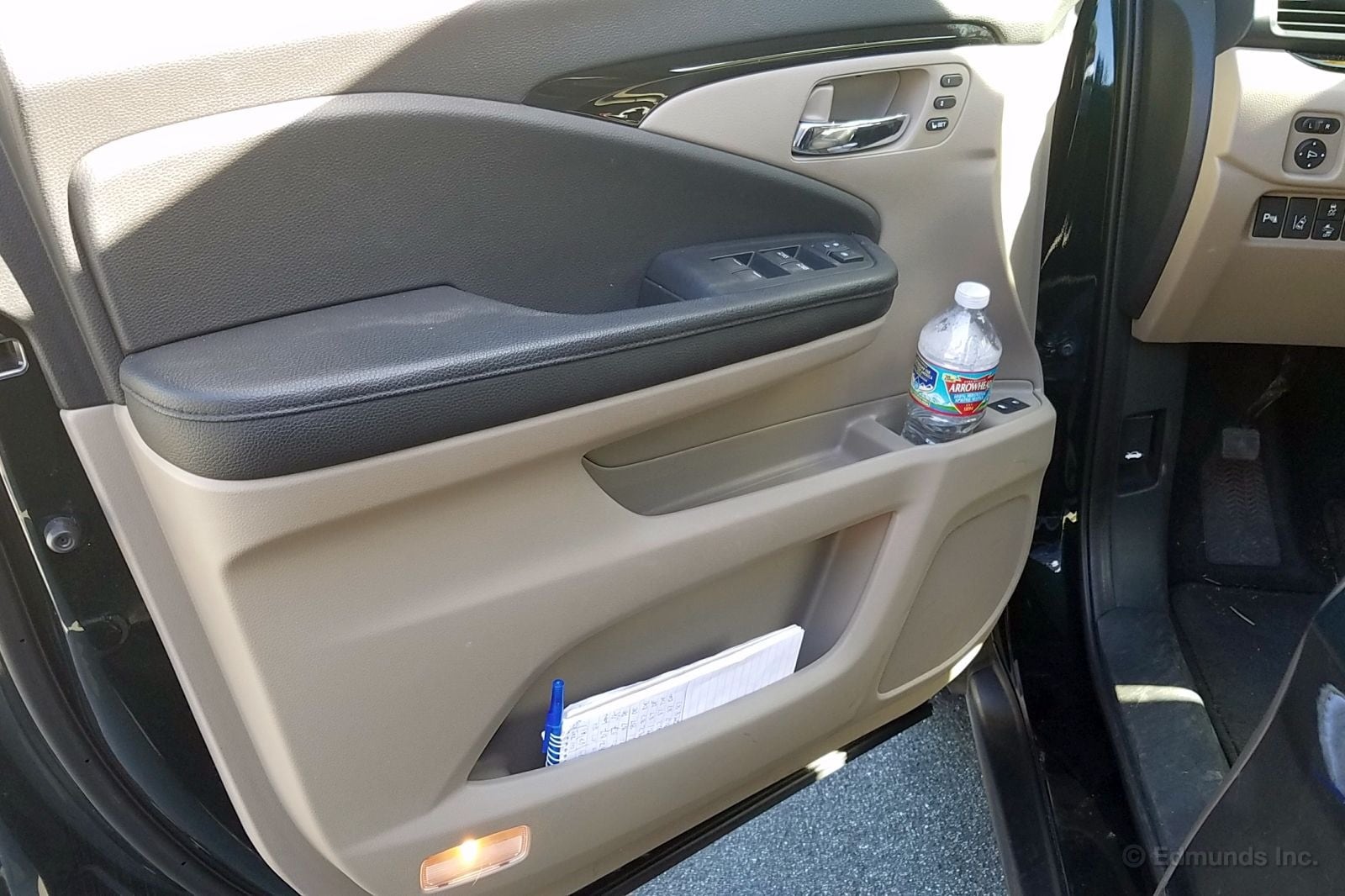
Door Pockets
These are aces. Extra kudos go to the high-mounted cupholder on the upper level, up above the speaker. Rear passengers get treated pretty well in this regard, too.
Front Seats
Broad and spacious, but the seat bottoms aren't as sumptuous as they look. They're a bit flat and hard. My butt hurt for the first 500 miles, then I either got used to it or learned to ignore it. I looked forward to our break stops.
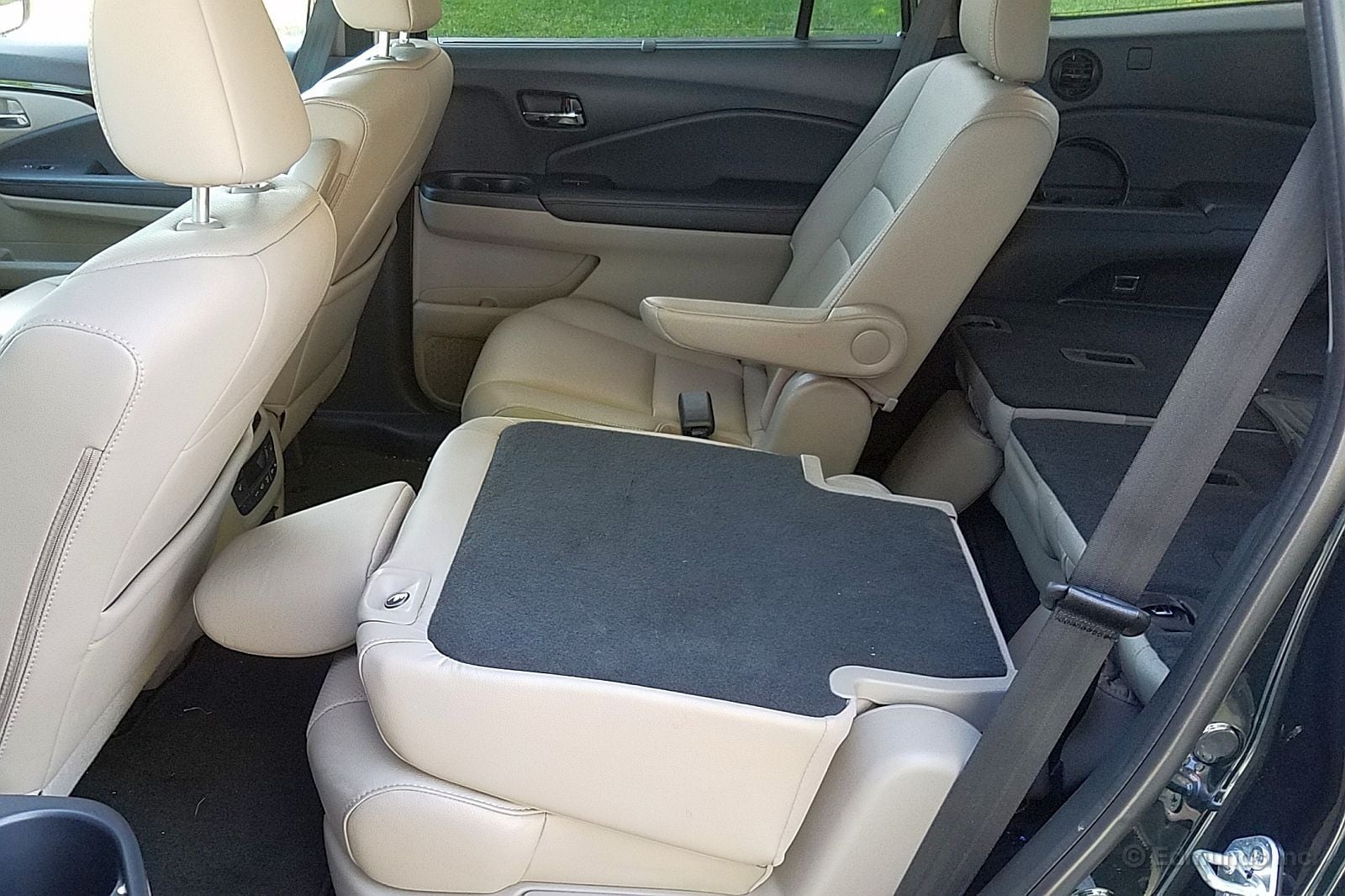
Middle Seats
The middle-row captain's chairs don't recline much at all. You're looking at the maximum setting. This is probably due to the high hinge point that enables them to fold flat on top of themselves, but that possible explanation was of little comfort (pun intended) to my daughter.
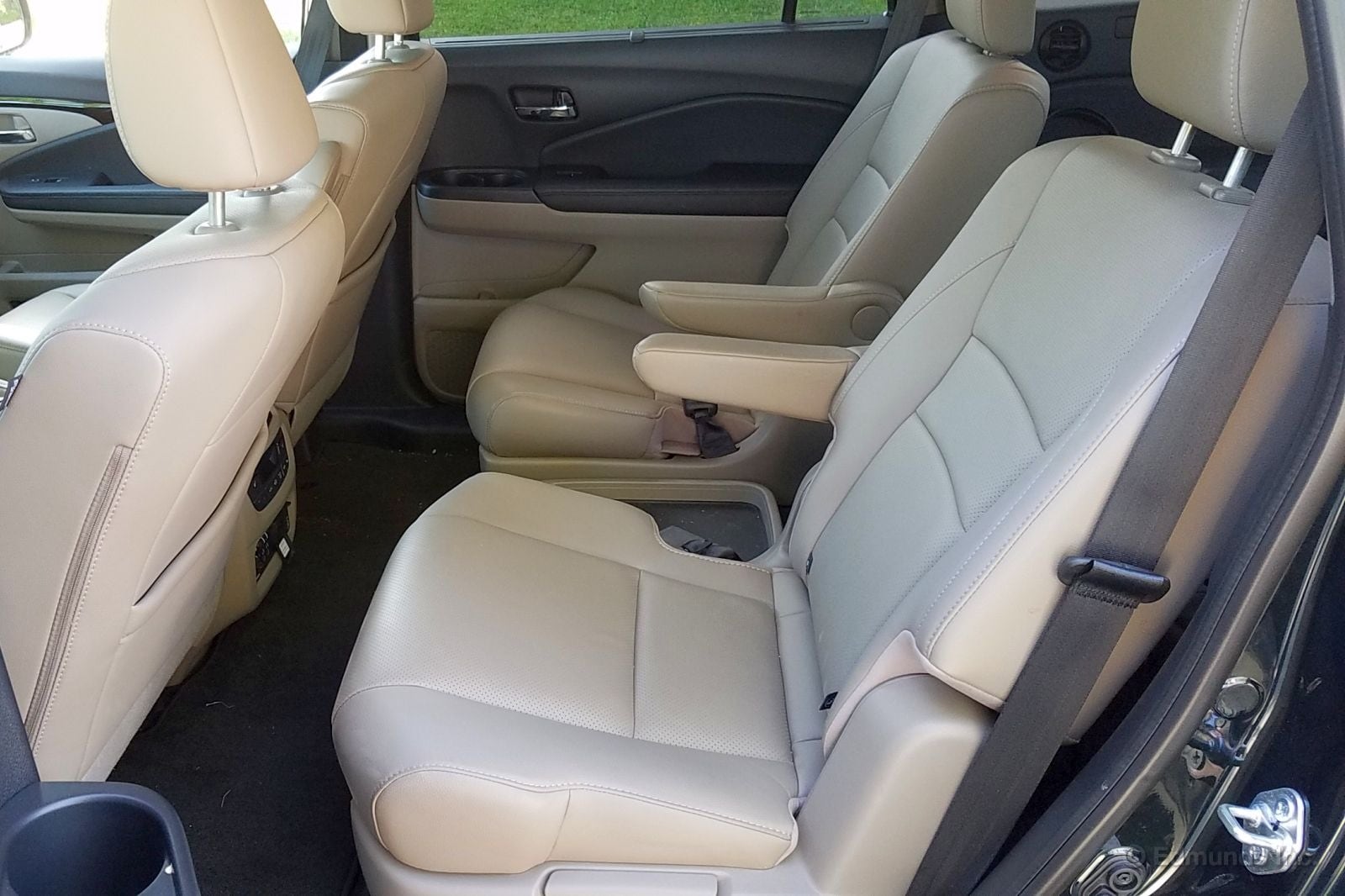
Armrests
As Ed pointed out earlier, these are an incredibly welcome feature on long straight cruising sections, which made up the bulk of this trip. I did find myself folding mine up and out of the way when maneuvering in town, but that's to be expected. Bonus points awarded for similar armrests for the front and middle-row passengers.
Ride Comfort
The Pilot copes very well with the large undulations and swales that tend to occur in the Northwest, where land movement contorts the local mountain roads and highways. Much better than I remembered from last time out, and light-years more sophisticated and resistant to rear bottoming than the Hyundai Santa Fe we used to own.
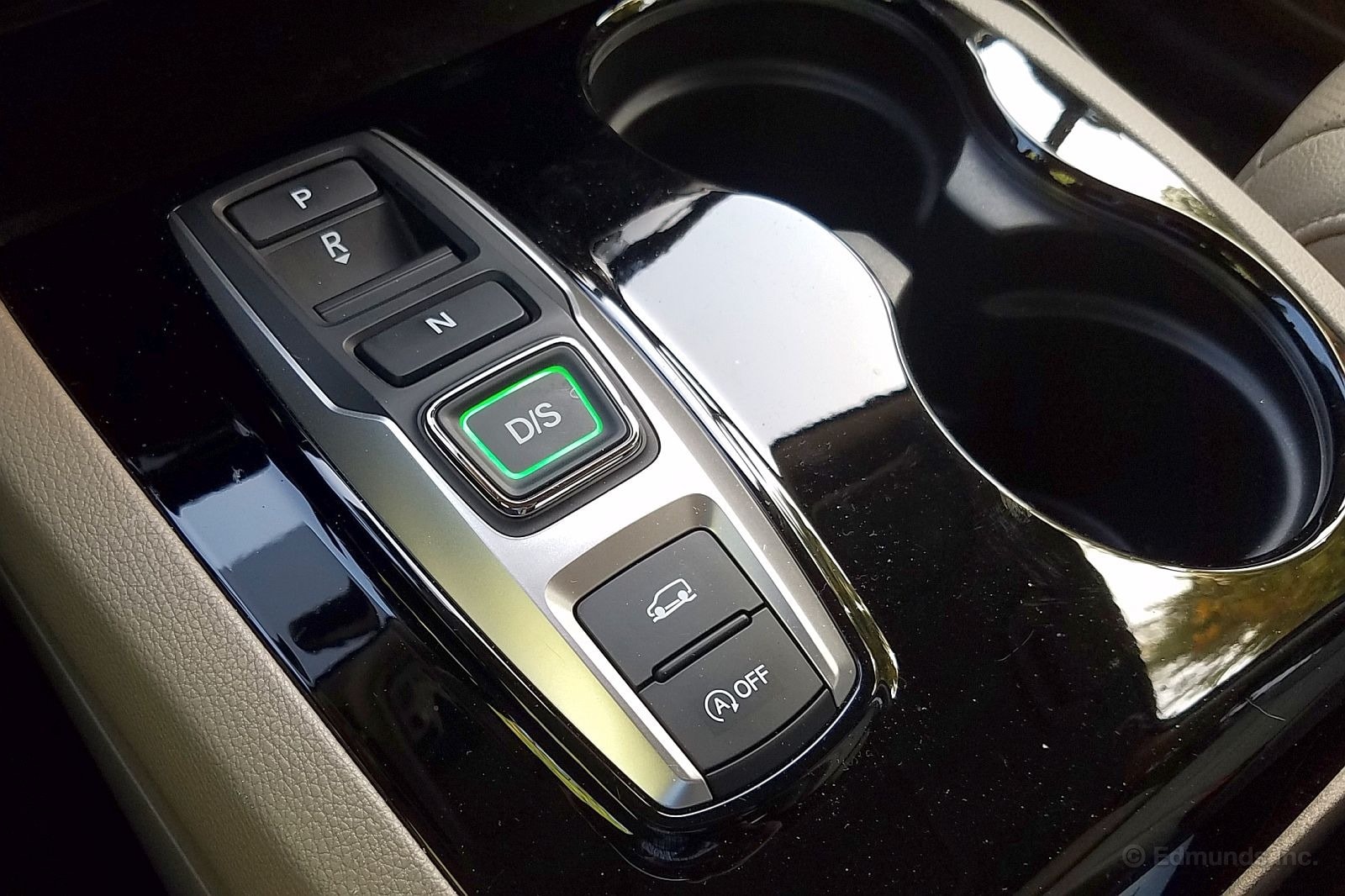
Shifter
Nope. I'm still not having it. As I've said before, I'll take the lever-action shifter that comes with the 6-speed automatic in the EX-L any day.
Cruise Control
I still can't deal with the poorly calibrated adaptive system, so I once again switched it off. But on this trip I went so far as to shut off the normal system, too, after I detected a very subtle undershoot and overshoot cycle that got on my nerves. I'm smoother than the computer, and any human is better at anticipating the road ahead.
MPG
Running in full manual mode with the cruise control off put me more in tune with the machine. I was able to improve overall MPG relative to my last run by holding the throttle in just the right spot to maintain speed and surf along the crest of ninth gear. How much better? I'm saving that tidbit for the next update.
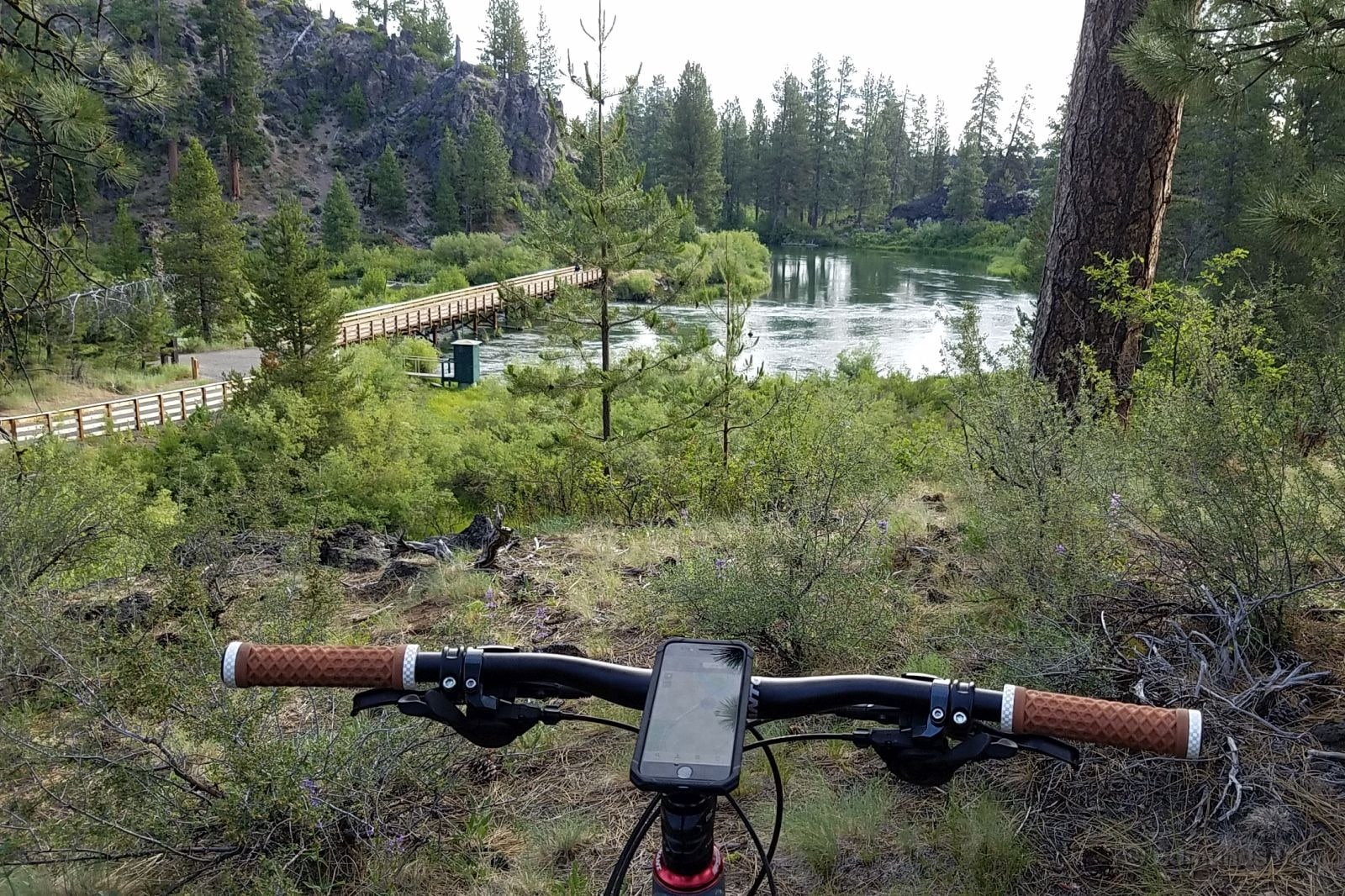
Impressive Fuel Economy on Oregon Road Trip
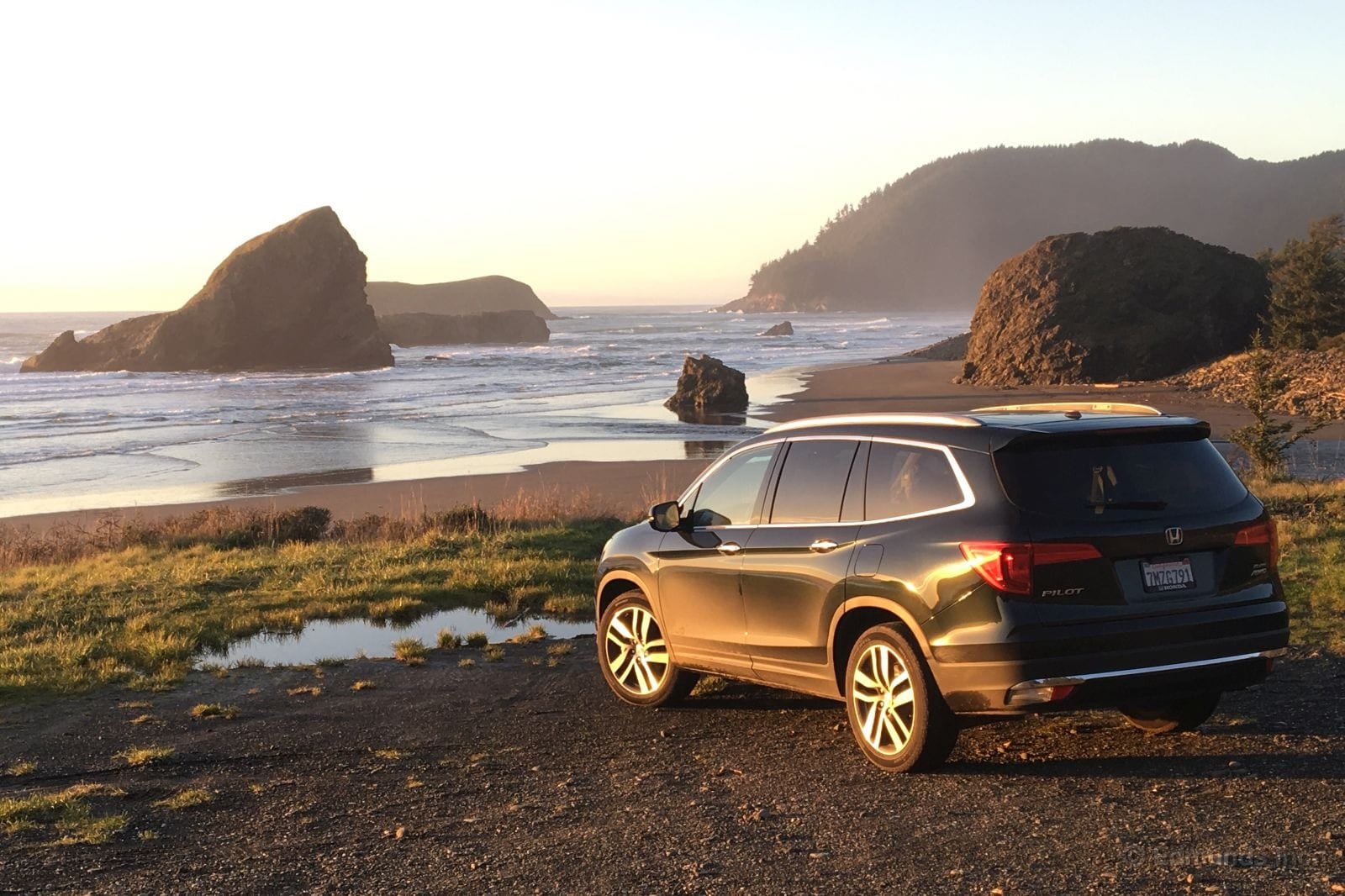
It's done. My family road trip to Oregon is in the history books. But this wasn't the first time I'd taken our 2016 Honda Pilot on this journey. We used it back in December for our 2015 holiday trip.
Back then, the Pilot was a huge disappointment at the gas pump, averaging a pitiful 21.7 mpg over 1,767 mostly highway miles. Our AWD Pilot's 26-mpg EPA highway rating seemed like a pipe dream, and I could only guess what the engineers had been smoking.
But this trip was nothing like that one — at the gas pump, at least. It was as if I had been driving an entirely different vehicle. This time the Pilot averaged 27.4 mpg over 2,151 miles of driving.
I'll save you the math. That's a difference of 5.7 mpg, which amounts to an improvement of 26 percent. Something like that deserves its own paragraph.
Twenty-six percent!
What made the difference? I can't say for sure, but here are some factors to chew on.
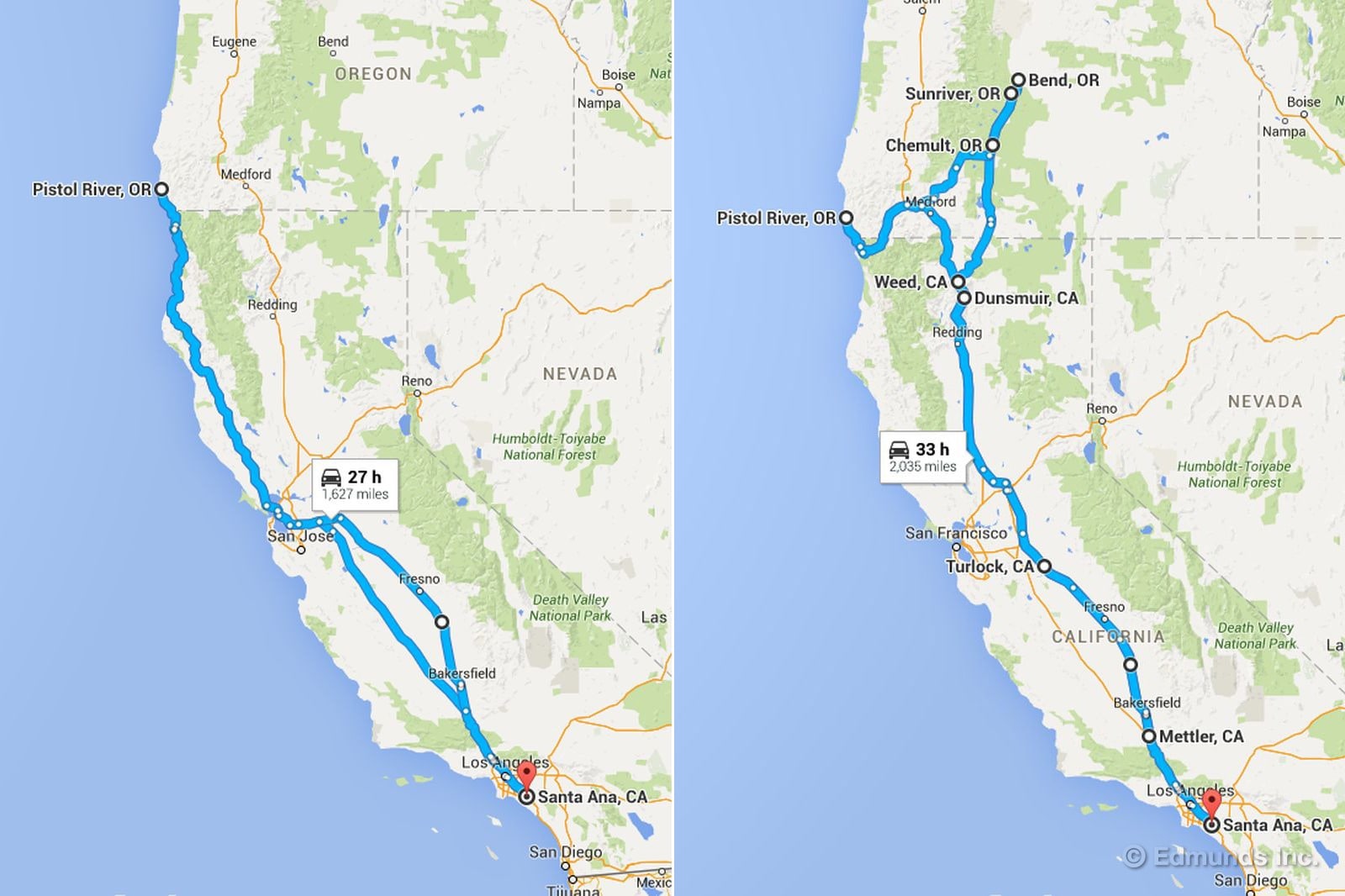
The Route
I didn't just visit my folks' place on the coast this time. We also went to Bend and stayed in a rental place in nearby Sunriver. As a result, the trip was some 385 miles longer and involved a good deal more time on Interstate 5, which has generally higher speed limits and taller mountain passes than our usual Highway 101 route. What's more, the added mileage included at least two back-and-forth commutes between Sunriver and Bend, as well as a mountain pass where we crossed the Cascades along the north edge of Crater Lake National Park.
Occupants
My youngest daughter stayed behind this time, but she's at that age where discussions of her weight are off the table. Her suitcase didn't make the trip this time, and we weren't schlepping any Christmas presents. But I did bring along my bike, riding gear and an extra backpack. I can't imagine the rig was any more than 125 pounds lighter than last time. Good for a tenth of an MPG, maybe, but not enough to make a meaningful difference.
Break-In
Last time our Pilot was fairly new, starting the trip with 3,907 miles and arriving home with 5,367 miles. This time it had another 10,000 miles under its belt. But I'm not hanging my hat here, either. Modern engines don't usually suffer from the break-in blues, and 4,000 miles doesn't strike me as all that green.
Summer Fuel
California is one of many places that require different winter and summer fuel blends, with the summer formulation tweaked to reduce the potential for photochemical smog formation. But seeing as increased ethanol content is one of the usual recipe changes, I'd have thought this would work against the prospect of improved fuel economy on a summer road trip.
Speed
There's no doubt this variable played a part, even though I wasn't exactly hauling butt back in December. This time around, I was generally more conscious of speed and smoothness. I set a target speed range of 68 to 70 mph on freeways, and I ran at that pace largely without using cruise control, which helped avert unnecessary downshifts. I didn't romp on the pedal to get up to speed, I looked ahead and anticipated what others were doing, and I timed my passes of semis and other slow-moving vehicles to avoid decelerating and re-accelerating.
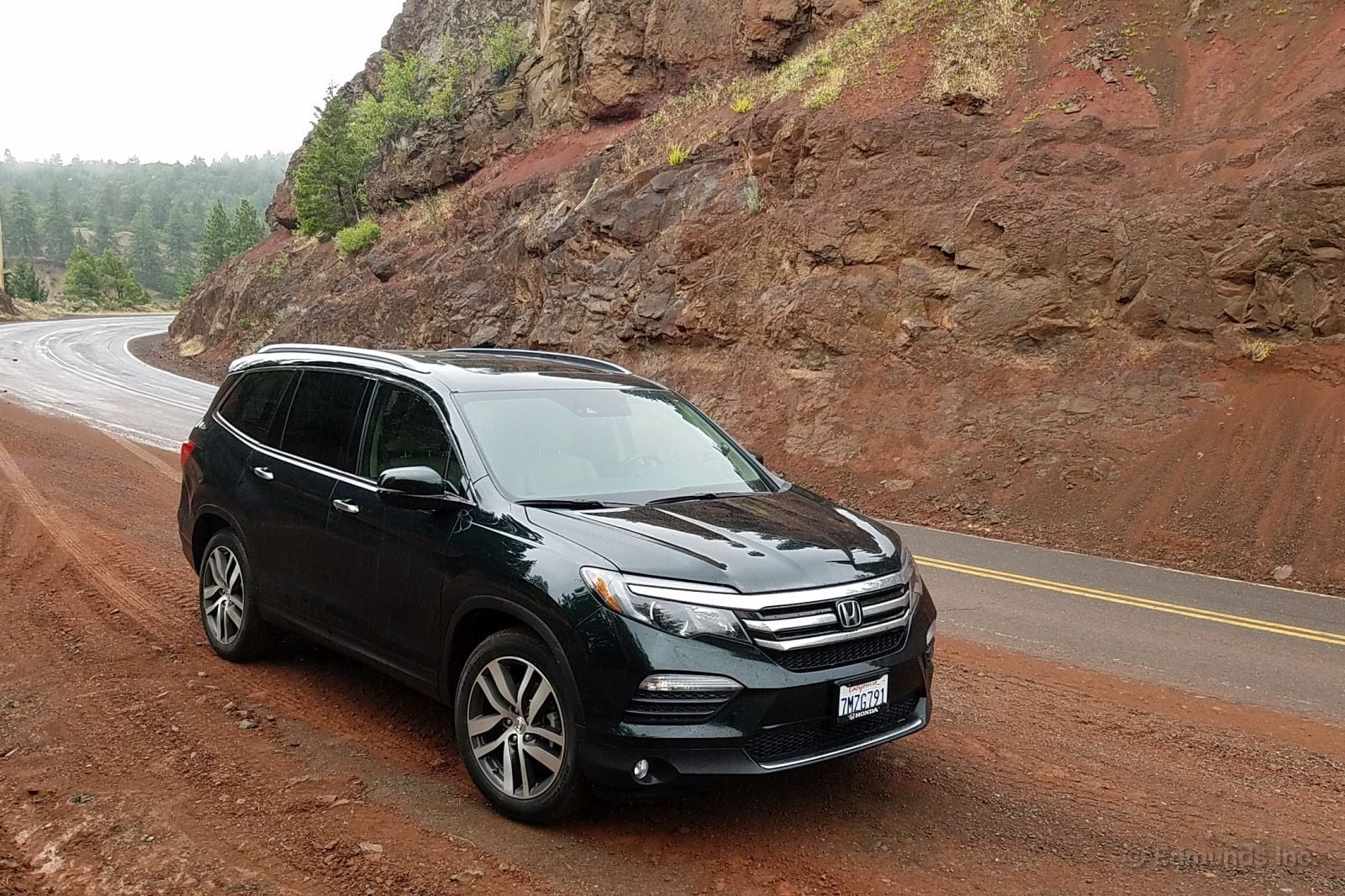
Conclusion
Speed played a role, but the preservation of speed and general smoothness loomed large, too. Still, a 26-percent gain is more than I've experienced from driving-style differences, especially when comparing to a December baseline trip that wasn't anything close to aggressive in the first place. I'm still having a hard time wrapping my head around the magnitude of the change.
I think it speaks to the sensitivity of the Pilot Touring's 9-speed transmission and its precise optimization for the EPA test cycle. Apparently I managed to get myself in sync with the pipe-smokers on this trip.
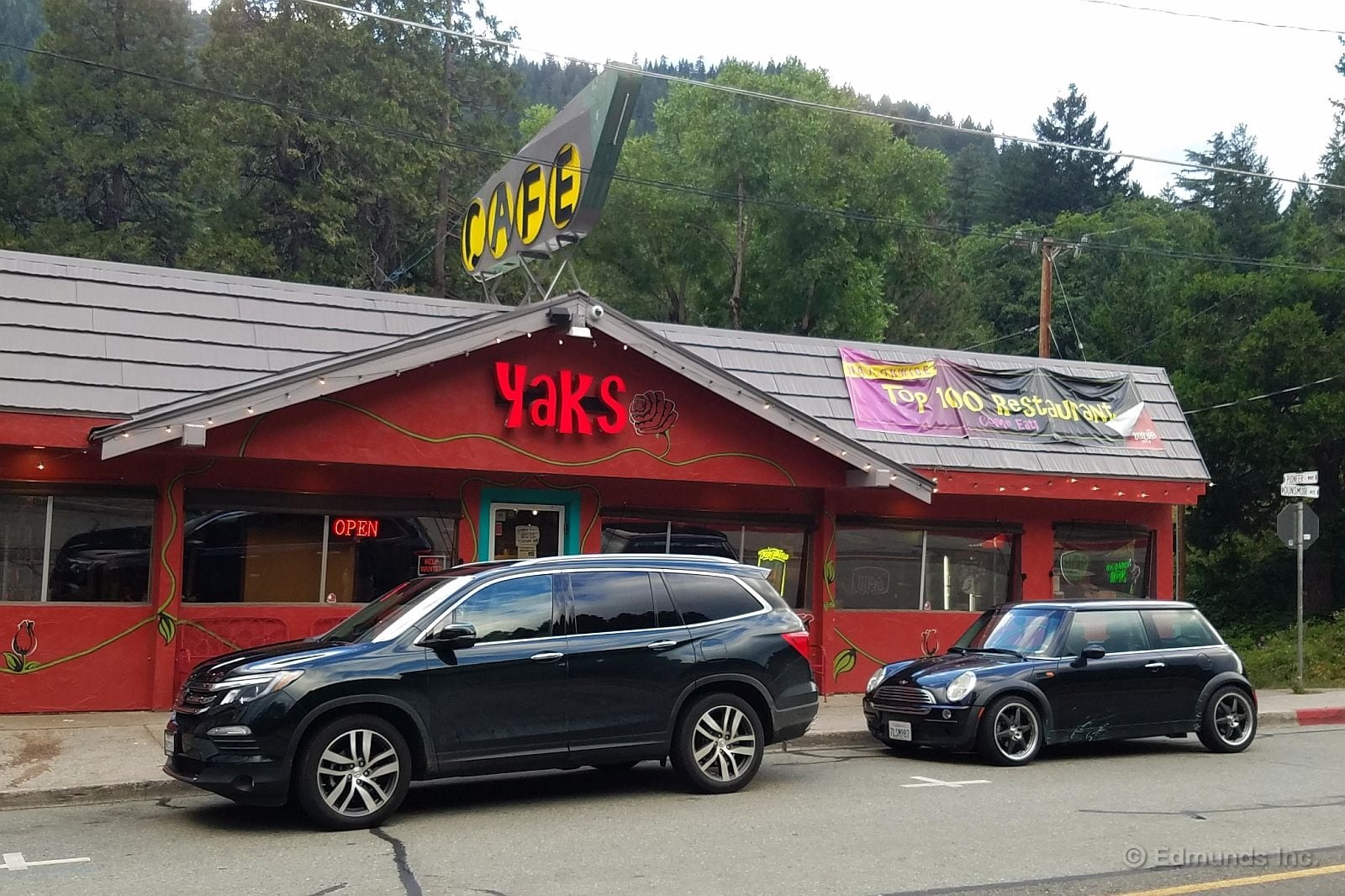
Here's how the 2,151 miles of my 27.1-mpg trip break down.
Santa Ana, CA to Turlock, CA: 344 miles, 13 feet of elevation loss, 26.4 mpg
Turlock to Weed, CA: 313 miles, 3,323 feet of elevation gain, 25.7 mpg
Weed to Chemult, OR: 386 miles, 1,339 feet of elevation gain, 27.1 mpg
Chemult to Dunsmuir, CA: 476 miles, 2,474 feet of elevation loss, 27.8 mpg
Dunsmuir to Mettler, CA: 507 miles, 1,749 feet of elevation loss, 28.8 mpg
Mettler to Santa Ana: 124 miles, 115 feet of elevation loss, 27.9 mpg
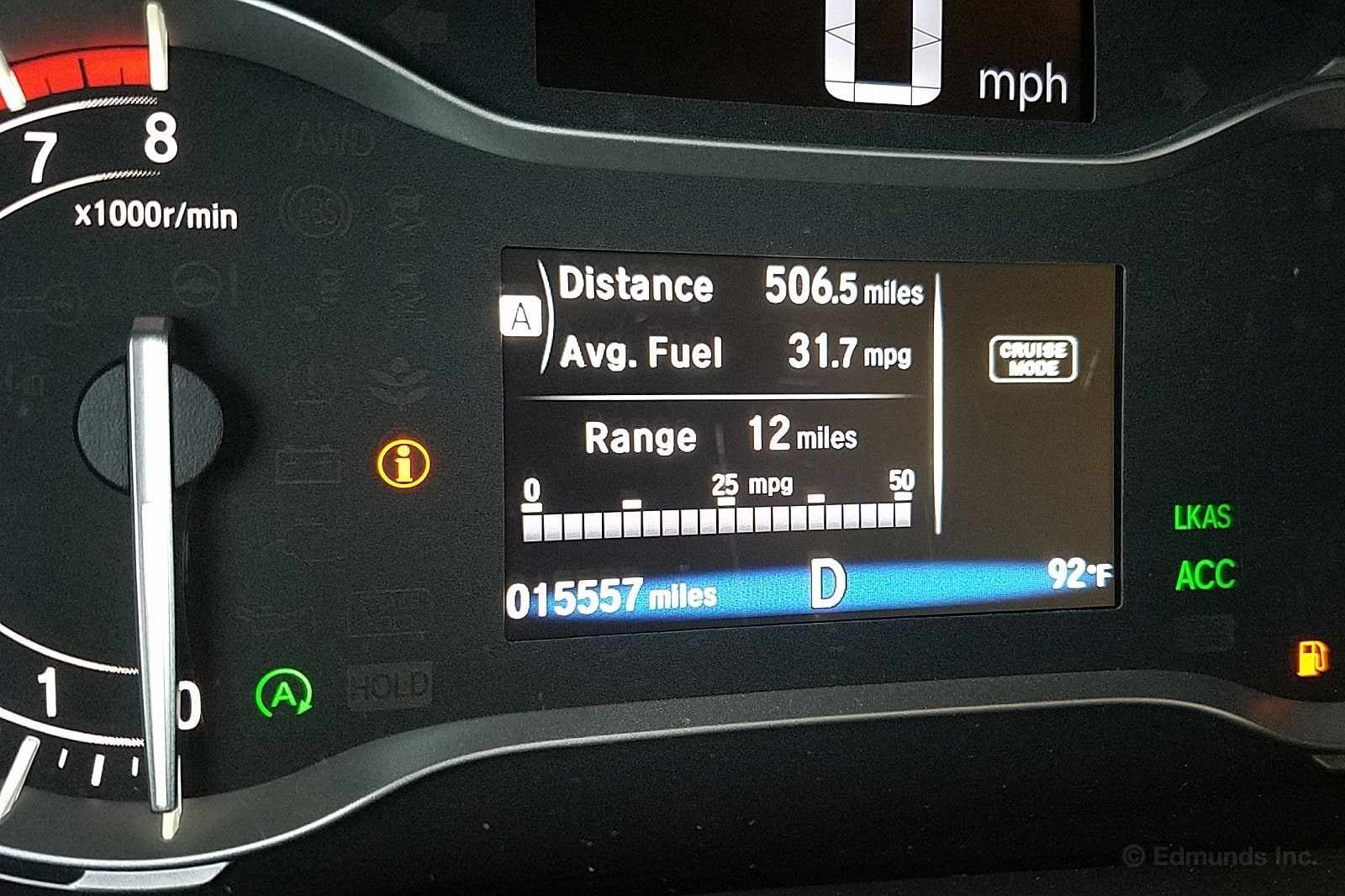
Finally, here's a shot of the trip computer after the Dunsmuir-Mettler tank. Get a load of that lying MPG meter. It read high on each and every tank, not just this one. An indicated value of 31.7 mpg versus an actual value of 28.8 mpg amounts to a 10-percent overstatement of reality. More on that topic later.
Numerous Forward Collision Warning False Alarms

The above photo is a fake. It had to be. It was made by merging a snippet of a Honda PR image with a shot of our own 2016 Honda Pilot's dash. I'm not stupid enough to venture into traffic in an attempt to trigger what Honda calls a Collision Mitigation Braking System with Integrated Forward Collision Warning (CMBS) for the sole purpose of taking a photograph.
Not that that would be a difficult task.
Some of the system's warnings are understandable in a world where play-it-safe engineering meets motorists that rarely adhere to the guidelines set forth in the DMV handbook. The computer doesn't assume that you've seen the shrinking gap and have a handle on the situation, so certain warnings come across as unnecessary, but I'm OK with that. And there's a three-position sensitivity setting — short, normal, long — that lets you attempt to match the warning sensitivity with your reaction time and driving style.
But there have been numerous absolutely false alarms in our Pilot. Three alone occurred some weeks ago on our 115.6-mile vehicle evaluation loop. All were triggered by fixed objects adjacent to, but not intruding onto, the paved roadway: a mailbox, a hedge, and a trash can out for pickup.
Things got even more "alarming" during my recent Oregon trip. The Pilot issued no fewer than a dozen false warnings during the 650-mile portion that occurred off the Interstate. That's an average of one every 54 miles.
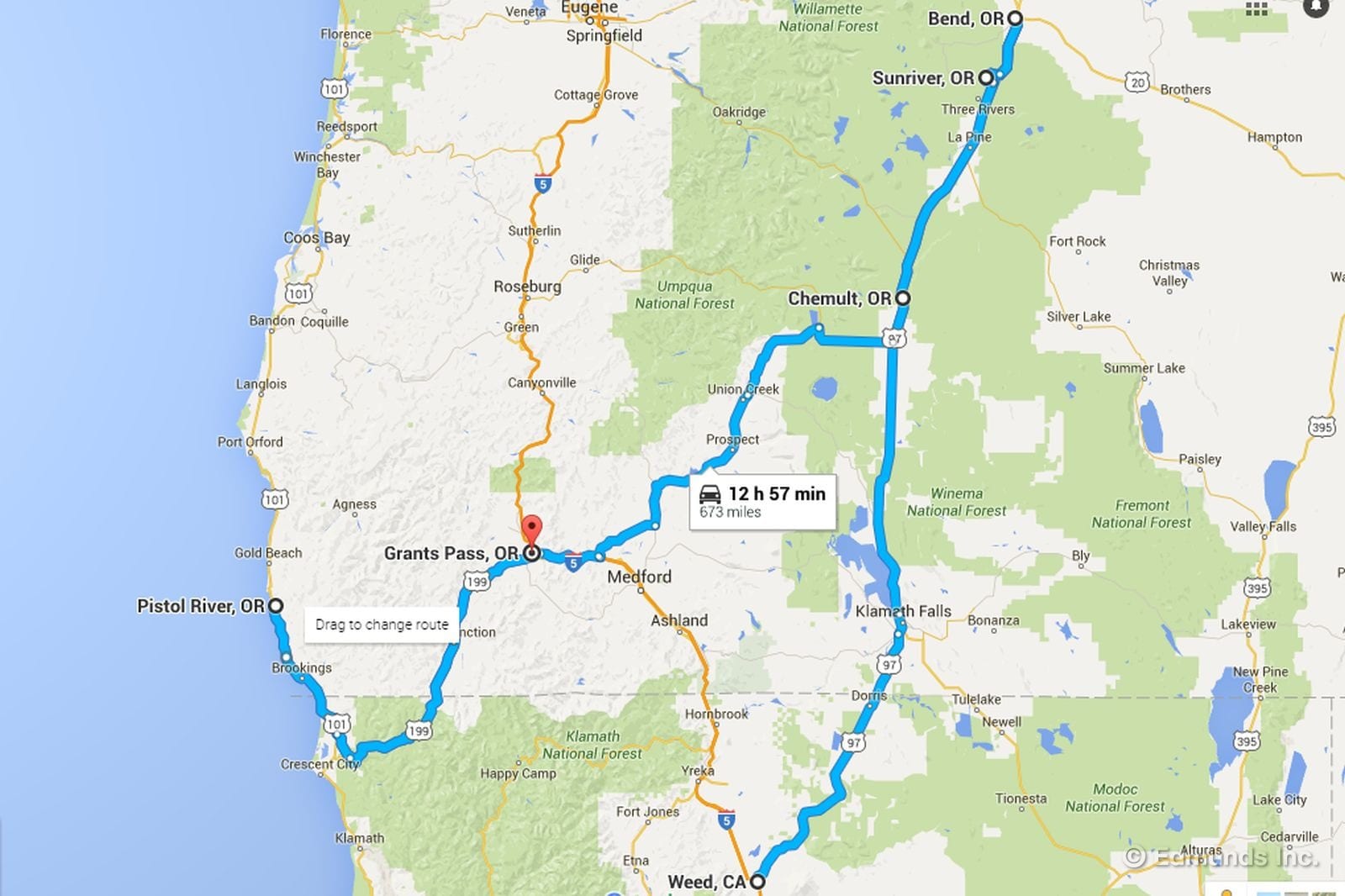
Honda says the CMBS operates in three modes. Stage 1 consists of the flashing "Brake" warning, a series of shrill beeps and a high-frequency shudder in the steering wheel. It alerts you via three of your five senses: sight, hearing and touch.
If you don't react quickly enough, or if the situation arises too suddenly, stages two and three add varying degrees of automatic emergency braking, though I can't find a definitive description of the difference. I do know that most such systems can avoid collisions in situations where the speed differential is low, but can only be counted on to reduce the severity of high-speed impacts, which is where the word mitigation comes into play.
None of the false alarms I am talking about here went beyond Stage 1.
I was most troubled by a trio of alarms that happened about ten minutes apart over an arrow-straight stretch of Highway 97 in California. I was approaching the Oregon border at about 65 mph on a sunny, cloudless day. There were no oncoming cars, no trees, no telephone poles, no road signs, no anything that could explain them. The sensors reacted to an insect, maybe? I'd hate to think the system could be fooled so easily, but that's all I've got.
Four others occurred on a meandering, two-lane section of Highway 199 that connects the California coast with Grants Pass, Oregon. These seemed to be responses to oncoming traffic, usually RVs, but one was a garden-variety pickup. None was abnormally close to the centerline, and the trajectory of the vehicles — mine included — was utterly benign. Try as I might, I could detect no discernable difference, no pattern that could explain why a few vehicles seemingly triggered a warning while dozens of other large or high-profile vehicles did not.
The remaining five alerts fell somewhere in the middle. There were no oncoming cars, but the roads were not as treeless or straight as Highway 97 had been. Two of them only reached what I'd called Stage 0.5, with the blinking light and nothing else. I can't begin to say what caused any of them, but I can tell you this: none of them represented impending doom.
There is an off button, of course. I'd have used it, too, if I hadn't decided to start keeping track. I'd hate to think such a button is necessary, but its mere existence is an admission on the part of Honda that some folks are bound to tire of the false alarms and wish to turn it off.
Count me in that group. Based on my experience, I might consider leaving CMBS on when plying the freeways and multi-lane highways, but I'm pretty sure I'll routinely turn it off the next time I venture onto two-lane roads.
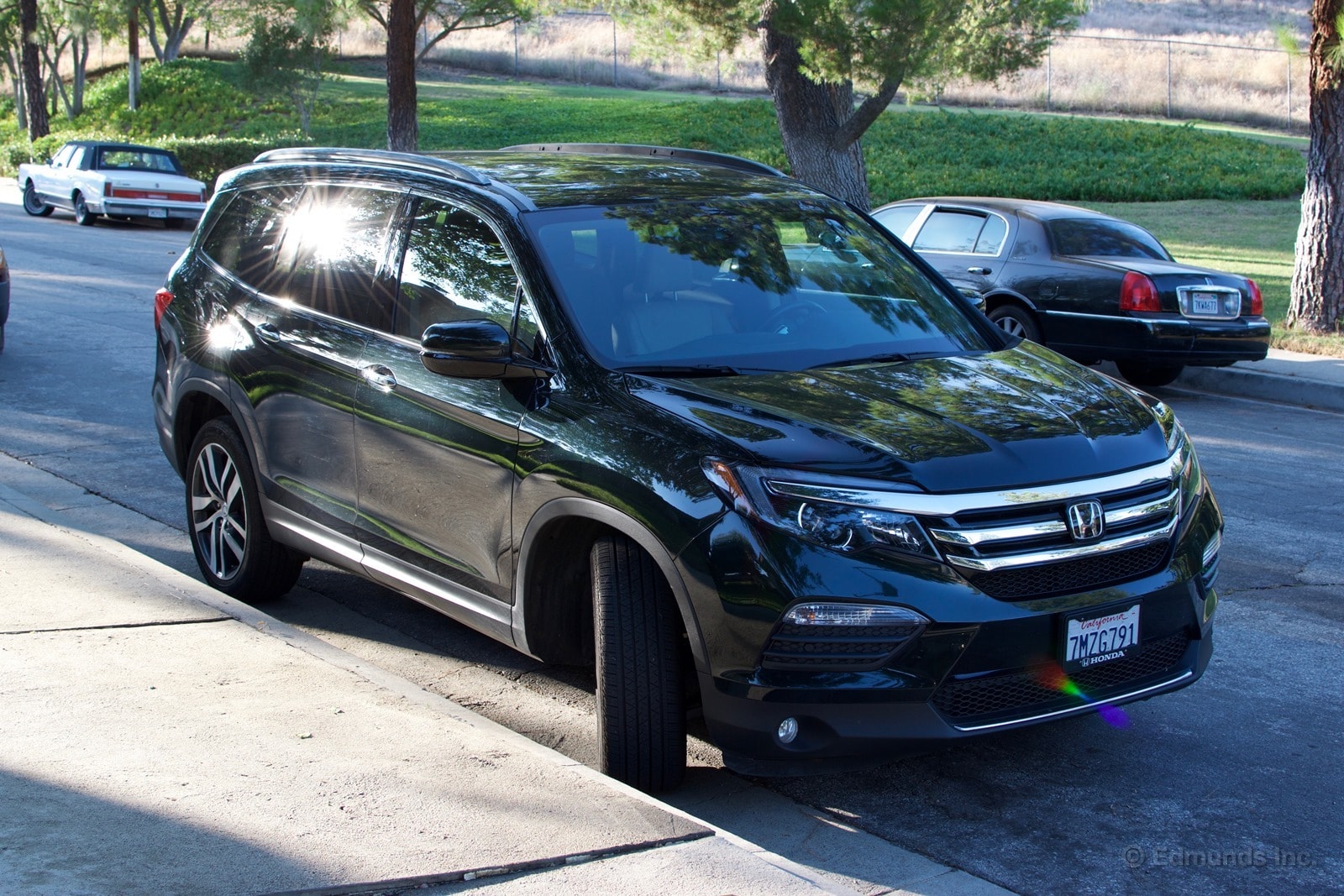
Our long-term 2016 Honda Pilot has a Jekyll and Hyde thing going on with its fuel economy. If you take it on the open road like Dan Edmunds did, it can generate some pretty solid MPG numbers (although that's not what happened the time before). But back in the city, we've seen numbers in the low to mid teens, well below the EPA city estimate of 19 mpg.
Fortunately for the Pilot's stats, July was dominated by Dan's surprisingly fuel-efficient Oregon trip.
We had to check the numbers twice. Yes, the Pilot really averaged 25.6 mpg for the month, besting its previous record by a whopping 3 mpg. Along the way, Dan set single-tank records of 28.8 mpg and 506.5 miles. It shows you what the Pilot's capable of when you dial in the right driving technique. Let's see if we can keep that momentum going.
Worst Fill MPG: 12.3
Best Fill MPG: 28.8
Average Lifetime MPG: 20.2
EPA MPG Rating: 22 Combined (19 City/26 Highway)
Best Range: 506.5 miles
Current Odometer: 17,494
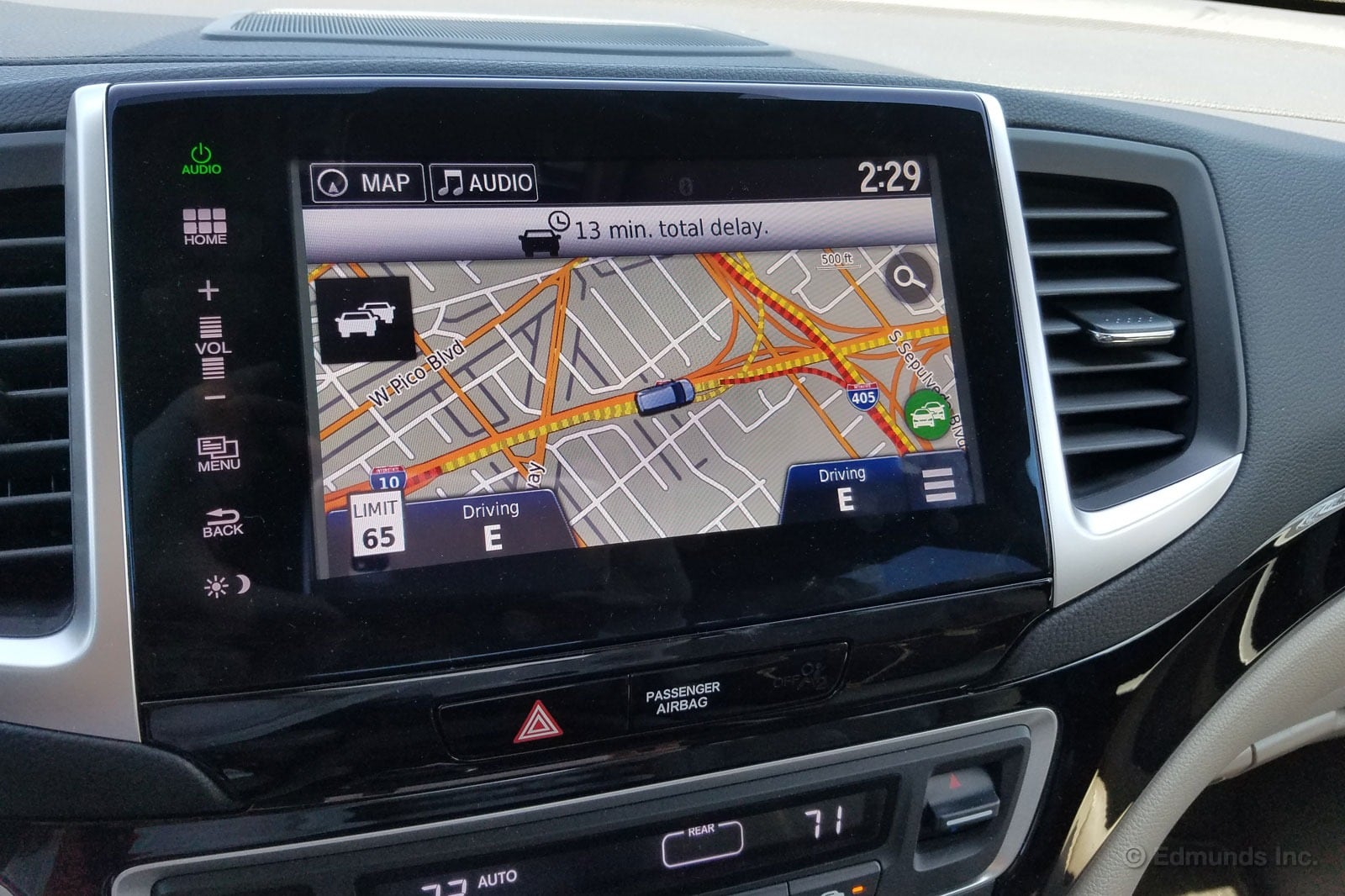
I'm a big fan of the easy-to-read graphics in our 2016 Honda Pilot's navigation system. But I find it humorous that Honda offers the compass direction on both sides of the nav screen.
Here, I was clearly headed east, as was my passenger. I hope we continue in a unified direction.
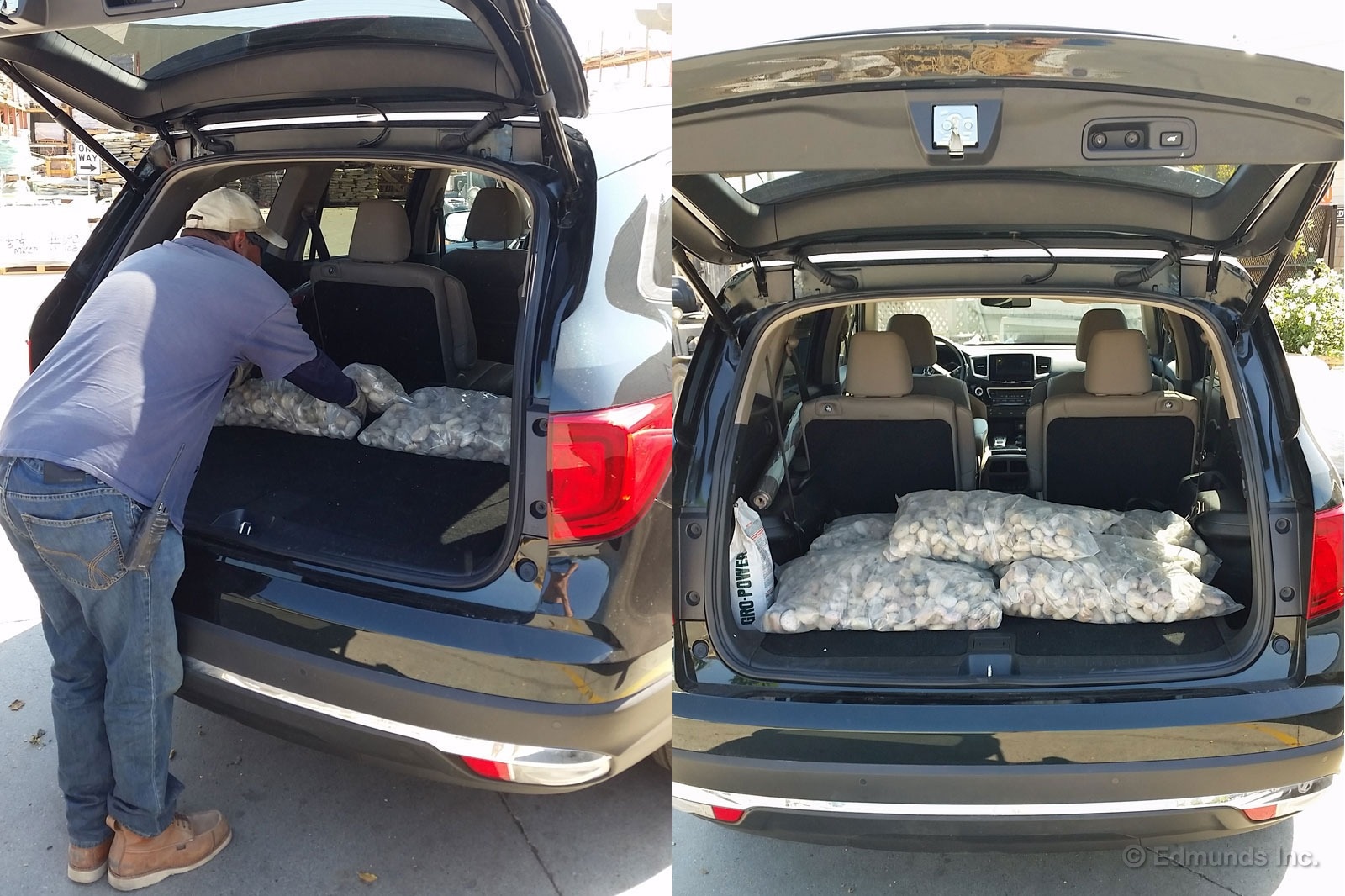
Crossovers like our 2016 Honda Pilot are meant for hauling families, not rocks. Yet when it came time to pick up several bags of landscaping stones the other weekend, the Pilot got the job anyway. So, did it even notice the extra weight in back?
Not really.
The rocks added a total of 475 pounds in the cargo area. Throw in two adults and a 16-year-old girl and the Pilot was definitely weighed down a little more than usual. It was a little slower off the line, but after that it gained speed without much trouble. Shifts from the nine-speed automatic were unaffected, and the brakes had little trouble bringing it to a stop.
If anything, it actually felt a little smoother over certain kinds of pavement. That's often the case with a vehicle that's designed to hold multiple passengers and their cargo. Overall, I would say the Pilot felt like it would handle a fully loaded cabin quite well, whether it was passengers, cargo or a combination of both. Mileage would certainly suffer, but the ride quality, handling and stopping ability seem fully up to the task.
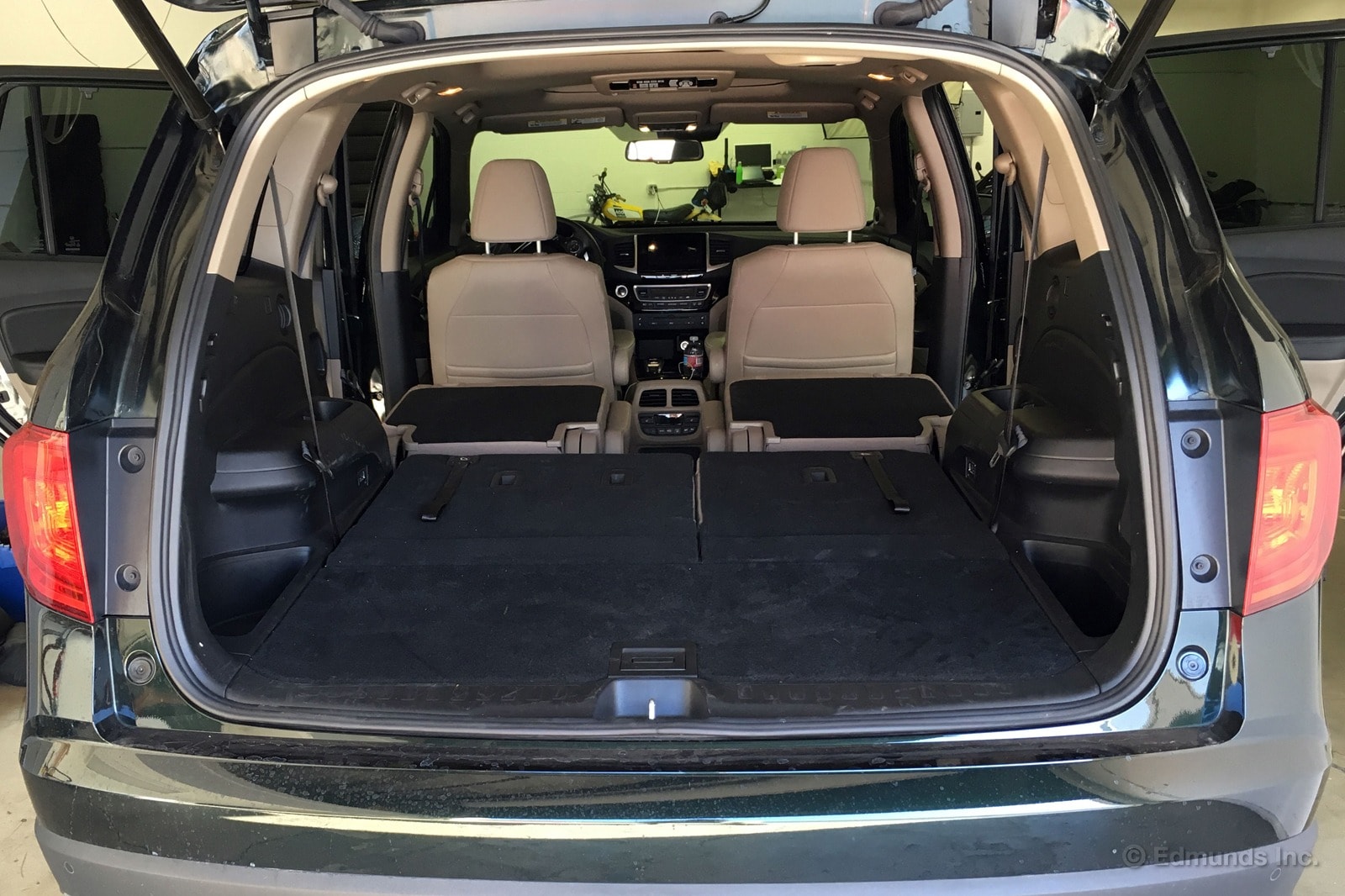
Will the luggage fit? To answer this question, we loaded our 2016 Honda Pilot with suitcases in different configurations and took photos. For the sake of standardization, we use the same blue carry-on suitcases (21 x15x10 inches) and red checked suitcases (30x20x13 inches) every time we conduct this test.
Let's see how the Pilot fared.
Access to the cargo area
The Pilot's large, boxy design maximizes access to the cargo area. A load-floor height of 33 inches is a tad higher than some competitors but still manageable. You will need to reach 73 inches for the grab handle when the hatch is fully open, which is about the norm in this segment. The floor is 46 inches wide at the wheel wells.
The versatility of its seat configurations is what adds the most value.
Behind the 1st row
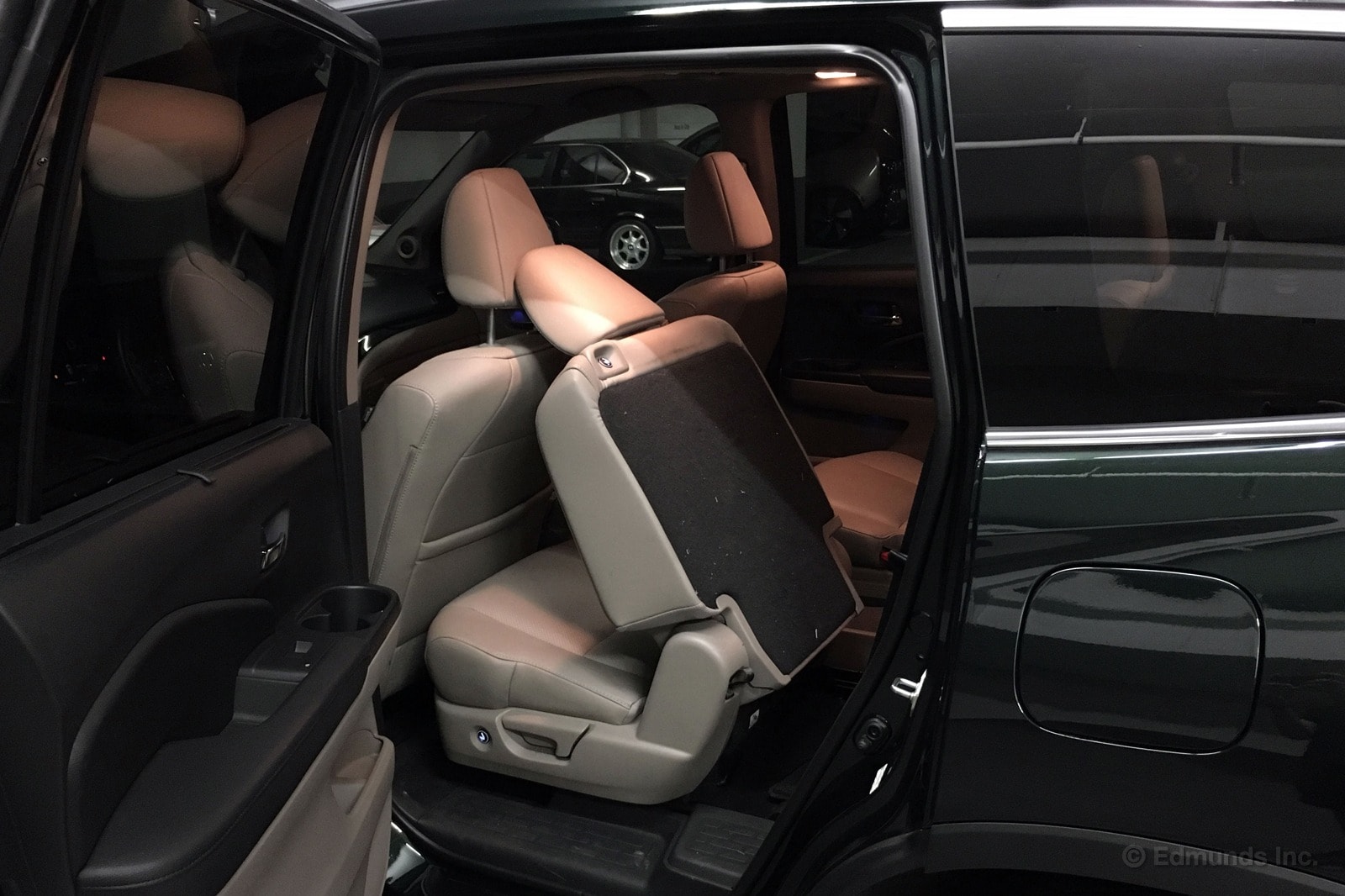
The second-row captain's chairs fold forward or flat depending upon your cargo needs. In either case, the nooks created between the seats and on either side of the headrests add a degree of protection for small or delicate items.

With all seats folded flat, the cargo capacity of the Pilot is 109.2 cubic feet. The load floor is 78 inches long from the front seatbacks to the rear door.
Behind the 2nd row
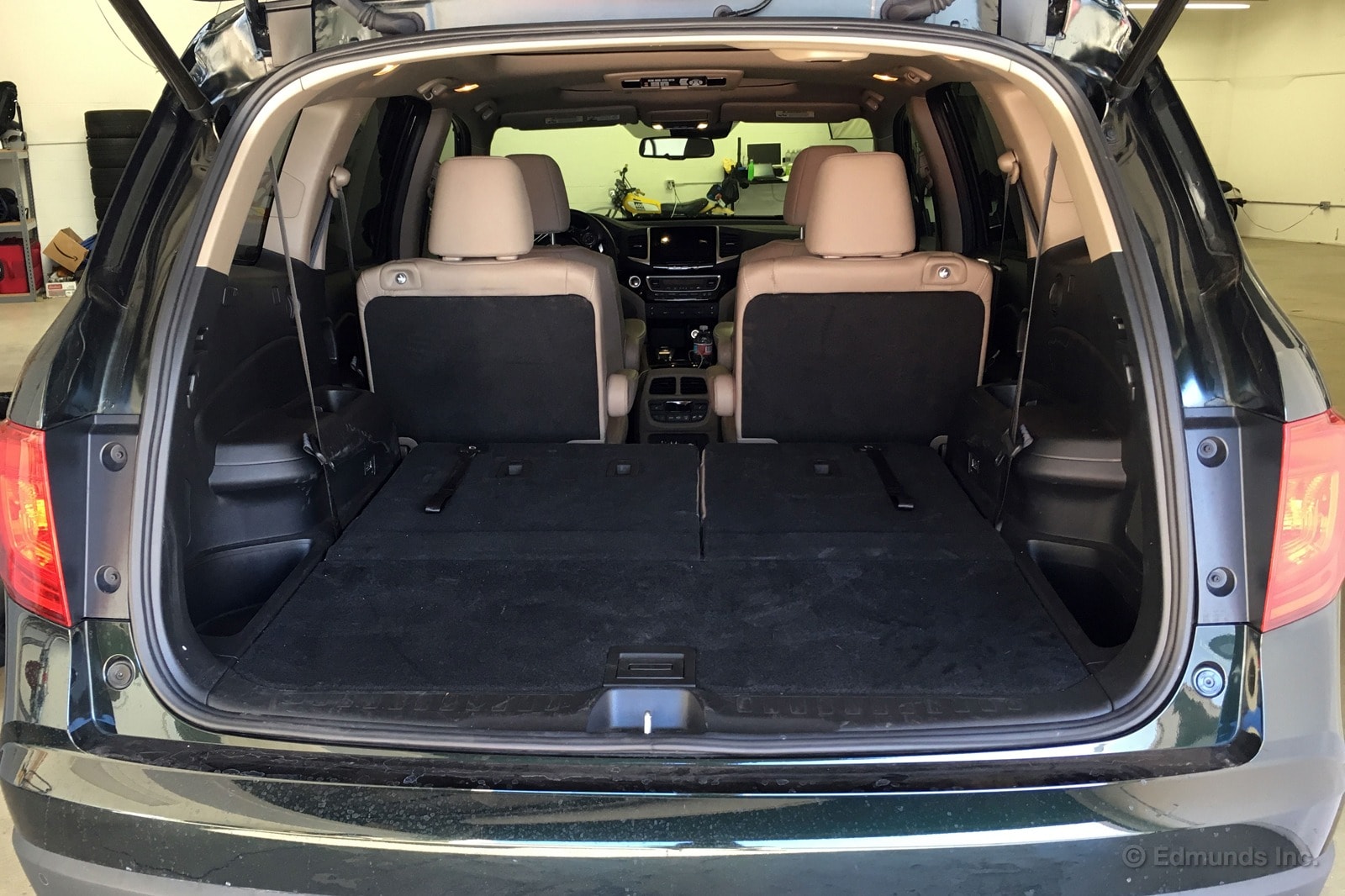
This area is configurable depending upon how you lower the third-row seats. Maximum capacity extends 47 inches from the back of the second row to the hatch opening.
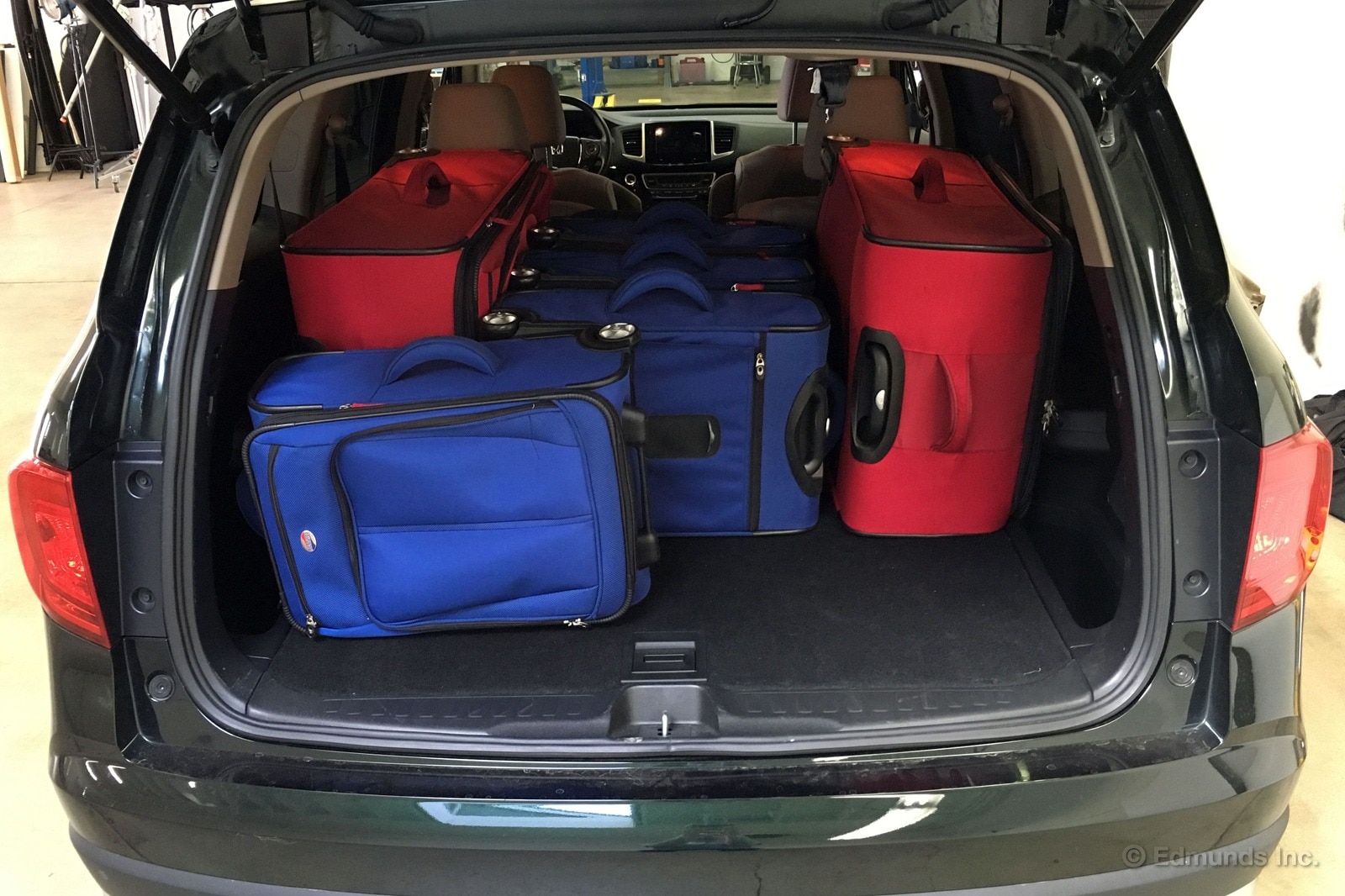
Behind the 3rd row
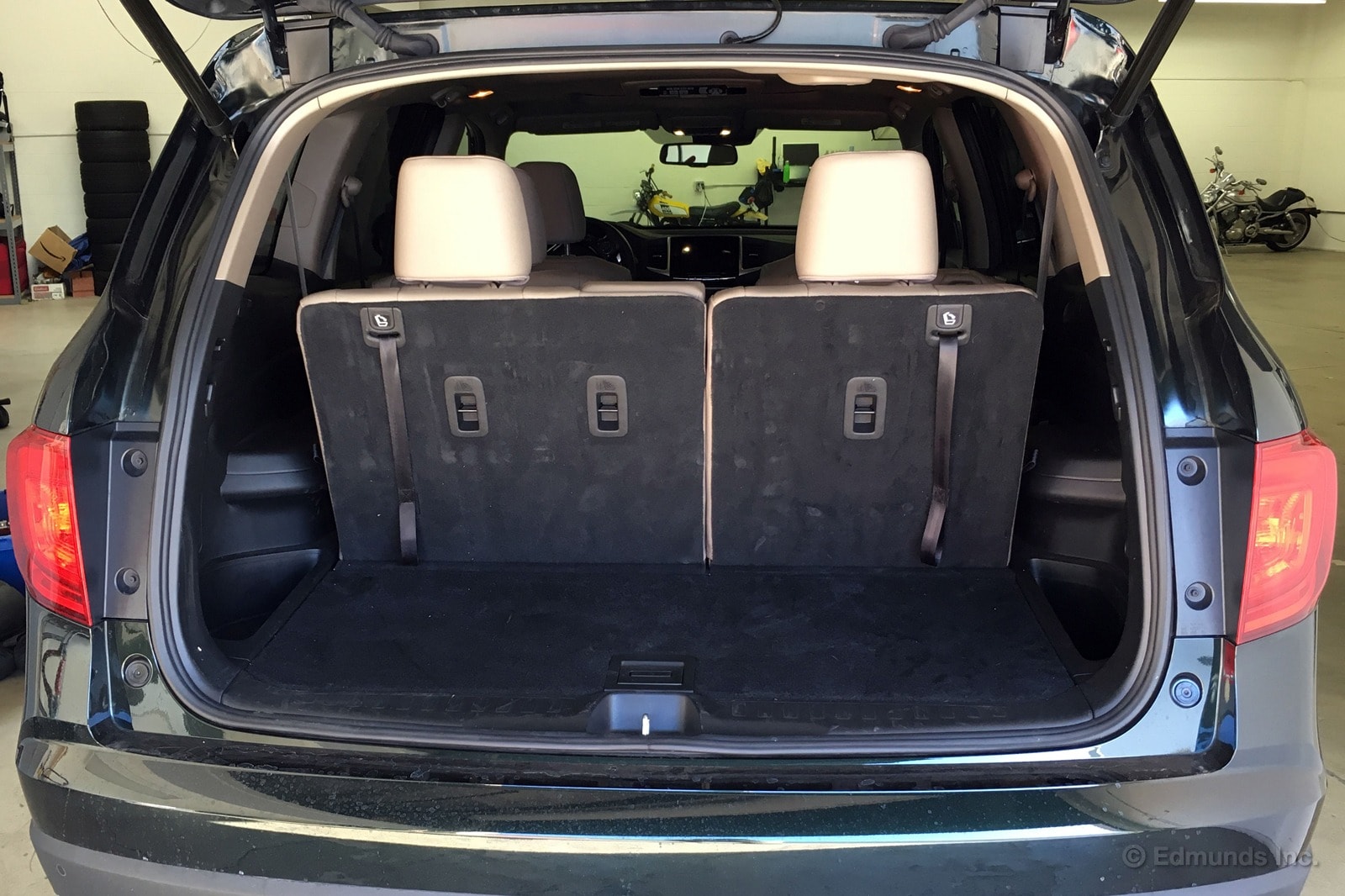

Cargo volume behind the third row is 18.5 cubic feet and the load floor is 16.5 inches deep. It has a 60/40-split folding seatback.
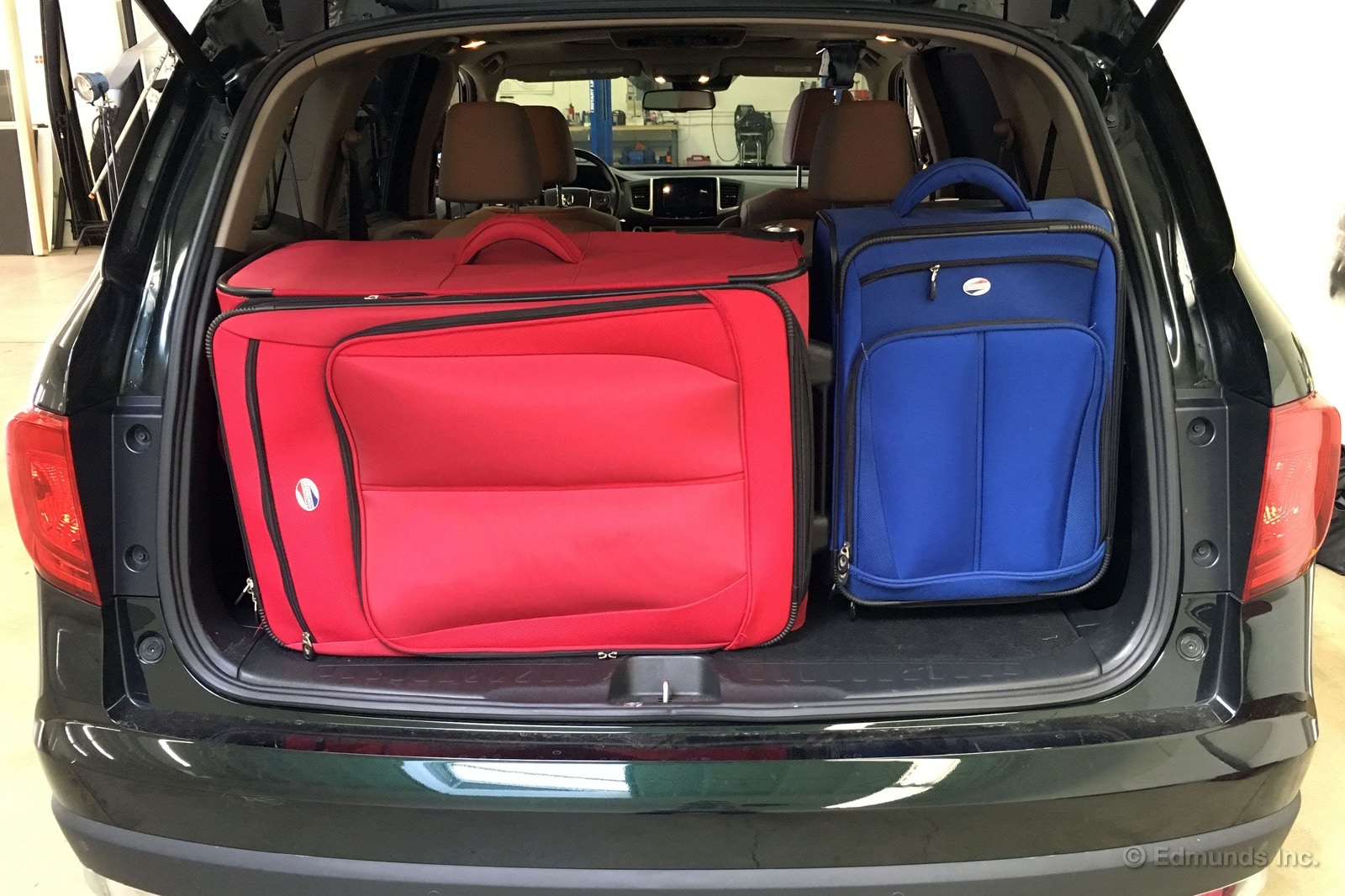
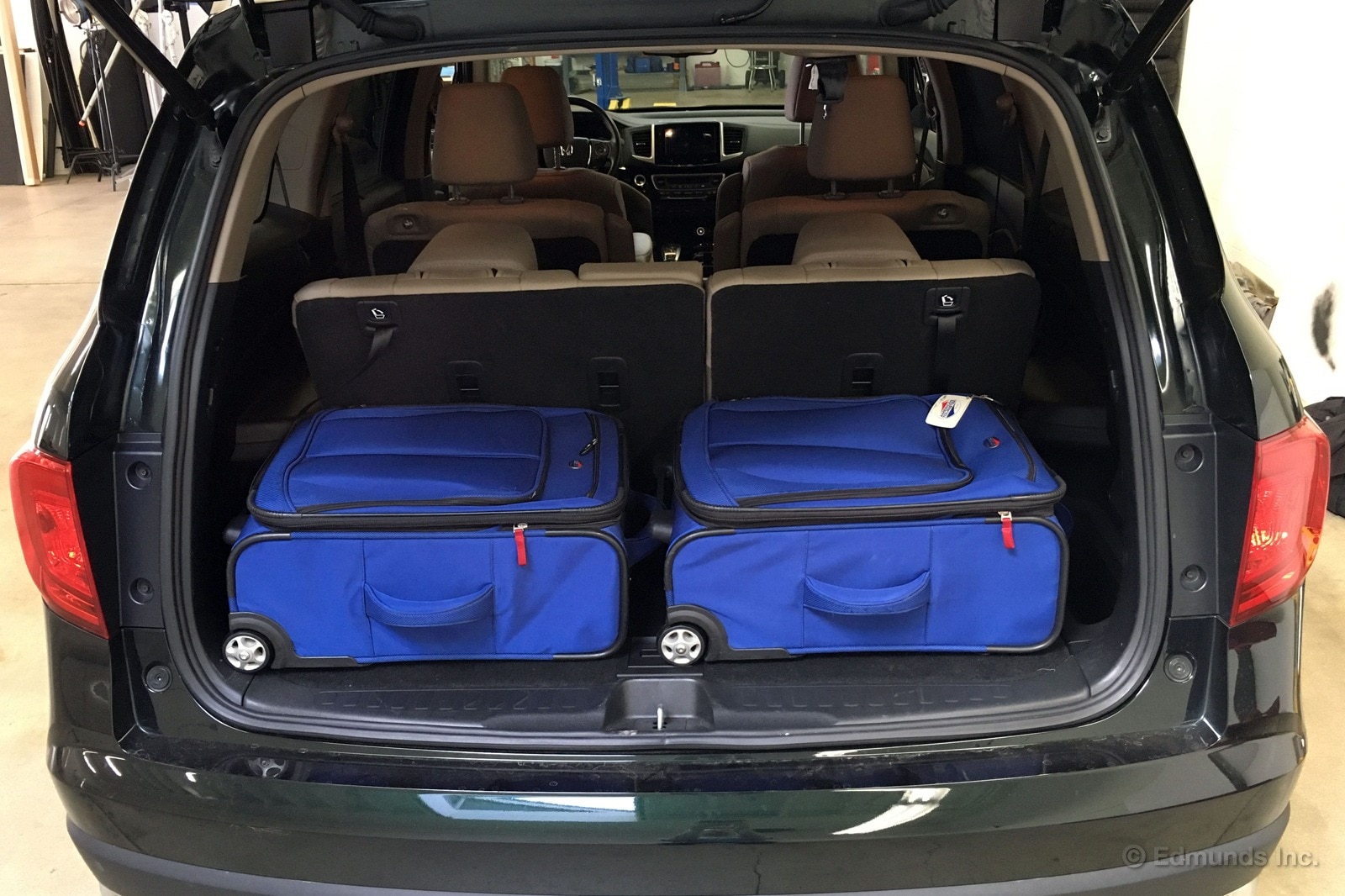
You can find other cargo specs for the 2016 Honda Pilot here.

Summer's winding down, and our 2016 Honda Pilot spent more time on local roads in August compared to its road-trip-heavy July. As a result, its overall average mpg dropped, albeit just a smidge.
We covered nearly 1,800 miles this month and pumped in about 98 gallons. The monthly average came out to 18.3 mpg. Worst fill and best fill remain unchanged, while lifetime mpg falls from 20.2 to 20 mpg.
Worst Fill MPG: 12.3
Best Fill MPG: 28.8
Average Lifetime MPG: 20.0
EPA MPG Rating: 22 Combined (19 City/26 Highway)
Best Range: 506.5 miles
Current Odometer: 18,858
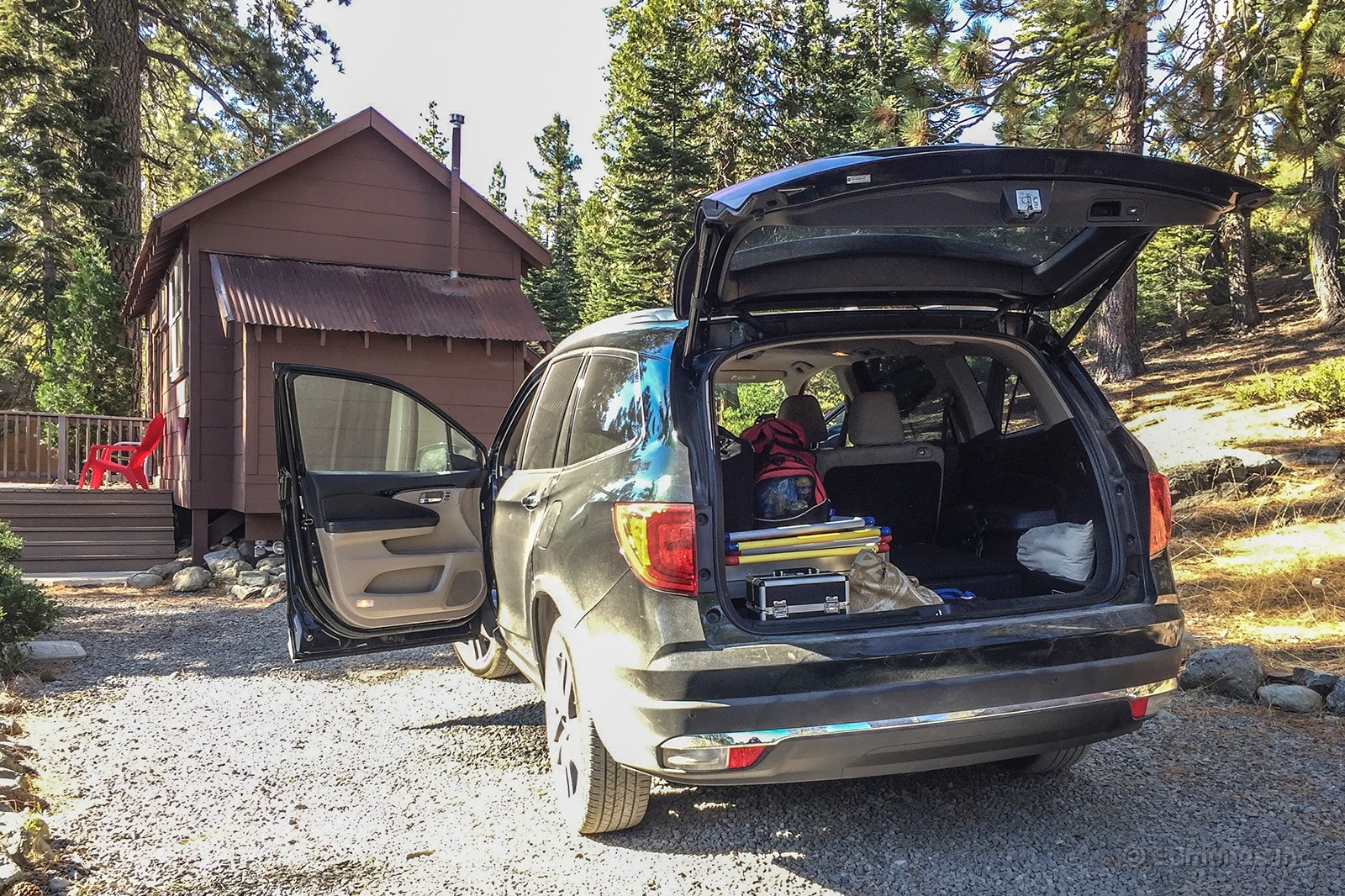
Two recent road trips gave me a chance to test the cargo space in our long-term 2016 Honda Pilot versus what we have in our long-term 2017 Chrysler Pacifica. A vehicle like the Pilot is a clear alternative to the minivan life with less stigma. It's what crossovers are all about. It has massive cargo space, three rows of seating and tons of available features.
Still, I was curious just how much versatility a Pilot owner must give up to avoid the minivan stereotypes.
Behind its third row of seats, our top-of-the-line Pilot Elite has 18 cubic feet of space, which is nothing to sneeze at. But the Pacifica has nearly double that at 32.3 cubes, and its lower load floor makes accessing that space easier.
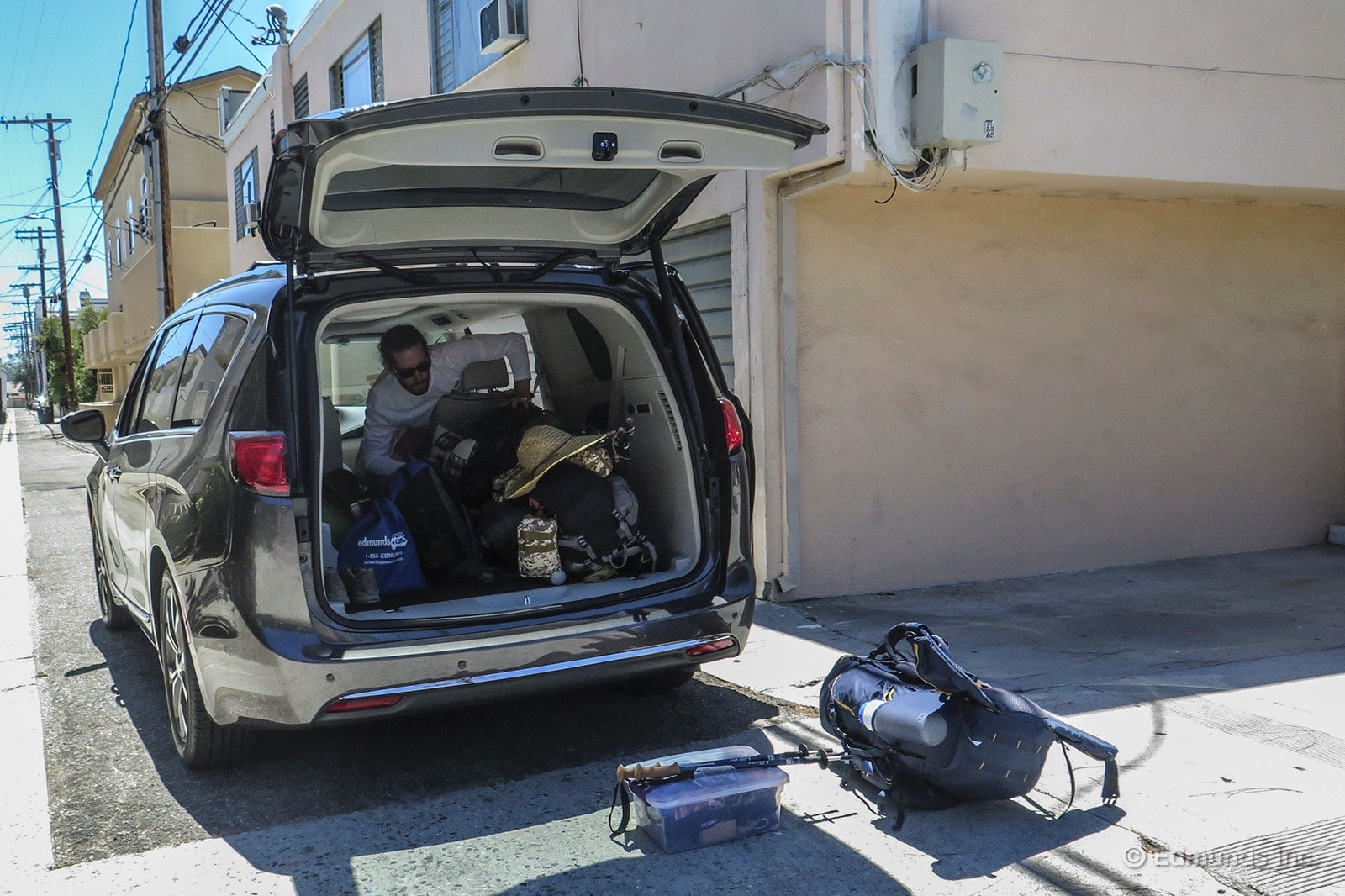
Fold the second and third rows flat in the Pilot Elite and you get 108.5 cubic feet of cargo space, which is again a strong performance for a crossover. But do the same thing in the Pacifica (the seats fold into the floor) and there's 140.5 cubes.
Of course, cargo space isn't the only difference between these two. The Pilot offers all-wheel drive, which isn't available on the Pacifica (though it is on the Toyota Sienna). It also has a higher towing capacity, maxing out at 5,000 pounds versus the Pacifica's 3,600. And its higher ground clearance brings some gnarlier off-road action into play.
But if room for stuff is your biggest concern, the Pacifica wins this one by a longshot. We know minivans rule this category — the Pacifica is actually on the small side compared to the Sienna and the Pilot's platform-mate, the Honda Odyssey — but the numbers are still pretty striking.
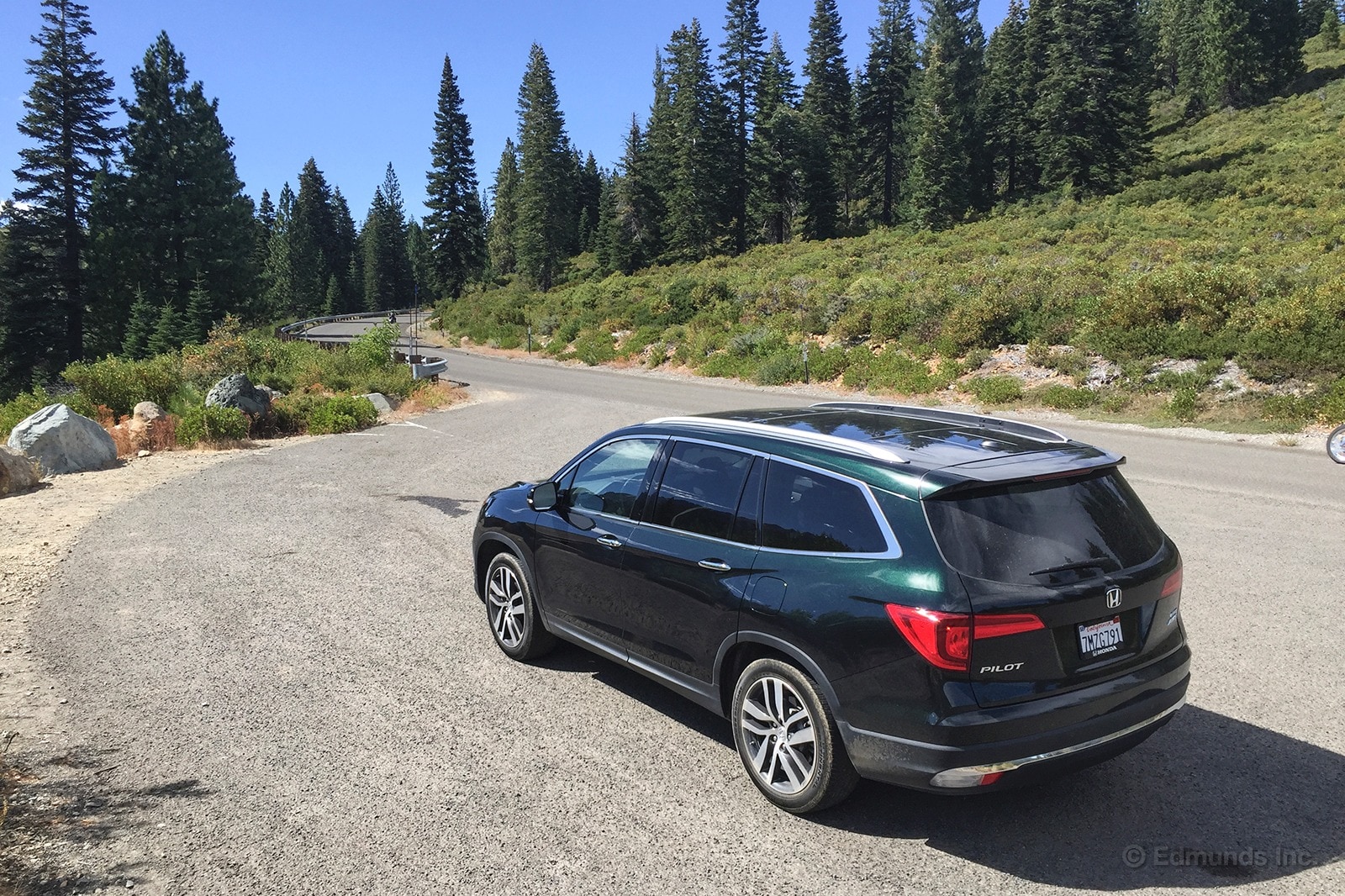
We've had our long-term 2016 Honda Pilot for eleven months and we've already hit our 20,000-mile target. Despite our disdain for the nine-speed transmission, the Pilot has been chosen for road trip after road trip while racking up those miles, including an 1,100-mile trip up and down California that I just completed.
Part of the Pilot's long-haul popularity has to do with the fact that the ZF nine-speed isn't doing much shifting when you're on the highway. What I did notice on my latest trip were things like the Pilot's quiet and comfortable ride, pleasant seats and abundant cargo space.
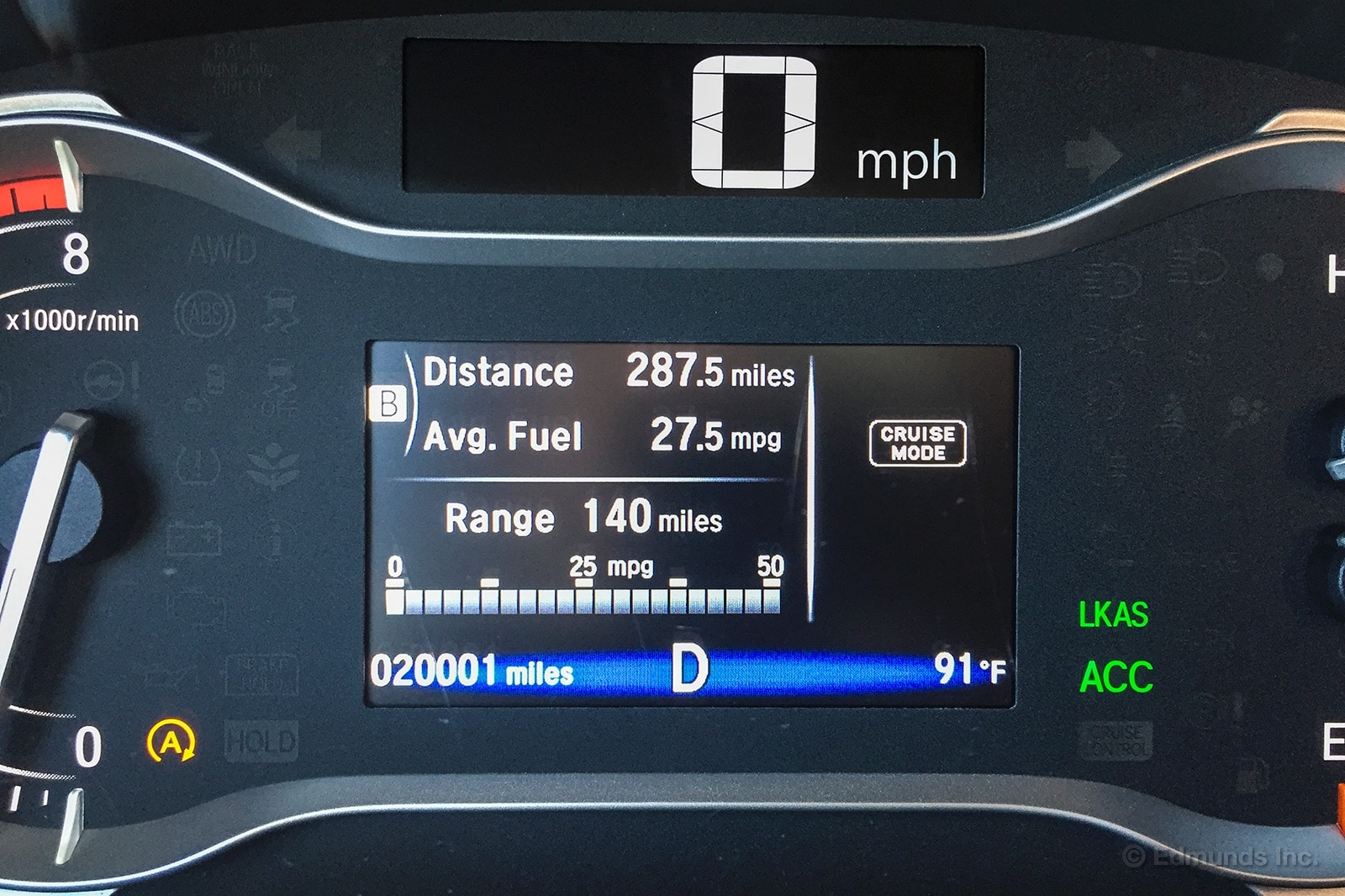
Road trips notwithstanding, the Pilot remains pretty far off its EPA combined rating of 22 mpg. I got 22 mpg on my trip, but about 90 percent of those miles were on the highway. We're averaging just over 20 mpg overall and we've only beaten the highway rating of 26 mpg a few times, with our best tank clocking in at 28.8 mpg. Yes, Dan squeezed 27.4 mpg out of the Pilot on a 2,151-mile trip, but we haven't had much luck repeating those results.
Still, the odometer on this rig speaks for itself. Sometimes we struggle to hit 20,000 before 12 months are up, but the Pilot has been in consistently high demand.
Monthly Update for October 2016
Where Did We Drive It?
October was a big month for our 2016 Honda Pilot test SUV, as we added over 2,500 miles to its odometer. More than half of those miles were accumulated during Automotive Editor Mark Takahashi's weeklong road trip through Northern California and Nevada — an excursion that included three men and three hunting dogs. The rest of the month, the Pilot was employed for more typical daily tasks, such as school carpool duty and around-town errands.
What Kind of Fuel Economy Did It Get?
Despite the number of highway miles logged this month, the Pilot's fuel economy stayed pretty flat. Our average lifetime mpg climbed a tick from 20 to 20.1, while the best fill and range remained unchanged.
Average lifetime mpg: 20.1 mpg
EPA mpg rating: 22 mpg combined (19 city/26 highway)
Best fill mpg: 28.8 mpg
Best range: 506.5 miles
Current odometer: 22,951 miles
Logbook Highlights
Performance
"As a road-trip vehicle, the Honda Pilot is an excellent choice. There's an abundance of space, plenty of power, a smooth ride and all the creature comforts we needed. The miles flew by thanks to the adaptive cruise control and decent range from a tank of fuel. There have been some complaints about the indecisive transmission, but on the highway that never seemed to be an issue." — Mark Takahashi, Automotive Editor
"I haven't driven the Pilot in months, and 10 minutes into driving I remembered how much I dislike this automatic transmission.The nine-speed stumbles in most situations, including through crawling traffic. It jumps into the next highest gear as soon as possible, so you're either in third and yearning for acceleration, or you deal with the harsh 3-2 downshift and slingshot forward. I apologized several times to my passengers for weird jerks and shudders caused by wonky transmission behavior." — Cameron Rogers, Associate Editor
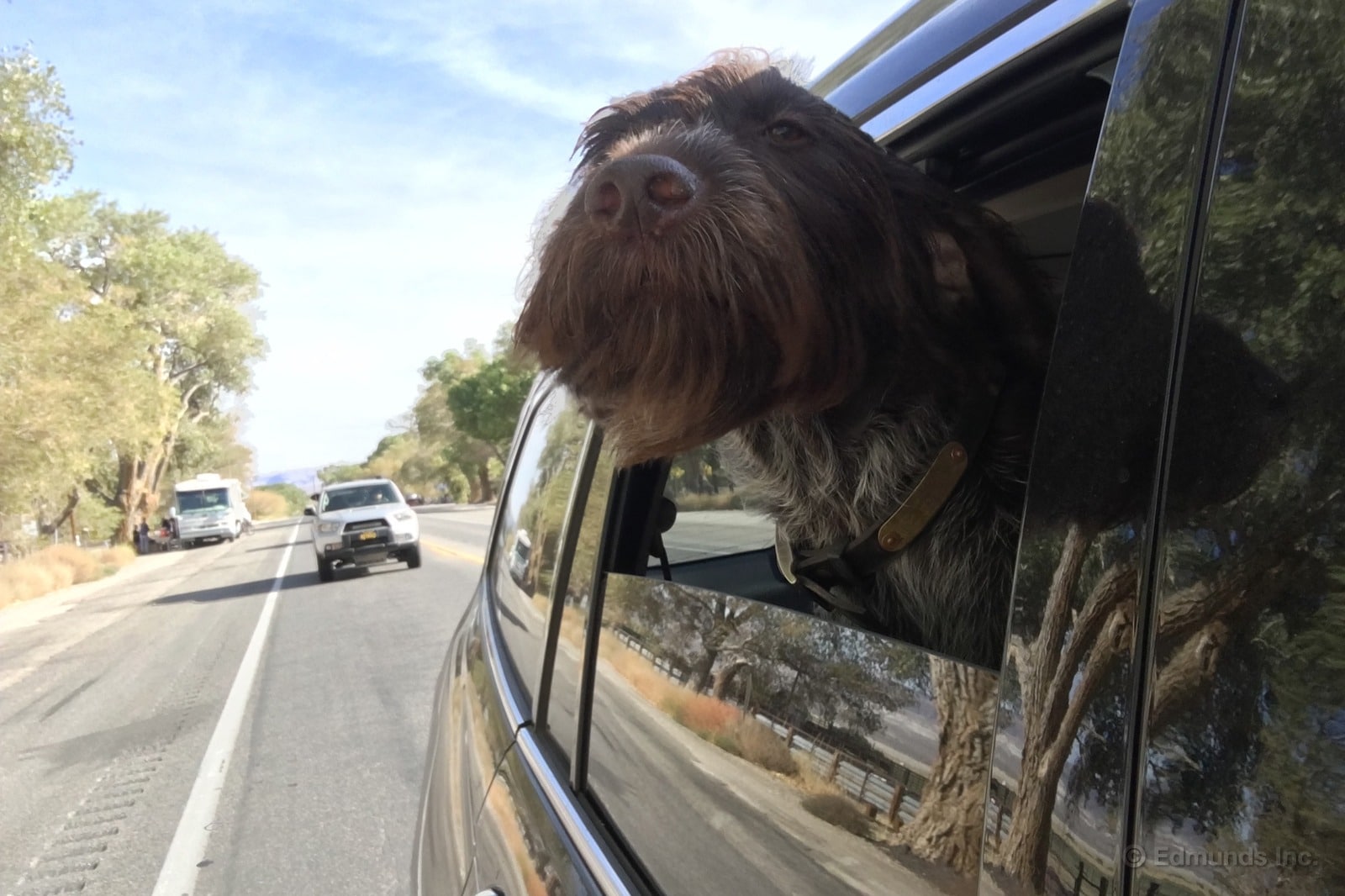
Interior
"There was plenty of space for three guys and three hunting dogs, and we had to keep two of them separated (the dogs, not dudes). The underfloor storage bin proved a handy place to store items that I didn't want crushed. It was deep enough to accommodate my wide-brimmed hat and stayed cool enough not to ruin my bottle of Scotch, Cuban cigars or assorted snacks." — Mark Takahashi
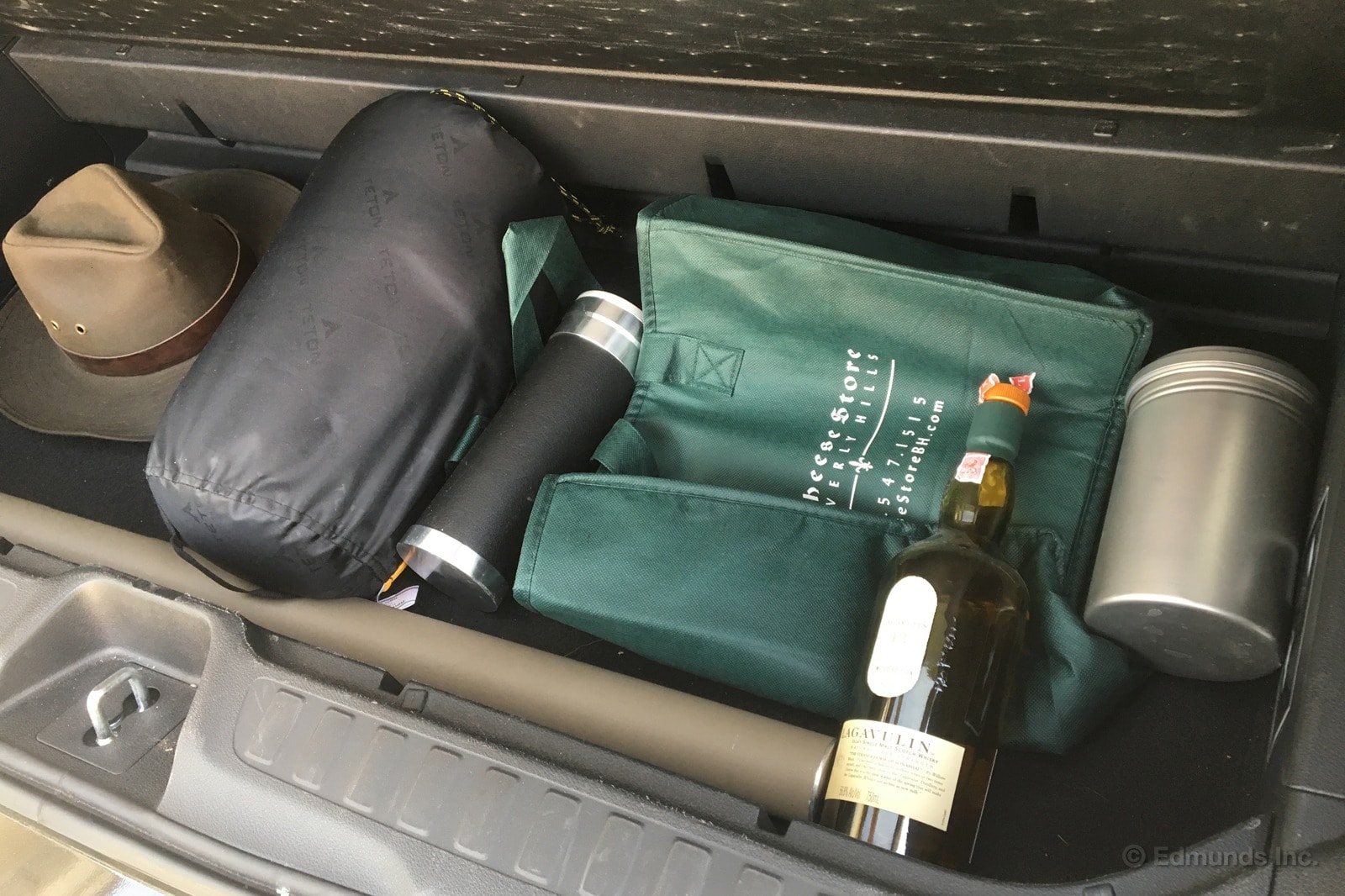
Comfort
"On dirt roads, the ride quality remained relatively smooth and composed, and the front and rear climate controls kept the entire cabin comfy." — Mark Takahashi
"Rear seat heaters are much appreciated on this rainy, 60-degree morning. Californians have a different definition of cold weather." — Kelly Hellwig, Managing Editor
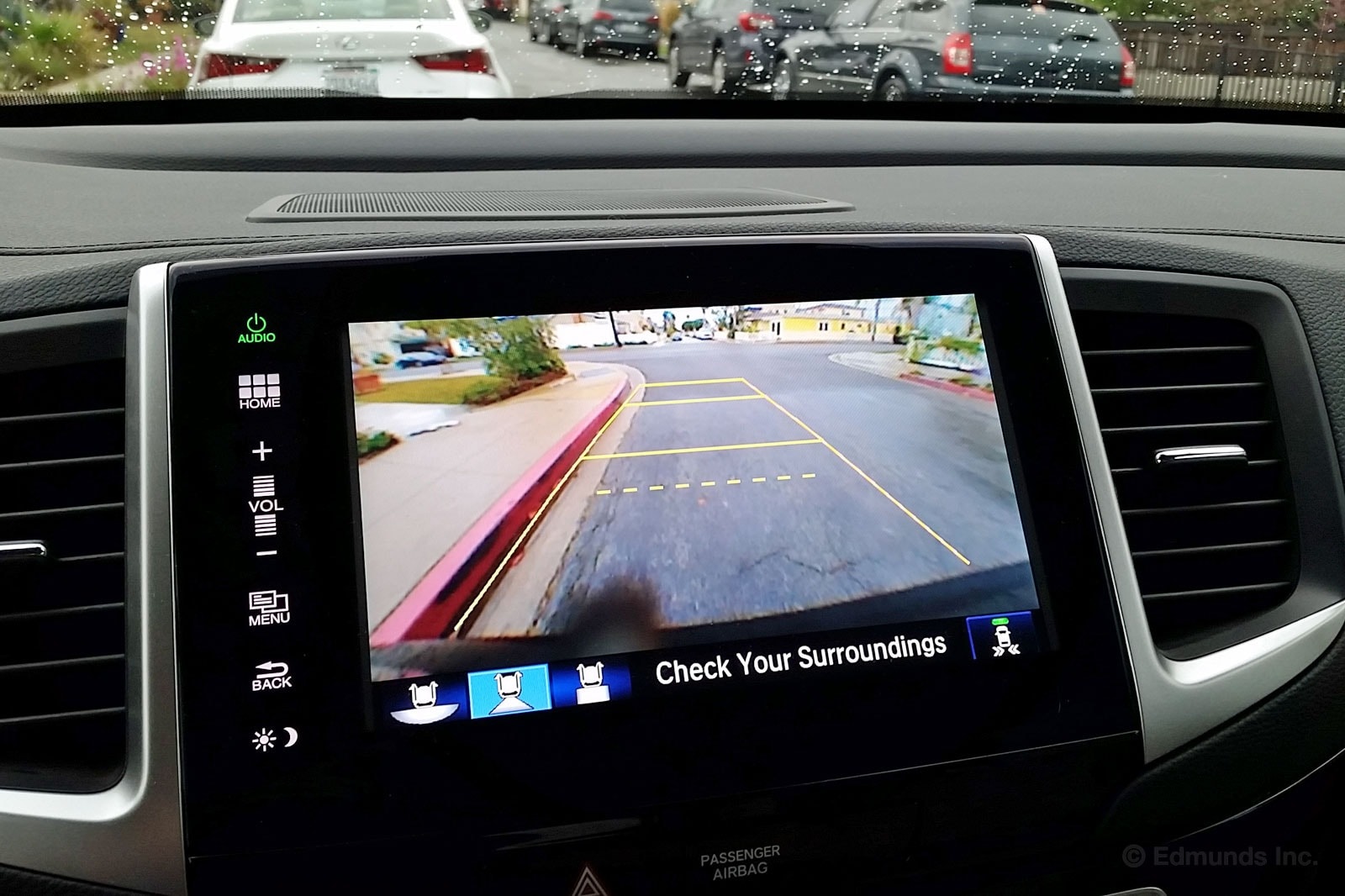
Technology-Audio
"Even on a gloomy, wet day, the backup camera on the Pilot still delivers a vibrant, clear picture when you're in reverse. Makes a huge difference when parallel parking or coming out of a space in a parking lot. Some cameras get pretty murky when the light is low, but not this one." — Ed Hellwig, Executive Editor
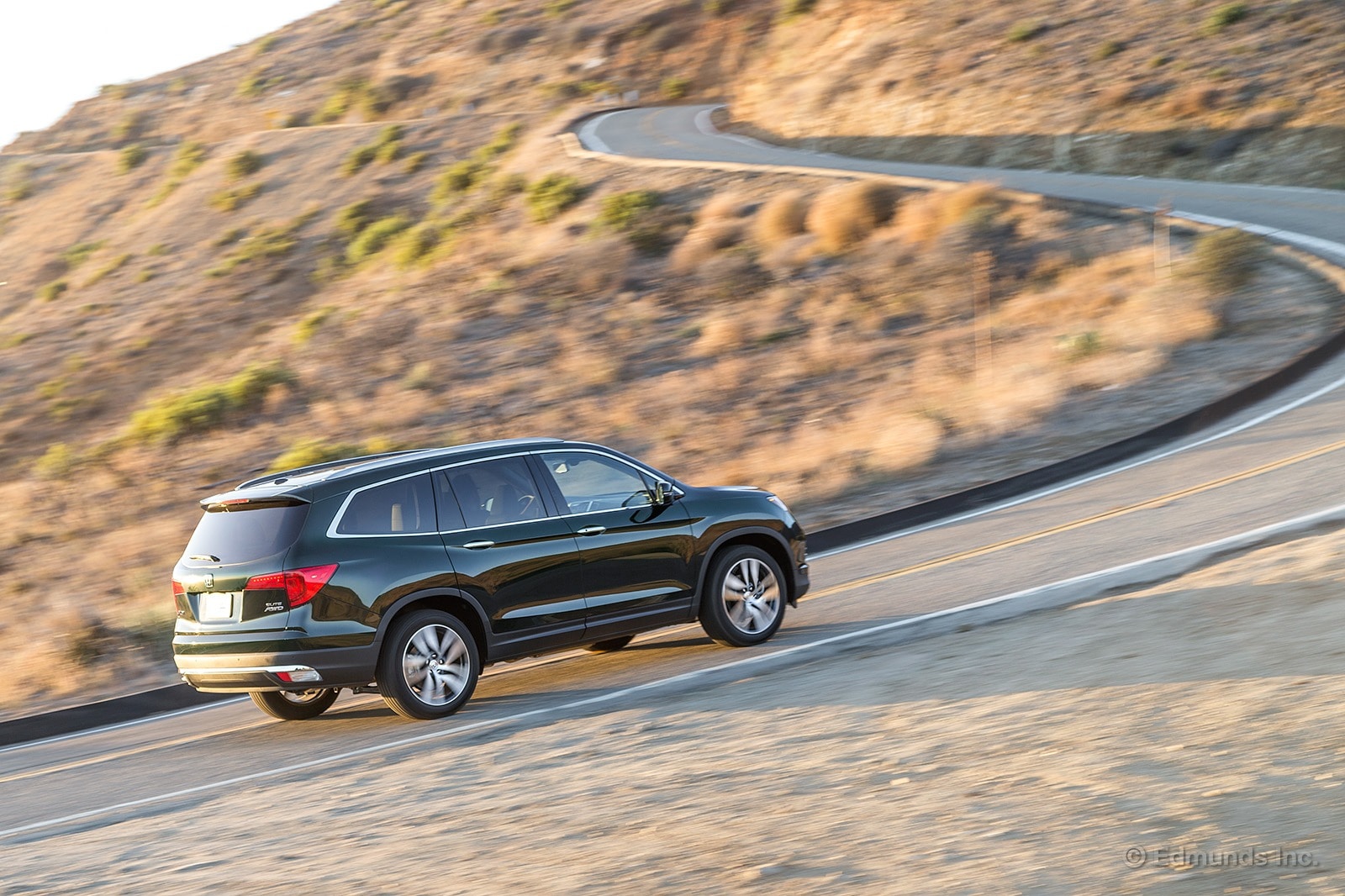
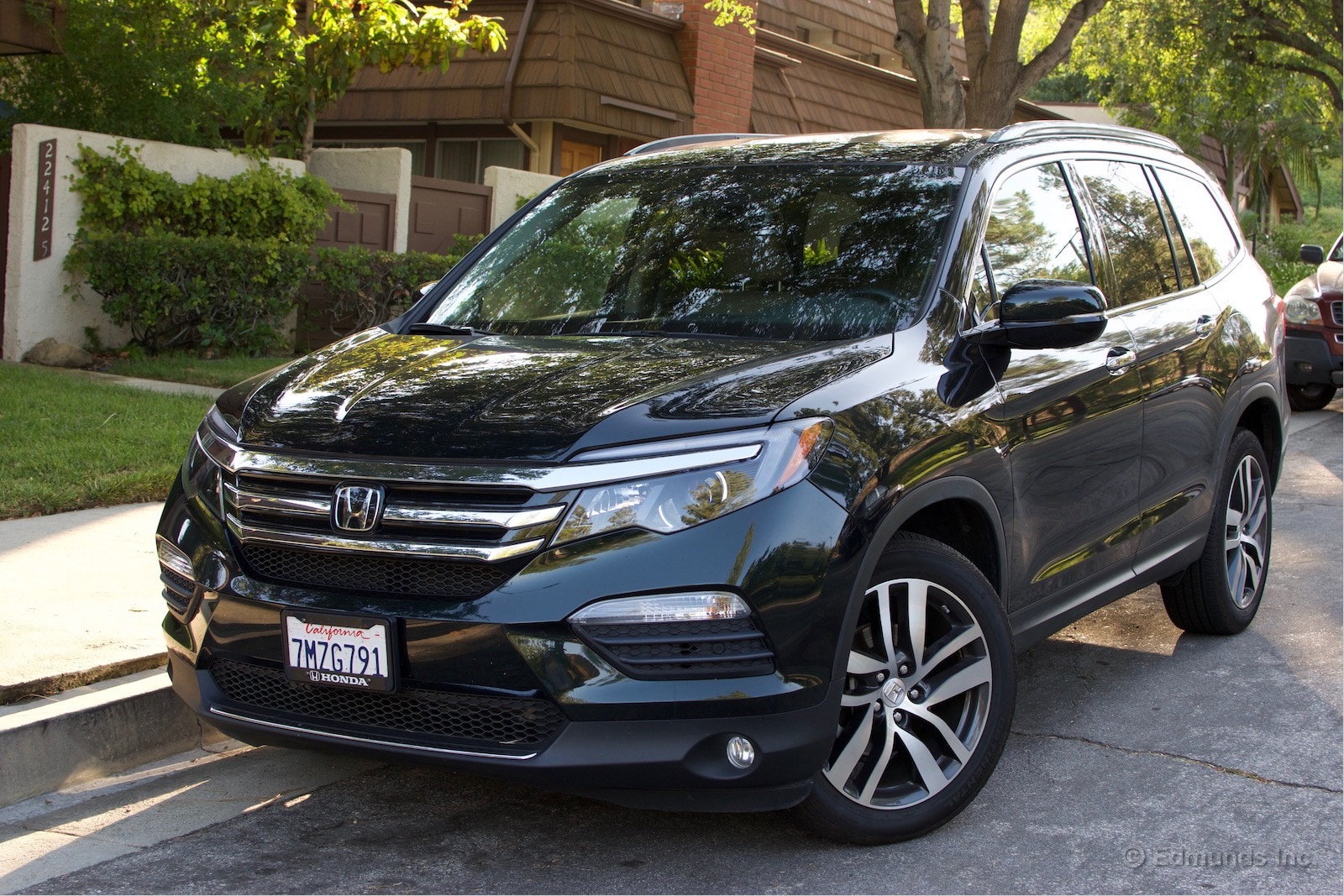
The maintenance minder for our 2016 Honda Pilot alerted us that an A1 service needed to be completed. So I scheduled an appointment with Honda of Santa Monica for 9:30 the next morning and arrived at about 9:35.
An A1 service is pretty standard stuff. According to Honda, the "A" stands for an oil and filter change, while the "1" stands for a tire rotation. I was quoted an estimated time of 90 minutes and a cost of $88. I left the Pilot in the dealership's care and retreated to the office, as it's only a mile away.
At the two-hour mark, I gave Honda of Santa Monica a call. I was transferred to service two different times and greeted with the same automated message each time: The service department was unavailable. Click. Finally, on my third call, I got through to my service advisor's voicemail. A few minutes later, my advisor called back saying he needed another 30 minutes with our Pilot.
Around 12:30 pm I received another call from my advisor. The Pilot was ready after a total of three hours. I was glad I didn't decide to wait in the lounge. I wondered if something out of the ordinary had happened with our Pilot, so I asked when I arrived to pick up the vehicle. I got what felt like a canned response about it being a busy morning but nothing more.
Maybe my presence at the dealership would've changed the timeframe, or maybe not. It wasn't clear why the service took longer than estimated. That left me disappointed with this visit overall.
The total for the A1 service came to $88.10.
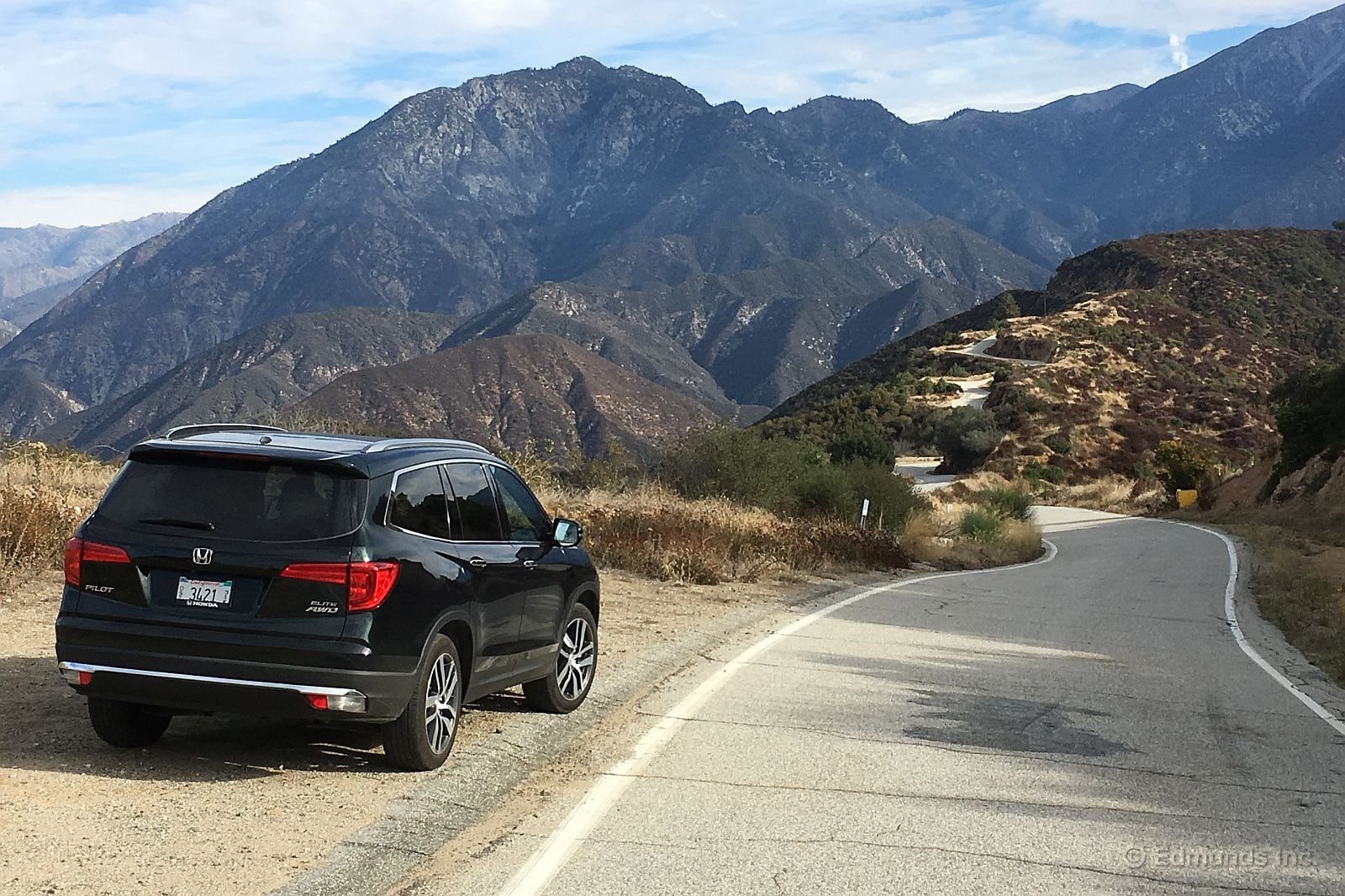
Where Did We Drive It?
Our 2016 Honda Pilot soldiered on this month amid an unseasonable smattering of cold and rain. The Pilot's all-wheel-drive system gave Copy Chief Kathleen Clonts peace of mind during a surprise downpour in Palm Springs, of all places, while its seat heaters came in handy on her chilly (we use the term loosely) morning commutes to the office. Meanwhile, Director of Vehicle Testing Dan Edmunds took our Honda into the twisting mountain roads above Glendora, reporting that the big crossover handled them well enough. He also encountered some rodent footprints in the engine compartment; thankfully, no damage done.
What Kind of Fuel Economy Did It Get?
The Pilot's lifetime average remains closer to the EPA city rating than the combined estimate, and we still haven't seen a better tank than the one Dan notched on his trip to Oregon back in July.
Average lifetime mpg: 20.1 mpg
EPA mpg rating: 22 mpg combined (19 city/26 highway)
Best fill mpg: 28.8 mpg
Best range: 506.5 miles
Current odometer: 24,238 miles
Maintenance and Upkeep
None, unless you count the unscheduled inspection by our muroid friends (more below).
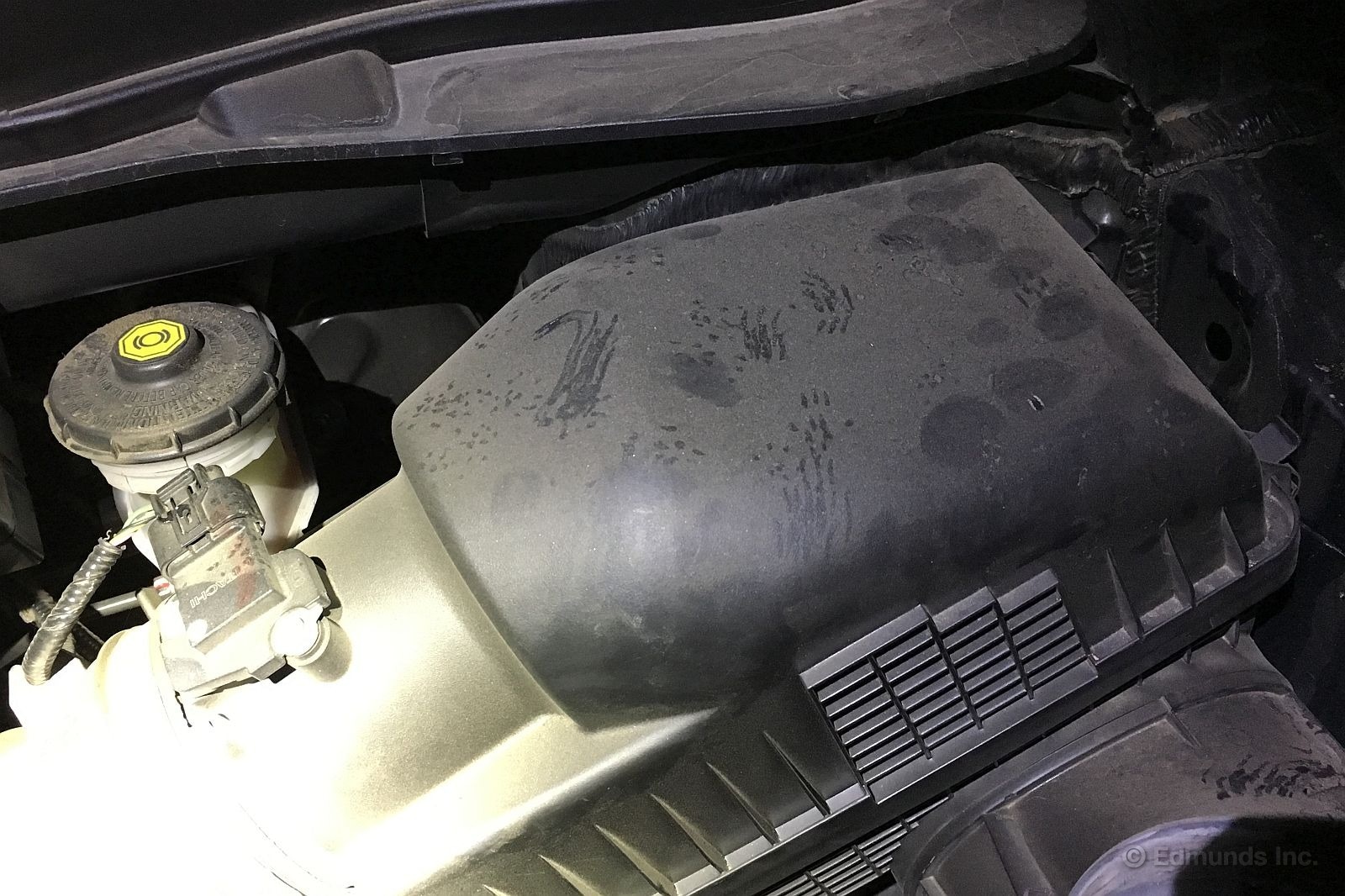
Logbook Highlights
Performance
"A quick day trip to Palm Springs to see a play on a quiet Sunday turned more eventful with rain (a big deal to Southern Californians, and the most rain I could remember in one day during the past three years). The Pilot was an unflappable performer, the all-wheel drive a comfort on the slick roads." — Kathleen Clonts, Copy Chief
"The sinuous mountain roads above Glendora attract all sorts. You'll find motorcycles in abundance, cyclists looking for a workout, and if you get there early enough, you might even come across a squadron of crazy-pants downhill skateboarders. It's that kind of road. The whole area is bristling with blind turns that are interspersed with squirts of acceleration and braking. The Honda Pilot is by no means optimized for roads like this, but the curves don't flummox it, either. Of course, Honda doesn't need its Pilot to excel up here, because there are other products in its inventory that do — some with four wheels and many others with just two." — Dan Edmunds, Director of Vehicle Testing
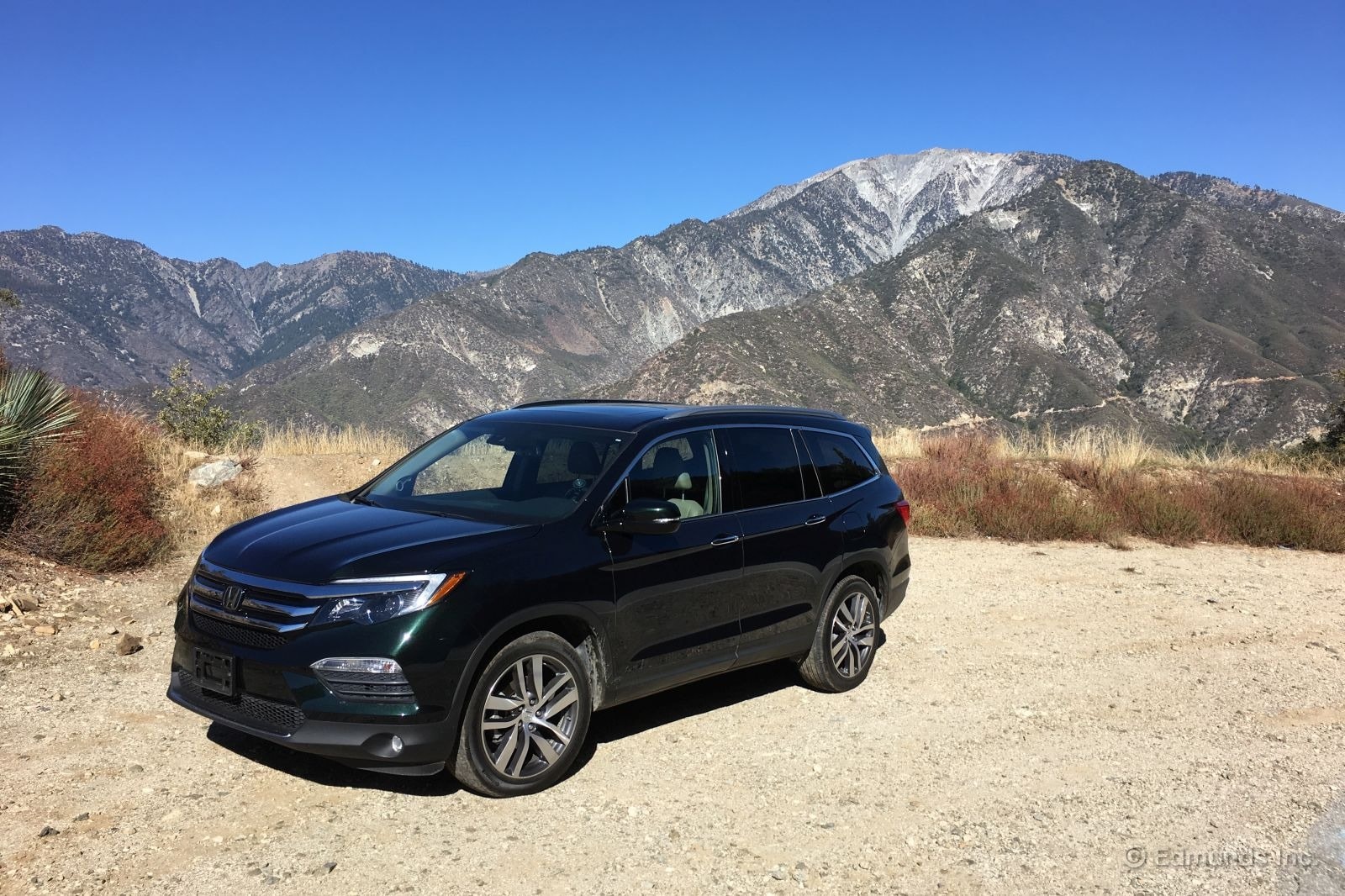
Comfort
"When the temps dipped below 60, the seat heated up in a flash. It felt noticeably toasty in less than a minute, making the drive home much cozier." — Kathleen Clonts
Miscellaneous
"I opened the hood of our 2016 Pilot to help my daughter jump-start her car and was greeted by the remnants of what looked like a varmint dance party. The usual thin film of underhood dust was dotted with rat footprints. Or maybe large mice. I'm not sure where the mouse/rat zoological cutoff is.
"I'd seen this before, but only after my old minivan had stumbled and died to the accompaniment of a check engine light. In that case, mice had holed up under the engine cover and gnawed on some fairly important wires. Insurance covered about half of it, and it returned to the road, but it was a lesson learned.
"With that in mind, I tore off the Pilot's engine cover and examined all the wires I could see. No signs of gnawing anywhere at all. I guess they were just passing through. The fact that this car doesn't follow an established pattern and stay in the same driveway every night may be why these varmints didn't set up shop under there." — Dan Edmunds
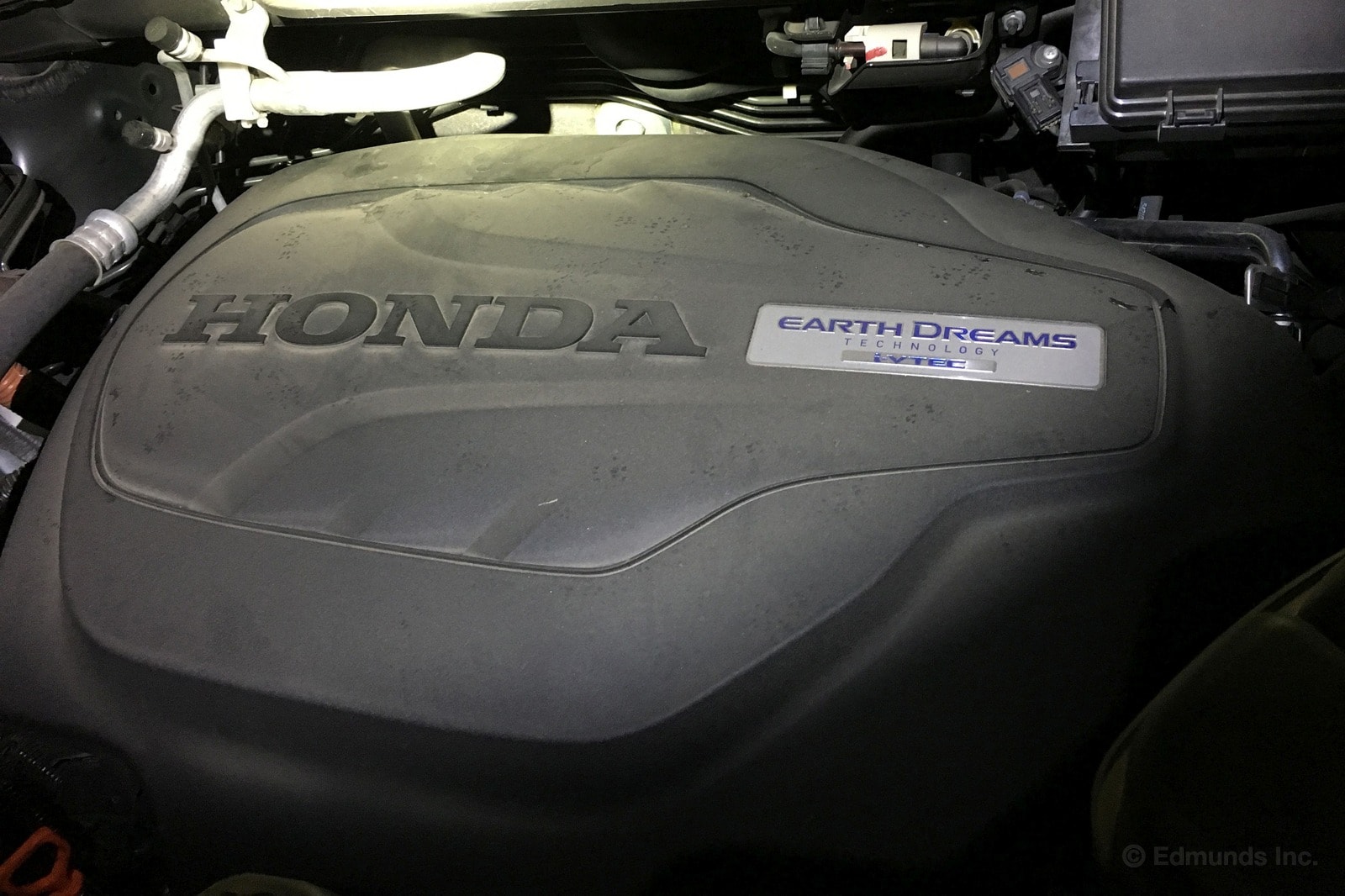
Wrap-Up
What We Got
Well before three-row crossovers became one of the hottest segments in the industry, Honda was there with the Pilot. It has seen plenty of changes since its debut 14 years ago, with 2016 marking its second complete redesign. It has become a vital piece of Honda's lineup as it offers families a more rugged-looking alternative to the Odyssey minivan.
For 2016 the Honda Pilot offered five trim levels — LX, EX, EX-L, Touring and Elite — and as with most Hondas there were no stand-alone options.
All versions of the Pilot offered the same 280-horsepower 3.5-liter V6 and either front- or all-wheel drive, with the exception of the AWD-only Elite. A six-speed automatic transmission was standard for all LX, EX and EX-L models, while the Touring and Elite models came equipped with a new nine-speed automatic.
We had a good idea of what we wanted going into the shopping process. The appeal of a top-trim Elite gave us access to all of Honda's latest features, such as adaptive cruise control and various electronic safety systems. What it didn't have was a second-row bench seat, which was replaced by captain's chairs that come on the Elite trim. It limits overall passenger capacity, but it does make third-row access that much better.
Honda agreed to lend us the vehicle for one year to see how it measured up against its predecessor. Here's a summary of how it measures up against Pilots of the past.
Performance
"Much has been said about the various vehicles that have been negatively impacted by the application of this particular nine-speed automatic. It doesn't seem like any car company can elegantly calibrate the confounded thing. And it feels like nine gears are simply too many. It has to downshift three or four gears when I need to pull out to pass, which results in a big lag while it sorts itself out. And the push-button shifter that comes with it is frustratingly slow, too." — Dan Edmunds, Director of Vehicle Testing

"During acceleration testing, the engine revs smoothly and feels best from the mid-rpm range to high-end. It tends to make its best power just before 5,000 and upward, where torque peaks. The transmission shifts quickly and crisply, keeping in lockstep with the eagerness of the engine. Nice powertrain under these conditions." — Reese Counts, Vehicle Testing Assistant
MPG
"... the return trip [from Oregon] was only slightly better than the trip north. Tanks of 20.8, 22.1 and 22.7 mpg resulted in a southbound average of an even 22 mpg, which brought the entire trip average up slightly to 21.7 mpg. But this is disappointingly weak when you compare it to the relevant rated fuel economy number: 26 mpg highway." — Dan Edmunds
"As for fuel economy, the Pilot's in-car fuel economy meter showed 26.1 mpg after 294.7 miles of driving. I was initially excited that I got EPA highway (something Dan struggled to do on his trip), but after I pumped in 12.572 gallons, actual fuel economy turned out to be 23.4 mpg." — Brent Romans, Senior Automotive Editor
Cargo Space
"Holy schnikes, our long-term Honda Pilot has a colossal center console cargo bin. What you see (in this picture) is an entire 2.5-gallon water dispenser neatly slotted into said bin. It simply dropped right in there." — Jason Kavanagh, Engineering Editor
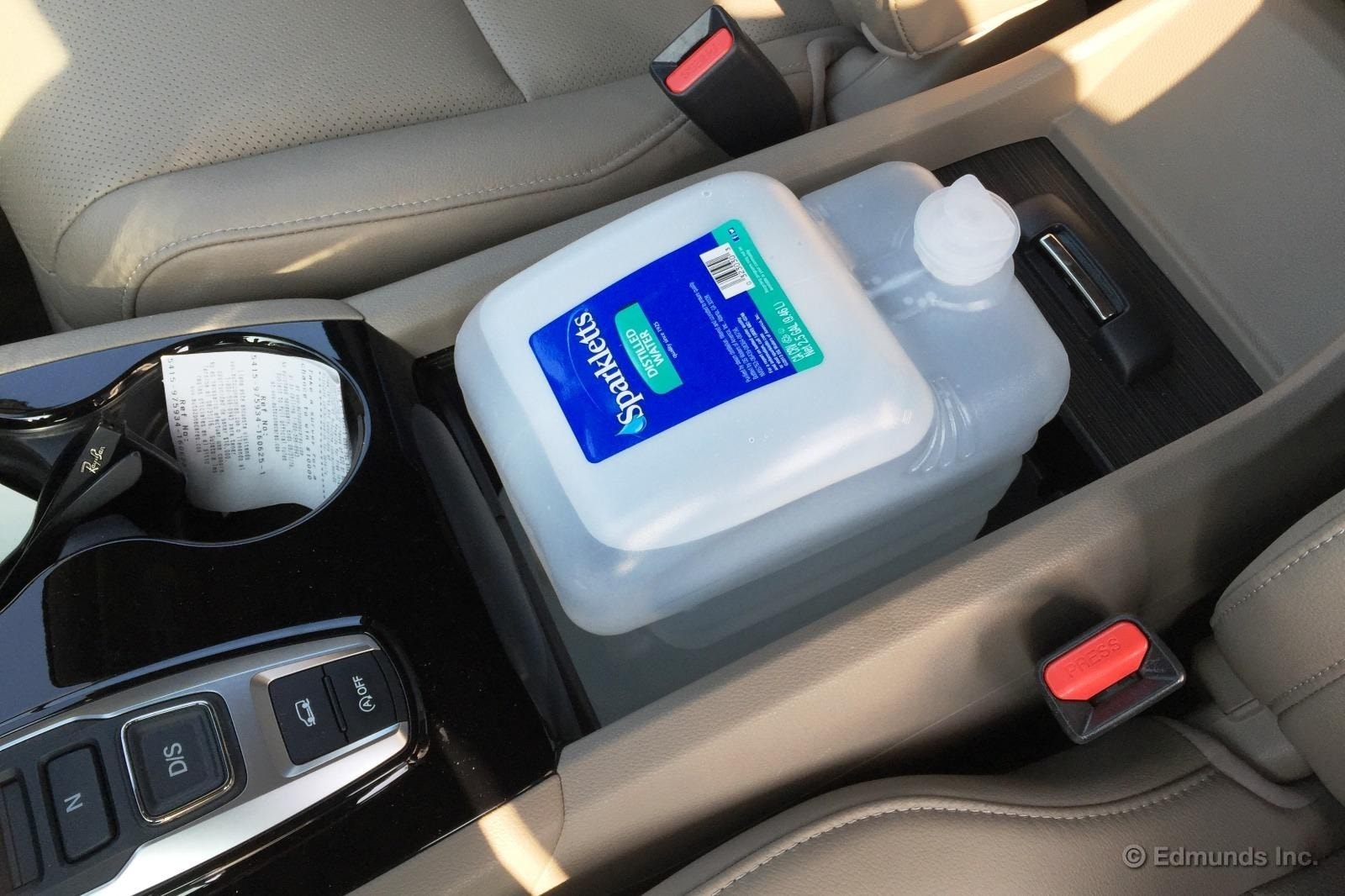
"Door pockets: quietly clever multi-level design with the bottle holder high and forward in an easily reached spot. I had my wallet and sunglasses case on the second tier the whole time and other stuff lower down. Even the door-pull finger pockets are big enough to hold some loose change." — Dan Edmunds
Comfort
"The Pilot is an agreeable long-distance companion. It's respectably quiet and comfortable on the highway, and the V6 gets it up to speed when you give it the spurs. The Pilot isn't luxury-car quiet, but it's quiet enough. The only thing I didn't really care for was the Pilot's big body motions when driving over larger bumps on the highway. Granted, the Pilot is a big crossover SUV, but I wouldn't mind just a bit more body stability." — Brent Romans
"On our way up to Sacramento, there weren't many complaints, but limited legroom in the third row was one noted shortcoming. There's plenty of headroom and space to spread out when you're the only person back there, but if you're an adult over 5 feet 4 inches and you're sitting upright, your knees will likely be pretty close to your chest." — Travis Langness, Automotive Editor
Interior
"There was plenty of space for three guys and three hunting dogs, and we had to keep two of them separated (the dogs, not dudes). The underfloor storage bin proved a handy place to store items that I didn't want crushed. It was deep enough to accommodate my wide-brimmed hat and stayed cool enough not to ruin my bottle of Scotch, Cuban cigars or assorted snacks." — Mark Takahashi, Automotive Editor
"In crossovers of this size, the cargo space behind the third row is limited. The Pilot is no exception, with the distance between the seatback and hatch at just 16.5 inches. Unlike some other crossovers, the Pilot has a false cargo floor that expands the height a few inches when removed. This would prove invaluable for our trip as we could fit luggage behind the third row without compromising visibility out the rear window." — Cameron Rogers, Associate Editor
Audio and Technology
"[The touchscreen audio] is slow and the touch-sensitive volume control is a nightmare. This thing desperately needs physical volume and tune knobs. But the worst is the ridiculously tiny size of the 'source' and 'map' touch-sensitive regions (I wish I could call them buttons, but they're not) that are used to swap between modes. They're an inch wide, but only like a quarter-inch tall, which makes them easy to miss when the car is rolling, on account of the normal random vertical body movement a car has going down the road." — Dan Edmunds
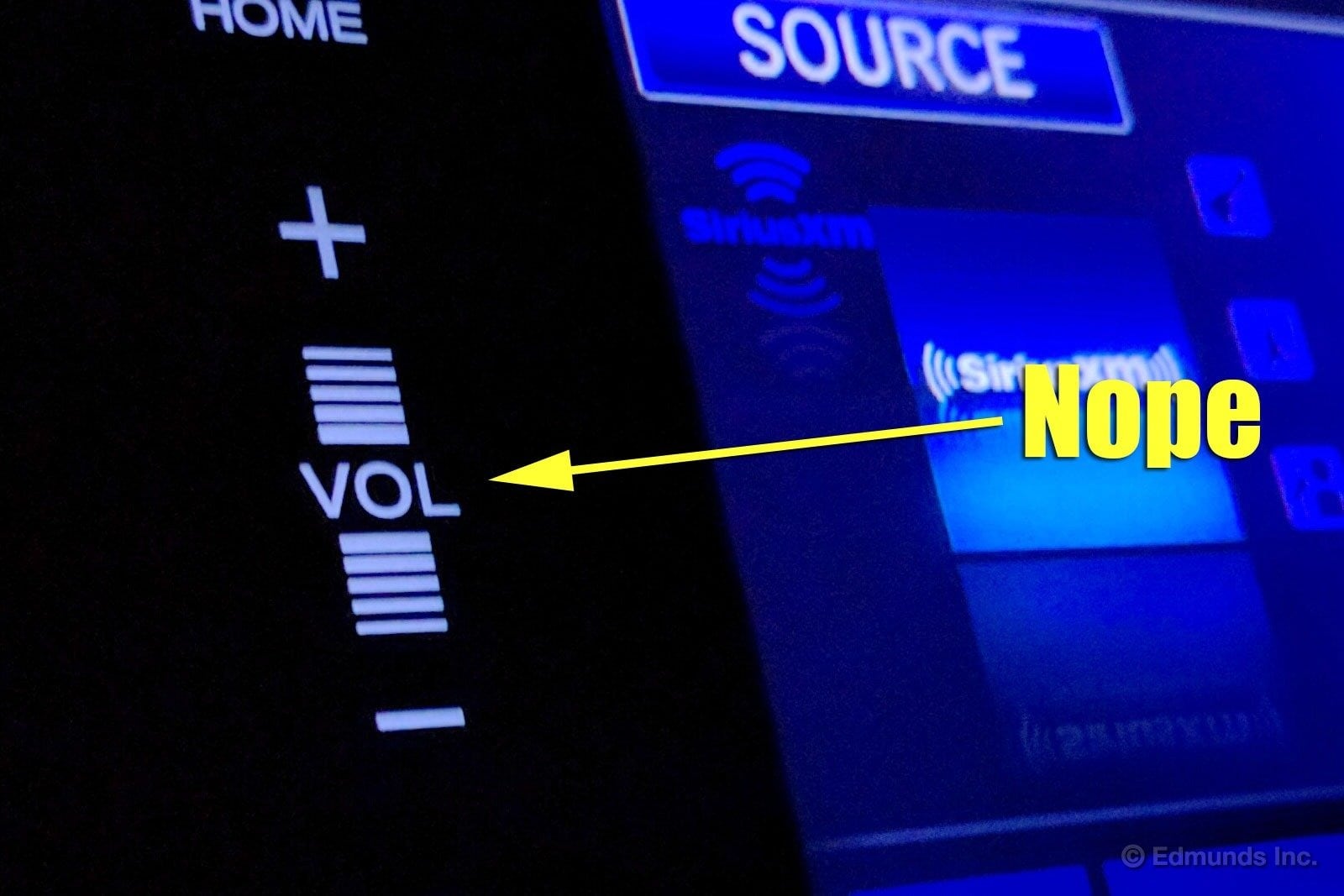
"Even on a gloomy, wet day, the backup camera on the Pilot still delivers a vibrant, clear picture when you're in reverse. Makes a huge difference when parallel parking or coming out of a space in a parking lot. Some cameras get pretty murky when the light is low, but not this one." — Ed Hellwig, Executive Editor
Maintenance
"I was sitting at a nearby coffee shop when Kevin called just past 8 a.m. 'I just got to Honda and looked at the glass. There's a small chip in the lower corner. You'd probably never notice it, but it wouldn't be right for me to install it. I'll order another one for you and it'll be in on Monday.' " — Cameron Rogers
"At the two-hour mark, I gave Honda of Santa Monica a call. I was transferred to service two different times and greeted with the same automated message each time: The service department was unavailable. Click. Finally, on my third call, I got through to my adviser's voicemail. A few minutes later, he called back saying he needed another 30 minutes with our Pilot. ... It wasn't clear why the service took longer than estimated. That left me disappointed with this visit overall." — Michael Massey, Vehicle Testing Assistant
Miscellaneous
"In addition to the six-speed, the shifter and the leather, I prefer the EX-L (over our Elite) because the backseat is still a 60/40 three-across affair. This Pilot seats one more person, and those with one child seat have a place to latch it in the middle. When up, the full-width seatback keeps your cargo from spilling forward, and when it's down, the load floor doesn't have the big hole you get when you fold an Elite's middle seats." — Dan Edmunds
"I used the adaptive cruise control throughout the trip except when I needed to pass or when traffic slowed in construction areas along I-15. Although it's far from perfect, I like the system more than in the Acura TLX. There were several times when a car cut in front of me to pass a slower vehicle in their lane. Rather than slam on the brakes like I expected, the Pilot beeped like crazy and flashed the 'Brake' light in the instrument panel. The brakes were applied after a few seconds, but I appreciated that the system didn't immediately physically overreact like it does on the TLX." — Cameron Rogers
Maintenance & Repairs
Regular Maintenance:
Routine service intervals occurred in roughly 7,500-mile intervals. Our first service was a basic A1 oil change and tire rotation. The second was a more significant B16, which included an oil and filter change, tire rotation, rear-differential fluid change and multiple visual inspections. The third and final service during our test was another minor A1.
Warranty Repairs and Service Campaigns:
We had to replace a window regulator and the switch for the heated steering wheel, both were covered under warranty. There was just one technical service bulletin (TSB) during our test, 15-072. This software update resolved a problem where the infotainment screen goes blank without warning and stops working. The only non-warranty repair in the past year was replacing a cracked windshield.
Fuel Economy and Resale Value
Observed Fuel Economy:
The EPA told us to expect 22 mpg (19 city/26 highway) from our nine-speed, all-wheel-drive Pilot. At the conclusion of our test we'd averaged just 20 mpg. Our most efficient tank of fuel was 28.8 mpg, however, so it's possible to extract some pretty impressive mileage figures. Our farthest stretch between fill-ups was 506 miles.
Resale and Depreciation:
MSRP on our Pilot Elite was $47,300. After one year and 25,041 miles, Edmunds TMV Calculator valued the SUV at $39,255 based on a private-party sale. This means it depreciated by 17 percent, which is a low number for vehicles in our fleet.
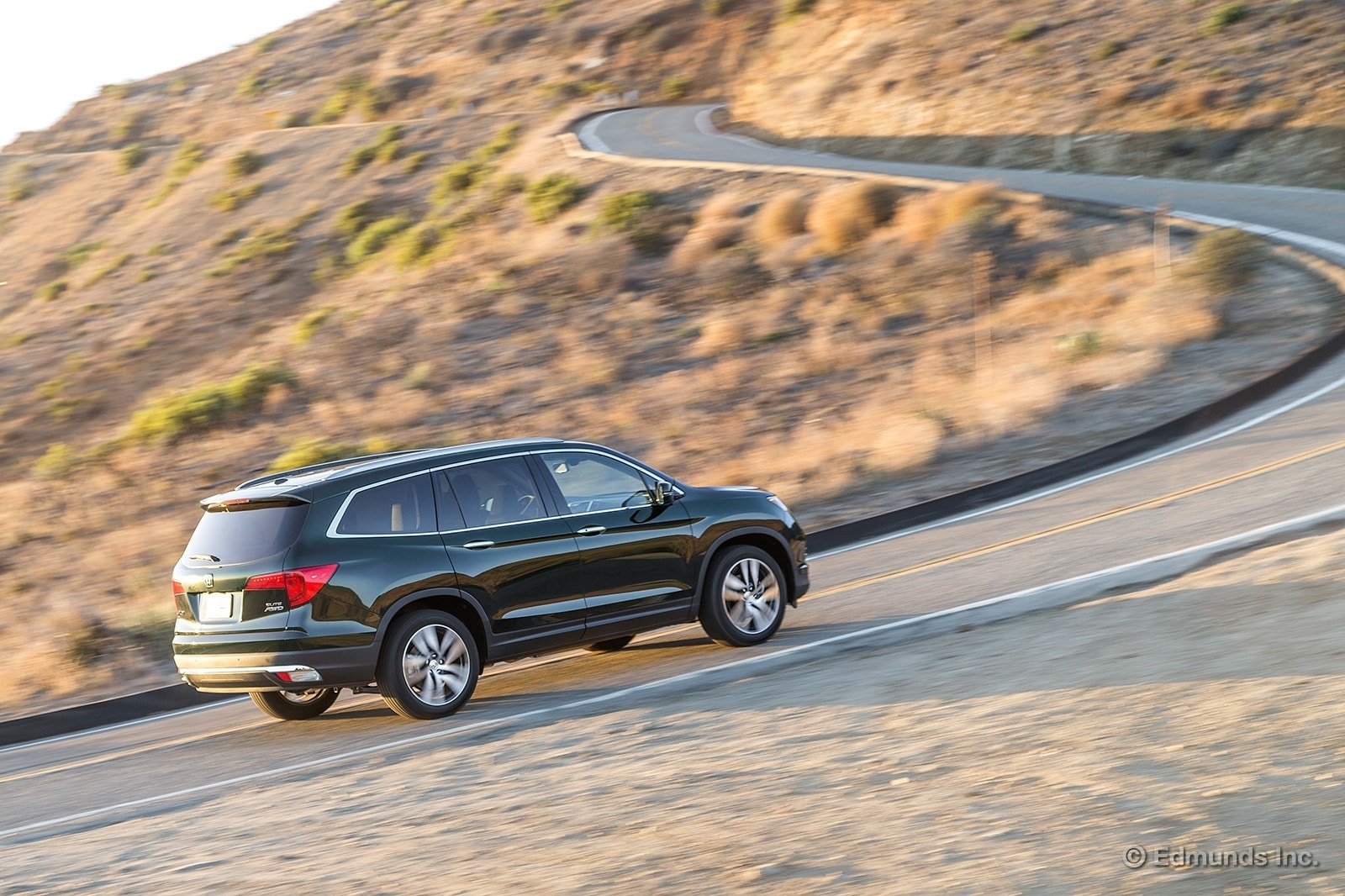
Summing Up
Pros:
Quiet, comfortable cabin that's accommodating for both short trips and long drives, well-designed storage spaces up front, solid acceleration for its size, versatile cargo area, only two minor problems in 25,000 miles of hard use, strong resale value.
Cons:
Nine-speed transmission that comes on Touring and Elite trims is clumsy and unrefined around town, touchscreen controls for the radio are hard to use, we weren't able to match its combined EPA figure, forward collision warning system was overly sensitive, push-button shifter can be awkward to use for those used to more common shift levers.
Bottom Line:
The latest Honda Pilot is perfectly in tune with the wants and needs of shoppers looking for a roomy, comfortable and reliable three-row family vehicle. It's quiet on the highway, surprisingly nimble around town and never needed anything more than basic maintenance. Our only major complaint was the performance of the nine-speed automatic transmission that often felt confused and unrefined. The six-speed automatic in the lower trim levels works much better and has a more traditional shift lever.
| Total Body Repair Costs: | None |
| Total Routine Maintenance Costs: | $343 (over 12 months) |
| Additional Maintenance Costs: | $810 |
| Warranty Repairs: | Replace driver window regulator, replace steering wheel heater assembly, reprogram infotainment system per TSB 15-072. |
| Non-Warranty Repairs: | Replace windshield. |
| Scheduled Dealer Visits: | 3 |
| Unscheduled Dealer Visits: | 3: Install special-ordered part for steering wheel heater assembly and special-order a window regulator that was missed the first time; install window regulator; and for TSB 15-072. |
| Days Out of Service: | 1 |
| Breakdowns Stranding Driver: | None |
| Best Fuel Economy: | 28.8 mpg |
| Worst Fuel Economy: | 12.3 mpg |
| Average Fuel Economy: | 20.0 mpg |
| True Market Value at service end: | $39,255 (private-party sale) |
| Depreciation: | $8,045 (17% of original MSRP) |
| Final Odometer Reading: | 25,041 miles |
The manufacturer provided Edmunds this vehicle for the purposes of evaluation.